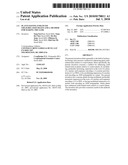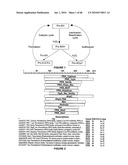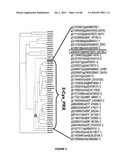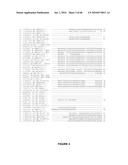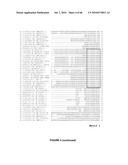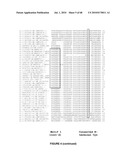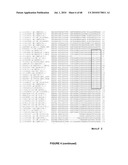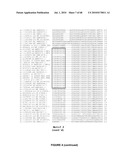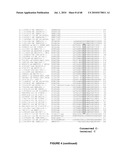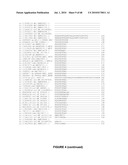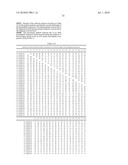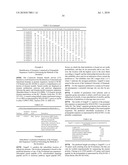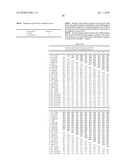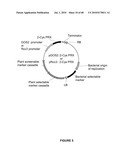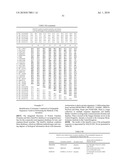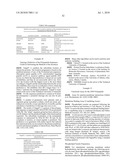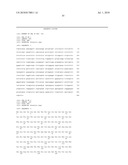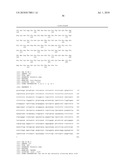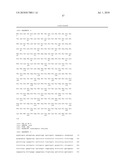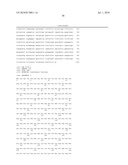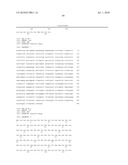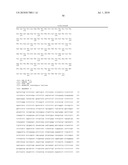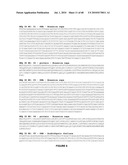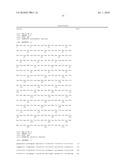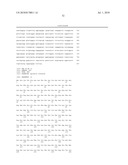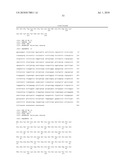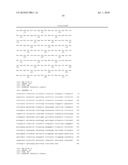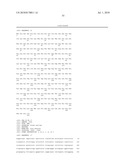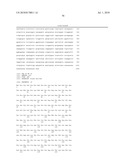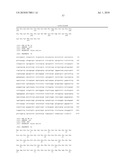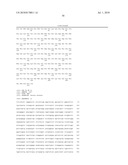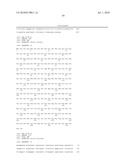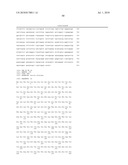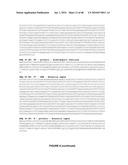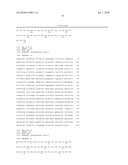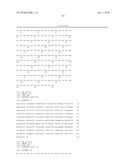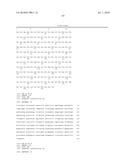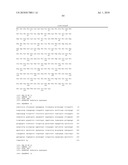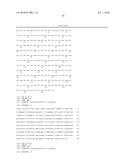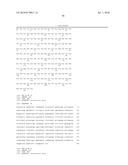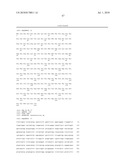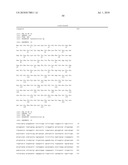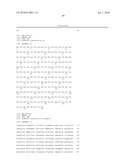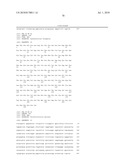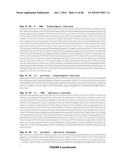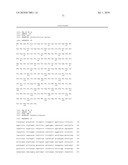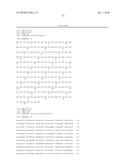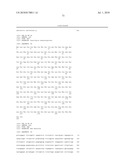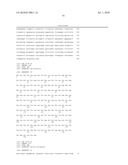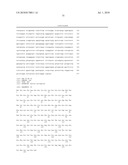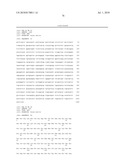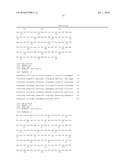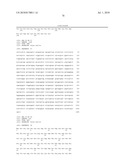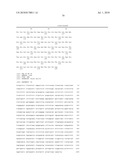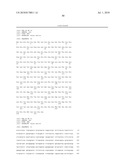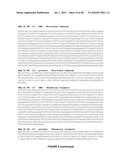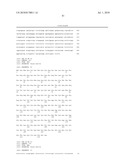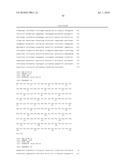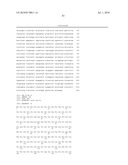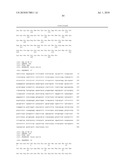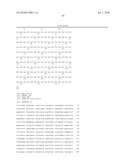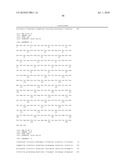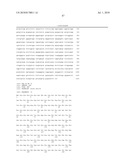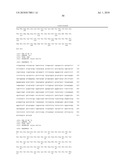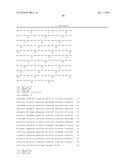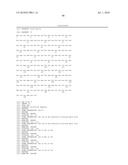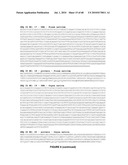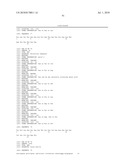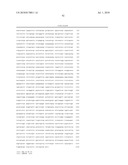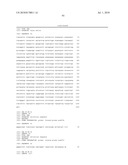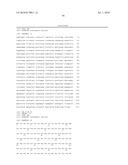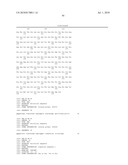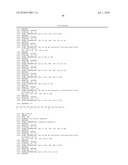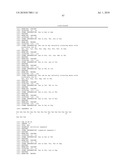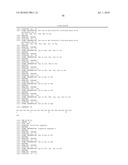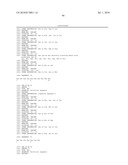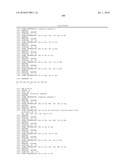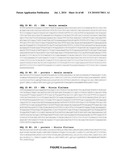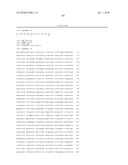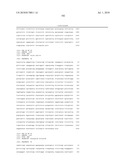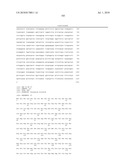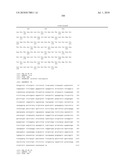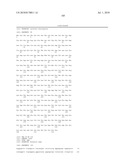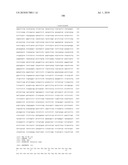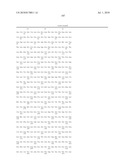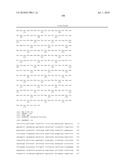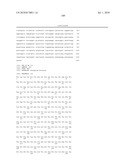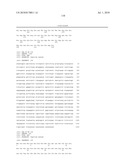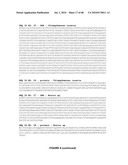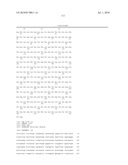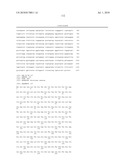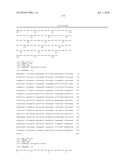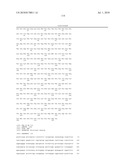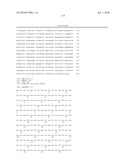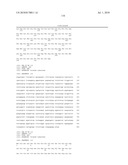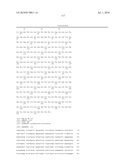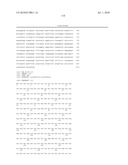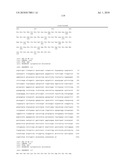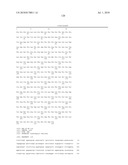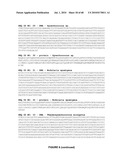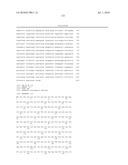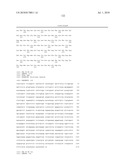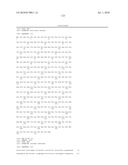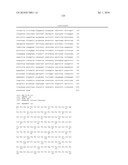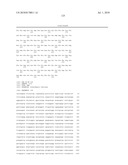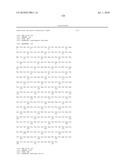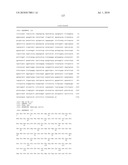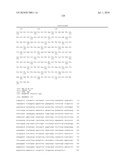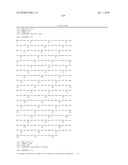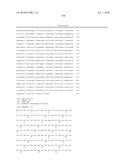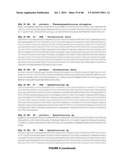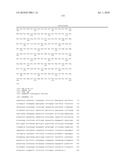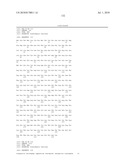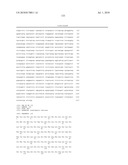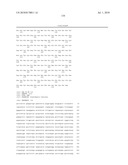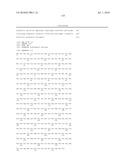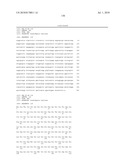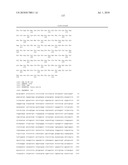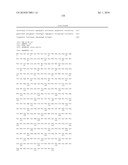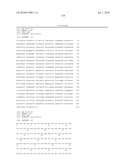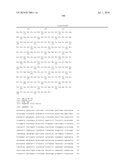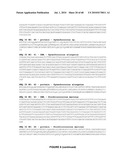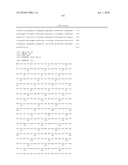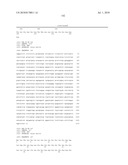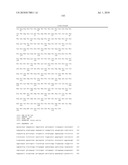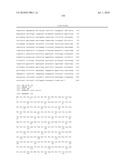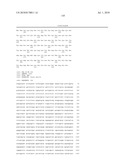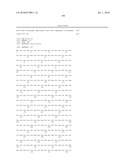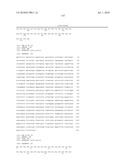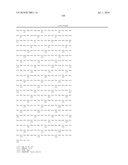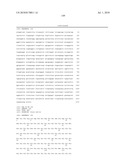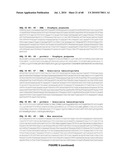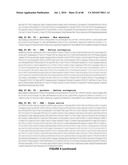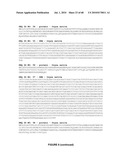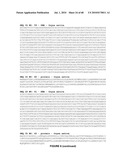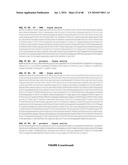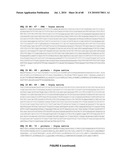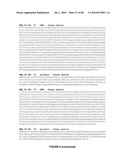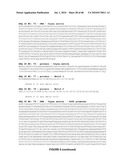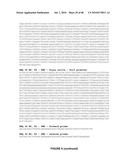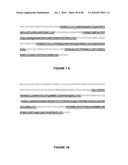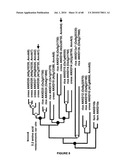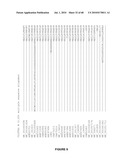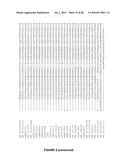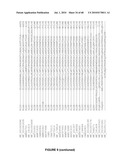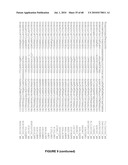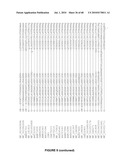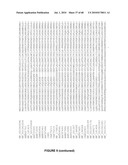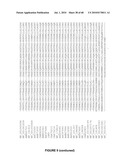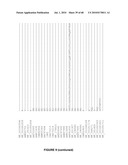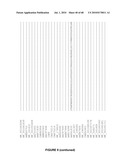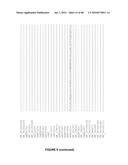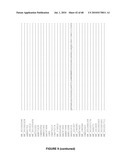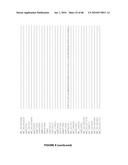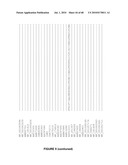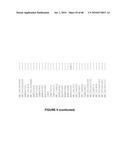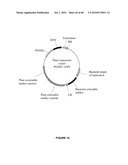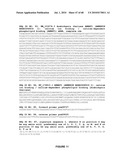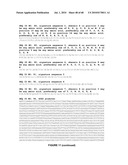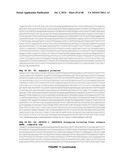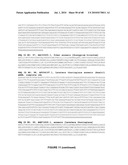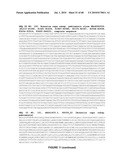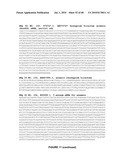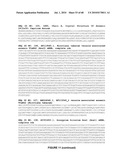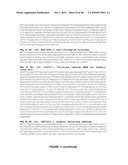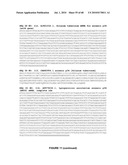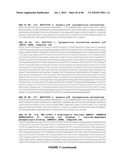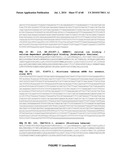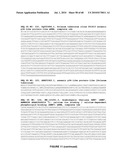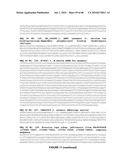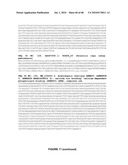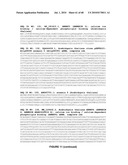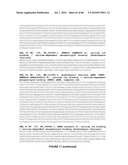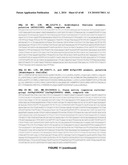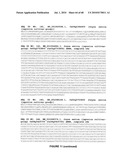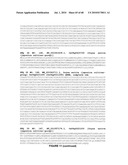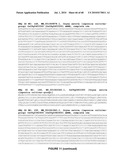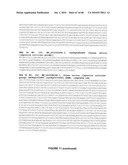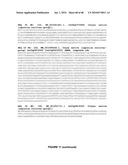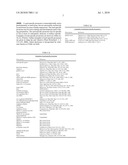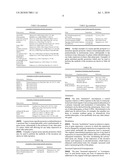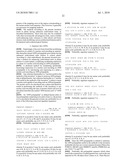Patent application title: PLANTS HAVING ENHANCED YIELD-RELATED TRAITS AND A METHOD FOR MAKING THE SAME
Inventors:
Sang Yeol Lee (Seoul, KR)
Yang Do Choi (Seoul, KR)
Yang Do Choi (Seoul, KR)
Ho Hee Jang (Seoul, KR)
Ohkmae K. Park (Seoul, KR)
Huh Sun Mi (Seoul, KR)
Assignees:
CropDesign N.V.
CropFinancial Genomics Center
IPC8 Class: AA01H500FI
USPC Class:
800298
Class name: Multicellular living organisms and unmodified parts thereof and related processes plant, seedling, plant seed, or plant part, per se higher plant, seedling, plant seed, or plant part (i.e., angiosperms or gymnosperms)
Publication date: 2010-07-01
Patent application number: 20100170011
Claims:
1. A method for enhancing a yield-related trait in a plant relative to a
control plant, comprising modulating expression in the roots of a plant,
of a nucleic acid sequence encoding 2-cysteine peroxiredoxin (2-Cys PRX),
which 2-Cys PRX polypeptide comprises from N-terminus to C-terminus: (1)
a plastidic transit peptide; and (2) a 2-Cys PRX domain, and optionally
selecting for plants having increased yield.
2. The method according to claim 1, wherein said 2-Cys PRX polypeptide additionally comprises one or both of: (i) Motif 1 as represented by SEQ ID NO: 77, or a motif having at least 50% amino acid sequence identity to SEQ ID NO: 77; or (ii) Motif 2 as represented by SEQ ID NO: 78, or a motif having at least 50% amino acid sequence identity to SEQ ID NO: 78.
3. The method according to claim 1, wherein said 2-Cys PRX polypeptide, when used in the construction of a phylogenetic tree tends to cluster with the 2-Cys PRX clade of polypeptides comprising the polypeptide sequence as represented by SEQ ID NO: 2, rather than with any other PRX clade.
4. The method according to claim 1, wherein said 2-Cys PRX polypeptide comprises a polypeptide having at least 35% sequence identity to the 2-Cys PRX polypeptide as represented by SEQ ID NO:2, 4, 6, 8, 10, 12, 14, 16, 18, 20, 22, 24, 26, 28, 30, 32, 34, 36, 38, 40, 42, 44, 46, 48, 50, or 52.
5. The method according to claim 1, wherein said nucleic acid sequence encoding a 2-Cys PRX polypeptide comprises the nucleic acid sequence of SEQ ID NO: 1, 3, 5, 7, 9, 11, 13, 15, 17, 19, 21, 23, 25, 27, 29, 31, 33, 35, 37, 39, 41, 43, 45, 47, 49, or 51, or a portion thereof, or a sequence capable of hybridising with any one of the nucleic acid sequences of SEQ ID NO: 1, 3, 5, 7, 9, 11, 13, 15, 17, 19, 21, 23, 25, 27, 29, 31, 33, 35, 37, 39, 41, 43, 45, 47, 49, or 51.
6. The method according to claim 1, wherein said nucleic acid sequence encodes an orthologue or paralogue of any of the polypeptides of SEQ ID NO: 2, 4, 6, 8, 10, 12, 14, 16, 18, 20, 22, 24, 26, 28, 30, 32, 34, 36, 38, 40, 42, 44, 46, 48, 50, or 52.
7. The method according to claim 1, wherein said modulated expression is effected by any one or more of: T-DNA activation tagging, TILLING, or homologous recombination.
8. The method according to claim 1, wherein said modulated expression is effected by introducing and expressing in the roots of a plant a nucleic acid sequence encoding a 2-Cys PRX polypeptide.
9. The method according to claim 1, wherein said enhanced yield-related trait is one or more of: (i) improved early vigour; (ii) increased aboveground biomass; (iii) increased root biomass; (iv) increase number of flowers per panicle; (v) increased seed fill rate; (vi) increased total seed yield per plant; (vii) increased number of (filled) seeds; (viii) increased harvest index; or (ix) increased thousand kernel weight (TKW).
10. The method according to claim 1, wherein said enhanced yield-related trait is obtained under abiotic stress.
11. The method according to claim 10, wherein said abiotic stress is osmotic stress, selected from one or more of: water stress, salt stress, oxidative stress, ionic stress, drought stress, and/or reduced nutrient availability.
12. The method according to claim 10, wherein tolerance to said abiotic stress is manifested as enhanced yield-related trait selected from one or more of: (i) improved early vigour; (ii) increased aboveground biomass; (iii) increased root (thick and thin) biomass; (iv) increase number of flowers per panicle; (v) increased seed fill rate; (vi) increased total seed yield per plant; (vii) increased number of (filled) seeds; (viii) increased harvest index; or (ix) increased thousand kernel weight (TKW), each relative to a control plant.
13. The method according to claim 8, wherein said nucleic acid sequence is operably linked to a root-specific promoter.
14. The method according to claim 8, wherein said nucleic acid sequence encoding a 2-Cys PRX polypeptide is of plant origin.
15. A plant or part thereof, including seeds, obtained by the method according to claim 1, wherein said plant or part thereof comprises a nucleic acid transgene encoding a 2-Cys PRX polypeptide, operably linked to a root-specific promoter.
16. A construct comprising:(a) a nucleic acid sequence encoding a 2-Cys PRX polypeptide(i) a nucleic acid sequence encoding a 2-Cys PRX polypeptide which polypeptide comprises from N-terminus to C-terminus: (1) a plastidic transit peptide, and (2) a 2-Cys PRX domain;(ii) a nucleic acid sequence encoding a 2-Cys PRX polypeptide which polypeptide comprises from N-terminus to C-terminus: (1) a plastidic transit peptide, and (2) a 2-Cys PRX domain, and comprises one or both of: (i) Motif 1 as represented by SEQ ID NO: 77, or a motif having at least 50% amino acid sequence identity to SEQ ID NO: 77; or (ii) Motif 2 as represented by SEQ ID NO: 78, or a motif having at least 50% amino acid sequence identity to SEQ ID NO: 78;(iii) a nucleic acid sequence encoding a 2-Cys PRX polypeptide which polypeptide comprises a polypeptide having at least 35% sequence identity to the 2-Cys PRX polypeptide as represented by SEQ ID NO: 2, 4, 6, 8, 10, 12, 14, 16, 18, 20, 22, 24, 26, 28, 30, 32, 34, 36, 38, 40, 42, 44, 46, 48, 50, or 52;(iv) the nucleic acid sequence of SEQ ID NO: 1, 3, 5, 7, 9, 11, 13, 15, 17, 19, 21, 23, 25, 27, 29, 31, 33, 35, 37, 39, 41, 43, 45, 47, 49, or 51, or a portion thereof, or a sequence capable of hybridising with any one of the nucleic acid sequences of SEQ ID NO: 1, 3, 5, 7, 9, 11, 13, 15, 17, 19, 21, 23, 25, 27, 29, 31, 33, 35, 37, 39, 41, 43, 45, 47, 49, or 51; or(v) a nucleic acid sequence encoding an orthologue or paralogue of any of the polypeptides of SEQ ID NO: 2, 4, 6, 8, 10, 12, 14, 16, 18, 20, 22, 24, 26, 28, 30, 32, 34, 36, 38, 40, 42, 44, 46, 48, 50, or 52;(b) one or more control sequences capable of driving expression of the nucleic acid sequence of (a); and optionally(c) a transcription termination sequence;wherein at least one of the control sequences is a root-specific promoter.
17. A method for making a plant having an enhanced yield-related trait, which enhanced yield-related trait is one or more of: (i) improved early vigour; (ii) increased aboveground biomass; (iii) increased root (thick and thin) biomass; (iv) increase number of flowers per panicle; (v) increased seed fill rate; (vi) increased total seed yield per plant; (vii) increased number of (filled) seeds; (viii) increased harvest index; or (ix) increased thousand kernel weight (TKW), relative to a control plant, comprising transforming a plant, plant part, or plant cell with the construct of claim 16.
18. A plant, plant part or plant cell transformed with the construct according to claim 16.
19. A method for the production of a transgenic plant having an enhanced yield-related trait relative to a control plant, comprising:introducing and expressing in a plant, plant part, or plant cell a nucleic acid sequence encoding a 2-Cys PRX polypeptide under the control of a root-specific promoter; and(ii) cultivating the plant, plant part, or plant cell under conditions promoting plant growth and development;wherein the nucleic acid sequence comprises(a) a nucleic acid sequence encoding a 2-Cys PRX polypeptide which polypeptide comprises from N-terminus to C-terminus: (1) a plastidic transit peptide, and (2) a 2-Cys PRX domain;(b) a nucleic acid sequence encoding a 2-Cys PRX polypeptide which polypeptide comprises from N-terminus to C-terminus: (1) a plastidic transit peptide, (2) a 2-Cys PRX domain, and comprises one or both of: (i) Motif 1 as represented by SEQ ID NO: 77, or a motif having at least 50% amino acid sequence identity to SEQ ID NO: 77; or (ii) Motif 2 as represented by SEQ ID NO: 78, or a motif having at least 50% amino acid sequence identity to SEQ ID NO: 78;(c) a nucleic acid sequence encoding a 2-Cys PRX polypeptide which polypeptide comprises a polypeptide having at least 35% sequence identity to the 2-Cys PRX polypeptide as represented by SEQ ID NO: 2, 4, 6, 8, 10, 12, 14, 16, 18, 20, 22, 24, 26, 28, 30, 32, 34, 36, 38, 40, 42, 44, 46, 48, 50, or 52; or(d) the nucleic acid sequence of SEQ ID NO: 1, 3, 5, 7, 9, 11, 13, 15, 17, 19, 21, 23, 25, 27, 29, 31, 33, 35, 37, 39, 41, 43, 45, 47, 49, or 51, or a portion thereof, or a sequence capable of hybridising with any one of the nucleic acid sequences of SEQ ID NO: 1, 3, 5, 7, 9, 11, 13, 15, 17, 19, 21, 23, 25, 27, 29, 31, 33, 35, 37, 39, 41, 43, 45, 47, 49, or 51.
20. The method according to claim 19, wherein said enhanced yield-related trait occurs under increased abiotic stress.
21. A transgenic plant having an enhanced yield-related trait relative to a control plant, produced by the method of claim 19, or a transgenic plant cell or plant part derived from said transgenic plant.
22. The transgenic plant according to claim 21, wherein said plant is a crop plant or a monocot or a cereal, or a transgenic plant cell, plant part, or harvestable part derived from said transgenic plant.
23. (canceled)
24. Products derived from the plant and/or from harvestable parts of the plant according to claim 22, wherein said harvestable parts are seeds.
25-26. (canceled)
27. A method for enhancing a yield-related trait in a plant relative to a control plant, comprising modulating expression in a plant of a nucleic acid encoding an annexin-like (ANN), polypeptide, wherein said ANN polypeptide comprises one or more of the following motifs:(i) Signature sequence 1 (SEQ ID NO: 87),(ii) Signature sequence 2 (SEQ ID NO: 88),(iii) Signature sequence 3 (SEQ ID NO: 89),(iv) Signature sequence 4 (SEQ ID NO: 90),(v) Signature sequence 5 (SEQ ID NO: 91),(vi) Signature sequence 6 (SEQ ID NO: 92),(vii) Signature sequence 7 (SEQ ID NO: 93).
28. The method according to claim 27, wherein said ANN polypeptide comprises at least an annexin domain.
29. The method according to claim 27, wherein said modulated expression is effected by introducing and expressing in a plant a nucleic acid encoding an ANN polypeptide.
30. The method according to claim 27, wherein said nucleic acid a polypeptide comprising the amino acid sequence of SEQ ID NO: 84, 97, 99, 101, 103, 105, 107, 109, 111, 113, 115, 117, 119, 121, 123, 125, 127, 129, 131, 133, 135, 137, 139, 141, 143, 145, 147, 149, 151, 153, or 155, or is a portion of said nucleic acid, or a nucleic acid capable of hybridising with said nucleic acid.
31. The method according to claim 27, wherein said nucleic acid sequence encodes an orthologue or paralogue of a protein comprising the sequence of SEQ ID NO: 84, 97, 99, 101, 103, 105, 107, 109, 111, 113, 115, 117, 119, 121, 123, 125, 127, 129, 131, 133, 135, 137, 139, 141, 143, 145, 147, 149, 151, 153, or 155.
32. The method according to claim 27, wherein said enhanced yield-related trait comprises increased yield relative to control plants.
33. The method according to claim 27, wherein said enhanced yield-related trait is obtained under non-stress conditions.
34. The method according to claim 27, wherein said enhanced yield-related trait is obtained under conditions of drought.
35. The method according to claim 29, wherein said nucleic acid is operably linked to a constitutive promoter.
36. The method according to claim 29, wherein said nucleic acid is operably linked to a green-tissue specific promoter.
37. The method according to claim 29, wherein said nucleic acid encoding an ANN polypeptide is of plant origin.
38. A plant or part thereof, including seeds, obtained by the method according to claim 27, wherein said plant or part thereof comprises a recombinant nucleic acid encoding an ANN polypeptide.
39. A construct comprising:(i) a nucleic acid encoding an ANN polypeptide wherein said ANN polypeptide comprises one or more of the following motifs:(a) Signature sequence 1 (SEQ ID NO: 87),(b) Signature sequence 2 (SEQ ID NO: 88),(c) Signature sequence 3 (SEQ ID NO: 89),(d) Signature sequence 4 (SEQ ID NO: 90),(e) Signature sequence 5 (SEQ ID NO: 91),(f) Signature sequence 6 (SEQ ID NO: 92), or(g) Signature sequence 7 (SEQ ID NO: 93); andwherein said ANN polypeptide comprises at least an annexin domain;(ii) one or more control sequences capable of driving expression of the nucleic acid sequence of (i); and optionally(iii) a transcription termination sequence.
40. The construct according to claim 39, wherein one of said control sequences is a constitutive promoter.
41. The construct according to claim 39, wherein one of said control sequences is a green-tissue specific promoter.
42. (canceled)
43. A plant, plant part or plant cell transformed with the construct according to claim 39.
44. A method for the production of a transgenic plant having increased yield relative to a control plant, comprising:(i) introducing and expressing in a plant a nucleic acid encoding an ANN polypeptide wherein said ANN polypeptide comprises one or more of the following motifs:(a) Signature sequence 1 (SEQ ID NO: 87),(b) Signature sequence 2 (SEQ ID NO: 88),(c) Signature sequence 3 (SEQ ID NO: 89),(d) Signature sequence 4 (SEQ ID NO: 90),(e) Signature sequence 5 (SEQ ID NO: 91),(f) Signature sequence 6 (SEQ ID NO: 92), or(g) Signature sequence 7 (SEQ ID NO: 93); andwherein said ANN polypeptide comprises at least an annexin domain; and(ii) cultivating the plant cell under conditions promoting plant growth and development.
45. A transgenic plant having increased yield relative to control plants, produced by the method of claim 44, or a transgenic plant cell or plant part derived from said transgenic plant.
46. The transgenic plant according to claim 45, or a transgenic plant cell or harvestable part derived thereof, wherein said plant is a crop plant or a monocot or a cereal, and wherein the increased yield is increased seed yield.
47. (canceled)
48. Products derived from the plant and/or from harvestable parts of the plant according to claim 46, wherein said harvestable plants are seeds.
49. (canceled)
Description:
[0001]The present invention relates generally to the field of molecular
biology and concerns a method for enhancing plant yield-related traits
relative to control plants. More specifically, the present invention
concerns a method for enhancing yield related traits in plants relative
to control plants, by modulating, preferably increasing, expression in
the roots of a plant, of a nucleic acid sequence encoding a 2-cysteine
peroxiredoxin (2-Cys PRX); or by modulating expression of a nucleic acid
encoding an ANN polypeptide in a plant. The present invention also
concerns plants having modulated, preferably increased, expression in the
roots, of a nucleic acid sequence encoding a 2-Cys PRX, or having
modulated expression of a nucleic acid encoding an ANN polypeptide, which
plants have enhanced yield-related traits relative to control plants. The
invention also provides constructs useful in the methods of the
invention.
[0002]The ever-increasing world population and the dwindling supply of arable land available for agriculture fuels research towards increasing the efficiency of agriculture. Conventional means for crop and horticultural improvements utilise selective breeding techniques to identify plants having desirable characteristics. However, such selective breeding techniques have several drawbacks, namely that these techniques are typically labour intensive and result in plants that often contain heterogeneous genetic components that may not always result in the desirable trait being passed on from parent plants. Advances in molecular biology have allowed mankind to modify the germplasm of animals and plants. Genetic engineering of plants entails the isolation and manipulation of genetic material (typically in the form of DNA or RNA) and the subsequent introduction of that genetic material into a plant. Such technology has the capacity to deliver crops or plants having various improved economic, agronomic or horticultural traits.
[0003]A trait of particular economic interest is increased yield. Yield is normally defined as the measurable produce of economic value from a crop. This may be defined in terms of quantity and/or quality. Yield is directly dependent on several factors, for example, the number and size of the organs, plant architecture (for example, the number of branches), seed production, leaf senescence and more. Root development, nutrient uptake, stress tolerance and early vigour may also be important factors in determining yield. Optimizing the above-mentioned factors may therefore contribute to increasing crop yield.
[0004]Seed yield is a particularly important trait, since the seeds of many plants are important for human and animal nutrition. Crops such as corn, rice, wheat, canola and soybean account for over half the total human caloric intake, whether through direct consumption of the seeds themselves or through consumption of meat products raised on processed seeds. They are also a source of sugars, oils and many kinds of metabolites used in industrial processes. Seeds contain an embryo (the source of new shoots and roots) and an endosperm (the source of nutrients for embryo growth during germination and during early growth of seedlings). The development of a seed involves many genes, and requires the transfer of metabolites from the roots leaves and stems into the growing seed. The endosperm, in particular, assimilates the metabolic precursors of carbohydrates, oils and proteins and synthesizes them into storage macromolecules to fill out the grain.
[0005]Another important trait for many crops is early vigour. Improving early vigour is an important objective of modern rice breeding programs in both temperate and tropical rice cultivars. Long roots are important for proper soil anchorage in water-seeded rice. Where rice is sown directly into flooded fields, and where plants must emerge rapidly through water, longer shoots are associated with vigour. Where drill-seeding is practiced, longer mesocotyls and coleoptiles are important for good seedling emergence. The ability to engineer early vigour into plants would be of great importance in agriculture. For example, poor early vigour has been a limitation to the introduction of maize (Zea mays L.) hybrids based on Corn Belt germplasm in the European Atlantic.
[0006]Plant biomass is yield for forage crops like alfalfa, silage corn and hay. Many proxies for yield have been used in grain crops. Chief amongst these are estimates of plant size. Plant size can be measured in many ways depending on species and developmental stage, but include total plant dry weight, above-ground dry weight, above-ground fresh weight, leaf area, stem volume, plant height, rosette diameter, leaf length, root length, root mass, tiller number and leaf number. Many species maintain a conservative ratio between the size of different parts of the plant at a given developmental stage. These allometric relationships are used to extrapolate from one of these measures of size to another (e.g. Tittonell et al 2005 Agric Ecosys & Environ 105: 213). Plant size at an early developmental stage will typically correlate with plant size later in development. A larger plant with a greater leaf area can typically absorb more light and carbon dioxide than a smaller plant and therefore will likely gain a greater weight during the same period (Fasoula & Tollenaar 2005 Maydica 50:39). This is in addition to the potential continuation of the micro-environmental or genetic advantage that the plant had to achieve the larger size initially. There is a strong genetic component to plant size and growth rate (e.g. ter Steege et al 2005 Plant Physiology 139:1078), and so for a range of diverse genotypes plant size under one environmental condition is likely to correlate with size under another (Hittalmani et al 2003 Theoretical Applied Genetics 107:679). In this way a standard environment is used as a proxy for the diverse and dynamic environments encountered at different locations and times by crops in the field.
[0007]Harvest index, the ratio of seed yield to aboveground dry weight, is relatively stable under many environmental conditions and so a robust correlation between plant size and grain yield can often be obtained (e.g. Rebetzke et al 2002 Crop Science 42:739). These processes are intrinsically linked because the majority of grain biomass is dependent on current or stored photosynthetic productivity by the leaves and stem of the plant (Gardener et al 1985 Physiology of Crop Plants. Iowa State University Press, pp 68-73). Therefore, selecting for plant size, even at early stages of development, has been used as an indicator for future potential yield (e.g. Tittonell et al 2005 Agric Ecosys & Environ 105: 213). When testing for the impact of genetic differences on stress tolerance, the ability to standardize soil properties, temperature, water and nutrient availability and light intensity is an intrinsic advantage of greenhouse or plant growth chamber environments compared to the field. However, artificial limitations on yield due to poor pollination due to the absence of wind or insects, or insufficient space for mature root or canopy growth, can restrict the use of these controlled environments for testing yield differences. Therefore, measurements of plant size in early development, under standardized conditions in a growth chamber or greenhouse, are standard practices to provide indication of potential genetic yield advantages.
[0008]Another trait of importance is that of improved abiotic stress tolerance. Abiotic stress is a primary cause of crop loss worldwide, reducing average yields for most major crop plants by more than 50% (Wang et al. (2003) Planta 218: 1-14). Abiotic stresses may be caused by drought, salinity, extremes of temperature, chemical toxicity, excess or lack of nutrients (macroelements and/or microelements), radiation and oxidative stress. The ability to increase plant tolerance to abiotic stress would be of great economic advantage to farmers worldwide and would allow for the cultivation of crops during adverse conditions and in territories where cultivation of crops may not otherwise be possible.
[0009]Crop yield may therefore be increased by optimising one of the above-mentioned factors.
[0010]Depending on the end use, the modification of certain yield traits may be favoured over others. For example for applications such as forage or wood production, or bio-fuel resource, an increase in the vegetative parts of a plant may be desirable, and for applications such as flour, starch or oil production, an increase in seed parameters may be particularly desirable. Even amongst the seed parameters, some may be favoured over others, depending on the application. Various mechanisms may contribute to increasing seed yield, whether that is in the form of increased seed size or increased seed number.
[0011]One approach to enhance yield-related traits (for example increasing yield, in particular seed yield and/or biomass) in plants may be through modification of the inherent growth mechanisms of a plant, such as the cell cycle or various signalling pathways involved in plant growth or in defense mechanisms.
[0012]Surprisingly, it has now been found that various plant yield-related traits may be enhanced relative to control plants, by modulating, preferably increasing, expression in the roots of a plant, of a nucleic acid sequence encoding a 2-cysteine peroxiredoxin (2-Cys PRX), or by modulating expression of a nucleic acid encoding an ANN polypeptide in a plant.
[0013]According to one embodiment, there is provided a method for enhancing various yield-related traits relative to control plants, comprising modulating, preferably increasing, expression in the roots of a plant, of a nucleic acid sequence encoding a 2-cysteine peroxiredoxin (2-Cys PRX), or by modulating expression of a nucleic acid encoding an ANN polypeptide, in a plant.
BACKGROUND
1. 2-Cysteine Peroxiredoxin (2-Cys PRX)
[0014]Thiol peroxidases (PRX) are ubiquitous heme-free peroxidases, which catalyze the reduction of peroxynitrites and of various peroxides by catalytic cysteine residues and thiol-containing proteins as reductants. In plants, five different classes can be distinguished, according to the number and the position of conserved catalytic cysteines. Four classes are defined as peroxiredoxins and were already identified by phylogenetic sequence analysis, 1-Cys, 2-Cys, type II, and type Q peroxiredoxins, and the fifth is represented by glutathione peroxidases, which were recently shown to possess a thioredoxin-dependent activity in plants (Rouhier & Jacquot (2005) Free Radic Biol Med 38(11): 1413-21). The analysis of the Arabidopsis thaliana genome indicates that at least 17 isoforms of thioredoxin-dependent peroxidases are expressed in various plant compartments.
[0015]2-Cysteine peroxiredoxin (2-Cys PRX) are a group of proteins that participate in cell proliferation, differentiation, apoptosis, and photosynthesis. These enzymes reduce H2O2, peroxinitrite and alkyl hydroperoxide to water or alcohol, respectively (Netto et al., (1996) J Biol Chem 271(26): 15315-15321) with thioredoxin (Trx) as electron donor. By doing so, 2-Cys PRXs regulate signal transduction pathways or protect macromolecules against oxidative damage. These proteins are homodimers and each subunit has the two conserved cysteines (Choi et al., (1998) Nature Struct Biol 5:400-406). The peroxide oxidizes the N-terminal cysteine of one subunit to sulphenic acid, which reacts with the C-terminal cysteine of the other subunit to form an intermolecular disulphide. To complete the catalytic cycle the enzyme is reduced via a thiol/disulphide redox interchange (Chae et al., (1994) Proc Natl Acad Sci USA 91: 7017-7021).
[0016]Transgenic Arabidopsis thaliana plants (Baier et al. (2000) Plant Physiol 124(2): 823-32) with reduced levels of 2-Cys PRX were generated by antisense suppression. The suppression of 2-Cys PRX expression lead to increased expression of other anti-oxidative genes, demonstrating that the enzyme forms an integral part of the anti-oxidant network of chloroplasts and is functionally interconnected with other defense systems.
[0017]International patent application WO05/116082 describes the obtention of transgenic Arabidopsis plants overexpressing an Arabidopsis 2-Cys PRX (named BAS1) using the constitutive cauliflower mosaic virus 35S promoter. The transgenic plants are described as having more potential resistance to heat shock and pathogens than the wild type plants.
[0018]Surprisingly, it has now been found that modulating, preferably increasing, expression in the roots of a plant, of a nucleic acid sequence encoding a 2-Cys PRX polypeptide gives plants having enhanced yield-related traits relative to control plants.
[0019]According one embodiment, there is provided a method for enhancing yield related traits of a plant relative to control plants, comprising modulating, preferably increasing, expression in the roots of a plant, of a nucleic acid sequence encoding a 2-Cys PRX polypeptide. The enhanced yield related traits comprise one or more of: (i) improved early vigour; (ii) increased aboveground biomass; (iii) increased root (thick and thin) biomass; (iv) increase number of flowers per panicle; (v) increased seed fill rate; (vi) increased total seed yield per plant; (vii) increased number of (filled) seeds; (viii) increased harvest index; or (ix) increased thousand kernel weight (TKW).
2. Annexin-Like (ANN)
[0020]Annexins form a family of calcium dependent phospholipid binding proteins and are found in plants and animals. In all plant species tested, the presence of at least two different annexins has been demonstrated. Structurally, plant annexins are less divergent than animal annexins. Comparative studies revealed that plant annexins share significant homology in a core domain which comprises at least one, usually four or more conserved repeats which are approximately 70 amino acids in length. As calcium-binding proteins, annexins are postulated to play a role in calcium signalling pathways. Although the structure of annexins is well known nowadays, functionally they are not well characterised. In plants, annexins are reported to be involved in Golgi-mediated secretion, cell expansion, vacuole biogenesis, chloroplast membrane binding, cell cycle, nodulation signalling, stress signalling.
[0021]US20050089872 describes T-DNA insertion mutants (anx1 and anx4-1) for respectively the Annexin 1 and Annexin 4 encoding genes from Arabidopsis thaliana. The mutants were sensitive to salt stress and osmotic stress. Also abscisic acid had a negative effect on germination and growth of the anx1 and anx4-1 mutants. Expression analysis revealed that the ANX1 protein was predominantly expressed in the root, but not in flower, stem or leaf tissues. It is postulated that the ANX1 and ANX4 proteins play a role in the transduction of osmotic stress and ABA signals.
[0022]Surprisingly, it has now been found that modulating expression of a nucleic acid encoding an ANN polypeptide gives plants having enhanced yield-related traits, in particular increased yield relative to control plants.
[0023]According one embodiment, there is provided a method for enhancing yield-related traits of a plant relative to control plants, comprising modulating expression of a nucleic acid encoding an ANN polypeptide in a plant. The improved yield related traits comprise increased seed yield.
DEFINITIONS
Polypeptide(s)/Protein(s)
[0024]The terms "polypeptide" and "protein" are used interchangeably herein and refer to amino acids in a polymeric form of any length, linked together by peptide bonds.
Polynucleotide(s)/Nucleic Acid(s)/Nucleic Acid Sequence(s)/Nucleotide Sequence(s)
[0025]The terms "polynucleotide(s)", "nucleic acid sequence(s)", "nucleotide sequence(s)", "nucleic acid(s)", "nucleic acid molecule(s)" are used interchangeably herein and refer to nucleotides, either ribonucleotides or deoxyribonucleotides or a combination of both, in a polymeric unbranched form of any length.
Control Plant(s)
[0026]The choice of suitable control plants is a routine part of an experimental setup and may include corresponding wild type plants or corresponding plants without the gene of interest. The control plant is typically of the same plant species or even of the same variety as the plant to be assessed. The control plant may also be a nullizygote of the plant to be assessed. A "control plant" as used herein refers not only to whole plants, but also to plant parts, including seeds and seed parts.
Homologue(s)
[0027]"Homologues" of a protein encompass peptides, oligopeptides, polypeptides, proteins and enzymes having amino acid substitutions, deletions and/or insertions relative to the unmodified protein in question and having similar biological and functional activity as the unmodified protein from which they are derived.
[0028]A deletion refers to removal of one or more amino acids from a protein.
[0029]An insertion refers to one or more amino acid residues being introduced into a predetermined site in a protein. Insertions may comprise N-terminal and/or C-terminal fusions as well as intra-sequence insertions of single or multiple amino acids. Generally, insertions within the amino acid sequence will be smaller than N- or C-terminal fusions, of the order of about 1 to 10 residues. Examples of N- or C-terminal fusion proteins or peptides include the binding domain or activation domain of a transcriptional activator as used in the yeast two-hybrid system, phage coat proteins, (histidine)-6-tag, glutathione S-transferase-tag, protein A, maltose-binding protein, dihydrofolate reductase, Tag•100 epitope, c-myc epitope, FLAG®-epitope, lacZ, CMP (calmodulin-binding peptide), HA epitope, protein C epitope and VSV epitope.
[0030]A substitution refers to replacement of amino acids of the protein with other amino acids having similar properties (such as similar hydrophobicity, hydrophilicity, antigenicity, propensity to form or break α-helical structures or β-sheet structures). Amino acid substitutions are typically of single residues, but may be clustered depending upon functional constraints placed upon the polypeptide; insertions will usually be of the order of about 1 to 10 amino acid residues. The amino acid substitutions are preferably conservative amino acid substitutions. Conservative substitution tables are well known in the art (see for example Creighton (1984) Proteins. W.H. Freeman and Company (Eds) and Table 1 below).
TABLE-US-00001 TABLE 1 Examples of conserved amino acid substitutions Residue Conservative Substitutions Ala Ser Arg Lys Asn Gln; His Asp Glu Gln Asn Cys Ser Glu Asp Gly Pro His Asn; Gln Ile Leu, Val Leu Ile; Val Lys Arg; Gln Met Leu; Ile Phe Met; Leu; Tyr Ser Thr; Gly Thr Ser; Val Trp Tyr Tyr Trp; Phe Val Ile; Leu
[0031]Amino acid substitutions, deletions and/or insertions may readily be made using peptide synthetic techniques well known in the art, such as solid phase peptide synthesis and the like, or by recombinant DNA manipulation. Methods for the manipulation of DNA sequences to produce substitution, insertion or deletion variants of a protein are well known in the art. For example, techniques for making substitution mutations at predetermined sites in DNA are well known to those skilled in the art and include M13 mutagenesis, T7-Gen in vitro mutagenesis (USB, Cleveland, Ohio), QuickChange Site Directed mutagenesis (Stratagene, San Diego, Calif.), PCR-mediated site-directed mutagenesis or other site-directed mutagenesis protocols.
Derivatives
[0032]"Derivatives" include peptides, oligopeptides, polypeptides which may, compared to the amino acid sequence of the naturally-occurring form of the protein, such as the protein of interest, comprise substitutions of amino acids with non-naturally occurring amino acid residues, or additions of non-naturally occurring amino acid residues. "Derivatives" of a protein also encompass peptides, oligopeptides, polypeptides which comprise naturally occurring altered (glycosylated, acylated, prenylated, phosphorylated, myristoylated, sulphated etc.) or non-naturally altered amino acid residues compared to the amino acid sequence of a naturally-occurring form of the polypeptide. A derivative may also comprise one or more non-amino acid substituents or additions compared to the amino acid sequence from which it is derived, for example a reporter molecule or other ligand, covalently or non-covalently bound to the amino acid sequence, such as a reporter molecule which is bound to facilitate its detection, and non-naturally occurring amino acid residues relative to the amino acid sequence of a naturally-occurring protein.
Orthologue(s)/Paralogue(s)
[0033]Orthologues and paralogues encompass evolutionary concepts used to describe the ancestral relationships of genes. Paralogues are genes within the same species that have originated through duplication of an ancestral gene; orthologues are genes from different organisms that have originated through speciation, and are also derived from a common ancestral gene.
Domain
[0034]The term "domain" refers to a set of amino acids conserved at specific positions along an alignment of sequences of evolutionarily related proteins. While amino acids at other positions can vary between homologues, amino acids that are highly conserved at specific positions indicate amino acids that are likely essential in the structure, stability or function of a protein. Identified by their high degree of conservation in aligned sequences of a family of protein homologues, they can be used as identifiers to determine if any polypeptide in question belongs to a previously identified polypeptide family.
Motif/Consensus Sequence/Signature
[0035]The term "motif" or "consensus sequence" or "signature" refers to a short conserved region in the sequence of evolutionarily related proteins. Motifs are frequently highly conserved parts of domains, but may also include only part of the domain, or be located outside of conserved domain (if all of the amino acids of the motif fall outside of a defined domain).
Hybridisation
[0036]The term "hybridisation" as defined herein is a process wherein substantially homologous complementary nucleotide sequences anneal to each other. The hybridisation process can occur entirely in solution, i.e. both complementary nucleic acid molecules are in solution. The hybridisation process can also occur with one of the complementary nucleic acid molecules immobilised to a matrix such as magnetic beads, Sepharose beads or any other resin. The hybridisation process can furthermore occur with one of the complementary nucleic acid molecules immobilised to a solid support such as a nitro-cellulose or nylon membrane or immobilised by e.g. photolithography to, for example, a siliceous glass support (the latter known as nucleic acid arrays or microarrays or as nucleic acid chips). In order to allow hybridisation to occur, the nucleic acid molecules are generally thermally or chemically denatured to melt a double strand into two single strands and/or to remove hairpins or other secondary structures from single stranded nucleic acid molecules.
[0037]The term "stringency" refers to the conditions under which a hybridisation takes place. The stringency of hybridisation is influenced by conditions such as temperature, salt concentration, ionic strength and hybridisation buffer composition. Generally, low stringency conditions are selected to be about 30° C. lower than the thermal melting 2-Cys PRXnt (Tm) for the specific sequence at a defined ionic strength and pH. Medium stringency conditions are when the temperature is 20° C. below Tm, and high stringency conditions are when the temperature is 10° C. below Tm. High stringency hybridisation conditions are typically used for isolating hybridising sequences that have high sequence similarity to the target nucleic acid sequence. However, nucleic acid sequences may deviate in sequence composition and still encode a substantially identical polypeptide, due to the degeneracy of the genetic code. Therefore medium stringency hybridisation conditions may sometimes be needed to identify such nucleic acid molecules.
[0038]The Tm is the temperature under defined ionic strength and pH, at which 50% of the target sequence hybridises to a perfectly matched probe. The Tm is dependent upon the solution conditions and the base composition and length of the probe. For example, longer sequences hybridise specifically at higher temperatures. The maximum rate of hybridisation is obtained from about 16° C. up to 32° C. below Tm. The presence of monovalent cations in the hybridisation solution reduce the electrostatic repulsion between the two nucleic acid strands thereby promoting hybrid formation; this effect is visible for sodium concentrations of up to 0.4M (for higher concentrations, this effect may be ignored). Formamide reduces the melting temperature of DNA-DNA and DNA-RNA duplexes with 0.6 to 0.7° C. for each percent formamide, and addition of 50% formamide allows hybridisation to be performed at 30 to 45° C., though the rate of hybridisation will be lowered. Base pair mismatches reduce the hybridisation rate and the thermal stability of the duplexes. On average and for large probes, the Tm decreases about 1° C. per % base mismatch. The Tm may be calculated using the following equations, depending on the types of hybrids:
1) DNA-DNA hybrids (Meinkoth and Wahl, Anal. Biochem., 138: 267-284, 1984):
Tm=81.5° C.+16.6×log10[Na.sup.+]a+0.41×%[G/Cb]-500.time- s.[Lc]-1-0.61×% formamide
a or for other monovalent cation, but only accurate in the 0.01-0.4 M range.b only accurate for % GC in the 30% to 75% range.c L=length of duplex in base pairs.2) DNA-RNA or RNA-RNA hybrids:
Tm=79.8+18.5(log10[Na.sup.+]a)+0.58(%G/Cb)+11.8(%G/Cb)- 2-820/Lc
3) oligo-DNA or oligo-RNAd hybrids: d oligo, oligonucleotide; In, =effective length of primer=2×(no. of G/C)+(no. of A/T). [0039]For <20 nucleotides: Tm=2 (In) [0040]For 20-35 nucleotides: Tm=22+1.46 (In)
[0041]Non-specific binding may be controlled using any one of a number of known techniques such as, for example, blocking the membrane with protein containing solutions, additions of heterologous RNA, DNA, and SDS to the hybridisation buffer, and treatment with Rnase. For non-homologous probes, a series of hybridizations may be performed by varying one of (i) progressively lowering the annealing temperature (for example from 68° C. to 42° C.) or (ii) progressively lowering the formamide concentration (for example from 50% to 0%). The skilled artisan is aware of various parameters which may be altered during hybridisation and which will either maintain or change the stringency conditions.
[0042]Besides the hybridisation conditions, specificity of hybridisation typically also depends on the function of post-hybridisation washes. To remove background resulting from non-specific hybridisation, samples are washed with dilute salt solutions. Critical factors of such washes include the ionic strength and temperature of the final wash solution: the lower the salt concentration and the higher the wash temperature, the higher the stringency of the wash. Wash conditions are typically performed at or below hybridisation stringency. A positive hybridisation gives a signal that is at least twice of that of the background. Generally, suitable stringent conditions for nucleic acid hybridisation assays or gene amplification detection procedures are as set forth above. More or less stringent conditions may also be selected. The skilled artisan is aware of various parameters which may be altered during washing and which will either maintain or change the stringency conditions.
[0043]For example, typical high stringency hybridisation conditions for DNA hybrids longer than 50 nucleotides encompass hybridisation at 65° C. in 1×SSC or at 42° C. in 1×SSC and 50% formamide, followed by washing at 65° C. in 0.3×SSC. Examples of medium stringency hybridisation conditions for DNA hybrids longer than 50 nucleotides encompass hybridisation at 50° C. in 4×SSC or at 40° C. in 6×SSC and 50% formamide, followed by washing at 50° C. in 2×SSC. The length of the hybrid is the anticipated length for the hybridising nucleic acid molecule. When nucleic acid molecules of known sequence are hybridised, the hybrid length may be determined by aligning the sequences and identifying the conserved regions described herein. 1×SSC is 0.15M NaCl and 15 mM sodium citrate; the hybridisation solution and wash solutions may additionally include 5×Denhardt's reagent, 0.5-1.0% SDS, 100 μg/ml denatured, fragmented salmon sperm DNA, 0.5% sodium pyrophosphate.
[0044]For the purposes of defining the level of stringency, reference can be made to Sambrook et al. (2001) Molecular Cloning: a laboratory manual, 3rd Edition, Cold Spring Harbor Laboratory Press, CSH, N.Y. or to Current Protocols in Molecular Biology, John Wiley & Sons, N.Y. (1989 and yearly updates).
Splice Variant
[0045]The term "splice variant" as used herein encompasses variants of a nucleic acid sequence in which selected introns and/or exons have been excised, replaced, displaced or added, or in which introns have been shortened or lengthened. Such variants will be ones in which the biological activity of the protein is substantially retained; this may be achieved by selectively retaining functional segments of the protein. Such splice variants may be found in nature or may be manmade. Methods for predicting and isolating such splice variants are well known in the art (see for example Foissac and Schiex (2005) BMC Bioinformatics 6: 25).
Allelic Variant
[0046]Alleles or allelic variants are alternative forms of a given gene, located at the same chromosomal position. Allelic variants encompass Single Nucleotide Polymorphisms (SNPs), as well as Small Insertion/Deletion Polymorphisms (INDELs). The size of INDELs is usually less than 100 bp. SNPs and INDELs form the largest set of sequence variants in naturally occurring polymorphic strains of most organisms.
Gene Shuffling/Directed Evolution
[0047]Gene shuffling or directed evolution consists of iterations of DNA shuffling followed by appropriate screening and/or selection to generate variants of nucleic acid sequences or portions thereof encoding proteins having a modified biological activity (Castle et al., (2004) Science 304(5674): 1151-4; U.S. Pat. Nos. 5,811,238 and 6,395,547).
Regulatory Element/Control Sequence/Promoter
[0048]The terms "regulatory element", "control sequence" and "promoter" are all used interchangeably herein and are to be taken in a broad context to refer to regulatory nucleic acid sequences capable of effecting expression of the sequences to which they are ligated. The term "promoter" typically refers to a nucleic acid control sequence located upstream from the transcriptional start of a gene and which is involved in recognising and binding of RNA polymerase and other proteins, thereby directing transcription of an operably linked nucleic acid sequence. Encompassed by the aforementioned terms are transcriptional regulatory sequences derived from a classical eukaryotic genomic gene (including the TATA box which is required for accurate transcription initiation, with or without a CCAAT box sequence) and additional regulatory elements (i.e. upstream activating sequences, enhancers and silencers) which alter gene expression in response to developmental and/or external stimuli, or in a tissue-specific manner. Also included within the term is a transcriptional regulatory sequence of a classical prokaryotic gene, in which case it may include a -35 box sequence and/or -10 box transcriptional regulatory sequences. The term "regulatory element" also encompasses a synthetic fusion molecule or derivative that confers, activates or enhances expression of a nucleic acid sequence in a cell, tissue or organ.
[0049]A "plant promoter" comprises regulatory elements, which mediate the expression of a coding sequence segment in plant cells. Accordingly, a plant promoter need not be of plant origin, but may originate from viruses or micro-organisms, for example from viruses which attack plant cells. The "plant promoter" can also originate from a plant cell, e.g. from the plant which is transformed with the nucleic acid sequence to be expressed in the inventive process and described herein. This also applies to other "plant" regulatory signals, such as "plant" terminators. The promoters upstream of the nucleotide sequences useful in the methods of the present invention can be modified by one or more nucleotide substitution(s), insertion(s) and/or deletion(s) without interfering with the functionality or activity of either the promoters, the open reading frame (ORF) or the 3'-regulatory region such as terminators or other 3' regulatory regions which are located away from the ORF. It is furthermore possible that the activity of the promoters is increased by modification of their sequence, or that they are replaced completely by more active promoters, even promoters from heterologous organisms. For expression in plants, the nucleic acid sequence must, as described above, be linked operably to or comprise a suitable promoter which expresses the gene at the right moment in time and with the required spatial expression pattern.
[0050]For the identification of functionally equivalent promoters, the promoter strength and/or expression pattern of a candidate promoter may be analysed for example by operably linking the promoter to a reporter gene and assaying the expression level and pattern of the reporter gene in various tissues of the plant. Suitable well-known reporter genes include for example beta-glucuronidase or beta-galactosidase. The promoter activity is assayed by measuring the enzymatic activity of the beta-glucuronidase or beta-galactosidase. The promoter strength and/or expression pattern may then be compared to that of a reference promoter (such as the one used in the methods of the present invention). Alternatively, promoter strength may be assayed by quantifying mRNA levels or by comparing mRNA levels of the nucleic acid sequence used in the methods of the present invention, with mRNA levels of housekeeping genes such as 18S rRNA, using methods known in the art, such as Northern blotting with densitometric analysis of autoradiograms, quantitative real-time PCR or RT-PCR (Heid et al., 1996 Genome Methods 6: 986-994). Generally by "weak promoter" is intended a promoter that drives expression of a coding sequence at a low level. By "low level" is intended at levels of about 1/10,000 transcripts to about 1/100,000 transcripts, to about 1/500,0000 transcripts per cell. Conversely, a "strong promoter" drives expression of a coding sequence at high level, or at about 1/10 transcripts to about 1/100 transcripts to about 1/1000 transcripts per cell.
Operably Linked
[0051]The term "operably linked" as used herein refers to a functional linkage between the promoter sequence and the gene of interest, such that the promoter sequence is able to initiate transcription of the gene of interest.
Constitutive Promoter
[0052]A "constitutive promoter" refers to a promoter that is transcriptionally active during most, but not necessarily all, phases of growth and development and under most environmental conditions, in at least one cell, tissue or organ. Table 2a below gives examples of constitutive promoters.
TABLE-US-00002 TABLE 2a Examples of constitutive promoters Gene Source Reference Actin McElroy et al, Plant Cell, 2: 163-171, 1990 HMGB WO 2004/070039 CAMV 35S Odell et al, Nature, 313: 810-812, 1985 CaMV 19S Nilsson et al., Physiol. Plant. 100: 456-462, 1997 GOS2 de Pater et al, Plant J Nov; 2(6): 837-44, 1992, WO 2004/065596 Ubiquitin Christensen et al, Plant Mol. Biol. 18: 675-689, 1992 Rice cyclophilin Buchholz et al, Plant Mol Biol. 25(5): 837-43, 1994 Maize H3 histone Lepetit et al, Mol. Gen. Genet. 231: 276-285, 1992 Alfalfa H3 histone Wu et al. Plant Mol. Biol. 11: 641-649, 1988 Actin 2 An et al, Plant J. 10(1); 107-121, 1996 34S FMV Sanger et al., Plant. Mol. Biol., 14, 1990: 433-443 Rubisco small U.S. Pat. No. 4,962,028 subunit OCS Leisner (1988) Proc Natl Acad Sci USA 85(5): 2553 SAD1 Jain et al., Crop Science, 39 (6), 1999: 1696 SAD2 Jain et al., Crop Science, 39 (6), 1999: 1696 nos Shaw et al. (1984) Nucleic Acids Res. 12(20): 7831-7846 V-ATPase WO 01/14572 Super promoter WO 95/14098 G-box proteins WO 94/12015
Ubiquitous Promoter
[0053]A ubiquitous promoter is active in substantially all tissues or cells of an organism.
Developmentally-Regulated Promoter
[0054]A developmentally-regulated promoter is active during certain developmental stages or in parts of the plant that undergo developmental changes.
Inducible Promoter
[0055]An inducible promoter has induced or increased transcription initiation in response to a chemical (for a review see Gatz 1997, Annu. Rev. Plant Physiol. Plant Mol. Biol., 48:89-108), environmental or physical stimulus, or may be "stress-inducible", i.e. activated when a plant is exposed to various stress conditions, or a "pathogen-inducible" i.e. activated when a plant is exposed to exposure to various pathogens.
Organ-Specific/Tissue-Specific Promoter
[0056]An organ-specific or tissue-specific promoter is one that is capable of preferentially initiating transcription in certain organs or tissues, such as the leaves, roots, seed tissue etc. For example, a "root-specific promoter" is a promoter that is transcriptionally active predominantly in plant roots, substantially to the exclusion of any other parts of a plant, whilst still allowing for any leaky expression in these other plant parts. Promoters able to initiate transcription in certain cells only are referred to herein as "cell-specific".
[0057]Examples of root-specific promoters are listed in Table 2b below:
TABLE-US-00003 TABLE 2b Examples of root-specific promoters Gene Source Reference Rice RCc3 Xu et al (1995) Plant Mol Biol 27(2): 237-48 Arabidopsis phosphate Kovama et al., 2005 transporter PHT1 Medicago phosphate Xiao et al., 2006 transporter Arabidopsis Pyk10 Nitz et al. (2001) Plant Sci 161(2): 337-346 Tobacco root-specific genes Conkling et al. (1990) Plant Phys 93(3): RB7, RD2, RD5, RH12 1203-1211 Barley root-specific lectin Lerner & Raikhel (1989) Plant Phys 91: 124-129 Root-specific hydroxy- Keller & Lamb (1989) Genes & Dev 3: proline rich protein 1639-1646 Arabidopsis CDC27B/ Blilou et al. (2002) Genes & Dev 16: hobbit 2566-2575
[0058]A seed-specific promoter is transcriptionally active predominantly in seed tissue, but not necessarily exclusively in seed tissue (in cases of leaky expression). The seed-specific promoter may be active during seed development and/or during germination. The seed specific promoter may be specific to one or more of: endosperm, aleurone, or embryo specific. Examples of seed-specific promoters are shown in Tables 2c, 2d, 2e, 2f below. Further examples of seed-specific promoters are given in Qing Qu and Takaiwa (Plant Biotechnol. J. 2, 113-125, 2004), which disclosure is incorporated by reference herein as if fully set forth.
TABLE-US-00004 TABLE 2c Examples of seed-specific promoters Gene source Reference seed-specific genes Simon et al., Plant Mol. Biol. 5: 191, 1985; Scofield et al., J. Biol. Chem. 262: 12202, 1987.; Baszczynski et al., Plant Mol. Biol. 14: 633, 1990. Brazil Nut albumin Pearson et al., Plant Mol. Biol. 18: 235-245, 1992. Legumin Ellis et al., Plant Mol. Biol. 10: 203-214, 1988. glutelin (rice) Takaiwa et al., Mol. Gen. Genet. 208: 15-22, 1986; Takaiwa et al., FEBS Letts. 221: 43-47, 1987. Zein Matzke et al Plant Mol Biol, 14(3): 323-32 1990 NapA Stalberg et al, Planta 199: 515-519, 1996. wheat LMW and HMW glutenin-1 Mol Gen Genet 216: 81-90, 1989; NAR 17: 461-2, 1989 wheat SPA Albani et al, Plant Cell, 9: 171-184, 1997 wheat α, β, γ-gliadins EMBO J. 3: 1409-15, 1984 barley Itr1 promoter Diaz et al. (1995) Mol Gen Genet 248(5): 592-8 barley B1, C, D, hordein Theor Appl Gen 98: 1253-62, 1999; Plant J 4: 343-55, 1993; Mol Gen Genet 250: 750-60, 1996 barley DOF Mena et al, The Plant Journal, 116(1): 53-62, 1998 blz2 EP99106056.7 Synthetic promoter Vicente-Carbajosa et al., Plant J. 13: 629-640, 1998. rice prolamin NRP33 Wu et al, Plant Cell Physiology 39(8) 885-889, 1998 rice a-globulin Glb-1 Wu et al, Plant Cell Physiology 39(8) 885-889, 1998 rice OSH1 Sato et al, Proc. Natl. Acad. Sci. USA, 93: 8117-8122, 1996 rice α-globulin REB/OHP-1 Nakase et al. Plant Mol. Biol. 33: 513-522, 1997 rice ADP-glucose pyrophosphorylase Trans Res 6: 157-68, 1997 maize ESR gene family Plant J 12: 235-46, 1997 Sorghum α-kafirin DeRose et al., Plant Mol. Biol 32: 1029-35, 1996 KNOX Postma-Haarsma et al, Plant Mol. Biol. 39: 257-71, 1999 rice oleosin Wu et al, J. Biochem. 123: 386, 1998 sunflower oleosin Cummins et al., Plant Mol. Biol. 19: 873-876, 1992 PRO0117, putative rice 40S WO 2004/070039 ribosomal protein PRO0136, rice alanine unpublished aminotransferase PRO0147, trypsin inhibitor ITR1 Unpublished (barley) PRO0151, rice WSI18 WO 2004/070039 PRO0175, rice RAB21 WO 2004/070039 PRO005 WO 2004/070039 PRO0095 WO 2004/070039 α-amylase (Amy32b) Lanahan et al, Plant Cell 4: 203-211, 1992; Skriver et al, Proc Natl Acad Sci USA 88: 7266-7270, 1991 cathepsin β-like gene Cejudo et al, Plant Mol Biol 20: 849-856, 1992 Barley Ltp2 Kalla et al., Plant J. 6: 849-60, 1994 Chi26 Leah et al., Plant J. 4: 579-89, 1994 Maize B-Peru Selinger et al., Genetics 149; 1125-38, 1998
TABLE-US-00005 TABLE 2d examples of endosperm-specific promoters Gene source Reference glutelin (rice) Takaiwa et al. (1986) Mol Gen Genet 208: 15-22; Takaiwa et al. (1987) FEBS Letts. 221: 43-47 Zein Matzke et al., (1990) Plant Mol Biol 14(3): 323-32 wheat LMW and Colot et al. (1989) Mol Gen Genet 216: 81-90; HMW glutenin-1 Anderson et al. (1989) NAR 17: 461-2 wheat SPA Albani et al. (1997) Plant Cell 9: 171-184 wheat gliadins Rafalski et al. (1984) EMBO 3: 1409-15 barley Itr1 promoter Diaz et al. (1995) Mol Gen Genet 248(5): 592-8 barley B1, C, D, Cho et al. (1999) Theor Appl Genet 98: 1253-62; hordein Muller et al. (1993) Plant J 4: 343-55; Sorenson et al. (1996) Mol Gen Genet 250: 750-60 barley DOF Mena et al, (1998) Plant J 116(1): 53-62 blz2 Onate et al. (1999) J Biol Chem 274(14): 9175-82 synthetic promoter Vicente-Carbajosa et al. (1998) Plant J 13: 629-640 rice prolamin Wu et al, (1998) Plant Cell Physiol 39(8) 885-889 NRP33 rice globulin Glb-1 Wu et al. (1998) Plant Cell Physiol 39(8) 885-889 rice globulin Nakase et al. (1997) Plant Molec Biol 33: 513-522 REB/OHP-1 rice ADP-glucose Russell et al. (1997) Trans Res 6: 157-68 pyrophosphorylase maize ESR Opsahl-Ferstad et al. (1997) Plant J 12: 235-46 gene family Sorghum kafirin DeRose et al. (1996) Plant Mol Biol 32: 1029-35
TABLE-US-00006 TABLE 2e Examples of embryo specific promoters: Gene source Reference KNOX Postma-Haarsma et al, Plant Mol. Biol. 39: 257-71, 1999 PRO0151 WO 2004/070039 PRO0175 WO 2004/070039 PRO005 WO 2004/070039 PRO0095 WO 2004/070039
TABLE-US-00007 TABLE 2f Examples of aleurone-specific promoters: Gene source Reference α-amylase (Amy32b) Lanahan et al, Plant Cell 4: 203-211, 1992; Skriver et al, Proc Natl Acad Sci USA 88: 7266-7270, 1991 cathepsin β-like gene Cejudo et al, Plant Mol Biol 20: 849-856, 1992 Barley Ltp2 Kalla et al., Plant J. 6: 849-60, 1994 Chi26 Leah et al., Plant J. 4: 579-89, 1994 Maize B-Peru Selinger et al., Genetics 149; 1125-38, 1998
[0059]A green tissue-specific promoter as defined herein is a promoter that is transcriptionally active predominantly in green tissue, substantially to the exclusion of any other parts of a plant, whilst still allowing for any leaky expression in these other plant parts.
[0060]Examples of green tissue-specific promoters which may be used to perform the methods of the invention are shown in Table 2g below.
TABLE-US-00008 TABLE 2g Examples of green tissue-specific promoters Gene Expression Reference Maize Orthophosphate dikinase Leaf specific Fukavama et al., 2001 Maize Phosphoenolpyruvate Leaf specific Kausch et al., 2001 carboxylase Rice Phosphoenolpyruvate Leaf specific Liu et al., 2003 carboxylase Rice small subunit Rubisco Leaf specific Nomura et al., 2000 rice beta expansin EXBP9 Shoot specific WO 2004/070039 Pigeonpea small subunit Rubisco Leaf specific Panguluri et al., 2005 Pea RBCS3A Leaf specific
[0061]Another example of a tissue-specific promoter is a meristem-specific promoter, which is transcriptionally active predominantly in meristematic tissue, substantially to the exclusion of any other parts of a plant, whilst still allowing for any leaky expression in these other plant parts. Examples of green meristem-specific promoters which may be used to perform the methods of the invention are shown in Table 2h below.
TABLE-US-00009 TABLE 2h Examples of meristem-specific promoters Gene source Expression pattern Reference rice OSH1 Shoot apical meristem, from Sato et al. (1996) embryo globular stage to Proc. Natl. Acad. Sci. seedling stage USA, 93: 8117-8122 Rice Meristem specific BAD87835.1 metallothionein WAK1 & WAK 2 Shoot and root apical Wagner & Kohorn meristems, and in expanding (2001) Plant Cell leaves and sepals 13(2): 303-318
Terminator
[0062]The term "terminator" encompasses a control sequence which is a DNA sequence at the end of a transcriptional unit which signals 3' processing and polyadenylation of a primary transcript and termination of transcription. The terminator can be derived from the natural gene, from a variety of other plant genes, or from T-DNA. The terminator to be added may be derived from, for example, the nopaline synthase or octopine synthase genes, or alternatively from another plant gene, or less preferably from any other eukaryotic gene.
Modulation
[0063]The term "modulation" means in relation to expression or gene expression, a process in which the expression level is changed by said gene expression in comparison to the control plant, preferably the expression level is increased. The original, unmodulated expression may be of any kind of expression of a structural RNA (rRNA, tRNA) or mRNA with subsequent translation. The term "modulating the activity" shall mean any change of the expression of the inventive nucleic acid sequences or encoded proteins, which leads to enhanced yield-related traits (for example, increased yield and/or increased growth) of the plants.
Increased Expression/Overexpression
[0064]The term "increased expression" or "overexpression" as used herein means any form of expression that is additional to the original wild-type expression level.
[0065]Methods for increasing expression of genes or gene products are well documented in the art and include, for example, overexpression driven by appropriate promoters, the use of transcription enhancers or translation enhancers. Isolated nucleic acid sequences which serve as promoter or enhancer elements may be introduced in an appropriate position (typically upstream) of a non-heterologous form of a polynucleotide so as to upregulate expression of a nucleic acid sequence encoding the polypeptide of interest. For example, endogenous promoters may be altered in vivo by mutation, deletion, and/or substitution (see, Kmiec, U.S. Pat. No. 5,565,350; Zarling et al., WO9322443), or isolated promoters may be introduced into a plant cell in the proper orientation and distance from a gene of the present invention so as to control the expression of the gene.
[0066]If polypeptide expression is desired, it is generally desirable to include a polyadenylation region at the 3'-end of a polynucleotide coding region. The polyadenylation region can be derived from the natural gene, from a variety of other plant genes, or from T-DNA. The 3' end sequence to be added may be derived from, for example, the nopaline synthase or octopine synthase genes, or alternatively from another plant gene, or less preferably from any other eukaryotic gene.
[0067]An intron sequence may also be added to the 5' untranslated region (UTR) or the coding sequence of the partial coding sequence to increase the amount of the mature message that accumulates in the cytosol. Inclusion of a spliceable intron in the transcription unit in both plant and animal expression constructs has been shown to increase gene expression at both the mRNA and protein levels up to 1000-fold (Buchman and Berg (1988) Mol. Cell. biol. 8: 4395-4405; Callis et al. (1987) Genes Dev 1:1183-1200). Such intron enhancement of gene expression is typically greatest when placed near the 5' end of the transcription unit. Use of the maize introns Adh1-S intron 1, 2, and 6, the Bronze-1 intron are known in the art. For general information see: The Maize Handbook, Chapter 116, Freeling and Walbot, Eds., Springer, N.Y. (1994).
Endogenous Gene
[0068]Reference herein to an "endogenous" gene not only refers to the gene in question as found in a plant in its natural form (i.e., without there being any human intervention), but also refers to that same gene (or a substantially homologous gene/nucleic acid sequence) in an isolated form subsequently (re)introduced into a plant (a transgene). For example, a transgenic plant containing such a transgene may encounter a substantial reduction of the transgene expression and/or substantial reduction of expression of the endogenous gene. The isolated gene may be isolated from an organism or may be manmade, for example by chemical synthesis.
Decreased Expression
[0069]Reference herein to "decreased expression" or "reduction or substantial elimination" of expression is taken to mean a decrease in endogenous gene expression and/or polypeptide levels and/or polypeptide activity relative to control plants. The reduction or substantial elimination is in increasing order of preference at least 10%, 20%, 30%, 40% or 50%, 60%, 70%, 80%, 85%, 90%, or 95%, 96%, 97%, 98%, 99% or more reduced compared to that of control plants.
[0070]For the reduction or substantial elimination of expression an endogenous gene in a plant, a sufficient length of substantially contiguous nucleotides of a nucleic acid sequence is required. In order to perform gene silencing, this may be as little as 20, 19, 18, 17, 16, 15, 14, 13, 12, 11, 10 or fewer nucleotides, alternatively this may be as much as the entire gene (including the 5' and/or 3' UTR, either in part or in whole). The stretch of substantially contiguous nucleotides may be derived from the nucleic acid sequence encoding the protein of interest (target gene), or from any nucleic acid sequence capable of encoding an orthologue, paralogue or homologue of the protein of interest. Preferably, the stretch of substantially contiguous nucleotides is capable of forming hydrogen bonds with the target gene (either sense or antisense strand), more preferably, the stretch of substantially contiguous nucleotides has, in increasing order of preference, 50%, 60%, 70%, 80%, 85%, 90%, 95%, 96%, 97%, 98%, 99%, 100% sequence identity to the target gene (either sense or antisense strand). A nucleic acid sequence encoding a (functional) polypeptide is not a requirement for the various methods discussed herein for the reduction or substantial elimination of expression of an endogenous gene.
[0071]This reduction or substantial elimination of expression may be achieved using routine tools and techniques. A method for the reduction or substantial elimination of endogenous gene expression is by RNA-mediated silencing using an inverted repeat of a nucleic acid sequence or a part thereof (in this case a stretch of substantially contiguous nucleotides derived from the gene of interest, or from any nucleic acid sequence capable of encoding an orthologue, paralogue or homologue of the protein of interest), preferably capable of forming a hairpin structure. Another example of an RNA silencing method involves the introduction of nucleic acid sequences or parts thereof (in this case a stretch of substantially contiguous nucleotides derived from the gene of interest, or from any nucleic acid sequence capable of encoding an orthologue, paralogue or homologue of the protein of interest) in a sense orientation into a plant. Another example of an RNA silencing method involves the use of antisense nucleic acid sequences. Gene silencing may also be achieved by insertion mutagenesis (for example, T-DNA insertion or transposon insertion) or by strategies as described by, among others, Angell and Baulcombe ((1999) Plant J 20(3): 357-62), (Amplicon VIGS WO 98/36083), or Baulcombe (WO 99/15682). Other methods, such as the use of antibodies directed to an endogenous polypeptide for inhibiting its function in planta, or interference in the signalling pathway in which a polypeptide is involved, will be well known to the skilled man. Artificial and/or natural microRNAs (miRNAs) may be used to knock out gene expression and/or mRNA translation. Endogenous miRNAs are single stranded small RNAs of typically 19-24 nucleotides long. Artificial microRNAs (amiRNAs), which are typically 21 nucleotides in length, can be genetically engineered specifically to negatively regulate gene expression of single or multiple genes of interest. Determinants of plant microRNA target selection are well known in the art. Empirical parameters for target recognition have been defined and can be used to aid in the design of specific amiRNAs (Schwab et al., (2005) Dev Cell 8(4):517-27). Convenient tools for design and generation of amiRNAs and their precursors are also available to the public (Schwab et al., (2006) Plant Cell 18(5):1121-33).
[0072]For optimal performance, the gene silencing techniques used for reducing expression in a plant of an endogenous gene requires the use of nucleic acid sequences from monocotyledonous plants for transformation of monocotyledonous plants, and from dicotyledonous plants for transformation of dicotyledonous plants. Preferably, a nucleic acid sequence from any given plant species is introduced into that same species. For example, a nucleic acid sequence from rice is transformed into a rice plant. However, it is not an absolute requirement that the nucleic acid sequence to be introduced originates from the same plant species as the plant in which it will be introduced. It is sufficient that there is substantial homology between the endogenous target gene and the nucleic acid sequence to be introduced.
[0073]Described above are examples of various methods for the reduction or substantial elimination of expression in a plant of an endogenous gene. A person skilled in the art would readily be able to adapt the aforementioned methods for silencing so as to achieve reduction of expression of an endogenous gene in a whole plant or in parts thereof through the use of an appropriate promoter, for example.
Selectable Marker (Gene)/Reporter Gene
[0074]"Selectable marker", "selectable marker gene" or "reporter gene" includes any gene that confers a phenotype on a cell in which it is expressed to facilitate the identification and/or selection of cells that are transfected or transformed with a nucleic acid construct of the invention. These marker genes enable the identification of a successful transfer of the nucleic acid molecules via a series of different principles. Suitable markers may be selected from markers that confer antibiotic or herbicide resistance, that introduce a new metabolic trait or that allow visual selection. Examples of selectable marker genes include genes conferring resistance to antibiotics (such as nptII that phosphorylates neomycin and kanamycin, or hpt, phosphorylating hygromycin, or genes conferring resistance to, for example, bleomycin, streptomycin, tetracyclin, chloramphenicol, ampicillin, gentamycin, geneticin (G418), spectinomycin or blasticidin), to herbicides (for example bar which provides resistance to Basta®; aroA or gox providing resistance against glyphosate, or the genes conferring resistance to, for example, imidazolinone, phosphinothricin or sulfonylurea), or genes that provide a metabolic trait (such as manA that allows plants to use mannose as sole carbon source or xylose isomerase for the utilisation of xylose, or antinutritive markers such as the resistance to 2-deoxyglucose). Expression of visual marker genes results in the formation of colour (for example β-glucuronidase, GUS or β-galactosidase with its coloured substrates, for example X-Gal), luminescence (such as the luciferin/luceferase system) or fluorescence (Green Fluorescent Protein, GFP, and derivatives thereof). This list represents only a small number of possible markers. The skilled worker is familiar with such markers. Different markers are preferred, depending on the organism and the selection method.
[0075]It is known that upon stable or transient integration of nucleic acid sequences into plant cells, only a minority of the cells takes up the foreign DNA and, if desired, integrates it into its genome, depending on the expression vector used and the transfection technique used. To identify and select these integrants, a gene coding for a selectable marker (such as the ones described above) is usually introduced into the host cells together with the gene of interest. These markers can for example be used in mutants in which these genes are not functional by, for example, deletion by conventional methods. Furthermore, nucleic acid molecules encoding a selectable marker can be introduced into a host cell on the same vector that comprises the sequence encoding the polypeptides of the invention or used in the methods of the invention, or else in a separate vector. Cells which have been stably transfected with the introduced nucleic acid sequence can be identified for example by selection (for example, cells which have integrated the selectable marker survive whereas the other cells die).
[0076]Since the marker genes, particularly genes for resistance to antibiotics and herbicides, are no longer required or are undesired in the transgenic host cell once the nucleic acid sequences have been introduced successfully, the process according to the invention for introducing the nucleic acid sequences advantageously employs techniques which enable the removal or excision of these marker genes. One such a method is what is known as co-transformation. The co-transformation method employs two vectors simultaneously for the transformation, one vector bearing the nucleic acid sequence according to the invention and a second bearing the marker gene(s). A large proportion of transformants receives or, in the case of plants, comprises (up to 40% or more of the transformants), both vectors. In case of transformation with Agrobacteria, the transformants usually receive only a part of the vector, i.e. the sequence flanked by the T-DNA, which usually represents the expression cassette. The marker genes can subsequently be removed from the transformed plant by performing crosses. In another method, marker genes integrated into a transposon are used for the transformation together with desired nucleic acid sequence (known as the Ac/Ds technology). The transformants can be crossed with a transposase source or the transformants are transformed with a nucleic acid construct conferring expression of a transposase, transiently or stable. In some cases (approx. 10%), the transposon jumps out of the genome of the host cell once transformation has taken place successfully and is lost. In a further number of cases, the transposon jumps to a different location. In these cases the marker gene must be eliminated by performing crosses. In microbiology, techniques were developed which make possible, or facilitate, the detection of such events. A further advantageous method relies on what is known as recombination systems; whose advantage is that elimination by crossing can be dispensed with. The best-known system of this type is what is known as the Cre/lox system. Cre1 is a recombinase that removes the sequences located between the loxP sequences. If the marker gene is integrated between the loxP sequences, it is removed once transformation has taken place successfully, by expression of the recombinase. Further recombination systems are the HIN/HIX, FLP/FRT and REP/STB system (Tribble et al., J. Biol. Chem., 275, 2000: 22255-22267; Velmurugan et al., J. Cell Biol., 149, 2000: 553-566). A site-specific integration into the plant genome of the nucleic acid sequences according to the invention is possible. Naturally, these methods can also be applied to microorganisms such as yeast, fungi or bacteria.
Transgenic/Transgene/Recombinant
[0077]For the purposes of the invention, "transgenic", "transgene" or "recombinant" means with regard to, for example, a nucleic acid sequence, an expression cassette, gene construct or a vector comprising the nucleic acid sequence or an organism transformed with the nucleic acid sequences, expression cassettes or vectors according to the invention, all those constructions brought about by recombinant methods in which either [0078](a) the nucleic acid sequences encoding proteins useful in the methods of the invention, or [0079](b) genetic control sequence(s) which is operably linked with the nucleic acid sequence according to the invention, for example a promoter, or [0080](c) a) and b)are not located in their natural genetic environment or have been modified by recombinant methods, it being possible for the modification to take the form of, for example, a substitution, addition, deletion, inversion or insertion of one or more nucleotide residues. The natural genetic environment is understood as meaning the natural genomic or chromosomal locus in the original plant or the presence in a genomic library. In the case of a genomic library, the natural genetic environment of the nucleic acid sequence is preferably retained, at least in part. The environment flanks the nucleic acid sequence at least on one side and has a sequence length of at least 50 bp, preferably at least 500 bp, especially preferably at least 1000 bp, most preferably at least 5000 bp. A naturally occurring expression cassette--for example the naturally occurring combination of the natural promoter of the nucleic acid sequences with the corresponding nucleic acid sequence encoding a polypeptide useful in the methods of the present invention, as defined above--becomes a transgenic expression cassette when this expression cassette is modified by non-natural, synthetic ("artificial") methods such as, for example, mutagenic treatment. Suitable methods are described, for example, in U.S. Pat. No. 5,565,350 or WO 00/15815.
[0081]A transgenic plant for the purposes of the invention is thus understood as meaning, as above, that the nucleic acid sequences used in the method of the invention are not at their natural locus in the genome of said plant, it being possible for the nucleic acid sequences to be expressed homologously or heterologously. However, as mentioned, transgenic also means that, while the nucleic acid sequences according to the invention or used in the inventive method are at their natural position in the genome of a plant, the sequence has been modified with regard to the natural sequence, and/or that the regulatory sequences of the natural sequences have been modified. Transgenic is preferably understood as meaning the expression of the nucleic acid sequences according to the invention at an unnatural locus in the genome, i.e. homologous or, preferably, heterologous expression of the nucleic acid sequences takes place. Preferred transgenic plants are mentioned herein.
Transformation
[0082]The term "introduction" or "transformation" as referred to herein encompasses the transfer of an exogenous polynucleotide into a host cell, irrespective of the method used for transfer. Plant tissue capable of subsequent clonal propagation, whether by organogenesis or embryogenesis, may be transformed with a genetic construct of the present invention and a whole plant regenerated there from. The particular tissue chosen will vary depending on the clonal propagation systems available for, and best suited to, the particular species being transformed. Exemplary tissue targets include leaf disks, pollen, embryos, cotyledons, hypocotyls, megagametophytes, callus tissue, existing meristematic tissue (e.g., apical meristem, axillary buds, and root meristems), and induced meristem tissue (e.g., cotyledon meristem and hypocotyl meristem). The polynucleotide may be transiently or stably introduced into a host cell and may be maintained non-integrated, for example, as a plasmid. Alternatively, it may be integrated into the host genome. The resulting transformed plant cell may then be used to regenerate a transformed plant in a manner known to persons skilled in the art.
[0083]The transfer of foreign genes into the genome of a plant is called transformation. Transformation of plant species is now a fairly routine technique. Advantageously, any of several transformation methods may be used to introduce the gene of interest into a suitable ancestor cell. The methods described for the transformation and regeneration of plants from plant tissues or plant cells may be utilized for transient or for stable transformation. Transformation methods include the use of liposomes, electroporation, chemicals that increase free DNA uptake, injection of the DNA directly into the plant, particle gun bombardment, transformation using viruses or pollen and microprojection. Methods may be selected from the calcium/polyethylene glycol method for protoplasts (Krens, F. A. et al., (1982) Nature 296, 72-74; Negrutiu I et al. (1987) Plant Mol Biol 8: 363-373); electroporation of protoplasts (Shillito R. D. et al. (1985) Bio/Technol 3, 1099-1102); microinjection into plant material (Crossway A et al., (1986) Mol. Gen. Genet. 202: 179-185); DNA or RNA-coated particle bombardment (Klein T M et al., (1987) Nature 327: 70) infection with (non-integrative) viruses and the like. Transgenic plants, including transgenic crop plants, are preferably produced via Agrobacterium-mediated transformation. An advantageous transformation method is the transformation in planta. To this end, it is possible, for example, to allow the agrobacteria to act on plant seeds or to inoculate the plant meristem with agrobacteria. It has proved particularly expedient in accordance with the invention to allow a suspension of transformed agrobacteria to act on the intact plant or at least on the flower primordia. The plant is subsequently grown on until the seeds of the treated plant are obtained (Clough and Bent, Plant J. (1998) 16, 735-743). Methods for Agrobacterium-mediated transformation of rice include well known methods for rice transformation, such as those described in any of the following: European patent application EP 1198985 A1, Aldemita and Hodges (Planta 199: 612-617, 1996); Chan et al. (Plant Mol Biol 22 (3): 491-506, 1993), Hiei et al. (Plant J 6 (2): 271-282, 1994), which disclosures are incorporated by reference herein as if fully set forth. In the case of corn transformation, the preferred method is as described in either Ishida et al. (Nat. Biotechnol 14(6): 745-50, 1996) or Frame et al. (Plant Physiol 129(1): 13-22, 2002), which disclosures are incorporated by reference herein as if fully set forth. Said methods are further described by way of example in B. Jenes et al., Techniques for Gene Transfer, in: Transgenic Plants, Vol. 1, Engineering and Utilization, eds. S. D. Kung and R. Wu, Academic Press (1993) 128-143 and in Potrykus Annu. Rev. Plant Physiol. Plant Molec. Biol. 42 (1991) 205-225). The nucleic acid sequences or the construct to be expressed is preferably cloned into a vector, which is suitable for transforming Agrobacterium tumefaciens, for example pBin19 (Bevan et al., Nucl. Acids Res. 12 (1984) 8711). Agrobacteria transformed by such a vector can then be used in known manner for the transformation of plants, such as plants used as a model, like Arabidopsis (Arabidopsis thaliana is within the scope of the present invention not considered as a crop plant), or crop plants such as, by way of example, tobacco plants, for example by immersing bruised leaves or chopped leaves in an agrobacterial solution and then culturing them in suitable media. The transformation of plants by means of Agrobacterium tumefaciens is described, for example, by Hofgen and Willmitzer in Nucl. Acid Res. (1988) 16, 9877 or is known inter alia from F. F. White, Vectors for Gene Transfer in Higher Plants; in Transgenic Plants, Vol. 1, Engineering and Utilization, eds. S. D. Kung and R. Wu, Academic Press, 1993, pp. 15-38.
[0084]In addition to the transformation of somatic cells, which then have to be regenerated into intact plants, it is also possible to transform the cells of plant meristems and in particular those cells which develop into gametes. In this case, the transformed gametes follow the natural plant development, giving rise to transgenic plants. Thus, for example, seeds of Arabidopsis are treated with agrobacteria and seeds are obtained from the developing plants of which a certain proportion is transformed and thus transgenic [Feldman, K A and Marks M D (1987). Mol Gen Genet 208:274-289; Feldmann K (1992). In: C Koncz, N-H Chua and J Shell, eds, Methods in Arabidopsis Research. Word Scientific, Singapore, pp. 274-289]. Alternative methods are based on the repeated removal of the inflorescences and incubation of the excision site in the center of the rosette with transformed agrobacteria, whereby transformed seeds can likewise be obtained at a later moment in time (Chang (1994). Plant J. 5: 551-558; Katavic (1994). Mol Gen Genet, 245: 363-370). However, an especially effective method is the vacuum infiltration method with its modifications such as the "floral dip" method. In the case of vacuum infiltration of Arabidopsis, intact plants under reduced pressure are treated with an agrobacterial suspension [Bechthold, N (1993). C R Acad Sci Paris Life Sci, 316: 1194-1199], while in the case of the "floral dip" method the developing floral tissue is incubated briefly with a surfactant-treated agrobacterial suspension [Clough, S J and Bent A F (1998) The Plant J. 16, 735-743]. A certain proportion of transgenic seeds are harvested in both cases, and these seeds can be distinguished from non-transgenic seeds by growing under the above-described selective conditions. In addition the stable transformation of plastids is of advantages because plastids are inherited maternally is most crops reducing or eliminating the risk of transgene flow through pollen. The transformation of the chloroplast genome is generally achieved by a process which has been schematically displayed in Klaus et al., 2004 [Nature Biotechnology 22 (2), 225-229]. Briefly the sequences to be transformed are cloned together with a selectable marker gene between flanking sequences homologous to the chloroplast genome. These homologous flanking sequences direct site specific integration into the plastome. Plastidal transformation has been described for many different plant species and an overview is given in Bock (2001) Transgenic plastids in basic research and plant biotechnology. J Mol Biol. 2001 Sep. 21; 312 (3):425-38 or Maliga, P (2003) Progress towards commercialization of plastid transformation technology. Trends Biotechnol. 21, 20-28. Further biotechnological progress has recently been reported in form of marker free plastid transformants, which can be produced by a transient co-integrated maker gene (Klaus et al., 2004, Nature Biotechnology 22(2), 225-229).
T-DNA Activation Tagging
[0085]T-DNA activation tagging (Hayashi et al. Science (1992) 1350-1353), involves insertion of T-DNA, usually containing a promoter (may also be a translation enhancer or an intron), in the genomic region of the gene of interest or 10 kb up- or downstream of the coding region of a gene in a configuration such that the promoter directs expression of the targeted gene. Typically, regulation of expression of the targeted gene by its natural promoter is disrupted and the gene falls under the control of the newly introduced promoter. The promoter is typically embedded in a T-DNA. This T-DNA is randomly inserted into the plant genome, for example, through Agrobacterium infection and leads to modified expression of genes near the inserted T-DNA. The resulting transgenic plants show dominant phenotypes due to modified expression of genes close to the introduced promoter.
TILLING
[0086]The term "TILLING" is an abbreviation of "Targeted Induced Local Lesions In Genomes" and refers to a mutagenesis technology useful to generate and/or identify nucleic acid sequences encoding proteins with modified expression and/or activity. TILLING also allows selection of plants carrying such mutant variants. These mutant variants may exhibit modified expression, either in strength or in location or in timing (if the mutations affect the promoter for example). These mutant variants may exhibit higher activity than that exhibited by the gene in its natural form. TILLING combines high-density mutagenesis with high-throughput screening methods. The steps typically followed in TILLING are: (a) EMS mutagenesis (Redei G P and Koncz C (1992) In Methods in Arabidopsis Research, Koncz C, Chua N H, Schell J, eds. Singapore, World Scientific Publishing Co, pp. 16-82; Feldmann et al., (1994) In Meyerowitz E M, Somerville C R, eds, Arabidopsis. Cold Spring Harbor Laboratory Press, Cold Spring Harbor, N.Y., pp 137-172; Lightner J and Caspar T (1998) In J Martinez-Zapater, J Salinas, eds, Methods on Molecular Biology, Vol. 82. Humana Press, Totowa, N.J., pp 91-104); (b) DNA preparation and pooling of individuals; (c) PCR amplification of a region of interest; (d) denaturation and annealing to allow formation of heteroduplexes; (e) DHPLC, where the presence of a heteroduplex in a pool is detected as an extra peak in the chromatogram; (f) identification of the mutant individual; and (g) sequencing of the mutant PCR product. Methods for TILLING are well known in the art (McCallum et al., (2000) Nat Biotechnol 18: 455-457; reviewed by Stemple (2004) Nat Rev Genet 5(2): 145-50).
Homologous Recombination
[0087]Homologous recombination allows introduction in a genome of a selected nucleic acid sequence at a defined selected position. Homologous recombination is a standard technology used routinely in biological sciences for lower organisms such as yeast or the moss Physcomitrella. Methods for performing homologous recombination in plants have been described not only for model plants (Offringa et al. (1990) EMBO J 9(10): 3077-84) but also for crop plants, for example rice (Terada et al. (2002) Nat Biotech 20(10): 1030-4; lida and Terada (2004) Curr Opin Biotech 15(2): 132-8); Terada et al., (2007) Plant Physiol).
Yield
[0088]The term "yield" in general means a measurable produce of economic value, typically related to a specified crop, to an area, and to a period of time. Individual plant parts directly contribute to yield based on their number, size and/or weight, or the actual yield is the yield per acre for a crop and year, which is determined by dividing total production (includes both harvested and appraised production) by planted acres. The term "yield" of a plant may relate to vegetative biomass (root and/or shoot biomass), to reproductive organs, and/or to propagules (such as seeds) of that plant.
Early Vigour
[0089]"Early vigour" refers to active healthy well-balanced growth especially during early stages of plant growth, and may result from increased plant fitness due to, for example, the plants being better adapted to their environment (i.e. optimizing the use of energy resources and partitioning between shoot and root). Plants having early vigour also show increased seedling survival and a better establishment of the crop, which often results in highly uniform fields (with the crop growing in uniform manner, i.e. with the majority of plants reaching the various stages of development at substantially the same time), and often better and higher yield. Therefore, early vigour may be determined by measuring various factors, such as thousand kernel weight, percentage germination, percentage emergence, seedling growth, seedling height, root length, root and shoot biomass and many more.
Increase/Improve/Enhance
[0090]The terms "increase", "improve" or "enhance" are interchangeable and shall mean in the sense of the application at least a 5%, 6%, 7%, 8%, 9% or 10%, preferably at least 15% or 20%, more preferably 25%, 30%, 35% or 40% more yield and/or growth in comparison to control plants as defined herein.
Seed Yield
[0091]Increased seed yield may manifest itself as one or more of the following: a) an increase in seed biomass (total seed weight) which may be on an individual seed basis and/or per plant and/or per hectare or acre; b) increased number of flowers per plant; c) increased number of (filled) seeds; d) increased seed filling rate (which is expressed as the ratio between the number of filled seeds divided by the total number of seeds); e) increased harvest index, which is expressed as a ratio of the yield of harvestable parts, such as seeds, divided by the total biomass; and f) increased thousand kernel weight (TKW), which is extrapolated from the number of filled seeds counted and their total weight. An increased TKW may result from an increased seed size and/or seed weight, and may also result from an increase in embryo and/or endosperm size.
[0092]An increase in seed yield may also be manifested as an increase in seed size and/or seed volume. Furthermore, an increase in seed yield may also manifest itself as an increase in seed area and/or seed length and/or seed width and/or seed perimeter. Increased yield may also result in modified architecture, or may occur because of modified architecture.
Greenness Index
[0093]The "greenness index" as used herein is calculated from digital images of plants. For each pixel belonging to the plant object on the image, the ratio of the green value versus the red value (in the RGB model for encoding color) is calculated. The greenness index is expressed as the percentage of pixels for which the green-to-red ratio exceeds a given threshold. Under normal growth conditions, under salt stress growth conditions, and under reduced nutrient availability growth conditions, the greenness index of plants is measured in the last imaging before flowering. In contrast, under drought stress growth conditions, the greenness index of plants is measured in the first imaging after drought.
Plant
[0094]The term "plant" as used herein encompasses whole plants, ancestors and progeny of the plants and plant parts, including seeds, shoots, stems, leaves, roots (including tubers), flowers, and tissues and organs, wherein each of the aforementioned comprise the gene/nucleic acid sequence of interest. The term "plant" also encompasses plant cells, suspension cultures, callus tissue, embryos, meristematic regions, gametophytes, sporophytes, pollen and microspores, again wherein each of the aforementioned comprises the gene/nucleic acid sequence of interest.
[0095]Plants that are particularly useful in the methods of the invention include all plants which belong to the superfamily Viridiplantae, in particular monocotyledonous and dicotyledonous plants including fodder or forage legumes, ornamental plants, food crops, trees or shrubs selected from the list comprising Acer spp., Actinidia spp., Abelmoschus spp., Agave sisalana, Agropyron spp., Agrostis stolonifera, Allium spp., Amaranthus spp., Ammophila arenaria, Ananas comosus, Annona spp., Apium graveolens, Arachis spp, Artocarpus spp., Asparagus officinalis, Avena spp. (e.g. Avena sativa, Avena fatua, Avena byzantina, Avena fatua var. sativa, Avena hybrida), Averrhoa carambola, Bambusa sp., Benincasa hispida, Bertholletia excelsea, Beta vulgaris, Brassica spp. (e.g. Brassica napus, Brassica rapa ssp. [canola, oilseed rape, turnip rape]), Cadaba farinosa, Camellia sinensis, Canna indica, Cannabis sativa, Capsicum spp., Carex elata, Carica papaya, Carissa macrocarpa, Carya spp., Carthamus tinctorius, Castanea spp., Ceiba pentandra, Cichorium endivia, Cinnamomum spp., Citrullus lanatus, Citrus spp., Cocos spp., Coffea spp., Colocasia esculenta, Cola spp., Corchorus sp., Coriandrum sativum, Corylus spp., Crataegus spp., Crocus sativus, Cucurbita spp., Cucumis spp., Cynara spp., Daucus carota, Desmodium spp., Dimocarpus longan, Dioscorea spp., Diospyros spp., Echinochloa spp., Elaeis (e.g. Elaeis guineensis, Elaeis oleifera), Eleusine coracana, Erianthus sp., Eriobotrya japonica, Eucalyptus sp., Eugenia uniflora, Fagopyrum spp., Fagus spp., Festuca arundinacea, Ficus carica, Fortunella spp., Fragaria spp., Ginkgo biloba, Glycine spp. (e.g. Glycine max, Soja hispida or Soja max), Gossypium hirsutum, Helianthus spp. (e.g. Helianthus annuus), Hemerocallis fulva, Hibiscus spp., Hordeum spp. (e.g. Hordeum vulgare), Ipomoea batatas, Juglans spp., Lactuca sativa, Lathyrus spp., Lens culinaris, Linum usitatissimum, Litchi chinensis, Lotus spp., Luffa acutangula, Lupinus spp., Luzula sylvatica, Lycopersicon spp. (e.g. Lycopersicon esculentum, Lycopersicon lycopersicum, Lycopersicon pyriforme), Macrotyloma spp., Malus spp., Malpighia emarginata, Mammea americana, Mangifera indica, Manihot spp., Manilkara zapota, Medicago sativa, Melilotus spp., Mentha spp., Miscanthus sinensis, Momordica spp., Morus nigra, Musa spp., Nicotiana spp., Olea spp., Opuntia spp., Ornithopus spp., Oryza spp. (e.g. Oryza sativa, Oryza latifolia), Panicum miliaceum, Panicum virgatum, Passiflora edulis, Pastinaca sativa, Pennisetum sp., Persea spp., Petroselinum crispum, Phalaris arundinacea, Phaseolus spp., Phleum pratense, Phoenix spp., Phragmites australis, Physalis spp., Pinus spp., Pistacia vera, Pisum spp., Poa spp., Populus spp., Prosopis spp., Prunus spp., Psidium spp., Punica granatum, Pyrus communis, Quercus spp., Raphanus sativus, Rheum rhabarbarum, Ribes spp., Ricinus communis, Rubus spp., Saccharum spp., Salix sp., Sambucus spp., Secale cereale, Sesamum spp., Sinapis sp., Solanum spp. (e.g. Solanum tuberosum, Solanum integrifolium or Solanum lycopersicum), Sorghum bicolor, Spinacia spp., Syzygium spp., Tagetes spp., Tamarindus indica, Theobroma cacao, Trifolium spp., Triticosecale rimpaui, Triticale (Triticum secale), Triticum spp. (e.g. Triticum aestivum, Triticum durum, Triticum turgidum, Triticum hybernum, Triticum macha, Triticum sativum or Triticum vulgare), Tropaeolum minus, Tropaeolum majus, Vaccinium spp., Vicia spp., Vigna spp., Viola odorata, Vitis spp., Zea mays, Zizania palustris, Ziziphus spp., amongst others.
DETAILED DESCRIPTION OF THE INVENTION
1. 2-Cysteine Peroxiredoxin (2-Cys PRX)
[0096]Surprisingly, it has now been found that modulating, preferably increasing, expression in the roots of a plant, of a nucleic acid sequence encoding a 2-Cys PRX polypeptide gives plants having enhanced yield-related traits relative to control plants. According to a first embodiment, the present invention provides a method for enhancing yield-related traits in plants relative to control plants, comprising modulating, preferably increasing, expression in the roots of a plant, of a nucleic acid sequence encoding a 2-Cys PRX polypeptide.
[0097]A preferred method for modulating, preferably increasing, expression of a nucleic acid sequence encoding a 2-Cys PRX polypeptide is by introducing and expressing in the roots of a plant, a nucleic acid sequence encoding a 2-Cys PRX polypeptide.
[0098]Any reference hereinafter to a "protein useful in the methods of the invention" is taken to mean a 2-Cys PRX polypeptide as defined herein. Any reference hereinafter to a "nucleic acid sequence useful in the methods of the invention" is taken to mean a nucleic acid sequence capable of encoding such a 2-Cys PRX polypeptide. The nucleic acid sequence to be introduced into a plant (and therefore useful in performing the methods of the invention) is any nucleic acid sequence encoding the type of polypeptide, which will now be described, hereafter also named "2-Cys PRX nucleic acid sequence" or "2-Cys PRX gene".
[0099]A "2-Cys PRX polypeptide" as defined herein refers to any polypeptide comprising from N-terminus to C-terminus: (1) a plastidic transit peptide; and (2) a 2-Cys PRX conserved domain.
[0100]Additionally, a "2-Cys PRX polypeptide" comprises one or both of: (i) Motif1 as represented by SEQ ID NO: 77, or a motif having at least 50%, 55%, 60%, 65%, 70%, 75%, 80%, 85%, 90%, 95%, 98%, 99% or more amino acid sequence identity to SEQ ID NO: 77; or (ii) Motif 2 as represented by SEQ ID NO: 78, or a motif having at least 50%, 55%, 60%, 65%, 70%, 75%, 80%, 85%, 90%, 95%, 98%, 99% or more amino acid sequence identity to SEQ ID NO: 78.
[0101]Alternatively or additionally, a "2-Cys PRX polypeptide" as defined herein refers to any polypeptide sequence which when used in the construction of a phylogenetic tree, such as the one depicted in FIG. 3, tends to cluster with the 2-Cys PRX clade of polypeptides comprising the polypeptide sequence as represented by SEQ ID NO: 2, rather than with any other PRX clade.
[0102]Alternatively or additionally, a "2-Cys PRX polypeptide" as defined herein refers to any polypeptide having in increasing order of preference at least 35%, 40%, 45%, 50%, 55%, 60%, 65%, 70%, 75%, 80%, 85%, 90%, 95%, 98%, 99% or more sequence identity to the 2-Cys PRX polypeptide as represented by SEQ ID NO: 2 or to any of the polypeptide sequences given in Table A1 herein.
[0103]The term "domain" and "motif" is defined in the "definitions" section herein. Specialist databases exist for the identification of domains, for example, SMART (Schultz et al. (1998) Proc. Natl. Acad. Sci. USA 95, 5857-5864; Letunic et al. (2002) Nucleic Acids Res 30, 242-244, InterPro (Mulder et al., (2003) Nucl. Acids. Res. 31, 315-318, Prosite (Bucher and Bairoch (1994), A generalized profile syntax for biomolecular sequences motifs and its function in automatic sequence interpretation. (In) ISMB-94; Proceedings 2nd International Conference on Intelligent Systems for Molecular Biology. Altman R., Brutlag D., Karp P., Lathrop R., Searls D., Eds., pp 53-61, AAAI Press, Menlo Park; Hulo et al., Nucl. Acids. Res. 32:D134-D137, (2004), or Pfam (Bateman et al., Nucleic Acids Research 30(1): 276-280 (2002). A set of tools for in silico analysis of protein sequences is available on the ExPASy proteomics server (Swiss Institute of Bioinformatics (Gasteiger et al., ExPASy: the proteomics server for in-depth protein knowledge and analysis, Nucleic Acids Res. 31:3784-3788 (2003)). Domains may also be identified using routine techniques, such as by sequence alignment. Analysis of the polypeptide sequence of SEQ ID NO: 2 is presented below in Examples 2 and 4.
[0104]Methods for the alignment of sequences for comparison are well known in the art, such methods include GAP, BESTFIT, BLAST, FASTA and TFASTA. GAP uses the algorithm of Needleman and Wunsch ((1970) J Mol Biol 48: 443-453) to find the global (i.e. spanning the complete sequences) alignment of two sequences that maximizes the number of matches and minimizes the number of gaps. The BLAST algorithm (Altschul et al. (1990) J Mol Biol 215: 403-10) calculates percent sequence identity and performs a statistical analysis of the similarity between the two sequences. The software for performing BLAST analysis is publicly available through the National Centre for Biotechnology Information (NCBI). Homologues may readily be identified using, for example, the ClustalW multiple sequence alignment algorithm (version 1.83), with the default pairwise alignment parameters, and a scoring method in percentage. Global percentages of similarity and identity may also be determined using one of the methods available in the MatGAT software package (Campanella et al., BMC Bioinformatics. 2003 Jul. 10; 4:29. MatGAT: an application that generates similarity/identity matrices using protein or DNA sequences.). Minor manual editing may be performed to optimise alignment between conserved motifs, as would be apparent to a person skilled in the art. Furthermore, instead of using full-length sequences for the identification of homologues, specific domains may also be used. The sequence identity values, which are indicated below in Example 3 as a percentage were determined over the entire nucleic acid sequence or polypeptide sequence (Table A2 herein), but may also be determined over selected domains or conserved motif(s) (such as Motif 1 as represented by SEQ ID NO: 77, and such as Motif 2 as represented by SEQ ID NO: 78, both Motif1 and Motif2 comprised in SEQ ID NO: 2), using the programs mentioned above using the default parameters.
[0105]The task of protein subcellular localisation prediction is important and well studied. Knowing a protein's localisation helps elucidate its function. Experimental methods for protein localization range from immunolocalization to tagging of proteins using green fluorescent protein (GFP). Such methods are accurate although labor-intensive compared with computational methods. Recently much progress has been made in computational prediction of protein localisation from sequence data. Among algorithms well known to a person skilled in the art are available at the ExPASy Proteomics tools hosted by the Swiss Institute for Bioinformatics, for example, PSort, TargetP, ChloroP, Predotar, LipoP, MITOPROT, PATS, PTS1, SignalP and others. The identification of subcellular localisation of the polypeptide of the invention is shown in Example 5. In particular SEQ ID NO: 2 of the present invention is assigned to the plastidic (chloroplastic) compartment of photosynthetic (autotrophic) cells.
[0106]Methods for targeting proteins to plastids are well known in the art and include the use of transit peptides. Table 3 below shows examples of transit peptides which can be used to target any 2-Cys PRX polypeptide to a plastid, which 2-Cys PRX polypeptide is not, in its natural form, normally targeted to a plastid, or which 2-Cys PRX polypeptide in its natural form is targeted to a plastid by virtue of a different transit peptide (for example, its natural transit peptide). For example, a nucleic acid sequence encoding a cyanobacterial 2-Cys PRX polypeptide may also be suitable for use in the methods of the invention as long as the 2-Cys PRX polypeptide is targeted to a plastid, preferably to a chloroplast.
TABLE-US-00010 TABLE 3 Examples of transit peptide sequences useful in targeting polypeptides to plastids NCBI Accession Number Source Organism Protein Function Transit Peptide Sequence P07839 Chlamydomonas Ferredoxin MAMAMRSTFAARVGAKPAVRGARPASRMSCMA AAR23425 Chlamydomonas Rubisco activase MQVTMKSSAVSGQRVGGARVATRSVRRAQLQV CAA56932 Arabidopsis thaliana Aspartate amino MASLMLSLGSTSLLPREINKDKLKLGTSASNPFLKAK transferase SFSRVTMTVAVKPSR CAA31991 Arabidopsis thaliana Acyl carrier protein1 MATQFSASVSLQTSCLATTRISFQKPALISNHGKTNL SFNLRRSIPSRRLSVSC CAB63798 Arabidopsis thaliana Acyl carrier protein2 MASIAASASISLQARPRQLAIAASQVKSFSNGRRSSL SFNLRQLPTRLTVSCAAKPETVDKVCAVVRKQL CAB63799 Arabidopsis thaliana Acyl carrier protein3 MASIATSASTSLQARPRQLVIGAKQVKSFSYGSRSNL SFNLRQLPTRLTVYCAAKPETVDKVCAVVRKQLSLKE
[0107]A 2-Cys PRX polypeptide is targeted and active in the plastid, i.e., the 2-Cys PRX polypeptide (at least in its native form) is capable of catalyzing the removal of H2O2, in the chloroplast. Assays for testing this activity are well known in the art. Further details are provided in Example 6.
[0108]The present invention is illustrated by transforming plants with the nucleic acid sequence represented by SEQ ID NO: 1, encoding the polypeptide sequence of SEQ ID NO: 2. However, performance of the invention is not restricted to these sequences; the methods of the invention may advantageously be performed using any 2-Cys PRX-encoding nucleic acid sequence or 2-Cys PRX polypeptide sequence as defined herein.
[0109]Examples of nucleic acid sequences encoding 2-Cys PRX polypeptides are given in Table A1 of Example 1 herein. Such nucleic acid sequences are useful in performing the methods of the invention. The polypeptide sequences given in Table A1 of Example 1 are example sequences of orthologues and paralogues of the 2-Cys PRX polypeptide represented by SEQ ID NO: 2, the terms "orthologues" and "paralogues" being as defined herein. Further orthologues and paralogues may readily be identified by performing a so-called reciprocal blast search. Typically, this involves a first BLAST involving BLASTing a query sequence (for example using any of the sequences listed in Table A1 of Example 1) against any sequence database, such as the publicly available NCBI database. BLASTN or TBLASTX (using standard default values) are generally used when starting from a nucleotide sequence, and BLASTP or TBLASTN (using standard default values) when starting from a protein sequence.
[0110]The BLAST results may optionally be filtered. The full-length sequences of either the filtered results or non-filtered results are then BLASTed back (second BLAST) against sequences from the organism from which the query sequence is derived (where the query sequence is SEQ ID NO: 1 or SEQ ID NO: 2, the second BLAST would therefore be against Brassica sequences). The results of the first and second BLASTs are then compared. A paralogue is identified if a high-ranking hit from the first blast is from the same species as from which the query sequence is derived, a BLAST back then ideally results in the query sequence amongst the highest hits; an orthologue is identified if a high-ranking hit in the first BLAST is not from the same species as from which the query sequence is derived, and preferably results upon BLAST back in the query sequence being among the highest hits.
[0111]High-ranking hits are those having a low E-value. The lower the E-value, the more significant the score (or in other words the lower the chance that the hit was found by chance). Computation of the E-value is well known in the art. In addition to E-values, comparisons are also scored by percentage identity. Percentage identity refers to the number of identical nucleotides (or amino acids) between the two compared nucleic acid (or polypeptide) sequences over a particular length. In the case of large families, ClustalW may be used, followed by a neighbour joining tree, to help visualize clustering of related genes and to identify orthologues and paralogues (see FIG. 3).
[0112]Nucleic acid variants may also be useful in practising the methods of the invention. Examples of such variants include nucleic acid sequences encoding homologues and derivatives of any one of the polypeptide sequences given in Table A1 of Example 1, the terms "homologue" and "derivative" being as defined herein. Also useful in the methods of the invention are nucleic acid sequences encoding homologues and derivatives of orthologues or paralogues of any one of the polypeptide sequences given in Table A1 of Example 1. Homologues and derivatives useful in the methods of the present invention have substantially the same biological and functional activity as the unmodified protein from which they are derived.
[0113]Further nucleic acid variants useful in practising the methods of the invention include portions of nucleic acid sequences encoding 2-Cys PRX polypeptides, nucleic acid sequences hybridising to nucleic acid sequences encoding 2-Cys PRX polypeptides, splice variants of nucleic acid sequences encoding 2-Cys PRX polypeptides, allelic variants of nucleic acid sequences encoding 2-Cys PRX polypeptides and variants of nucleic acid sequences encoding 2-Cys PRX polypeptides obtained by gene shuffling. The terms hybridising sequence, splice variant, allelic variant and gene shuffling are as described herein.
[0114]Nucleic acid sequences encoding 2-Cys PRX polypeptides need not be full-length nucleic acid sequences, since performance of the methods of the invention does not rely on the use of full-length nucleic acid sequences. According to the present invention, there is provided a method for enhancing yield-related traits in plants, comprising introducing and expressing in the roots of a plant, a portion of any one of the nucleic acid sequences given in Table A1 of Example 1, or a portion of a nucleic acid sequence encoding an orthologue, paralogue or homologue of any of the polypeptide sequences given in Table A1 of Example 1.
[0115]A portion of a nucleic acid sequence may be prepared, for example, by making one or more deletions to the nucleic acid sequence. The portions may be used in isolated form or they may be fused to other coding (or non-coding) sequences in order to, for example, produce a protein that combines several activities. When fused to other coding sequences, the resultant polypeptide produced upon translation may be bigger than that predicted for the protein portion.
[0116]Portions useful in the methods of the invention, encode a 2-Cys PRX polypeptide as defined herein, and have substantially the same biological activity as the polypeptide sequences given in Table A1 of Example 1. Preferably, the portion is a portion of any one of the nucleic acid sequences given in Table A1 of Example 1, or is a portion of a nucleic acid sequence encoding an orthologue or paralogue of any one of the polypeptide sequences given in Table A1 of Example 1. Preferably the portion is at least 500, 550, 600, 650, 700, 750, 800, consecutive nucleotides in length, the consecutive nucleotides being of any one of the nucleic acid sequences given in Table A1 of Example 1, or of a nucleic acid sequence encoding an orthologue or paralogue of any one of the polypeptide sequences given in Table A1 of Example 1. Most preferably the portion is a portion of the nucleic acid sequence of SEQ ID NO: 1. Preferably, the portion encodes a polypeptide sequence which when used in the construction of a phylogenetic tree, such as the one depicted in FIG. 3, tends to cluster with the group of 2-Cys PRX polypeptides comprising the polypeptide sequence represented by SEQ ID NO: 2 rather than with any other group.
[0117]Another nucleic acid variant useful in the methods of the invention is a nucleic acid sequence capable of hybridising, under reduced stringency conditions, preferably under stringent conditions, with a nucleic acid sequence encoding a 2-Cys PRX polypeptide as defined herein, or with a portion as defined herein.
[0118]According to the present invention, there is provided a method for enhancing yield-related traits in plants, comprising introducing and expressing in the roots of a plant, a nucleic acid sequence capable of hybridizing to any one of the nucleic acid sequences given in Table A1 of Example 1, or comprising introducing and expressing in the roots of a plant, a nucleic acid sequence capable of hybridising to a nucleic acid sequence encoding an orthologue, paralogue or homologue of any of the nucleic acid sequences given in Table A1 of Example 1.
[0119]Hybridising sequences useful in the methods of the invention encode a 2-Cys PRX polypeptide as defined herein, having substantially the same biological activity as the polypeptide sequences given in Table A1 of Example 1. Preferably, the hybridising sequence is capable of hybridising to any one of the nucleic acid sequences given in Table A1 of Example 1, or to a portion of any of these sequences, a portion being as defined above, or the hybridising sequence is capable of hybridising to a nucleic acid sequence encoding an orthologue or paralogue of any one of the polypeptide sequences given in Table A1 of Example 1. Most preferably, the hybridising sequence is capable of hybridising to a nucleic acid sequence as represented by SEQ ID NO: 1 or to a portion thereof.
[0120]Preferably, the hybridising sequence encodes a polypeptide sequence which when used in the construction of a phylogenetic tree, such as the one depicted in FIG. 3, tends to cluster with the group of 2-Cys PRX polypeptides comprising the polypeptide sequence represented by SEQ ID NO: 2 rather than with any other group.
[0121]Another nucleic acid variant useful in the methods of the invention is a splice variant encoding a 2-Cys PRX polypeptide as defined hereinabove, a splice variant being as defined herein.
[0122]According to the present invention, there is provided a method for enhancing yield-related traits in plants, comprising introducing and expressing in the roots of a plant, a splice variant of any one of the nucleic acid sequences given in Table A1 of Example 1, or a splice variant of a nucleic acid sequence encoding an orthologue, paralogue or homologue of any of the polypeptide sequences given in Table A1 of Example 1.
[0123]Preferred splice variants are splice variants of a nucleic acid sequence represented by SEQ ID NO: 1, or a splice variant of a nucleic acid sequence encoding an orthologue or paralogue of SEQ ID NO: 2. Preferably, the polypeptide sequence encoded by the splice variant, when used in the construction of a phylogenetic tree, such as the one depicted in FIG. 3, tends to cluster with the group of 2-Cys PRX polypeptides comprising the polypeptide sequence represented by SEQ ID NO: 2 rather than with any other group.
[0124]Another nucleic acid variant useful in performing the methods of the invention is an allelic variant of a nucleic acid sequence encoding a 2-Cys PRX polypeptide as defined hereinabove, an allelic variant being as defined herein.
[0125]According to the present invention, there is provided a method for enhancing yield-related traits in plants, comprising introducing and expressing in the roots of a plant, an allelic variant of any one of the nucleic acid sequences given in Table A1 of Example 1, or comprising introducing and expressing in the roots of a plant, an allelic variant of a nucleic acid sequence encoding an orthologue, paralogue or homologue of any of the polypeptide sequences given in Table A1 of Example 1.
[0126]The allelic variants useful in the methods of the present invention have substantially the same biological activity as the 2-Cys PRX polypeptide of SEQ ID NO: 2 and any of the polypeptide sequences depicted in Table A1 of Example 1. Allelic variants exist in nature, and encompassed within the methods of the present invention is the use of these natural alleles. Preferably, the allelic variant is an allelic variant of SEQ ID NO: 1 or an allelic variant of a nucleic acid sequence encoding an orthologue or paralogue of SEQ ID NO: 2. Preferably, the polypeptide sequence encoded by the allelic variant, when used in the construction of a phylogenetic tree, such as the one depicted in FIG. 3, tends to cluster with the 2-Cys PRX polypeptides comprising the polypeptide sequence represented by SEQ ID NO: 2 rather than with any other group.
[0127]Gene shuffling or directed evolution may also be used to generate variants of nucleic acid sequences encoding 2-Cys PRX polypeptides as defined above; the term "gene shuffling" being as defined herein.
[0128]According to the present invention, there is provided a method for enhancing yield-related traits in plants, comprising introducing and expressing in the roots of a plant, a variant of any one of the nucleic acid sequences given in Table A1 of Example 1, or comprising introducing and expressing in the roots of a plant, a variant of a nucleic acid sequence encoding an orthologue, paralogue or homologue of any of the polypeptide sequences given in Table A1 of Example 1, which variant nucleic acid sequence is obtained by gene shuffling.
[0129]Preferably, the polypeptide sequence encoded by the variant nucleic acid sequence obtained by gene shuffling, when used in the construction of a phylogenetic tree such as the one depicted in FIG. 3, tends to cluster with the group of 2-Cys PRX polypeptides comprising the polypeptide sequence represented by SEQ ID NO: 2 rather than with any other group.
[0130]Furthermore, nucleic acid variants may also be obtained by site-directed mutagenesis. Several methods are available to achieve site-directed mutagenesis, the most common being PCR based methods (Current Protocols in Molecular Biology, Wiley Eds.).
[0131]Nucleic acid sequences encoding 2-Cys PRX polypeptides may be from a natural source, such as from eubacteria and eukaryotes (fungi, plants, or animals). The nucleic acid sequence derived from any artificial source, or may be modified from its native form in composition and/or genomic environment through deliberate human manipulation. Preferably the 2-Cys PRX polypeptide-encoding nucleic acid sequence is from a plant, further preferably from a dicotyledonous plant, more preferably from the family Brassicaceae, most preferably the nucleic acid sequence is from Brassica rapa.
[0132]Performance of the methods of the invention gives plants having enhanced yield-related traits. In particular performance of the methods of the invention gives plants having increased yield, especially increased seed yield relative to control plants. The terms "yield" and "seed yield" are described in more detail in the "definitions" section herein.
[0133]Reference herein to enhanced yield-related traits is taken to mean an increase in biomass (weight) of one or more parts of a plant, which may include aboveground (harvestable) parts and/or (harvestable) parts below ground. In particular, such harvestable parts are seeds, and performance of the methods of the invention results in plants having increased seed yield relative to the seed yield of control plants.
[0134]Taking corn as an example, a yield increase may be manifested as one or more of the following: increase in the number of plants established per hectare or acre, an increase in the number of ears per plant, an increase in the number of rows, number of kernels per row, kernel weight, thousand kernel weight, ear length/diameter, increase in the seed filling rate (which is the number of filled seeds divided by the total number of seeds and multiplied by 100), among others. Taking rice as an example, a yield increase may manifest itself as an increase in one or more of the following: number of plants per hectare or acre, number of panicles per plant, number of spikelets per panicle, number of flowers (florets) per panicle (which is expressed as a ratio of the number of filled seeds over the number of primary panicles), increase in the seed filling rate (which is the number of filled seeds divided by the total number of seeds and multiplied by 100), increase in thousand kernel weight, among others.
[0135]The present invention provides a method for enhancing yield-related traits in plants, especially seed yield of plants, relative to control plants, which method comprises modulating, preferably increasing, expression in the roots of a plant, of a nucleic acid sequence encoding a 2-Cys PRX polypeptide as defined herein.
[0136]Since the transgenic plants according to the present invention have enhanced yield-related traits, it is likely that these plants exhibit an increased growth rate (during at least part of their life cycle), relative to the growth rate of control plants at a corresponding stage in their life cycle.
[0137]The increased growth rate may be specific to one or more parts of a plant (including seeds), or may be throughout substantially the whole plant. Plants having an increased growth rate may have a shorter life cycle. The life cycle of a plant may be taken to mean the time needed to grow from a dry mature seed up to the stage where the plant has produced dry mature seeds, similar to the starting material. This life cycle may be influenced by factors such as early vigour, growth rate, greenness index, flowering time and speed of seed maturation. The increase in growth rate may take place at one or more stages in the life cycle of a plant or during substantially the whole plant life cycle. Increased growth rate during the early stages in the life cycle of a plant may reflect enhanced vigour. The increase in growth rate may alter the harvest cycle of a plant allowing plants to be sown later and/or harvested sooner than would otherwise be possible (a similar effect may be obtained with earlier flowering time). If the growth rate is sufficiently increased, it may allow for the further sowing of seeds of the same plant species (for example sowing and harvesting of rice plants followed by sowing and harvesting of further rice plants all within one conventional growing period). Similarly, if the growth rate is sufficiently increased, it may allow for the further sowing of seeds of different plants species (for example the sowing and harvesting of corn plants followed by, for example, the sowing and optional harvesting of soybean, potato or any other suitable plant). Harvesting additional times from the same rootstock in the case of some crop plants may also be possible. Altering the harvest cycle of a plant may lead to an increase in annual biomass production per acre (due to an increase in the number of times (say in a year) that any particular plant may be grown and harvested). An increase in growth rate may also allow for the cultivation of transgenic plants in a wider geographical area than their wild-type counterparts, since the territorial limitations for growing a crop are often determined by adverse environmental conditions either at the time of planting (early season) or at the time of harvesting (late season). Such adverse conditions may be avoided if the harvest cycle is shortened. The growth rate may be determined by deriving various parameters from growth curves, such parameters may be: T-Mid (the time taken for plants to reach 50% of their maximal size) and T-90 (time taken for plants to reach 90% of their maximal size), amongst others.
[0138]According to a preferred feature of the present invention, performance of the methods of the invention gives plants having an increased growth rate relative to control plants. Therefore, according to the present invention, there is provided a method for increasing the growth rate of plants, which method comprises modulating, preferably increasing, expression in the roots of a plant, of a nucleic acid sequence encoding a 2-Cys PRX polypeptide as defined herein.
[0139]An increase in yield and/or growth rate occurs whether the plant is under non-stress conditions or whether the plant is exposed to various stresses compared to control plants. Plants typically respond to exposure to stress by growing more slowly. In conditions of severe stress, the plant may even stop growing altogether. Mild stress on the other hand is defined herein as being any stress to which a plant is exposed which does not result in the plant ceasing to grow altogether without the capacity to resume growth. Mild stress in the sense of the invention leads to a reduction in the growth of the stressed plants of less than 40%, 35% or 30%, preferably less than 25%, 20% or 15%, more preferably less than 14%, 13%, 12%, 11% or 10% or less in comparison to the control plant under non-stress conditions. Due to advances in agricultural practices (irrigation, fertilization, pesticide treatments) severe stresses are not often encountered in cultivated crop plants. As a consequence, the compromised growth induced by mild stress is often an undesirable feature for agriculture. Mild stresses are the everyday biotic and/or abiotic (environmental) stresses to which a plant is exposed. Abiotic stresses may be due to drought or excess water, anaerobic stress, salt stress, chemical toxicity, oxidative stress and hot, cold or freezing temperatures. The abiotic stress may be an osmotic stress caused by a water stress (particularly due to drought), salt stress, oxidative stress or an ionic stress. Biotic stresses are typically those stresses caused by pathogens, such as bacteria, viruses, fungi and insects.
[0140]In particular, the methods of the present invention may be performed under non-stress conditions or under conditions of mild drought to give plants having enhanced yield-related tarits relative to control plants grown under comparable conditions. As reported in Wang et al. (Planta (2003) 218: 1-14), abiotic stress leads to a series of morphological, physiological, biochemical and molecular changes that adversely affect plant growth and productivity. Drought, salinity, extreme temperatures and oxidative stress are known to be interconnected and may induce growth and cellular damage through similar mechanisms. Rabbani et al. (Plant Physiol (2003) 133: 1755-1767) describes a particularly high degree of "cross talk" between drought stress and high-salinity stress. For example, drought and/or salinisation are manifested primarily as osmotic stress, resulting in the disruption of homeostasis and ion distribution in the cell. Oxidative stress, which frequently accompanies high or low temperature, salinity or drought stress, may cause denaturing of functional and structural proteins. As a consequence, these diverse environmental stresses often activate similar cell signalling pathways and cellular responses, such as the production of stress proteins, up-regulation of anti-oxidants, accumulation of compatible solutes and growth arrest. The term "non-stress" conditions as used herein are those environmental conditions that allow optimal growth of plants. Persons skilled in the art are aware of normal soil conditions and climatic conditions for a given location.
[0141]Performance of the methods of the invention gives plants grown under non-stress conditions or under mild drought conditions enhanced yield-related traits relative to control plants grown under comparable conditions. Therefore, according to the present invention, there is provided a method for enhanced yield-related traits in plants grown under non-stress conditions or under mild drought conditions, which method comprises modulating, preferably increasing, expression in the roots a plant of a nucleic acid sequence encoding a 2-Cys PRX polypeptide.
[0142]Performance of the methods according to the present invention results in plants grown under abiotic stress conditions having enhanced yield-related traits relative to control plants grown under comparable stress conditions. As reported in Wang et al. (Planta (2003) 218: 1-14), abiotic stress leads to a series of morphological, physiological, biochemical and molecular changes that adversely affect plant growth and productivity. Drought, salinity, extreme temperatures and oxidative stress are known to be interconnected and may induce growth and cellular damage through similar mechanisms. For example, drought and/or salinisation are manifested primarily as osmotic stress, resulting in the disruption of homeostasis and ion distribution in the cell. Oxidative stress, which frequently accompanies high or low temperature, salinity or drought stress may cause denaturation of functional and structural proteins. As a consequence, these diverse environmental stresses often activate similar cell signaling pathways and cellular responses, such as the production of stress proteins, up-regulation of anti-oxidants, accumulation of compatible solutes and growth arrest. Since diverse environmental stresses activate similar pathways, the exemplification of the present invention with drought stress should not be seen as a limitation to drought stress, but more as a screen to indicate the involvement of 2-Cys PRX polypeptides as defined above, in enhancing yield-related traits relative to control plants grown in comparable stress conditions, in abiotic stresses in general.
[0143]A particularly high degree of "cross talk" is reported between drought stress and high-salinity stress (Rabbani et al. (2003) Plant Physiol 133: 1755-1767). Therefore, it would be apparent that a 2-Cys PRX polypeptides would, along with its usefulness in enhancing yield-related traits in plants, relative to control plants grown under drought stress conditions, also find use in enhancing yield-related traits in plants, relative to control plants grown under various other abiotic stress conditions.
[0144]The term "abiotic stress" as defined herein is taken to mean any one or more of: water stress (due to drought or excess water), anaerobic stress, salt stress, temperature stress (due to hot, cold or freezing temperatures), chemical toxicity stress and oxidative stress. According to one aspect of the invention, the abiotic stress is an osmotic stress, selected from water stress, salt stress, oxidative stress and ionic stress. Preferably, the water stress is drought stress. The term salt stress is not restricted to common salt (NaCl), but may be any stress caused by one or more of: NaCl, KCl, LiCl, MgCl2, CaCl2, amongst others.
[0145]In particular, the enhanced yield-related traits in plants grown under abiotic stress conditions (preferably under drought stress conditions) relative to control plants grown in comparable stress conditions, may include one or more of the following: (i) improved early vigour; (ii) increased aboveground biomass; (iii) increased root (thick and thin) biomass; (iv) increase number of flowers per panicle; (v) increased seed fill rate; (vi) increased total seed yield per plant; (vii) increased number of (filled) seeds; (viii) increased harvest index; or (ix) increased thousand kernel weight (TKW).
[0146]Performance of the methods of the invention gives plants having enhanced yield-related traits under abiotic stress conditions relative to control plants grown in comparable stress conditions. Therefore, according to the present invention, there is provided a method for enhancing yield-related traits in plants grown under abiotic stress conditions, which method comprises modulating, preferably increasing, expression in the roots of a plant, of a nucleic acid sequence encoding a 2-Cys PRX polypeptide. According to one aspect of the invention, the abiotic stress is an osmotic stress, selected from one or more of the following: water stress, salt stress, oxidative stress and ionic stress. Preferably, the water stress is drought stress.
[0147]Another example of abiotic environmental stress is the reduced availability of one or more nutrients that need to be assimilated by the plants for growth and development. Because of the strong influence of nutrition utilization efficiency on plant yield and product quality, a huge amount of fertilizer is poured onto fields to optimize plant growth and quality. Productivity of plants ordinarily is limited by three primary nutrients, phosphorous, potassium and nitrogen, which is usually the rate-limiting element in plant growth of these three. Therefore the major nutritional element required for plant growth is nitrogen (N). It is a constituent of numerous important compounds found in living cells, including amino acids, proteins (enzymes), nucleic acids, and chlorophyll. 1.5% to 2% of plant dry matter is nitrogen and approximately 16% of total plant protein. Thus, nitrogen availability is a major limiting factor for crop plant growth and production (Frink et al. (1999) Proc Natl Acad Sci USA 96(4): 1175-1180), and has as well a major impact on protein accumulation and amino acid composition. Therefore, of great interest are crop plants with an increased yield when grown under nitrogen-limiting conditions.
[0148]Performance of the methods of the invention gives plants grown under conditions of nutrient deficiency, particularly under conditions of nitrogen deficiency, having enhanced yield-related traits relative to control plants grown under comparable conditions. Therefore, according to the present invention, there is provided a method for enhancing yield-related traits in plants grown under conditions of nutrient deficiency, which method comprises modulating, preferably increasing, expression in the roots of a plant, of a nucleic acid sequence encoding a 2-Cys PRX polypeptide. Nutrient deficiency may result from a lack or excess of nutrients such as nitrogen, phosphates and other phosphorous-containing compounds, potassium, calcium, cadmium, magnesium, manganese, iron and boron, amongst others.
[0149]The present invention encompasses plants or parts thereof (including seeds) obtainable by the methods according to the present invention. The plants or parts thereof comprise a nucleic acid transgene encoding a 2-Cys PRX polypeptide as defined above, operably linked to a root-specific promoter.
[0150]The invention also provides genetic constructs and vectors to facilitate introduction and/or expression in plants of nucleic acid sequences encoding 2-Cys PRX polypeptides. The gene constructs may be inserted into vectors, which may be commercially available, suitable for transforming into plants and suitable for expression of the gene of interest in the transformed cells. The invention also provides use of a gene construct as defined herein in the methods of the invention.
[0151]More specifically, the present invention provides a construct comprising: [0152](a) a nucleic acid sequence encoding a 2-Cys PRX polypeptide as defined above; [0153](b) one or more control sequences capable of driving expression of the nucleic acid sequence of (a); and optionally [0154](c) a transcription termination sequence.
[0155]Preferably, the nucleic acid sequence encoding a 2-Cys PRX polypeptide is as defined above. The term "control sequence" and "termination sequence" are as defined herein.
[0156]In one embodiment, one of the control sequences of a construct is a organ-specific promoter, preferably a promoter for expression in the roots of a plant. An example of a root-specific promoter is a Rcc3 promoter, for example a rice Rcc3 promoter as represented by SEQ ID NO: 80.
[0157]Plants are transformed with a vector comprising any of the nucleic acid sequences described above. The skilled artisan is well aware of the genetic elements that must be present on the vector in order to successfully transform, select and propagate host cells containing the sequence of interest. The sequence of interest is operably linked to one or more control sequences (at least to a promoter).
[0158]Advantageously, any type of promoter, whether natural or synthetic, may be used to drive expression of the nucleic acid sequence. According to a preferred feature of the invention, the nucleic acid sequence encoding a 2-Cys PRX polypeptide is operably linked to a root-specific promoter. The root-specific promoter is preferably an RCc3 promoter (Plant Mol. Biol. 1995 January; 27(2):237-48), more preferably the RCc3 promoter is from rice, further preferably the RCc3 promoter is represented by a nucleic acid sequence substantially similar to SEQ ID NO: 80, most preferably the promoter is as represented by SEQ ID NO: 80. Examples of other root-specific promoters which may also be used to perform the methods of the invention are shown in Table 2b in the "Definitions" section above.
[0159]It should be clear that the applicability of the present invention is not restricted to the 2-Cys PRX polypeptide-encoding nucleic acid sequence represented by SEQ ID NO: 1, nor is the applicability of the invention restricted to expression of a 2-Cys PRX polypeptide-encoding nucleic acid sequence when driven by a root-specific promoter.
[0160]Other organ-specific promoters, for example for preferred expression in leaves, stems, tubers, meristems, seeds (embryo and/or endosperm), are useful in performing the methods of the invention. See the "Definitions" section herein for definitions of the various promoter types.
[0161]Optionally, one or more terminator sequences may be used in the construct introduced into a plant. Additional regulatory elements may include transcriptional as well as translational enhancers. Those skilled in the art will be aware of terminator and enhancer sequences that may be suitable for use in performing the invention. An intron sequence may also be added to the 5' untranslated region (UTR) or in the coding sequence to increase the amount of the mature message that accumulates in the cytosol, as described in the definitions section. Other control sequences (besides promoter, enhancer, silencer, intron sequences, 3'UTR and/or 5'UTR regions) may be protein and/or RNA stabilizing elements. Such sequences would be known or may readily be obtained by a person skilled in the art.
[0162]The genetic constructs of the invention may further include an origin of replication sequence that is required for maintenance and/or replication in a specific cell type. One example is when a genetic construct is required to be maintained in a bacterial cell as an episomal genetic element (e.g. plasmid or cosmid molecule). Preferred origins of replication include, but are not limited to, the f1-ori and colE1.
[0163]For the detection of the successful transfer of the nucleic acid sequences as used in the methods of the invention and/or selection of transgenic plants comprising these nucleic acid sequences, it is advantageous to use marker genes (or reporter genes). Therefore, the genetic construct may optionally comprise a selectable marker gene. Selectable markers are described in more detail in the "definitions" section herein.
[0164]It is known that upon stable or transient integration of nucleic acid sequences into plant cells, only a minority of the cells takes up the foreign DNA and, if desired, integrates it into its genome, depending on the expression vector used and the transfection technique used. To identify and select these integrants, a gene coding for a selectable marker (such as the ones described above) is usually introduced into the host cells together with the gene of interest. These markers can for example be used in mutants in which these genes are not functional by, for example, deletion by conventional methods. Furthermore, nucleic acid molecules encoding a selectable marker can be introduced into a host cell on the same vector that comprises the sequence encoding the polypeptides of the invention or used in the methods of the invention, or else in a separate vector. Cells which have been stably transfected with the introduced nucleic acid sequence can be identified for example by selection (for example, cells which have integrated the selectable marker survive whereas the other cells die). The marker genes may be removed or excised from the transgenic cell once they are no longer needed. Techniques for marker gene removal are known in the art, useful techniques are described above in the definitions section.
[0165]The invention also provides a method for the production of transgenic plants having enhanced yield-related traits relative to control plants, comprising introduction and expression in the roots of a plant, of any nucleic acid sequence encoding a 2-Cys PRX polypeptide as defined hereinabove.
[0166]More specifically, the present invention provides a method for the production of transgenic plants having enhanced yield-related traits, which method comprises: [0167](i) introducing and expressing in a plant, plant part, or plant cell a nucleic acid sequence encoding 2-Cys PRX polypeptide, under the control of a root-specific promoter; and [0168](ii) cultivating the plant cell under conditions promoting plant growth and development.
[0169]The nucleic acid sequence of (i) may be any of the nucleic acid sequences capable of encoding a 2-Cys PRX polypeptide as defined herein.
[0170]The nucleic acid sequence may be introduced directly into a plant cell or into the plant itself (including introduction into a tissue, organ or any other part of a plant). According to a preferred feature of the present invention, the nucleic acid sequence is preferably introduced into a plant by transformation. The term "transformation" is described in more detail in the "definitions" section herein.
[0171]The genetically modified plant cells can be regenerated via all methods with which the skilled worker is familiar. Suitable methods can be found in the abovementioned publications by S. D. Kung and R. Wu, Potrykus or Hofgen and Willmitzer.
[0172]Generally after transformation, plant cells or cell groupings are selected for the presence of one or more markers which are encoded by plant-expressible genes co-transferred with the gene of interest, following which the transformed material is regenerated into a whole plant. To select transformed plants, the plant material obtained in the transformation is, as a rule, subjected to selective conditions so that transformed plants can be distinguished from untransformed plants. For example, the seeds obtained in the above-described manner can be planted and, after an initial growing period, subjected to a suitable selection by spraying. A further possibility consists in growing the seeds, if appropriate after sterilization, on agar plates using a suitable selection agent so that only the transformed seeds can grow into plants. Alternatively, the transformed plants are screened for the presence of a selectable marker such as the ones described above.
[0173]Following DNA transfer and regeneration, putatively transformed plants may also be evaluated, for instance using Southern analysis, for the presence of the gene of interest, copy number and/or genomic organisation. Alternatively or additionally, expression levels of the newly introduced DNA may be monitored using Northern and/or Western analysis, both techniques being well known to persons having ordinary skill in the art.
[0174]The generated transformed plants may be propagated by a variety of means, such as by clonal propagation or classical breeding techniques. For example, a first generation (or T1) transformed plant may be selfed and homozygous second-generation (or T2) transformants selected, and the T2 plants may then further be propagated through classical breeding techniques. The generated transformed organisms may take a variety of forms. For example, they may be chimeras of transformed cells and non-transformed cells; clonal transformants (e.g., all cells transformed to contain the expression cassette); grafts of transformed and untransformed tissues (e.g., in plants, a transformed rootstock grafted to an untransformed scion).
[0175]The present invention clearly extends to any plant cell or plant produced by any of the methods described herein, and to all plant parts and propagules thereof. The present invention extends further to encompass the progeny of a primary transformed or transfected cell, tissue, organ or whole plant that has been produced by any of the aforementioned methods, the only requirement being that progeny exhibit the same genotypic and/or phenotypic characteristic(s) as those produced by the parent in the methods according to the invention.
[0176]The invention also includes host cells containing an isolated nucleic acid sequence encoding a 2-Cys PRX polypeptide as defined hereinabove. Preferred host cells according to the invention are plant cells. Host plants for the nucleic acid sequences or the vector used in the method according to the invention, the expression cassette or construct or vector are, in principle, advantageously all plants, which are capable of synthesizing the polypeptides used in the inventive method.
[0177]The methods of the invention are advantageously applicable to any plant. Plants that are particularly useful in the methods of the invention include all plants which belong to the superfamily Viridiplantae, in particular monocotyledonous and dicotyledonous plants including fodder or forage legumes, ornamental plants, food crops, trees or shrubs. According to a preferred embodiment of the present invention, the plant is a crop plant. Examples of crop plants include soybean, sunflower, canola, alfalfa, rapeseed, cotton, tomato, potato and tobacco. Further preferably, the plant is a monocotyledonous plant. Examples of monocotyledonous plants include sugarcane. More preferably the plant is a cereal. Examples of cereals include rice, maize, wheat, barley, millet, rye, triticale, sorghum and oats.
[0178]The invention also extends to harvestable parts of a plant such as, but not limited to seeds, leaves, fruits, flowers, stems, rhizomes, tubers and bulbs. The invention furthermore relates to products derived, preferably directly derived, from a harvestable part of such a plant, such as dry pellets or powders, oil, fat and fatty acids, starch or proteins.
[0179]According to a preferred feature of the invention, the modulated expression is increased expression. Methods for increasing expression of nucleic acid sequences or genes, or gene products, are well documented in the art and examples are provided in the definitions section.
[0180]As mentioned above, a preferred method for modulating, preferably increasing, expression of a nucleic acid sequence encoding a 2-Cys PRX polypeptide is by introducing and expressing in the roots of a plant, a nucleic acid sequence encoding a 2-Cys PRX polypeptide; however the effects of performing the method, i.e. enhancing yield-related traits may also be achieved using other well known techniques, including but not limited to T-DNA activation tagging, TILLING, homologous recombination. A description of these techniques is provided in the definitions section.
[0181]The present invention also encompasses use of nucleic acid sequences encoding 2-Cys PRX polypeptides as described herein and use of these 2-Cys PRX polypeptides in enhancing any of the aforementioned yield-related traits in plants.
[0182]Nucleic acid sequences encoding 2-Cys PRX polypeptide described herein, or the 2-Cys PRX polypeptides themselves, may find use in breeding programmes in which a DNA marker is identified which may be genetically linked to a 2-Cys PRX polypeptide-encoding gene. The genes/nucleic acid sequences, or the 2-Cys PRX polypeptides themselves may be used to define a molecular marker. This DNA or protein marker may then be used in breeding programmes to select plants having enhanced yield-related traits as defined hereinabove in the methods of the invention.
[0183]Allelic variants of a 2-Cys PRX polypeptide-encoding gene/nucleic acid sequence may also find use in marker-assisted breeding programmes. Such breeding programmes sometimes require introduction of allelic variation by mutagenic treatment of the plants, using for example EMS mutagenesis; alternatively, the programme may start with a collection of allelic variants of so called "natural" origin caused unintentionally. Identification of allelic variants then takes place, for example, by PCR. This is followed by a step for selection of superior allelic variants of the sequence in question and which enhance yield-related traits. Selection is typically carried out by monitoring growth performance of plants containing different allelic variants of the sequence in question. Growth performance may be monitored in a greenhouse or in the field. Further optional steps include crossing plants in which the superior allelic variant was identified with another plant. This could be used, for example, to make a combination of interesting phenotypic features.
[0184]Nucleic acid sequences encoding 2-Cys PRX polypeptides may also be used as probes for genetically and physically mapping the genes that they are a part of, and as markers for traits linked to those genes. Such information may be useful in plant breeding in order to develop lines with desired phenotypes. Such use of 2-Cys PRX polypeptide-encoding nucleic acid sequences requires only a nucleic acid sequence of at least 15 nucleotides in length. The 2-Cys PRX polypeptide-encoding nucleic acid sequences may be used as restriction fragment length polymorphism (RFLP) markers. Southern blots (Sambrook J, Fritsch E F and Maniatis T (1989) Molecular Cloning, A Laboratory Manual) of restriction-digested plant genomic DNA may be probed with the 2-Cys PRX-encoding nucleic acid sequences. The resulting banding patterns may then be subjected to genetic analyses using computer programs such as MapMaker (Lander et al. (1987) Genomics 1: 174-181) in order to construct a genetic map. In addition, the nucleic acid sequences may be used to probe Southern blots containing restriction endonuclease-treated genomic DNAs of a set of individuals representing parent and progeny of a defined genetic cross. Segregation of the DNA polymorphisms is noted and used to calculate the position of the 2-Cys PRX polypeptide-encoding nucleic acid sequence in the genetic map previously obtained using this population (Botstein et al. (1980) Am. J. Hum. Genet. 32:314-331).
[0185]The production and use of plant gene-derived probes for use in genetic mapping is described in Bernatzky and Tanksley (1986) Plant Mol. Biol. Reporter 4: 37-41. Numerous publications describe genetic mapping of specific cDNA clones using the methodology outlined above or variations thereof. For example, F2 intercross populations, backcross populations, randomly mated populations, near isogenic lines, and other sets of individuals may be used for mapping. Such methodologies are well known to those skilled in the art.
[0186]The nucleic acid probes may also be used for physical mapping (i.e., placement of sequences on physical maps; see Hoheisel et al. In: Non-mammalian Genomic Analysis: A Practical Guide, Academic press 1996, pp. 319-346, and references cited therein).
[0187]In another embodiment, the nucleic acid probes may be used in direct fluorescence in situ hybridisation (FISH) mapping (Trask (1991) Trends Genet. 7:149-154). Although current methods of FISH mapping favour use of large clones (several kb to several hundred kb; see Laan et al. (1995) Genome Res. 5:13-20), improvements in sensitivity may allow performance of FISH mapping using shorter probes.
[0188]A variety of nucleic acid amplification-based methods for genetic and physical mapping may be carried out using the nucleic acid sequences. Examples include allele-specific amplification (Kazazian (1989) J. Lab. Clin. Med 11:95-96), polymorphism of PCR-amplified fragments (CAPS; Sheffield et al. (1993) Genomics 16:325-332), allele-specific ligation (Landegren et al. (1988) Science 241:1077-1080), nucleotide extension reactions (Sokolov (1990) Nucleic Acid Res. 18:3671), Radiation Hybrid Mapping (Walter et al. (1997) Nat. Genet. 7:22-28) and Happy Mapping (Dear and Cook (1989) Nucleic Acid Res. 17:6795-6807). For these methods, the sequence of a nucleic acid is used to design and produce primer pairs for use in the amplification reaction or in primer extension reactions. The design of such primers is well known to those skilled in the art. In methods employing PCR-based genetic mapping, it may be necessary to identify DNA sequence differences between the parents of the mapping cross in the region corresponding to the instant nucleic acid sequence. This, however, is generally not necessary for mapping methods.
[0189]The methods according to the present invention result in plants having enhanced yield-related traits, as described hereinbefore. These traits may also be combined with other economically advantageous traits, such as further yield-enhancing traits, tolerance to other abiotic and biotic stresses, traits modifying various architectural features and/or biochemical and/or physiological features.
2. Annexin-Like (ANN)
[0190]Surprisingly, it has now been found that modulating expression in a plant of a nucleic acid encoding an annexin-like (hereafter named ANN) polypeptide gives plants having enhanced yield-related traits relative to control plants. According to a first embodiment, the present invention provides a method for enhancing yield-related traits in plants relative to control plants, comprising modulating expression in a plant of a nucleic acid encoding an ANN polypeptide.
[0191]A preferred method for modulating (preferably, increasing) expression of a nucleic acid encoding an ANN polypeptide is by introducing and expressing in a plant a nucleic acid encoding an ANN polypeptide.
[0192]Any reference hereinafter to a "protein useful in the methods of the invention" is taken to mean an ANN polypeptide as defined herein. Any reference hereinafter to a "nucleic acid useful in the methods of the invention" is taken to mean a nucleic acid capable of encoding such an ANN polypeptide. The nucleic acid to be introduced into a plant (and therefore useful in performing the methods of the invention) is any nucleic acid encoding the type of protein which will now be described, hereafter also named "ANN nucleic acid" or "ANN gene".
[0193]An "ANN polypeptide" as defined herein refers to any polypeptide comprising in its native form (i.e. the protein as it is encoded in the genome) at least one, preferably two or more of the following conserved signature sequences:
TABLE-US-00011 Signature sequence 1 (SEQ ID NO: 87) (A/L/V) (M/V/L/I) (L/V/M/I/C) X (W/F) (I/V/M/T/A) (L/P/Y/M/F) (D/E/S/H) (P/A) X (G/S/E/A) RDA
wherein X on position 4 may be any amino acid, preferably one of L, S, I, V, Q, or M; and X on position 10 may be any amino acid, preferably one of A, V, P, G, S, T or W.
[0194]Preferably, signature sequence 1 is
TABLE-US-00012 (A/L/V) (V/L/I) (L/V/M/I) X (W/F) (V/T/A) (L/Y/M/F) (D/E/S/H) PX (E/A) RDA Signature sequence 2 (SEQ ID NO: 88): A (F/I/V/C/G) XG (F/R/W/M) G (C/T/V) (D/N) (S/A/T/E) X (T/A/V/L/M) (V/I/L) (I/T) X (I/V/T) L (T/A/G) (H/Q/K) (R/S)
wherein X in position 3 may be any amino acid, preferably one of K, R, Q, S, E, A or M; X on position 10 may be any amino acid, preferably one of T, S, K, N, G, D, A, E, Q, or R; X on position 14 may be any amino acid, preferably one of N, A, R, E, D, S, Q,
[0195]Preferably, signature sequence 2 is
TABLE-US-00013 A (F/I/V/C/G) XG (W/M) G (T/V) (D/N) EX (A/L/M) (I/L) (I/T) X (I/V/T) L (A/G) (H/Q/K) (R/S) Signature sequence 3 (SEQ ID NO: 89): (T/S) (D/N/E/T) (D/E/K) XXL (I/T/S/N) R (V/I/A/G) (V/I/F) (V/T/C/S/A) (T/S) R (T/A) (E/D) (I/V/F/L/K/H) (D/S)
wherein X on position 4 may be any amino acid, preferably one of S, T, D, E, G, W, N, K; X on position 5 may be any amino acid, preferably one of T, A, S, M, H, D, G, W.
[0196]Preferably, signature sequence 3 is
TABLE-US-00014 (T/S) (D/E/T) (D/E/K) XXL (T/S/N) R (V/I/A/G) (V/I/F) (V/T/C/S/A) (T/S) R (T/A) (E/D) (I/V/F/L/K/H) (D/S) Signature sequence 4 (SEQ ID NO: 90): (Y/H) (F/Y) (A/E/V/S) (K/E/D) (V/A/L/I) (L/V/I) (R/H/D) X (S/A) (M/I/L)
wherein X on position 8 may be any amino acid, preferably one of K, E, D, T, L, S, Q, R, N, or A.
[0197]Preferably, signature sequence 4 is
TABLE-US-00015 (Y/H) (F/Y) (A/E/V/S) (K/E/D) (V/L/I) (L/V/I) (R/D) X (S/A) (I/L) Signature sequence 5 (SEQ ID NO: 91): (Y/G/K/S) (L/I/M) E (H/E) (D/H) (I/V/L) (G/A/E)
[0198]Preferably, signature sequence 5 is
TABLE-US-00016 S (L/I/M) EE (D/H) (I/V/L) A Signature sequence 6 (SEQ ID NO: 92): (F/L/V/I/T) (I/L/V) (R/Q/Y) (I/V) (F/L/V/I) (T/S/G/A) (E/D/T) RS
[0199]Preferably, signature sequence 6 is
TABLE-US-00017 (F/L/V/I/T) (I/L/V) (R/Y) (I/V) (L/V/I) (T/S/G/A) TRS Signature sequence 7 (SEQ ID NO: 93): Y (R/K/M/E/Q) X (F/T/L/M/I) (L/I) (L/I/V) (S/T/V/A) L (V/I/L/A/M) (G/S)
wherein X on position 3 may be any amino acid, preferably one of T, D, N, K, S, R, A
[0200]Since the ANN polypeptide is related to annexins, the ANN polypeptide useful in the methods of the invention preferably also has one or more annexin domains (Pfam entry PF00191, SMART entry SM00335, InterPro IPR001464, see also FIGS. 7 A and 7 B).
[0201]Preferably, the polypeptide sequence which when used in the construction of a phylogenetic tree, such as the one depicted in FIG. 8 (taken from Cantero et al., Plant Physiol. Biochem. 44, 13-24, 2006), tends to cluster with the group of ANN polypeptides comprising the amino acid sequence represented by SEQ ID NO: 84 and SEQ ID NO: 135, rather than with any other group.
[0202]The term "domain", "motif" and "signature" is defined in the "definitions" section herein. Specialist databases exist for the identification of domains, for example, SMART (Schultz et al. (1998) Proc. Natl. Acad. Sci. USA 95, 5857-5864; Letunic et al. (2002) Nucleic Acids Res 30, 242-244, InterPro (Mulder et al., (2003) Nucl. Acids. Res. 31, 315-318, Prosite (Bucher and Bairoch (1994), A generalized profile syntax for biomolecular sequences motifs and its function in automatic sequence interpretation. (In) ISMB-94; Proceedings 2nd International Conference on Intelligent Systems for Molecular Biology. Altman R., Brutlag D., Karp P., Lathrop R., Searls D., Eds., pp 53-61, AAAI Press, Menlo Park; Hulo et al., Nucl. Acids. Res. 32:D134-D137, (2004), or Pfam (Bateman et al., Nucleic Acids Research 30(1): 276-280 (2002). A set of tools for in silico analysis of protein sequences is available on the ExPASy proteomics server (Swiss Institute of Bioinformatics (Gasteiger et al., ExPASy: the proteomics server for in-depth protein knowledge and analysis, Nucleic Acids Res. 31:3784-3788 (2003)). Domains may also be identified using routine techniques, such as by sequence alignment.
[0203]Methods for the alignment of sequences for comparison are well known in the art, such methods include GAP, BESTFIT, BLAST, FASTA and TFASTA. GAP uses the algorithm of Needleman and Wunsch ((1970) J Mol Biol 48: 443-453) to find the global (i.e. spanning the complete sequences) alignment of two sequences that maximizes the number of matches and minimizes the number of gaps. The BLAST algorithm (Altschul et al. (1990) J Mol Biol 215: 403-10) calculates percent sequence identity and performs a statistical analysis of the similarity between the two sequences. The software for performing BLAST analysis is publicly available through the National Centre for Biotechnology Information (NCBI). Homologues may readily be identified using, for example, the ClustalW multiple sequence alignment algorithm (version 1.83), with the default pairwise alignment parameters, and a scoring method in percentage. Global percentages of similarity and identity may also be determined using one of the methods available in the MatGAT software package (Campanella et al., BMC Bioinformatics. 2003 Jul. 10; 4:29. MatGAT: an application that generates similarity/identity matrices using protein or DNA sequences.). Minor manual editing may be performed to optimise alignment between conserved motifs, as would be apparent to a person skilled in the art. Furthermore, instead of using full-length sequences for the identification of homologues, specific domains may also be used. The sequence identity values may be determined over the entire nucleic acid or amino acid sequence or over selected domains or conserved motif(s), using the programs mentioned above using the default parameters.
[0204]Furthermore, ANN polypeptides (at least in their native form) typically have calcium binding activity and capability of binding to membranes. Tools and techniques for measuring membrane binding activity are well known in the art, and include measurement of effects on membrane surface hydrophobicity, vesicle leakage or vesicle aggregation. In addition, ANN polypeptides may exhibit enzymatic activity; for example, Annexin 1 from Arabidopsis thaliana is reported to display peroxidase activity (Gorecka et al., Biochem. Biophys. Res. Comm. 336, 868-875, 2005). Further details are provided in Example 19.
[0205]The present invention is illustrated by transforming plants with the nucleic acid sequence represented by SEQ ID NO: 83, encoding respectively the polypeptide sequences of SEQ ID NO: 84. However, performance of the invention is not restricted to these sequences; the methods of the invention may advantageously be performed using any ANN-encoding nucleic acid or ANN polypeptide as defined herein.
[0206]Examples of nucleic acids encoding ANN polypeptides are given in Table B1 of Example 14 herein. Such nucleic acids are useful in performing the methods of the invention. The amino acid sequences given in Table B1 of Example 14 are example sequences of orthologues and paralogues of the ANN polypeptide represented by SEQ ID NO: 84, the terms "orthologues" and "paralogues" being as defined herein. Further orthologues and paralogues may readily be identified by performing a so-called reciprocal blast search. Typically, this involves a first BLAST involving BLASTing a query sequence (for example using any of the sequences listed in Table B1 of Example 14) against any sequence database, such as the publicly available NCBI database. BLASTN or TBLASTX (using standard default values) are generally used when starting from a nucleotide sequence, and BLASTP or TBLASTN (using standard default values) when starting from a protein sequence. The BLAST results may optionally be filtered. The full-length sequences of either the filtered results or non-filtered results are then BLASTed back (second BLAST) against sequences from the organism from which the query sequence is derived (where the query sequence is SEQ ID NO: 83 or SEQ ID NO: 84, the second BLAST would therefore be against Arabidopsis thaliana sequences). The results of the first and second BLASTs are then compared. A paralogue is identified if a high-ranking hit from the first blast is from the same species as from which the query sequence is derived, a BLAST back then ideally results in the query sequence amongst the highest hits; an orthologue is identified if a high-ranking hit in the first BLAST is not from the same species as from which the query sequence is derived, and preferably results upon BLAST back in the query sequence being among the highest hits.
[0207]High-ranking hits are those having a low E-value. The lower the E-value, the more significant the score (or in other words the lower the chance that the hit was found by chance). Computation of the E-value is well known in the art. In addition to E-values, comparisons are also scored by percentage identity. Percentage identity refers to the number of identical nucleotides (or amino acids) between the two compared nucleic acid (or polypeptide) sequences over a particular length. In the case of large families, ClustalW may be used, followed by a neighbour joining tree, to help visualize clustering of related genes and to identify orthologues and paralogues.
[0208]Nucleic acid variants may also be useful in practising the methods of the invention. Examples of such variants include nucleic acids encoding homologues and derivatives of any one of the amino acid sequences given in Table B1 of Example 14, the terms "homologue" and "derivative" being as defined herein. Also useful in the methods of the invention are nucleic acids encoding homologues and derivatives of orthologues or paralogues of any one of the amino acid sequences given in Table B1 of Example 14. Homologues and derivatives useful in the methods of the present invention have substantially the same biological and functional activity as the unmodified protein from which they are derived.
[0209]Further nucleic acid variants useful in practising the methods of the invention include portions of nucleic acids encoding ANN polypeptides, nucleic acids hybridising to nucleic acids encoding ANN polypeptides, splice variants of nucleic acids encoding ANN polypeptides, allelic variants of nucleic acids encoding ANN polypeptides and variants of nucleic acids encoding ANN polypeptides obtained by gene shuffling. The terms hybridising sequence, splice variant, allelic variant and gene shuffling are as described herein.
[0210]Nucleic acids encoding ANN polypeptides need not be full-length nucleic acids, since performance of the methods of the invention does not rely on the use of full-length nucleic acid sequences. According to the present invention, there is provided a method for enhancing yield-related traits in plants, comprising introducing and expressing in a plant a portion of any one of the nucleic acid sequences given in Table B1 of Example 14, or a portion of a nucleic acid encoding an orthologue, paralogue or homologue of any of the amino acid sequences given in Table B1 of Example 14.
[0211]A portion of a nucleic acid may be prepared, for example, by making one or more deletions to the nucleic acid. The portions may be used in isolated form or they may be fused to other coding (or non-coding) sequences in order to, for example, produce a protein that combines several activities. When fused to other coding sequences, the resultant polypeptide produced upon translation may be bigger than that predicted for the protein portion.
[0212]Portions useful in the methods of the invention, encode an ANN polypeptide as defined herein, and have substantially the same biological activity as the amino acid sequences given in Table B1 of Example 14. Preferably, the portion is a portion of any one of the nucleic acids given in Table B1 of Example 14, or is a portion of a nucleic acid encoding an orthologue or paralogue of any one of the amino acid sequences given in Table B1 of Example 14. Preferably the portion is at least 400, 450, 500, 550, 600, 650, 700, consecutive nucleotides in length, the consecutive nucleotides being of any one of the nucleic acid sequences given in Table B1 of Example 14, or of a nucleic acid encoding an orthologue or paralogue of any one of the amino acid sequences given in Table B1 of Example 14. Most preferably the portion is a portion of the nucleic acid of SEQ ID NO: 83. Preferably, the portion encodes an amino acid sequence which when used in the construction of a phylogenetic tree, such as the one depicted in FIG. 8, tends to cluster with the group of ANN comprising the amino acid sequence represented by SEQ ID NO: 84 and SEQ ID NO: 135 rather than with any other group.
[0213]Another nucleic acid variant useful in the methods of the invention is a nucleic acid capable of hybridising, under reduced stringency conditions, preferably under stringent conditions, with a nucleic acid encoding an ANN polypeptide as defined herein, or with a portion as defined herein.
[0214]According to the present invention, there is provided a method for enhancing yield-related traits in plants, comprising introducing and expressing in a plant a nucleic acid capable of hybridizing to any one of the nucleic acids given in Table B1 of Example 14, or comprising introducing and expressing in a plant a nucleic acid capable of hybridising to a nucleic acid encoding an orthologue, paralogue or homologue of any of the nucleic acid sequences given in Table B1 of Example 14.
[0215]Hybridising sequences useful in the methods of the invention encode an ANN polypeptide as defined herein, and have substantially the same biological activity as the amino acid sequences given in Table B1 of Example 14. Preferably, the hybridising sequence is capable of hybridising to any one of the nucleic acids given in Table B1 of Example 14, or to a portion of any of these sequences, a portion being as defined above, or wherein the hybridising sequence is capable of hybridising to a nucleic acid encoding an orthologue or paralogue of any one of the amino acid sequences given in Table B1 of Example 14. Most preferably, the hybridising sequence is capable of hybridising to a nucleic acid as represented by SEQ ID NO: 83 or to a portion thereof.
[0216]Preferably, the hybridising sequence encodes an amino acid sequence which when used in the construction of a phylogenetic tree, such as the one depicted in FIG. 8, tends to cluster with the group of ANN polypeptides comprising the amino acid sequence represented by SEQ ID NO: 84 and SEQ ID NO: 135, rather than with any other group.
[0217]Another nucleic acid variant useful in the methods of the invention is a splice variant encoding an ANN polypeptide as defined hereinabove, a splice variant being as defined herein.
[0218]According to the present invention, there is provided a method for enhancing yield-related traits in plants, comprising introducing and expressing in a plant a splice variant of any one of the nucleic acid sequences given in Table B1 of Example 14, or a splice variant of a nucleic acid encoding an orthologue, paralogue or homologue of any of the amino acid sequences given in Table B1 of Example 14.
[0219]Preferred splice variants are splice variants of a nucleic acid represented by SEQ ID NO: 83, or a splice variant of a nucleic acid encoding an orthologue or paralogue of SEQ ID NO: 84. Preferably, the amino acid sequence encoded by the splice variant, when used in the construction of a phylogenetic tree, such as the one depicted in FIG. 8, tends to cluster with the group of ANN polypeptides comprising the amino acid sequence represented by SEQ ID NO: 84 and SEQ ID NO: 135 rather than with any other group.
[0220]Another nucleic acid variant useful in performing the methods of the invention is an allelic variant of a nucleic acid encoding an ANN polypeptide as defined hereinabove, an allelic variant being as defined herein.
[0221]According to the present invention, there is provided a method for enhancing yield-related traits in plants, comprising introducing and expressing in a plant an allelic variant of any one of the nucleic acids given in Table B1 of Example 14, or comprising introducing and expressing in a plant an allelic variant of a nucleic acid encoding an orthologue, paralogue or homologue of any of the amino acid sequences given in Table B1 of Example 14.
[0222]The allelic variants useful in the methods of the present invention have substantially the same biological activity as the ANN polypeptide of SEQ ID NO: 84 and any of the amino acids depicted in Table B1 of Example 14. Allelic variants exist in nature, and encompassed within the methods of the present invention is the use of these natural alleles. Preferably, the allelic variant is an allelic variant of SEQ ID NO: 83 or an allelic variant of a nucleic acid encoding an orthologue or paralogue of SEQ ID NO: 84. Preferably, the amino acid sequence encoded by the allelic variant, when used in the construction of a phylogenetic tree, such as the one depicted in FIG. 8, tends to cluster with the ANN polypeptides comprising the amino acid sequence represented by SEQ ID NO: 84 and SEQ ID NO: 135, rather than with any other group.
[0223]Gene shuffling or directed evolution may also be used to generate variants of nucleic acids encoding ANN polypeptides as defined above; the term "gene shuffling" being as defined herein.
[0224]According to the present invention, there is provided a method for enhancing yield-related traits in plants, comprising introducing and expressing in a plant a variant of any one of the nucleic acid sequences given in Table B1 of Example 14, or comprising introducing and expressing in a plant a variant of a nucleic acid encoding an orthologue, paralogue or homologue of any of the amino acid sequences given in Table B1 of Example 14, which variant nucleic acid is obtained by gene shuffling.
[0225]Preferably, the amino acid sequence encoded by the variant nucleic acid obtained by gene shuffling, when used in the construction of a phylogenetic tree such as the one depicted in FIG. 8, tends to cluster with the group of ANN polypeptides comprising the amino acid sequence represented by SEQ ID NO: 84 and SEQ ID NO: 135, rather than with any other group.
[0226]Furthermore, nucleic acid variants may also be obtained by site-directed mutagenesis. Several methods are available to achieve site-directed mutagenesis, the most common being PCR based methods (Current Protocols in Molecular Biology. Wiley Eds).
[0227]Nucleic acids encoding ANN polypeptides may be derived from any natural or artificial source. The nucleic acid may be modified from its native form in composition and/or genomic environment through deliberate human manipulation. Preferably the ANN polypeptide-encoding nucleic acid is from a plant, further preferably from a dicotyledonous plant, more preferably from the family Brassicaceae, most preferably the nucleic acid is from Arabidopsis thaliana.
[0228]Performance of the methods of the invention gives plants having enhanced yield-related traits. In particular performance of the methods of the invention gives plants having increased yield, especially increased seed yield relative to control plants. The terms "yield" and "seed yield" are described in more detail in the "definitions" section herein.
[0229]Reference herein to enhanced yield-related traits is taken to mean an increase in biomass (weight) of one or more parts of a plant, which may include aboveground (harvestable) parts and/or (harvestable) parts below ground. In particular, such harvestable parts are seeds, and performance of the methods of the invention results in plants having increased seed yield relative to the seed yield of control plants.
[0230]Taking corn as an example, a yield increase may be manifested as one or more of the following: increase in the number of plants established per hectare or acre, an increase in the number of ears per plant, an increase in the number of rows, number of kernels per row, kernel weight, thousand kernel weight, ear length/diameter, increase in the seed filling rate (which is the number of filled seeds divided by the total number of seeds and multiplied by 100), among others. Taking rice as an example, a yield increase may manifest itself as an increase in one or more of the following: number of plants per hectare or acre, number of panicles per plant, number of spikelets per panicle, number of flowers (florets) per panicle (which is expressed as a ratio of the number of filled seeds over the number of primary panicles), increase in the seed filling rate (which is the number of filled seeds divided by the total number of seeds and multiplied by 100), increase in thousand kernel weight, among others.
[0231]The present invention provides a method for increasing yield, especially seed yield of plants, relative to control plants, which method comprises modulating expression, preferably increasing expression, in a plant of a nucleic acid encoding an ANN polypeptide as defined herein.
[0232]Since the transgenic plants according to the present invention have increased yield, it is likely that these plants exhibit an increased growth rate (during at least part of their life cycle), relative to the growth rate of control plants at a corresponding stage in their life cycle.
[0233]The increased growth rate may be specific to one or more parts of a plant (including seeds), or may be throughout substantially the whole plant. Plants having an increased growth rate may have a shorter life cycle. The life cycle of a plant may be taken to mean the time needed to grow from a dry mature seed up to the stage where the plant has produced dry mature seeds, similar to the starting material. This life cycle may be influenced by factors such as early vigour, growth rate, greenness index, flowering time and speed of seed maturation. The increase in growth rate may take place at one or more stages in the life cycle of a plant or during substantially the whole plant life cycle. Increased growth rate during the early stages in the life cycle of a plant may reflect enhanced vigour. The increase in growth rate may alter the harvest cycle of a plant allowing plants to be sown later and/or harvested sooner than would otherwise be possible (a similar effect may be obtained with earlier flowering time). If the growth rate is sufficiently increased, it may allow for the further sowing of seeds of the same plant species (for example sowing and harvesting of rice plants followed by sowing and harvesting of further rice plants all within one conventional growing period). Similarly, if the growth rate is sufficiently increased, it may allow for the further sowing of seeds of different plants species (for example the sowing and harvesting of corn plants followed by, for example, the sowing and optional harvesting of soybean, potato or any other suitable plant). Harvesting additional times from the same rootstock in the case of some crop plants may also be possible. Altering the harvest cycle of a plant may lead to an increase in annual biomass production per acre (due to an increase in the number of times (say in a year) that any particular plant may be grown and harvested). An increase in growth rate may also allow for the cultivation of transgenic plants in a wider geographical area than their wild-type counterparts, since the territorial limitations for growing a crop are often determined by adverse environmental conditions either at the time of planting (early season) or at the time of harvesting (late season). Such adverse conditions may be avoided if the harvest cycle is shortened. The growth rate may be determined by deriving various parameters from growth curves, such parameters may be: T-Mid (the time taken for plants to reach 50% of their maximal size) and T-90 (time taken for plants to reach 90% of their maximal size), amongst others.
[0234]According to a preferred feature of the present invention, performance of the methods of the invention gives plants having an increased growth rate relative to control plants. Therefore, according to the present invention, there is provided a method for increasing the growth rate of plants, which method comprises modulating expression, preferably increasing expression, in a plant of a nucleic acid encoding an ANN polypeptide as defined herein.
[0235]An increase in yield and/or growth rate occurs whether the plant is under non-stress conditions or whether the plant is exposed to various stresses compared to control plants. Plants typically respond to exposure to stress by growing more slowly. In conditions of severe stress, the plant may even stop growing altogether. Mild stress on the other hand is defined herein as being any stress to which a plant is exposed which does not result in the plant ceasing to grow altogether without the capacity to resume growth. Mild stress in the sense of the invention leads to a reduction in the growth of the stressed plants of less than 40%, 35% or 30%, preferably less than 25%, 20% or 15%, more preferably less than 14%, 13%, 12%, 11% or 10% or less in comparison to the control plant under non-stress conditions. Due to advances in agricultural practices (irrigation, fertilization, pesticide treatments) severe stresses are not often encountered in cultivated crop plants. As a consequence, the compromised growth induced by mild stress is often an undesirable feature for agriculture. Mild stresses are the everyday biotic and/or abiotic (environmental) stresses to which a plant is exposed. Abiotic stresses may be due to drought or excess water, anaerobic stress, salt stress, chemical toxicity, oxidative stress and hot, cold or freezing temperatures. The abiotic stress may be an osmotic stress caused by a water stress (particularly due to drought), salt stress, oxidative stress or an ionic stress. Biotic stresses are typically those stresses caused by pathogens, such as bacteria, viruses, fungi and insects.
[0236]In particular, the methods of the present invention may be performed under non-stress conditions or under conditions of mild drought to give plants having increased yield relative to control plants. As reported in Wang et al. (Planta (2003) 218: 1-14), abiotic stress leads to a series of morphological, physiological, biochemical and molecular changes that adversely affect plant growth and productivity. Drought, salinity, extreme temperatures and oxidative stress are known to be interconnected and may induce growth and cellular damage through similar mechanisms. Rabbani et al. (Plant Physiol (2003) 133: 1755-1767) describes a particularly high degree of "cross talk" between drought stress and high-salinity stress. For example, drought and/or salinisation are manifested primarily as osmotic stress, resulting in the disruption of homeostasis and ion distribution in the cell. Oxidative stress, which frequently accompanies high or low temperature, salinity or drought stress, may cause denaturing of functional and structural proteins. As a consequence, these diverse environmental stresses often activate similar cell signalling pathways and cellular responses, such as the production of stress proteins, up-regulation of anti-oxidants, accumulation of compatible solutes and growth arrest. The term "non-stress" conditions as used herein are those environmental conditions that allow optimal growth of plants. Persons skilled in the art are aware of normal soil conditions and climatic conditions for a given location.
[0237]Performance of the methods of the invention gives plants grown under non-stress conditions or under mild drought conditions increased yield relative to control plants grown under comparable conditions. Therefore, according to the present invention, there is provided a method for increasing yield in plants grown under non-stress conditions or under mild drought conditions, which method comprises increasing expression in a plant of a nucleic acid encoding an ANN polypeptide.
[0238]Performance of the methods of the invention gives plants grown under conditions of nutrient deficiency, particularly under conditions of nitrogen deficiency, increased yield relative to control plants grown under comparable conditions. Therefore, according to the present invention, there is provided a method for increasing yield in plants grown under conditions of nutrient deficiency, which method comprises increasing expression in a plant of a nucleic acid encoding an ANN polypeptide. Nutrient deficiency may result from a lack of nutrients such as nitrogen, phosphates and other phosphorous-containing compounds, potassium, calcium, cadmium, magnesium, manganese, iron and boron, amongst others.
[0239]The present invention encompasses plants or parts thereof (including seeds) obtainable by the methods according to the present invention. The plants or parts thereof comprise a nucleic acid transgene encoding an ANN polypeptide as defined above.
[0240]The invention also provides genetic constructs and vectors to facilitate introduction and/or expression in plants of nucleic acids encoding ANN polypeptides. The gene constructs may be inserted into vectors, which may be commercially available, suitable for transforming into plants and suitable for expression of the gene of interest in the transformed cells. The invention also provides use of a gene construct as defined herein in the methods of the invention.
[0241]More specifically, the present invention provides a construct comprising:
[0242](a) a nucleic acid encoding an ANN polypeptide as defined above;
[0243](b) one or more control sequences capable of driving expression of the nucleic acid sequence of (a); and optionally (c) a transcription termination sequence.
[0244]Preferably, the nucleic acid encoding an ANN polypeptide is as defined above. The term "control sequence" and "termination sequence" are as defined herein.
[0245]Plants are transformed with a vector comprising any of the nucleic acids described above. The skilled artisan is well aware of the genetic elements that must be present on the vector in order to successfully transform, select and propagate host cells containing the sequence of interest. The sequence of interest is operably linked to one or more control sequences (at least to a promoter).
[0246]Advantageously, any type of promoter, whether natural or synthetic, may be used to drive expression of the nucleic acid sequence. A constitutive promoter is particularly useful in the methods. See the "Definitions" section herein for definitions of the various promoter types. Also useful in the methods of the invention is a green tissue-specific promoter.
[0247]It should be clear that the applicability of the present invention is not restricted to the ANN polypeptide-encoding nucleic acid represented by SEQ ID NO: 83, nor is the applicability of the invention restricted to expression of an ANN polypeptide-encoding nucleic acid when driven by a constitutive promoter, or when driven by a green tissue-specific promoter.
[0248]The constitutive promoter is preferably a GOS2 promoter, preferably a GOS2 promoter from rice. Further preferably the constitutive promoter is represented by a nucleic acid sequence substantially similar to SEQ ID NO: 94, most preferably the constitutive promoter is as represented by SEQ ID NO: 94. See Table 2a in the "Definitions" section herein for further examples of constitutive promoters.
[0249]According to another preferred feature of the invention, the nucleic acid encoding an ANN polypeptide is operably linked to a green tissue-specific promoter. The green tissue specific promoter is preferably an expansin promoter, further preferably an expansin promoter from rice. Further preferably the green tissue-specific promoter is represented by a nucleic acid sequence substantially similar to SEQ ID NO: 95, most preferably the green tissue-specific promoter is as represented by SEQ ID NO: 95. See Table 2g in the "Definitions" section herein for further examples of green tissue-specific promoters.
[0250]Optionally, one or more terminator sequences may be used in the construct introduced into a plant. Additional regulatory elements may include transcriptional as well as translational enhancers. Those skilled in the art will be aware of terminator and enhancer sequences that may be suitable for use in performing the invention. An intron sequence may also be added to the 5' untranslated region (UTR) or in the coding sequence to increase the amount of the mature message that accumulates in the cytosol, as described in the definitions section. Other control sequences (besides promoter, enhancer, silencer, intron sequences, 3'UTR and/or 5'UTR regions) may be protein and/or RNA stabilizing elements. Such sequences would be known or may readily be obtained by a person skilled in the art.
[0251]The genetic constructs of the invention may further include an origin of replication sequence that is required for maintenance and/or replication in a specific cell type. One example is when a genetic construct is required to be maintained in a bacterial cell as an episomal genetic element (e.g. plasmid or cosmid molecule). Preferred origins of replication include, but are not limited to, the f1-ori and colE1.
[0252]For the detection of the successful transfer of the nucleic acid sequences as used in the methods of the invention and/or selection of transgenic plants comprising these nucleic acids, it is advantageous to use marker genes (or reporter genes). Therefore, the genetic construct may optionally comprise a selectable marker gene. Selectable markers are described in more detail in the "definitions" section herein.
[0253]It is known that upon stable or transient integration of nucleic acids into plant cells, only a minority of the cells takes up the foreign DNA and, if desired, integrates it into its genome, depending on the expression vector used and the transfection technique used. To identify and select these integrants, a gene coding for a selectable marker (such as the ones described above) is usually introduced into the host cells together with the gene of interest. These markers can for example be used in mutants in which these genes are not functional by, for example, deletion by conventional methods. Furthermore, nucleic acid molecules encoding a selectable marker can be introduced into a host cell on the same vector that comprises the sequence encoding the polypeptides of the invention or used in the methods of the invention, or else in a separate vector. Cells which have been stably transfected with the introduced nucleic acid can be identified for example by selection (for example, cells which have integrated the selectable marker survive whereas the other cells die). The marker genes may be removed or excised from the transgenic cell once they are no longer needed. Techniques for marker gene removal are known in the art, useful techniques are described above in the definitions section.
[0254]The invention also provides a method for the production of transgenic plants having enhanced yield-related traits relative to control plants, comprising introduction and expression in a plant of any nucleic acid encoding an ANN polypeptide as defined hereinabove.
[0255]More specifically, the present invention provides a method for the production of transgenic plants having increased enhanced yield-related traits, particularly increased seed yield, which method comprises: [0256](i) introducing and expressing in a plant or plant cell an ANN polypeptide-encoding nucleic acid; and [0257](ii) cultivating the plant cell under conditions promoting plant growth and development.
[0258]The nucleic acid of (i) may be any of the nucleic acids capable of encoding an ANN polypeptide as defined herein.
[0259]The nucleic acid may be introduced directly into a plant cell or into the plant itself (including introduction into a tissue, organ or any other part of a plant). According to a preferred feature of the present invention, the nucleic acid is preferably introduced into a plant by transformation. The term "transformation" is described in more detail in the "definitions" section herein.
[0260]The genetically modified plant cells can be regenerated via all methods with which the skilled worker is familiar. Suitable methods can be found in the abovementioned publications by S. D. Kung and R. Wu, Potrykus or Hofgen and Willmitzer.
[0261]Generally after transformation, plant cells or cell groupings are selected for the presence of one or more markers which are encoded by plant-expressible genes co-transferred with the gene of interest, following which the transformed material is regenerated into a whole plant. To select transformed plants, the plant material obtained in the transformation is, as a rule, subjected to selective conditions so that transformed plants can be distinguished from untransformed plants. For example, the seeds obtained in the above-described manner can be planted and, after an initial growing period, subjected to a suitable selection by spraying. A further possibility consists in growing the seeds, if appropriate after sterilization, on agar plates using a suitable selection agent so that only the transformed seeds can grow into plants. Alternatively, the transformed plants are screened for the presence of a selectable marker such as the ones described above.
[0262]Following DNA transfer and regeneration, putatively transformed plants may also be evaluated, for instance using Southern analysis, for the presence of the gene of interest, copy number and/or genomic organisation. Alternatively or additionally, expression levels of the newly introduced DNA may be monitored using Northern and/or Western analysis, both techniques being well known to persons having ordinary skill in the art.
[0263]The generated transformed plants may be propagated by a variety of means, such as by clonal propagation or classical breeding techniques. For example, a first generation (or T1) transformed plant may be selfed and homozygous second-generation (or T2) transformants selected, and the T2 plants may then further be propagated through classical breeding techniques. The generated transformed organisms may take a variety of forms. For example, they may be chimeras of transformed cells and non-transformed cells; clonal transformants (e.g., all cells transformed to contain the expression cassette); grafts of transformed and untransformed tissues (e.g., in plants, a transformed rootstock grafted to an untransformed scion).
[0264]The present invention clearly extends to any plant cell or plant produced by any of the methods described herein, and to all plant parts and propagules thereof. The present invention extends further to encompass the progeny of a primary transformed or transfected cell, tissue, organ or whole plant that has been produced by any of the aforementioned methods, the only requirement being that progeny exhibit the same genotypic and/or phenotypic characteristic(s) as those produced by the parent in the methods according to the invention.
[0265]The invention also includes host cells containing an isolated nucleic acid encoding an ANN polypeptide as defined hereinabove. Preferred host cells according to the invention are plant cells. Host plants for the nucleic acids or the vector used in the method according to the invention, the expression cassette or construct or vector are, in principle, advantageously all plants, which are capable of synthesizing the polypeptides used in the inventive method.
[0266]The methods of the invention are advantageously applicable to any plant. Plants that are particularly useful in the methods of the invention include all plants which belong to the superfamily Viridiplantae, in particular monocotyledonous and dicotyledonous plants including fodder or forage legumes, ornamental plants, food crops, trees or shrubs. According to a preferred embodiment of the present invention, the plant is a crop plant. Examples of crop plants include soybean, sunflower, canola, alfalfa, rapeseed, cotton, tomato, potato and tobacco. Further preferably, the plant is a monocotyledonous plant. Examples of monocotyledonous plants include sugarcane. More preferably the plant is a cereal. Examples of cereals include rice, maize, wheat, barley, millet, rye, triticale, sorghum and oats.
[0267]The invention also extends to harvestable parts of a plant such as, but not limited to seeds, leaves, fruits, flowers, stems, rhizomes, tubers and bulbs. The invention furthermore relates to products derived, preferably directly derived, from a harvestable part of such a plant, such as dry pellets or powders, oil, fat and fatty acids, starch or proteins.
[0268]According to a preferred feature of the invention, the modulated expression is increased expression. Methods for increasing expression of nucleic acids or genes, or gene products, are well documented in the art and examples are provided in the definitions section.
[0269]As mentioned above, a preferred method for modulating (preferably, increasing) expression of a nucleic acid encoding an ANN polypeptide is by introducing and expressing in a plant a nucleic acid encoding an ANN polypeptide; however the effects of performing the method, i.e. enhancing yield-related traits may also be achieved using other well known techniques, including but not limited to T-DNA activation tagging, TILLING, homologous recombination. A description of these techniques is provided in the definitions section.
[0270]The present invention also encompasses use of nucleic acids encoding ANN polypeptides as described herein and use of these ANN polypeptides in enhancing any of the aforementioned yield-related traits in plants.
[0271]Nucleic acids encoding ANN polypeptide described herein, or the ANN polypeptides themselves, may find use in breeding programmes in which a DNA marker is identified which may be genetically linked to an ANN polypeptide-encoding gene. The nucleic acids/genes, or the ANN polypeptides themselves may be used to define a molecular marker. This DNA or protein marker may then be used in breeding programmes to select plants having enhanced yield-related traits as defined hereinabove in the methods of the invention.
[0272]Allelic variants of an ANN polypeptide-encoding nucleic acid/gene may also find use in marker-assisted breeding programmes. Such breeding programmes sometimes require introduction of allelic variation by mutagenic treatment of the plants, using for example EMS mutagenesis; alternatively, the programme may start with a collection of allelic variants of so called "natural" origin caused unintentionally. Identification of allelic variants then takes place, for example, by PCR. This is followed by a step for selection of superior allelic variants of the sequence in question and which give increased yield. Selection is typically carried out by monitoring growth performance of plants containing different allelic variants of the sequence in question. Growth performance may be monitored in a greenhouse or in the field. Further optional steps include crossing plants in which the superior allelic variant was identified with another plant. This could be used, for example, to make a combination of interesting phenotypic features.
[0273]Nucleic acids encoding ANN polypeptides may also be used as probes for genetically and physically mapping the genes that they are a part of, and as markers for traits linked to those genes. Such information may be useful in plant breeding in order to develop lines with desired phenotypes. Such use of ANN polypeptide-encoding nucleic acids requires only a nucleic acid sequence of at least 15 nucleotides in length. The ANN polypeptide-encoding nucleic acids may be used as restriction fragment length polymorphism (RFLP) markers. Southern blots (Sambrook J, Fritsch E F and Maniatis T (1989) Molecular Cloning, A Laboratory Manual) of restriction-digested plant genomic DNA may be probed with the ANN-encoding nucleic acids. The resulting banding patterns may then be subjected to genetic analyses using computer programs such as MapMaker (Lander et al. (1987) Genomics 1: 174-181) in order to construct a genetic map. In addition, the nucleic acids may be used to probe Southern blots containing restriction endonuclease-treated genomic DNAs of a set of individuals representing parent and progeny of a defined genetic cross. Segregation of the DNA polymorphisms is noted and used to calculate the position of the ANN polypeptide-encoding nucleic acid in the genetic map previously obtained using this population (Botstein et al. (1980) Am. J. Hum. Genet. 32:314-331).
[0274]The production and use of plant gene-derived probes for use in genetic mapping is described in Bernatzky and Tanksley (1986) Plant Mol. Biol. Reporter 4: 37-41. Numerous publications describe genetic mapping of specific cDNA clones using the methodology outlined above or variations thereof. For example, F2 intercross populations, backcross populations, randomly mated populations, near isogenic lines, and other sets of individuals may be used for mapping. Such methodologies are well known to those skilled in the art.
[0275]The nucleic acid probes may also be used for physical mapping (i.e., placement of sequences on physical maps; see Hoheisel et al. In: Non-mammalian Genomic Analysis: A Practical Guide, Academic press 1996, pp. 319-346, and references cited therein).
[0276]In another embodiment, the nucleic acid probes may be used in direct fluorescence in situ hybridisation (FISH) mapping (Trask (1991) Trends Genet. 7:149-154). Although current methods of FISH mapping favour use of large clones (several kb to several hundred kb; see Laan et al. (1995) Genome Res. 5:13-20), improvements in sensitivity may allow performance of FISH mapping using shorter probes.
[0277]A variety of nucleic acid amplification-based methods for genetic and physical mapping may be carried out using the nucleic acids. Examples include allele-specific amplification (Kazazian (1989) J. Lab. Clin. Med 11:95-96), polymorphism of PCR-amplified fragments (CAPS; Sheffield et al. (1993) Genomics 16:325-332), allele-specific ligation (Landegren et al. (1988) Science 241:1077-1080), nucleotide extension reactions (Sokolov (1990) Nucleic Acid Res. 18:3671), Radiation Hybrid Mapping (Walter et al. (1997) Nat. Genet. 7:22-28) and Happy Mapping (Dear and Cook (1989) Nucleic Acid Res. 17:6795-6807). For these methods, the sequence of a nucleic acid is used to design and produce primer pairs for use in the amplification reaction or in primer extension reactions. The design of such primers is well known to those skilled in the art. In methods employing PCR-based genetic mapping, it may be necessary to identify DNA sequence differences between the parents of the mapping cross in the region corresponding to the instant nucleic acid sequence. This, however, is generally not necessary for mapping methods.
[0278]The methods according to the present invention result in plants having enhanced yield-related traits, as described hereinbefore. These traits may also be combined with other economically advantageous traits, such as further yield-enhancing traits, tolerance to other abiotic and biotic stresses, traits modifying various architectural features and/or biochemical and/or physiological features.
Items
[0279]1. A method for enhancing yield-related traits in plants relative to control plants, comprising modulating, preferably increasing, expression in the roots a plant, of a nucleic acid sequence encoding 2-cysteine peroxiredoxin (2-Cys PRX), which 2-Cys PRX polypeptide comprises from N-terminus to C-terminus: (1) a plastidic transit peptide; and (2) a 2-Cys PRX domain, and optionally selecting for plants having increased yield. [0280]2. Method according to item 1, wherein said 2-Cys PRX polypeptide additionally comprise one or both of: (i) Motif 1 as represented by SEQ ID NO: 77, or a motif having at least 50%, 55%, 60%, 65%, 70%, 75%, 80%, 85%, 90%, 95%, 98%, 99% or more amino acid sequence identity to SEQ ID NO: 77; or (ii) Motif 2 as represented by SEQ ID NO: 78, or a motif having at least 50%, 55%, 60%, 65%, 70%, 75%, 80%, 85%, 90%, 95%, 98%, 99% or more amino acid sequence identity to SEQ ID NO: 78. [0281]3. Method according to item 1 or 2, wherein said 2-Cys PRX polypeptide, when used in the construction of a phylogenetic tree, such as the one depicted in FIG. 3, tends to cluster with the 2-Cys PRX Glade of polypeptides comprising the polypeptide sequence as represented by SEQ ID NO: 2, rather than with any other PRX Glade. [0282]4. Method according to any preceding item wherein said 2-Cys PRX polypeptide is a polypeptide having in increasing order of preference at least 35%, 40%, 45%, 50%, 55%, 60%, 65%, 70%, 75%, 80%, 85%, 90%, 95%, 98%, 99% or more sequence identity to the 2-Cys PRX polypeptide as represented by SEQ ID NO: 2 or to any of the polypeptide sequences given in Table A1 herein. [0283]5. Method according to any preceding item, wherein said nucleic acid sequence encoding a 2-Cys PRX polypeptide is represented by any one of the nucleic acid sequences listed in Table A1, or is a portion thereof, or is a sequence capable of hybridising with any one of the nucleic acid sequences listed in Table A1 . [0284]6. Method according to any preceding item, wherein said nucleic acid sequence encodes an orthologue or paralogue of any of the polypeptides listed in Table A1 . [0285]7. Method according to any preceding item, wherein said modulated, preferably increased, expression is effected by any one or more of: T-DNA activation tagging, TILLING, or homologous recombination. [0286]8. Method according to any preceding item, wherein said modulated, preferably increased, expression is effected by introducing and expressing in the roots of a plant a nucleic acid sequence encoding a 2-Cys PRX polypeptide. [0287]9. Method according to any preceding item, wherein said enhanced yield-related traits is one or more of: (i) improved early vigour; (ii) increased aboveground biomass; (iii) increased root biomass; (iv) increase number of flowers per panicle; (v) increased seed fill rate; (vi) increased total seed yield per plant; (vii) increased number of (filled) seeds; (viii) increased harvest index; or (ix) increased thousand kernel weight (TKW). [0288]10. Method according to any preceding item, wherein said enhanced yield-related traits are obtained under abiotic stress. [0289]11. Method according to item 10, wherein said abiotic stress is osmotic stress, selected from one or more of: water stress, salt stress, oxidative stress and ionic stress; preferably wherein said water stress is drought stress and/or reduced nutrient availability, preferably reduced nitrogen availability. [0290]12. Method according to item 10 or 11, wherein said abiotic stress tolerance is manifested as enhanced yield-related trait selected from one or more of: (i) improved early vigour; (ii) increased aboveground biomass; (iii) increased root (thick and thin) biomass; (iv) increase number of flowers per panicle; (v) increased seed fill rate; (vi) increased total seed yield per plant; (vii) increased number of (filled) seeds; (viii) increased harvest index; or (ix) increased thousand kernel weight (TKW), each relative to control plants. [0291]13. Method according to any of items 8 to 12, wherein said nucleic acid sequence is operably linked to a root-specific promoter, preferably to an RCc3 promoter, further preferably to an RCc3 promoter substantially similar to SEQ ID NO: 80, most preferably to a promoter as represented by SEQ ID NO: 80. [0292]14. Method according to any preceding item, wherein said nucleic acid sequence encoding a 2-Cys PRX polypeptide is of plant origin, preferably from a dicotyledonous plant, more preferably from the family Brassicaceae, most preferably from Brassica rapa. [0293]15. Plant or part thereof, including seeds, obtainable by a method according to any preceding item, wherein said plant or part thereof comprises a nucleic acid transgene encoding a 2-Cys PRX polypeptide, operably linked to a root-specific promoter. [0294]16. Construct comprising: [0295](a) a nucleic acid sequence encoding a 2-Cys PRX polypeptide as defined in any one of items 1 to 6; [0296](b) one or more control sequences capable of driving expression of the nucleic acid sequence of (a); and optionally [0297](c) a transcription termination sequence; [0298]wherein at least one of the control sequences is a root-specific promoter, preferably an Rcc3 promoter. [0299]17. Use of a construct according to item 16 in a method for making plants having enhanced yield-related traits, which enhanced yield-related traits is preferably one or more of: (i) improved early vigour; (ii) increased aboveground biomass; (iii) increased root (thick and thin) biomass; (iv) increase number of flowers per panicle; (v) increased seed fill rate; (vi) increased total seed yield per plant; (vii) increased number of (filled) seeds; (viii) increased harvest index; or (ix) increased thousand kernel weight (TKW), relative to control plants. [0300]18. Plant, plant part or plant cell transformed with a construct according to item 16. [0301]19. Method for the production of a transgenic plant having enhanced yield-related traits relative to control plants, comprising: [0302](i) introducing and expressing in a plant, plant part or plant cell a nucleic acid sequence encoding a 2-Cys PRX polypeptide as defined in any one of items 1 to 5, under the control of a root-specific promoter; and [0303](ii) cultivating the plant cell under conditions promoting plant growth and development. [0304]20. Method according to item 19 wherein said enhanced yield-related traits occur under increased abiotic stress. [0305]21. Transgenic plant having enhanced yield-related traits relative to control plants, resulting from modulated, preferably increased, expression in the roots, of a nucleic acid sequence encoding a 2-Cys PRX polypeptide as defined in any one of items 1 to 6, or a transgenic plant cell or plant part derived from said transgenic plant. [0306]22. Transgenic plant according to item 15, 18 or 21, wherein said plant is a crop plant or a monocot or a cereal, such as rice, maize, wheat, barley, millet, rye, triticale, sorghum and oats, or a transgenic plant cell or plant part derived from said transgenic plant. [0307]23. Harvestable parts of a plant comprising a nucleic acid sequence encoding a 2-Cys PRX polypeptide according to item 22, wherein said harvestable parts are preferably seeds. [0308]24. Products derived from a plant according to item 22 and/or from harvestable parts of a plant according to item 23. [0309]25. Use of a nucleic acid sequence encoding a 2-Cys PRX polypeptide as defined in any one of items 1 to 6 in enhancing yield-related traits in plants, preferably in increasing one or more of: (i) increased seed fill rate; (ii) increased total seed yield per plant; (iii) increased number of filled seeds; (iv) increased total number of seeds; (v) increased thousand kernel weight (TKW) or (vi) increased harvest index, relative to control plants. [0310]26. Use according to item 25, wherein said enhanced yield-related traits occur under abiotic stress. [0311]27. A method for enhancing yield-related traits in plants relative to control plants, comprising modulating expression in a plant of a nucleic acid encoding an ANN polypeptide, wherein said ANN polypeptide comprises one or more of the following motifs: [0312](i) Signature sequence 1 (SEQ ID NO: 87), [0313](ii) Signature sequence 2 (SEQ ID NO: 88), [0314](iii) Signature sequence 3 (SEQ ID NO: 89), [0315](iv) Signature sequence 4 (SEQ ID NO: 90), [0316](v) Signature sequence 5 (SEQ ID NO: 91), [0317](vi) Signature sequence 6 (SEQ ID NO: 92), [0318](vii) Signature sequence 7 (SEQ ID NO: 93). [0319]28. Method according to item 27, wherein said ANN polypeptide comprises at least an annexin domain. [0320]29. Method according to item 27 or 28, wherein said modulated expression is effected by introducing and expressing in a plant a nucleic acid encoding an ANN polypeptide. [0321]30. Method according to any one of items 27 to 29, wherein said nucleic acid encoding an ANN polypeptide encodes any one of the proteins listed in Table B1 or is a portion of such a nucleic acid, or a nucleic acid capable of hybridising with such a nucleic acid. [0322]31. Method according to any one of items 27 to 30, wherein said nucleic acid sequence encodes an orthologue or paralogue of any of the proteins given in Table B1. [0323]32. Method according to any one of items 27 to 31, wherein said enhanced yield-related traits comprise increased yield, preferably increased seed yield relative to control plants. [0324]33. Method according to any one of items 27 to 32, wherein said enhanced yield-related traits are obtained under non-stress conditions. [0325]34. Method according to any one of items 27 to 33, wherein said enhanced yield-related traits are obtained under conditions of drought. [0326]35. Method according to any one of items 29 to 34, wherein said nucleic acid is operably linked to a constitutive promoter, preferably to a GOS2 promoter, most preferably to a GOS2 promoter from rice. [0327]36. Method according to any one of items 29 to 34, wherein said nucleic acid is operably linked to a green-tissue specific promoter, preferably to an expansin promoter, most preferably to an expansin promoter from rice. [0328]37. Method according to any preceding item, wherein said nucleic acid encoding an ANN polypeptide is of plant origin, preferably from a dicotyledonous plant, further preferably from the family Brassicaceae, more preferably from the genus Arabidopsis, most preferably from Arabidopsis thaliana. [0329]38. Plant or part thereof, including seeds, obtainable by a method according to any preceding item, wherein said plant or part thereof comprises a recombinant nucleic acid encoding an ANN polypeptide. [0330]39. Construct comprising: [0331](i) nucleic acid encoding an ANN polypeptide as defined in items 27 or 28; [0332](ii) one or more control sequences capable of driving expression of the nucleic acid sequence of (i); and optionally [0333](iii) a transcription termination sequence. [0334]40. Construct according to item 39, wherein one of said control sequences is a constitutive promoter, preferably a GOS2 promoter, most preferably a GOS2 promoter from rice. [0335]41. Construct according to item 39, wherein one of said control sequences is a green-tissue specific promoter, preferably an expansin promoter, most preferably an expansin promoter from rice. [0336]42. Use of a construct according to any one of items 39 to 41 in a method for making plants having increased yield, particularly increased biomass and/or increased seed yield relative to control plants. [0337]43. Plant, plant part or plant cell transformed with a construct according to any one of items 39 to 41. [0338]44. Method for the production of a transgenic plant having increased yield, particularly increased seed yield relative to control plants, comprising: [0339](i) introducing and expressing in a plant a nucleic acid encoding an ANN polypeptide as defined in item 27 or 28; and [0340](ii) cultivating the plant cell under conditions promoting plant growth and development. [0341]45. Transgenic plant having increased yield, particularly increased seed yield, relative to control plants, resulting from increased expression of a nucleic acid encoding an ANN polypeptide as defined in item 27 or 28, or a transgenic plant cell derived from said transgenic plant. [0342]46. Transgenic plant according to item 38, 43, or 45, or a transgenic plant cell derived thereof, wherein said plant is a crop plant or a monocot or a cereal, such as rice, maize, wheat, barley, millet, rye, triticale, sorghum and oats. [0343]47. Harvestable parts of a plant according to item 46, wherein said harvestable parts are preferably seeds. [0344]48. Products derived from a plant according to item 46 and/or from harvestable parts of a plant according to item 47. [0345]49. Use of a nucleic acid encoding an ANN polypeptide in increasing yield, particularly in increasing seed yield in plants, relative to control plants.
DESCRIPTION OF FIGURES
[0346]The present invention will now be described with reference to the following Figures in which:
[0347]FIG. 1 represents the catalytic and inactivation/reactivation cycles of 2-Cys Prx enzymes, according to Rhee et al., (2005) Free radical Biology and Medicine 38: 1543-1552.
[0348]FIG. 2 represents the output of a search (using default values) of the Conserved Domains Database (CDD) at NCBI, using a 2-Cys PRX as represented by SEQ ID NO: 2. The top hit is entry CD3015, PRX_Typ2cys.
[0349]FIG. 3 shows a phylogenetic tree built using the neighbour joining clustering method, after a ClustalW (1.83) multiple sequence alignment of 2-Cys PRX from eubacteria, plant algae, animals, and 1-Cys PRX from plants. The 2-Cys PRX class is marked with an accolade. The 2-Cys PRX as represented by SEQ ID NO: 2 is boxed.
[0350]FIG. 4 shows a CLUSTAL W (1.83) multiple sequence alignment of 2-Cys PRX from eubacteria, plant algae, animals, and 1-Cys PRX from plants, using default values. Motif 1 as represented by SEQ ID NO: 77 and Motif 2 as represented by SEQ ID NO: 78 are boxed.
[0351]FIG. 5 represents the binary vector for increased expression in Oryza sativa of a 2-Cys PRX-encoding nucleic acid sequence under the control of either a rice GOS2 promoter (pGOS2; SEQ ID NO: 79), or a rice Rcc3 (pRcc3; SEQ ID NO: 80) promoter.
[0352]FIG. 6 details examples of sequences useful in performing the methods according to the present invention.
[0353]FIG. 7 A represents SEQ ID NO: 84 with the annexin domains as predicted by SMART indicated in bold underlined; FIG. 7 B shows the annexin domains (predicted by SMART) in ANNEXIN 4 of Arabidopsis thaliana (SEQ ID NO: 135).
[0354]FIG. 8 shows a phylogenetic tree (Cantero et al., Plant Physiol. Biochem. 44, 13-24, 2006) of plant annexin proteins useful in the methods of the present invention. The arrows indicate annexin 1 (SEQ ID NO: 84) and annexin 4 (SEQ ID NO: 135) both from Arabidopsis thaliana.
[0355]FIG. 9 represents a multiple alignment of various plant annexin proteins. The identifiers refer to the database accessions; NP--174810 corresponds to SEQ ID NO: 84. Conserved residues are indicated by colons or dots.
[0356]FIG. 10 represents the binary vector for increased expression in Oryza sativa of an ANN-encoding nucleic acid under the control of a rice GOS2 promoter (pGOS2).
[0357]FIG. 11 details examples of sequences useful in performing the methods according to the present invention.
EXAMPLES
[0358]The present invention will now be described with reference to the following examples, which are by way of illustration alone. The following examples are not intended to completely define or otherwise limit the scope of the invention.
[0359]DNA manipulation: unless otherwise stated, recombinant DNA techniques are performed according to standard protocols described in (Sambrook (2001) Molecular Cloning: a laboratory manual, 3rd Edition Cold Spring Harbor Laboratory Press, CSH, N.Y.) or in Volumes 1 and 2 of Ausubel et al. (1994), Current Protocols in Molecular Biology, Current Protocols. Standard materials and methods for plant molecular work are described in Plant Molecular Biology Labfax (1993) by R. D. D. Croy, published by BIOS Scientific Publications Ltd (UK) and Blackwell Scientific Publications (UK).
Example 1
Identification of Sequences Related to the Nucleic Acid Sequence Used in the Methods of the Invention
[0360]Sequences (full length cDNA, ESTs or genomic) related to the nucleic acid sequence used in the methods of the present invention were identified amongst those maintained in the Entrez Nucleotides database at the National Center for Biotechnology Information (NCBI) using database sequence search tools, such as the Basic Local Alignment Tool (BLAST) (Altschul et al. (1990) J. Mol. Biol. 215:403-410; and Altschul et al. (1997) Nucleic Acids Res. 25:3389-3402). The program is used to find regions of local similarity between sequences by comparing nucleic acid or polypeptide sequences to sequence databases and by calculating the statistical significance of matches. For example, the polypeptide encoded by the nucleic acid sequence used in the present invention was used for the TBLASTN algorithm, with default settings and the filter to ignore low complexity sequences set off. The output of the analysis was viewed by pairwise comparison, and ranked according to the probability score (E-value), where the score reflect the probability that a particular alignment occurs by chance (the lower the E-value, the more significant the hit). In addition to E-values, comparisons were also scored by percentage identity. Percentage identity refers to the number of identical nucleotides (or amino acids) between the two compared nucleic acid (or polypeptide) sequences over a particular length. In some instances, the default parameters may be adjusted to modify the stringency of the search. For example the E-value may be increased to show less stringent matches. This way, short nearly exact matches may be identified.
[0361]Table A1 provides a list of nucleic acid sequences related to the nucleic acid sequence used in the methods of the present invention.
TABLE-US-00018 TABLE A1 Examples of 2-Cys PRX nucleic acid and polypeptide sequences: Nucleic acid sequence NCBI SEQ Polypeptide sequence SEQ Species accession ID NO NCBI accession ID NO Brassica sp. SEQ ID NO: 1 1 SEQ ID NO: 2 2 Brassica rapa AF052202.1 3 AAF00001.1 4 Arabidopsis thaliana AY086974.1 5 AAM64537.1 6 Brassica napus AF311863.1 7 AAG30570.1 8 Arabidopsis thaliana NM_120712.2 9 AAM62760.1 10 Spinacia oleracea X94219.1 11 O24364 12 Nicotiana tabacum AJ309009.2 13 CAC84143.2 14 Phaseolus vulgaris AJ288895.1 15 CAC17803.1 16 Pisum sativum AJ315851.1| 17 CAC48323.1 18 Oryza sativa NM_001053585.1 19 NP_001047050.1 20 Os02g0537700 Secale cereale AF076920.1 21 AAC78473.1 22 Riccia fluitans AJ005006.1 23 CAB82860.1 24 Chlamydomonas incerta DQ122920.1 25 ABA01151.1 26 Nostoc gi|17227497: 5544705-5545316 27 NP_488681.1 28 Synechococcus sp gi|86607503: 2357237-2357845 29 YP_478458.1 30 Nodularia spumigena gi|119509627: 35267-35878 31 ZP_01628800.1 32 Thermosynechococcus elongatus gi|22297544: 1516844-1517437 33 NP_682244.1 34 Ostreococcus tauri gi|118721427: 14610-14671, 35 CAL55168.1 36 14874-14913, 15068-15658 Synechococcus gi|86604733: 552727-553335 37 YP_474017.1 38 Synechococcus gi|33864539: 1204065-1204667 39 NP_897306.1 40 Synechococcus elongatus gi|81298811: 2377107-2377703 41 YP_401326.1 42 Prochlorococcus marinus gi|84517401: 555567-556163 43 ZP_01005378.1 44 Porphyra purpurea gi|11465652: 76976-77575 45 NP_053882.1 46 Gracilaria tenuistipitata gi|51209843: 100291-100971 47 YP_063623.1 48 Mus musculus X82067.1 49 Q61171 50 Rattus norvegicus NM_017169.1 51 NP_058865.1 52
[0362]In some instances, related sequences have tentatively been assembled and publicly disclosed by research institutions, such as The Institute for Genomic Research (TIGR). The Eukaryotic Gene Orthologs (EGO) database may be used to identify such related sequences, either by keyword search or by using the BLAST algorithm with the nucleic acid sequence or polypeptide sequence of interest.
Example 2
Alignment of 2-Cys PRX Polypeptide Sequences
[0363]Alignment of 2-Cys PRX polypeptide sequences from eubacteria, plant algae, animals, and 1-Cys PRX polypeptide sequences from plants (as outliers) was performed the Clustal algorithm (1.83) of progressive alignment, using default values (Thompson et al. (1997) Nucleic Acids Res 25:4876-4882; Chenna et al. (2003). Nucleic Acids Res 31:3497-3500). Minor manual editing may be done to further optimise the alignment. The 2-Cys PRX polypeptides are aligned in FIG. 4. Motif 1 as represented by SEQ ID NO: 77 and Motif 2 as represented by SEQ ID NO: 78 are boxed.
[0364]A phylogenetic tree of 2-Cys PRX polypeptide sequences from eubacteria, plant algae, animals, and 1-Cys PRX polypeptide sequences from plants (as outliers) was constructed using a neighbour-joining clustering algorithm, well known in the art (FIG. 3). The 2-Cys PRX class is marked with an accolade. The 2-Cys PRX as represented by SEQ ID NO: 2 is boxed.
Example 3
Calculation of Global Percentage Identity Between Polypeptide Sequences Useful in Performing the Methods of the Invention
[0365]Global percentages of similarity and identity between full length polypeptide sequences useful in performing the methods of the invention were determined using one of the methods available in the art, the MatGAT (Matrix Global Alignment Tool) software (BMC Bioinformatics. 2003 4:29. MatGAT: an application that generates similarity/identity matrices using protein or DNA sequences. Campanella J J, Bitincka L, Smalley J; software hosted by Ledion Bitincka). MatGAT software generates similarity/identity matrices for DNA or protein sequences without needing pre-alignment of the data. The program performs a series of pair-wise alignments using the Myers and Miller global alignment algorithm (with a gap opening penalty of 12, and a gap extension penalty of 2), calculates similarity and identity using for example Blosum 62 (for polypeptides), and then places the results in a distance matrix. Sequence similarity is shown in the bottom half of the dividing line and sequence identity is shown in the top half of the diagonal dividing line.
[0366]Parameters used in the comparison were:
TABLE-US-00019 Scoring matrix: Blosum 62 First Gap: 12 Extending gap: 2
[0367]Results of the software analysis are shown in Table A2 for the global similarity and identity over the full length of the polypeptide sequences. Percentage identity is given above the diagonal in bold and percentage similarity is given below the diagonal (normal face).
[0368]The percentage identity between the 2-Cys PRX polypeptide sequences useful in performing the methods of the invention can be as low as 35% amino acid identity compared to SEQ ID NO: 2.
TABLE-US-00020 TABLE A2 MatGAT results for global similarity and identity over the full length of the polypeptide sequences. 1 2 3 4 5 6 7 8 9 10 11 12 13 14 15 16 17 18 19 20 01. seqidno02 91 89 86 86 88 76 78 76 76 74 66 61 55 53 55 54 57 52 53 02. seqidno04 92 85 80 80 85 71 74 71 72 69 61 56 52 50 52 51 54 49 49 03. seqidno06 93 88 85 86 97 75 77 74 74 74 66 61 55 52 55 53 58 51 52 04. seqidno08 92 86 92 89 85 74 77 74 73 73 64 60 56 52 56 52 59 51 52 05. seqidno10 91 86 91 93 85 77 76 74 75 74 66 61 57 53 56 53 59 52 53 06. seqidno12 92 87 98 91 90 76 77 75 75 75 66 61 55 53 55 54 58 52 52 07. seqidno14 83 80 85 86 86 85 79 79 75 75 66 63 57 54 55 54 57 53 53 08. seqidno16 84 79 84 83 82 83 83 86 77 76 66 63 58 57 57 56 61 55 55 09. seqidno18 85 81 85 83 83 85 85 91 75 74 67 63 57 54 56 55 59 53 53 10. seqidno20 82 77 81 81 83 83 83 85 86 79 66 64 57 55 57 57 60 54 53 11. seqidno22 84 78 83 82 82 83 83 84 82 85 67 64 58 56 57 56 61 55 54 12. seqidno24 79 75 79 78 80 79 81 77 78 79 77 60 56 51 53 52 58 51 50 13. seqidno26 75 70 74 74 75 74 75 75 75 75 74 72 66 62 63 65 69 61 64 14. seqidno28 65 61 65 64 65 65 65 66 65 67 67 63 75 83 91 83 63 82 76 15. seqidno30 63 59 63 64 64 63 64 66 65 66 68 63 72 92 80 84 61 96 74 16. seqidno32 65 61 65 64 65 65 65 67 64 67 67 62 75 97 92 79 63 80 76 17. seqidno34 62 58 62 62 61 62 62 64 63 66 65 60 73 88 90 88 64 83 75 18. seqidno36 67 63 67 68 67 67 67 68 67 71 70 65 79 74 72 74 73 59 63 19. seqidno38 63 59 63 63 63 63 63 66 64 66 68 62 72 92 100 93 89 71 72 20. seqidno40 62 58 61 60 61 61 61 64 62 62 63 58 73 84 85 85 84 71 85 21. seqidno42 61 58 61 61 61 62 61 65 63 63 64 60 73 89 90 89 89 73 91 88 22. seqidno44 61 58 61 60 60 61 61 64 62 62 63 57 73 85 85 85 84 73 85 96 23. seqidno46 62 58 61 61 61 62 61 63 62 63 65 60 72 87 90 88 88 71 90 84 24. seqidno48 64 61 65 64 65 65 64 67 66 64 67 62 73 74 73 74 71 71 72 71 25. seqidno50 58 54 58 57 58 58 56 58 57 58 59 55 64 73 73 73 73 64 72 75 26. seqidno52 57 54 57 56 56 57 55 57 56 58 58 55 63 72 72 72 72 64 72 74 27. seqidno54 41 39 40 40 40 40 40 42 40 39 41 40 39 45 45 46 46 40 45 46 28. seqidno56 50 48 50 50 48 49 49 50 50 52 53 49 53 55 52 55 52 49 52 53 29. seqidno58 36 36 35 34 35 36 36 36 37 36 37 36 40 43 43 44 41 38 42 43 30. seqidno60 41 41 41 40 40 40 40 40 37 42 41 39 43 28 28 28 27 39 25 28 31. seqidno62 41 41 43 40 41 43 41 40 40 42 41 40 46 42 39 42 40 43 39 40 32. seqidno64 27 30 27 27 27 31 27 29 30 33 28 30 35 38 38 37 40 35 40 38 33. seqidno66 36 37 33 35 35 34 38 33 33 37 34 36 33 30 29 30 27 30 29 29 34. seqidno68 39 40 39 39 41 39 39 41 38 41 40 35 42 39 34 39 34 40 34 34 35. seqidno70 34 38 34 34 34 33 32 36 32 35 34 31 33 26 31 26 25 33 26 25 36. seqidno72 34 33 35 34 34 35 32 36 33 34 36 34 33 27 25 26 25 28 25 26 37. seqidno74 33 33 32 36 32 33 33 34 32 35 33 33 34 27 29 29 28 31 31 26 38. seqidno76 30 28 29 30 31 29 30 34 29 32 30 30 35 36 35 38 36 36 35 36 21 22 23 24 25 26 27 28 29 30 31 32 33 34 35 36 37 38 01. seqidno02 53 51 50 47 47 46 20 46 19 24 25 16 18 23 18 19 17 17 02. seqidno04 51 48 47 46 45 44 21 45 19 22 26 16 19 21 20 18 18 18 03. seqidno06 52 50 50 48 46 46 19 46 18 24 25 16 16 22 18 21 18 16 04. seqidno08 53 52 50 50 47 45 20 46 19 23 24 15 17 21 17 21 16 16 05. seqidno10 53 51 51 49 47 46 20 47 18 24 24 15 18 22 18 20 16 17 06. seqidno12 52 51 50 48 48 47 21 46 19 25 25 16 17 22 18 21 19 16 07. seqidno14 55 52 51 50 46 45 22 45 20 23 24 15 18 22 18 20 17 16 08. seqidno16 57 53 53 51 48 48 21 48 19 21 23 17 17 22 20 20 18 17 09. seqidno18 56 51 52 51 46 45 20 46 21 22 24 18 15 22 17 20 16 14 10. seqidno20 55 51 53 49 47 46 19 48 18 24 26 16 19 22 20 20 21 19 11. seqidno22 56 53 53 49 48 47 20 50 19 26 25 18 18 24 22 22 20 16 12. seqidno24 54 50 49 46 44 45 20 43 20 24 25 17 18 21 17 20 20 17 13. seqidno26 67 64 59 56 53 53 21 45 22 23 25 20 18 24 19 18 18 18 14. seqidno28 83 75 74 61 60 60 27 44 27 13 21 22 15 19 16 17 16 16 15. seqidno30 83 72 76 60 58 58 25 43 25 15 19 23 17 15 18 16 17 16 16. seqidno32 80 73 73 63 61 61 27 44 27 12 21 22 16 18 16 17 18 17 17. seqidno34 83 74 77 60 60 60 27 44 26 16 19 23 15 17 18 17 19 15 18. seqidno36 63 63 60 57 50 50 22 44 21 24 22 20 15 20 20 19 17 20 19. seqidno38 82 72 76 59 57 57 27 42 27 11 19 23 17 17 17 16 19 17 20. seqidno40 81 90 71 57 64 63 29 44 28 16 19 23 16 17 15 17 17 16 21. seqidno42 78 76 58 62 62 26 44 25 15 18 21 15 15 18 17 18 15 22. seqidno44 88 70 56 61 61 28 43 27 17 19 20 16 19 17 13 17 18 23. seqidno46 90 86 63 58 57 27 39 27 12 18 21 13 18 14 15 16 17 24. seqidno48 71 72 73 46 45 23 34 22 18 20 17 12 18 13 12 11 17 25. seqidno50 74 75 73 61 99 27 36 26 18 19 22 17 18 18 17 19 16 26. seqidno52 73 74 72 60 99 27 36 26 18 19 22 16 18 18 17 19 17 27. seqidno54 43 47 47 41 46 46 17 81 12 16 20 15 17 15 16 16 13 28. seqidno56 53 53 53 47 47 46 30 19 16 19 15 15 15 13 14 16 17 29. seqidno58 42 43 46 40 41 41 90 31 16 17 20 16 17 14 14 17 17 30. seqidno60 31 30 26 38 34 34 28 28 28 23 42 20 73 24 20 22 34 31. seqidno62 38 40 39 43 38 38 26 29 28 38 17 22 22 20 19 19 18 32. seqidno64 36 37 35 35 39 38 34 35 34 53 30 18 44 17 16 19 35 33. seqidno66 29 28 24 31 25 25 25 26 27 34 35 27 21 21 19 20 21 34. seqidno68 32 33 34 42 34 34 30 29 31 81 42 54 34 20 18 22 31 35. seqidno70 26 27 28 30 27 27 27 27 27 38 32 26 33 33 57 33 20 36. seqidno72 25 23 27 29 26 26 28 24 26 36 32 26 33 33 73 30 19 37. seqidno74 27 27 29 27 31 30 29 24 28 36 30 30 35 35 46 48 17 38. seqidno76 32 38 35 35 36 39 28 34 29 50 37 49 35 48 32 32 33
Example 4
Identification of Domains Comprised in Polypeptide Sequences Useful in Performing the Methods of the Invention
[0369]The Conserved Domain Search service (CD-Search) is a web-based tool for the detection of structural and functional domains in protein sequences, hosted at NCBI. CD-Search uses BLAST(R) to search a comprehensive collection of domain models. Search results are displayed as domain architecture cartoons and pairwise alignments between the query and domain-model consensus sequences (Marchler-Bauer A, Bryant S H (2004), "CD-Search: protein domain annotations on the fly", Nucleic Acids Res. 32 (W) 327-331). A search (using default values) performed using a 2-Cys PRX as represented by SEQ ID NO: 2, gives as top hit is entry CD3015, PRX_Typ2cys (FIG. 2, Table A3).
TABLE-US-00021 TABLE A3 CDD of the polypeptide sequence as represented by SEQ ID NO: 2. Accession Accession Database number name Description CDD CD3015 PRX_Typ2cys Peroxiredoxin (PRX) family, Typical 2-Cys PRX subfamily; PRXs are thiol-specific antioxidant (TSA) proteins, which confer a protective role in cells through its peroxidase activity by reducing hydrogen peroxide, peroxynitrite, and organic hydroperoxides
Example 5
Subcellular Localisation Prediction of the Polypeptide Sequences Useful in Performing the Methods of the Invention
[0370]TargetP 1.1 predicts the subcellular location of eukaryotic proteins. The location assignment is based on the predicted presence of any of the N-terminal pre-sequences: chloroplast transit peptide (cTP), mitochondrial targeting peptide (mTP) or secretory pathway signal peptide (SP). Scores on which the final prediction is based are not really probabilities, and they do not necessarily add to one. However, the location with the highest score is the most likely according to TargetP, and the relationship between the scores (the reliability class) may be an indication of how certain the prediction is. The reliability class (RC) ranges from 1 to 5, where 1 indicates the strongest prediction. TargetP is maintained at the server of the Technical University of Denmark.
[0371]For the sequences predicted to contain an N-terminal presequence a potential cleavage site can also be predicted.
[0372]A number of parameters were selected, such as organism group (non-plant or plant), cutoff sets (none, predefined set of cutoffs, or user-specified set of cutoffs), and the calculation of prediction of cleavage sites (yes or no).
[0373]The results of TargetP 1.1 analysis of the polypeptide sequence as represented by SEQ ID NO: 2 are presented Table A4. The "plant" organism group has been selected, no cutoffs defined, and the predicted length of the transit peptide requested. The predicted subcellular localization of the polypeptide sequence as represented by SEQ ID NO: 2 is the plastidic compartment.
TABLE-US-00022 TABLE A4 TargetP 1.1 analysis of the polypeptide sequence as represented by SEQ ID NO: 2 Length (AA) 268 Chloroplastic transit peptide 0.987 Mitochondrial transit peptide 0.014 Secretory pathway signal peptide 0.023 Other subcellular targeting 0.018 Predicted Location Chloro Reliability class 1 Predicted transit peptide length 58
[0374]The predicted length according to TargetP1.1 is of 58 amino acids (starting from the N-terminus), but this can only be verified experimentally by sequencing the mature protein. Cheong et al (1999) predict a 65 amino acid transit peptide for the polypeptide as represented by SEQ ID NO: 2 (Plant Molec Biol 40: 825-834).
[0375]Many other algorithms can be used to perform such analyses, including: [0376]ChloroP 1.1 hosted on the server of the Technical University of Denmark; [0377]Protein Prowler Subcellular Localisation Predictor version 1.2 hosted on the server of the Institute for Molecular Bioscience, University of Queensland, Brisbane, Australia; [0378]PENCE Proteome Analyst PA-GOSUB 2.5 hosted on the server of the University of Alberta, Edmonton, Alberta, Canada; [0379]TMHMM, hosted on the server of the Technical University of Denmark
Example 6
Functional Assay for a 2-Cys PRX Polypeptide
[0380]2-Cys PRX polypeptides present peroxidase activity on hydrogen peroxide, for example. Enzyme assays for 2-Cys PRX proteins have been extensively described in the literature, and are well-know to a person skilled in the art. Huang et al. (2007; Appl Microbiol Biotechnol 74(1):84-92), Bernier-Villamor et al. (2004; J Exp Bot 55(406):2191-9) and Caporaletti et al. (2007; Biochem Biophys Res Commun 355(3):722-7) are recent publications describing the enzymatic assay of 2-Cys PRX proteins.
Example 7
Cloning of the Nucleic Acid Sequence Used in the Methods of the Invention
[0381]The nucleic acid sequence used in the methods of the invention was amplified by PCR using as template a Brassica rapa 2-Cys PRX clone as described in Cheong et al., (1999; Plant Molec Biol). PCR was performed using Hifi Taq DNA polymerase in standard conditions, using 200 ng of template in a 50 μl PCR mix. The primers used were prm08756 (SEQ ID NO: 81; sense, start codon in bold): 5'-ggggacaagtttgtacaaaaaagcaggcttaaacaatggcgt ctgttgcttctt-3' and prm08757 (SEQ ID NO: 82; reverse, complementary): 5'-gg ggaccactttgtacaagaaagctgggttcgagctaaatagctgagaagag-3', which include the AttB sites for Gateway recombination. The amplified PCR fragment was purified also using standard methods. The first step of the Gateway procedure, the BP reaction, was then performed, during which the PCR fragment recombines in vivo with the pDONR201 plasmid to produce, according to the Gateway terminology, an "entry clone", p2-Cys PRX. Plasmid pDONR201 was purchased from Invitrogen, as part of the Gateway® technology.
[0382]The entry clone comprising SEQ ID NO: 1 was then used in an LR reaction with two destination vectors used for Oryza sativa transformation. The vectors contained as functional elements within the T-DNA borders: a plant selectable marker; a screenable marker expression cassette; and a Gateway cassette intended for LR in vivo recombination with the nucleic acid sequence of interest already cloned in the entry clone. The first destination vector comprised upstream of this Gateway cassette the rice GOS2 promoter (SEQ ID NO: 79) for strong constitutive expression, and the second destination vector comprised the rice Rcc3 promoter for root-specific expression (SEQ ID NO: 80).
[0383]After the LR recombination step, the resulting expression vectors pGOS2::2-Cys PRX and pRcc3::2-Cys PRX (FIG. 5) were separately transformed into Agrobacterium strain LBA4044 according to methods well known in the art.
Example 8
Plant Transformation
Rice Transformation
[0384]The two Agrobacterium strains each containing one of the expression vectors as described in Example 7, used to transform Oryza sativa plants. Mature dry seeds of the rice japonica cultivar Nipponbare were dehusked. Sterilization was carried out by incubating for one minute in 70% ethanol, followed by 30 minutes in 0.2% HgCl2, followed by a 6 times 15 minutes wash with sterile distilled water. The sterile seeds were then germinated on a medium containing 2,4-D (callus induction medium). After incubation in the dark for four weeks, embryogenic, scutellum-derived calli were excised and propagated on the same medium. After two weeks, the calli were multiplied or propagated by subculture on the same medium for another 2 weeks. Embryogenic callus pieces were sub-cultured on fresh medium 3 days before co-cultivation (to boost cell division activity).
[0385]Agrobacterium strain LBA4404 containing the expression vector was used for co-cultivation. Agrobacterium was inoculated on AB medium with the appropriate antibiotics and cultured for 3 days at 28° C. The bacteria were then collected and suspended in liquid co-cultivation medium to a density (OD600) of about 1. The suspension was then transferred to a Petri dish and the calli immersed in the suspension for 15 minutes. The callus tissues were then blotted dry on a filter paper and transferred to solidified, co-cultivation medium and incubated for 3 days in the dark at 25° C. Co-cultivated calli were grown on 2,4-D-containing medium for 4 weeks in the dark at 28° C. in the presence of a selection agent. During this period, rapidly growing resistant callus islands developed. After transfer of this material to a regeneration medium and incubation in the light, the embryogenic potential was released and shoots developed in the next four to five weeks. Shoots were excised from the calli and incubated for 2 to 3 weeks on an auxin-containing medium from which they were transferred to soil. Hardened shoots were grown under high humidity and short days in a greenhouse.
[0386]Approximately 35 independent T0 rice transformants were generated for one construct. The primary transformants were transferred from a tissue culture chamber to a greenhouse. After a quantitative PCR analysis to verify copy number of the T-DNA insert, only single copy transgenic plants that exhibit tolerance to the selection agent were kept for harvest of T1 seed. Seeds were then harvested three to five months after transplanting. The method yielded single locus transformants at a rate of over 50% (Aldemita and Hodges 1996, Chan et al. 1993, Hiei et al. 1994).
Example 9
Phenotypic Evaluation Procedure
9.1 Evaluation Setup
[0387]Approximately 35 independent T0 rice transformants were generated. The primary transformants were transferred from a tissue culture chamber to a greenhouse for growing and harvest of T1 seed. Six events, of which the T1 progeny segregated 3:1 for presence/absence of the transgene, were retained. For each of these events, approximately 10 T1 seedlings containing the transgene (hetero- and homo-zygotes) and approximately 10 T1 seedlings lacking the transgene (nullizygotes) were selected by monitoring visual marker expression. The transgenic plants and the corresponding nullizygotes were grown side-by-side at random positions. Greenhouse conditions were of shorts days (12 hours light), 28° C. in the light and 22° C. in the dark, and a relative humidity of 70%.
[0388]Four T1 events were further evaluated in the T2 generation following the same evaluation procedure as for the T1 generation but with more individuals per event. From the stage of sowing until the stage of maturity the plants were passed several times through a digital imaging cabinet. At each time point digital images (2048×1536 pixels, 16 million colours) were taken of each plant from at least 6 different angles.
Drought Screen
[0389]Plants from T2 seeds from 4 events were grown in potting soil under normal conditions until they approached the heading stage. They were then transferred to a "dry" section where irrigation was withheld. Humidity probes were inserted in randomly chosen pots to monitor the soil water content (SWC). When SWC went below certain thresholds, the plants were automatically re-watered continuously until a normal level was reached again. The plants were then re-transferred again to normal conditions. The rest of the cultivation (plant maturation, seed harvest) was the same as for plants not grown under abiotic stress conditions. Growth and yield parameters were recorded as detailed for growth under normal conditions.
9.2 Statistical Analysis: F Test
[0390]A two factor ANOVA (analysis of variants) was used as a statistical model for the overall evaluation of plant phenotypic characteristics. An F test was carried out on all the parameters measured of all the plants of all the events transformed with the gene of the present invention. The F test was carried out to check for an effect of the gene over all the transformation events and to verify for an overall effect of the gene, also known as a global gene effect. The threshold for significance for a true global gene effect was set at a 5% probability level for the F test. A significant F test value points to a gene effect, meaning that it is not only the mere presence or position of the gene that is causing the differences in phenotype.
[0391]Because two experiments with overlapping events were carried out, a combined analysis was performed. This is useful to check consistency of the effects over the two experiments, and if this is the case, to accumulate evidence from both experiments in order to increase confidence in the conclusion. The method used was a mixed-model approach that takes into account the multilevel structure of the data (i.e. experiment-event-segregants). P values were obtained by comparing likelihood ratio test to chi square distributions.
9.3 Parameters Measured
Biomass-Related Parameter Measurement
[0392]From the stage of sowing until the stage of maturity the plants were passed several times through a digital imaging cabinet. At each time 2-Cys PRXnt digital images (2048×1536 pixels, 16 million colours) were taken of each plant from at least 6 different angles.
[0393]The early vigour is the plant (seedling) aboveground area three weeks post-germination. Early vigour was determined by counting the total number of pixels from aboveground plant parts discriminated from the background. This value was averaged for the pictures taken on the same time point from different angles and was converted to a physical surface value expressed in square mm by calibration. The results described below are for plants three weeks post-germination.
[0394]The plant aboveground area (or leafy biomass) was determined by counting the total number of pixels on the digital images from aboveground plant parts discriminated from the background. This value was averaged for the pictures taken on the same time point from the different angles and was converted to a physical surface value expressed in square mm by calibration. Experiments show that the aboveground plant area measured this way correlates with the biomass of plant parts above ground. The above ground area is the area measured at the time point at which the plant had reached its maximal leafy biomass.
[0395]To measure root-related parameters, plants were grown in specially designed pots with transparent bottoms to allow visualization of the roots. A digital camera recorded images through the bottom of the pot during plant growth. Root features such as total projected area (which can be correlated to total root volume), average diameter and length of roots above a certain thickness threshold (length of thick roots, or thick root length) were deduced from the picture using of appropriate software. Increase in root biomass is expressed as an increase in total root biomass (measured as maximum biomass of roots observed during the lifespan of a plant); or as an increase in the root/shoot index (measured as the ratio between root mass and shoot mass in the period of active growth of root and shoot).
Seed-Related Parameter Measurements
[0396]The mature primary panicles were harvested, counted, bagged, barcode-labelled and then dried for three days in an oven at 37° C. The panicles were then threshed and all the seeds were collected and counted. The filled husks were separated from the empty ones using an air-blowing device. The empty husks were discarded and the remaining fraction was counted again. The filled husks were weighed on an analytical balance. The number of filled seeds was determined by counting the number of filled husks that remained after the separation step. The total seed yield was measured by weighing all filled husks harvested from a plant. Total seed number per plant was measured by counting the number of husks harvested from a plant. Thousand Kernel Weight (TKW) is extrapolated from the number of filled seeds counted and their total weight. The Harvest Index (HI) in the present invention is defined as the ratio between the total seed yield and the above ground area (mm2), multiplied by a factor 106. The total number of flowers per panicle as defined in the present invention is the ratio between the total number of seeds and the number of mature primary panicles. The seed fill rate as defined in the present invention is the proportion (expressed as a %) of the number of filled seeds over the total number of seeds (or florets).
Example 10
Results of the Phenotypic Evaluation of the Transgenic Plants, Grown Under Normal Growth Conditions
[0397]The results of the evaluation of transgenic rice plants expressing a nucleic acid sequence encoding a 2-Cys PRX polypeptide under the control of a root-specific promoter, and grown under normal growth conditions, are presented below. Improved early vigour was observed, as well as increased seed fill rate, increased total seed yield per plant, increased number of filled seeds, increased harvest index, and increased thousand kernel weight.
TABLE-US-00023 TABLE A5 Results of the evaluation of transgenic rice plants expressing the nucleic acid sequence useful in performing the methods of the invention, under the control of a root-specific-promoter, grown under normal growth conditions. % Increase for % Increase for the three the three best events best events Trait in T1 generation in T2 generation Early vigour (seedlings) 7% 5% Seed fill rate 1% 10% Total seed yield per plant 8% 10% Total numbers of filled seeds 6% 8% Harvest index 7% 9% Thousand kernel weight 3% 3%
[0398]Transgenic rice plants expressing a nucleic acid sequence encoding a 2-Cys PRX polypeptide under the control of a constitutive promoter (a rice GOS2 promoter), and grown under normal growth conditions, showed no difference in any of the traits phenotypically examined as compared to control plants grown under comparable normal growth conditions (data not shown).
Example 11
Results of the Phenotypic Evaluation of the Transgenic Plants, Grown Under Stress Growth Conditions
[0399]The results of the evaluation of transgenic rice plants expressing a nucleic acid sequence encoding a 2-Cys PRX polypeptide under the control of a root-specific promoter, and grown under drought-stress growth conditions, are presented below. Improved early vigour was observed, as well as increased aboveground biomass, increased root biomass, increased number of flowers per panicle, increased seed fill rate, increased total seed yield per plant, increased number of seeds, increased number of filled seeds, and increased harvest index.
TABLE-US-00024 TABLE A6 Results of the evaluation of transgenic rice plants expressing the nucleic acid sequence useful in performing the methods of the invention, under the control of a root-specific-promoter, grown under drought-stress growth conditions. % Increase in Trait T2 generation (all events) Early vigour (seedlings) 31% boveground biomass 11% Root biomass 6% Flowers per panicle 8% Seed fill rate 8% Total seed yield per plant 18% Total number of seeds 10% Total numbers of filled seeds 17% Harvest index 8%
Example 12
Examples of Transformation of Other Crops
Corn Transformation
[0400]Transformation of maize (Zea mays) is performed with a modification of the method described by Ishida et al. (1996) Nature Biotech 14(6): 745-50. Transformation is genotype-dependent in corn and only specific genotypes are amenable to transformation and regeneration. The inbred line A188 (University of Minnesota) or hybrids with A188 as a parent are good sources of donor material for transformation, but other genotypes can be used successfully as well. Ears are harvested from corn plant approximately 11 days after pollination (DAP) when the length of the immature embryo is about 1 to 1.2 mm. Immature embryos are cocultivated with Agrobacterium tumefaciens containing the expression vector, and transgenic plants are recovered through organogenesis. Excised embryos are grown on callus induction medium, then maize regeneration medium, containing the selection agent (for example imidazolinone but various selection markers can be used). The Petri plates are incubated in the light at 25° C. for 2-3 weeks, or until shoots develop. The green shoots are transferred from each embryo to maize rooting medium and incubated at 25° C. for 2-3 weeks, until roots develop. The rooted shoots are transplanted to soil in the greenhouse. T1 seeds are produced from plants that exhibit tolerance to the selection agent and that contain a single copy of the T-DNA insert.
Wheat Transformation
[0401]Transformation of wheat is performed with the method described by Ishida et al. (1996) Nature Biotech 14(6): 745-50. The cultivar Bobwhite (available from CIMMYT, Mexico) is commonly used in transformation. Immature embryos are co-cultivated with Agrobacterium tumefaciens containing the expression vector, and transgenic plants are recovered through organogenesis. After incubation with Agrobacterium, the embryos are grown in vitro on callus induction medium, then regeneration medium, containing the selection agent (for example imidazolinone but various selection markers can be used). The Petri plates are incubated in the light at 25° C. for 2-3 weeks, or until shoots develop. The green shoots are transferred from each embryo to rooting medium and incubated at 25° C. for 2-3 weeks, until roots develop. The rooted shoots are transplanted to soil in the greenhouse. T1 seeds are produced from plants that exhibit tolerance to the selection agent and that contain a single copy of the T-DNA insert.
Soybean Transformation
[0402]Soybean is transformed according to a modification of the method described in the Texas A&M U.S. Pat. No. 5,164,310. Several commercial soybean varieties are amenable to transformation by this method. The cultivar Jack (available from the Illinois Seed foundation) is commonly used for transformation. Soybean seeds are sterilised for in vitro sowing. The hypocotyl, the radicle and one cotyledon are excised from seven-day old young seedlings. The epicotyl and the remaining cotyledon are further grown to develop axillary nodes. These axillary nodes are excised and incubated with Agrobacterium tumefaciens containing the expression vector. After the cocultivation treatment, the explants are washed and transferred to selection media. Regenerated shoots are excised and placed on a shoot elongation medium. Shoots no longer than 1 cm are placed on rooting medium until roots develop. The rooted shoots are transplanted to soil in the greenhouse. T1 seeds are produced from plants that exhibit tolerance to the selection agent and that contain a single copy of the T-DNA insert.
Rapeseed/Canola Transformation
[0403]Cotyledonary petioles and hypocotyls of 5-6 day old young seedling are used as explants for tissue culture and transformed according to Babic et al. (1998, Plant Cell Rep 17: 183-188). The commercial cultivar Westar (Agriculture Canada) is the standard variety used for transformation, but other varieties can also be used. Canola seeds are surface-sterilized for in vitro sowing. The cotyledon petiole explants with the cotyledon attached are excised from the in vitro seedlings, and inoculated with Agrobacterium (containing the expression vector) by dipping the cut end of the petiole explant into the bacterial suspension. The explants are then cultured for 2 days on MSBAP-3 medium containing 3 mg/l BAP, 3% sucrose, 0.7% Phytagar at 23° C., 16 hr light. After two days of co-cultivation with Agrobacterium, the petiole explants are transferred to MSBAP-3 medium containing 3 mg/l BAP, cefotaxime, carbenicillin, or timentin (300 mg/l) for 7 days, and then cultured on MSBAP-3 medium with cefotaxime, carbenicillin, or timentin and selection agent until shoot regeneration. When the shoots are 5-10 mm in length, they are cut and transferred to shoot elongation medium (MSBAP-0.5, containing 0.5 mg/l BAP). Shoots of about 2 cm in length are transferred to the rooting medium (MS0) for root induction. The rooted shoots are transplanted to soil in the greenhouse. T1 seeds are produced from plants that exhibit tolerance to the selection agent and that contain a single copy of the T-DNA insert.
Alfalfa Transformation
[0404]A regenerating clone of alfalfa (Medicago sativa) is transformed using the method of (McKersie et al., 1999 Plant Physiol 119: 839-847). Regeneration and transformation of alfalfa is genotype dependent and therefore a regenerating plant is required. Methods to obtain regenerating plants have been described. For example, these can be selected from the cultivar Rangelander (Agriculture Canada) or any other commercial alfalfa variety as described by Brown D C W and A Atanassov (1985. Plant Cell Tissue Organ Culture 4: 111-112). Alternatively, the RA3 variety (University of Wisconsin) has been selected for use in tissue culture (Walker et al., 1978 μm J Bot 65:654-659). Petiole explants are cocultivated with an overnight culture of Agrobacterium tumefaciens C58C1 pMP90 (McKersie et al., 1999 Plant Physiol 119: 839-847) or LBA4404 containing the expression vector. The explants are cocultivated for 3 d in the dark on SH induction medium containing 288 mg/L Pro, 53 mg/L thioproline, 4.35 g/L K2SO4, and 100 μm acetosyringinone. The explants are washed in half-strength Murashige-Skoog medium (Murashige and Skoog, 1962) and plated on the same SH induction medium without acetosyringinone but with a suitable selection agent and suitable antibiotic to inhibit Agrobacterium growth. After several weeks, somatic embryos are transferred to BOi2Y development medium containing no growth regulators, no antibiotics, and 50 g/L sucrose. Somatic embryos are subsequently germinated on half-strength Murashige-Skoog medium. Rooted seedlings were transplanted into pots and grown in a greenhouse. T1 seeds are produced from plants that exhibit tolerance to the selection agent and that contain a single copy of the T-DNA insert.
Cotton Transformation
[0405]Cotton (Gossypium hirsutum L.) transformation is performed using Agrobacterium tumefaciens, on hypocotyls explants. The commercial cultivars such as Coker 130 or Coker 312 (SeedCo, Lubbock, Tex.) are standard varieties used for transformation, but other varieties can also be used. The seeds are surface sterilized and germinated in the dark. Hypocotyl explants are cut from the germinated seedlings to lengths of about 1-1.5 centimeter. The hypotocyl explant is submersed in the Agrobacterium tumefaciens inoculum containing the expression vector, for 5 minutes then co-cultivated for about 48 hours on MS+1.8 mg/l KNO3+2% glucose at 24° C., in the dark. The explants are transferred the same medium containing appropriate bacterial and plant selectable markers (renewed several times), until embryogenic calli is seen. The calli are separated and subcultured until somatic embryos appear. Plantlets derived from the somatic embryos are matured on rooting medium until roots develop. The rooted shoots are transplanted to potting soil in the greenhouse. T1 seeds are produced from plants that exhibit tolerance to the selection agent and that contain a single copy of the T-DNA insert.
Example 13
Examples of Other Stress Screens
Salt Stress Screen
[0406]Plants are grown on a substrate made of coco fibers and argex (3 to 1 ratio). A normal nutrient solution is used during the first two weeks after transplanting the plantlets in the greenhouse. After the first two weeks, 25 mM of salt (NaCl) is added to the nutrient solution, until the plants were harvested.
Reduced Nutrient (Nitrogen) Availability Screen
[0407]Rice plants from T2 seeds are grown in potting soil under normal conditions except for the nutrient solution. The pots are watered from transplantation to maturation with a specific nutrient solution containing reduced N nitrogen (N) content, usually between 7 to 8 times less. The rest of the cultivation (plant maturation, seed harvest) is the same as for plants not grown under abiotic stress. Growth and yield parameters are recorded as detailed for growth under normal conditions.
Example 14
Identification of Sequences Related to the Nucleic Acid Sequence Used in the Methods of the Invention
[0408]Sequences (full length cDNA, ESTs or genomic) related to the nucleic acid sequence used in the methods of the present invention were identified amongst those maintained in the Entrez Nucleotides database at the National Center for Biotechnology Information (NCBI) using database sequence search tools, such as the Basic Local Alignment Tool (BLAST) (Altschul et al. (1990) J. Mol. Biol. 215:403-410; and Altschul et al. (1997) Nucleic Acids Res. 25:3389-3402). The program is used to find regions of local similarity between sequences by comparing nucleic acid or polypeptide sequences to sequence databases and by calculating the statistical significance of matches. For example, the polypeptide encoded by the nucleic acid used in the present invention was used for the TBLASTN algorithm, with default settings and the filter to ignore low complexity sequences set off. The output of the analysis was viewed by pairwise comparison, and ranked according to the probability score (E-value), where the score reflect the probability that a particular alignment occurs by chance (the lower the E-value, the more significant the hit). In addition to E-values, comparisons were also scored by percentage identity. Percentage identity refers to the number of identical nucleotides (or amino acids) between the two compared nucleic acid (or polypeptide) sequences over a particular length. In some instances, the default parameters may be adjusted to modify the stringency of the search. For example the E-value may be increased to show less stringent matches. This way, short nearly exact matches may be identified.
[0409]Table B1 provides a list of nucleic acid sequences related to the nucleic acid sequence useful in the methods of the present invention.
TABLE-US-00025 TABLE B1 Examples of ANN polypeptides: Nucleic acid Protein SEQ SEQ Plant Source ID NO: ID NO: Arabidopsis thaliana ANNAT1 83 84 Gossypium hirsutum fiber annexin 96 97 Lavatera thuringiaca annexin 98 99 Brassica rapa subsp. Pekinensis 80C09_22 100 101 Gossypium hirsutum annexin 102 103 Capsicum annuum Annexin 24 104 105 Nicotiana tabacum VCaB42 106 107 Gossypium hirsutum Anx1 108 109 Nicotiana tabacum annexin 110 111 Solanum tuberosum annexin p34 112 113 Lycopersicon esculentum annexin p34 114 115 Lycopersicon esculentum annexin p35 116 117 Arabidopsis thaliana ANNAT2 118 119 Nicotiana tabacum annexin 120 121 Solanum tuberosum annexin p34-like 122 123 Arabidopsis thaliana ANN7 124 125 Medicago sativa annexin 126 127 Brassica rapa subsp. pekinensis 80A08_20 128 129 Arabidopsis thaliana ANNAT3 130 131 Arabidopsis thaliana annexin 5 132 133 Arabidopsis thaliana ANNAT4 134 135 Arabidopsis thaliana ANN6 136 137 Arabidopsis thaliana ANN8 At5g12380 138 139 Oryza sativa (japonica cultivar-group) Os09g0394900 140 141 Oryza sativa (japonica cultivar-group) Os02g0753800 142 143 Oryza sativa (japonica cultivar-group) Os08g0425700 144 145 Oryza sativa (japonica cultivar-group) Os06g0221200 146 147 Oryza sativa (japonica cultivar-group) Os09g0453300 148 149 Oryza sativa (japonica cultivar-group) Os05g0382900 150 151 Oryza sativa (japonica cultivar-group) Os08g0372900 152 153 Oryza sativa (japonica cultivar-group) Os03g0819300 154 155
[0410]In some instances, related sequences have tentatively been assembled and publicly disclosed by research institutions, such as The Institute for Genomic Research (TIGR). The Eukaryotic Gene Orthologs (EGO) database may be used to identify such related sequences, either by keyword search or by using the BLAST algorithm with the nucleic acid or polypeptide sequence of interest.
Example 15
Alignment of ANN Polypeptide Sequences
[0411]Alignment of polypeptide sequences was performed using the AlignX programme from the Vector NTI (Invitrogen) which is based on the popular Clustal W algorithm of progressive alignment (Thompson et al. (1997) Nucleic Acids Res 25:4876-4882; Chenna et al. (2003). Nucleic Acids Res 31:3497-3500). Default values are for the gap open penalty of 10, for the gap extension penalty of 0, 1 and the selected weight matrix is Blosum 62 (if polypeptides are aligned). Minor manual editing was done to further optimise the alignment. Sequence conservation among ANN polypeptides is found throughout the whole sequence. The ANN polypeptides are aligned in FIG. 9.
[0412]A phylogenetic tree of ANN polypeptides (such as the one from FIG. 8) may be constructed using a neighbour-joining clustering algorithm as provided in the AlignX programme from the Vector NTI (Invitrogen).
Example 16
Calculation of Global Percentage Identity Between Polypeptide Sequences Useful in Performing the Methods of the Invention
[0413]Global percentages of similarity and identity between full length polypeptide sequences useful in performing the methods of the invention were determined using one of the methods available in the art, the MatGAT (Matrix Global Alignment Tool) software (BMC Bioinformatics. 2003 4:29. MatGAT: an application that generates similarity/identity matrices using protein or DNA sequences. Campanella J J, Bitincka L, Smalley J; software hosted by Ledion Bitincka). MatGAT software generates similarity/identity matrices for DNA or protein sequences without needing pre-alignment of the data. The program performs a series of pair-wise alignments using the Myers and Miller global alignment algorithm (with a gap opening penalty of 12, and a gap extension penalty of 2), calculates similarity and identity using for example Blosum 62 (for polypeptides), and then places the results in a distance matrix. Sequence similarity is shown in the bottom half of the dividing line and sequence identity is shown in the top half of the diagonal dividing line.
[0414]Parameters used in the comparison were:
TABLE-US-00026 Scoring matrix: Blosum 62 First Gap: 12 Extending gap: 2
[0415]Results of the software analysis are shown in Table B2 for the global similarity and identity over the full length of the polypeptide sequences. Percentage identity is given above the diagonal in bold and percentage similarity is given below the diagonal (normal face).
[0416]The percentage identity between the ANN polypeptide sequences useful in performing the methods of the invention can be as low as about 30% amino acid identity compared to SEQ ID NO: 84 (NP--174810).
TABLE-US-00027 TABLE B2 MatGAT results for global similarity and identity over the full length of the polypeptide sequences. 1 2 3 4 5 6 7 8 9 10 11 1. NP_174810 72.6 71.0 29.9 68.6 65.2 67.5 67.8 65.6 66.2 65.9 2. AAC33305 84.5 89.9 32.1 71.6 71.6 68.0 72.8 72.8 72.8 73.4 3. AAB71830 84.5 94.3 30.6 68.8 67.0 64.2 68.7 69.0 68.7 69.0 4. AAZ41833 36.4 37.4 36.8 32.6 29.4 33.4 33.9 29.6 30.0 30.2 5. AAB67994 82.3 84.5 83.2 38.7 63.1 72.2 85.5 63.4 63.1 63.1 6. 1DK5 83.9 83.9 81.7 37.7 79.2 63.6 64.5 91.0 91.9 91.6 7. AAD24540 81.1 82.6 81.0 38.7 83.9 77.6 74.4 63.9 64.2 64.9 8. AAR13288 81.7 84.5 82.6 39.3 92.7 78.6 84.8 65.2 65.2 66.5 9. CAA75213 84.2 85.1 83.2 37.4 81.0 95.7 79.1 80.4 92.4 92.7 10. CAB92956 83.9 85.4 83.5 37.6 80.6 95.3 79.1 80.4 97.8 98.4 11. AAC97494 83.9 85.4 83.5 37.6 80.6 95.3 79.1 80.4 97.8 100.0 12. AAC97493 80.8 80.4 79.4 37.8 82.9 77.6 92.1 85.8 79.4 79.4 79.4 13. NP_201307 79.8 81.4 80.1 44.5 85.5 79.2 83.9 84.5 80.1 80.4 80.4 14. CAA75214 83.6 84.2 82.3 37.1 80.0 94.7 78.2 79.7 98.4 97.5 97.5 15. ABB55363 83.3 84.8 82.9 37.3 79.7 94.7 78.5 79.7 96.5 98.7 98.7 16. NP_196585 80.4 80.4 79.1 41.2 84.2 78.9 82.0 82.6 80.4 81.0 81.0 17. CAA52903 80.8 82.0 81.6 38.6 83.8 79.2 82.3 83.2 81.5 81.5 81.5 18. AAZ67605 79.2 79.1 79.1 41.1 82.6 78.0 81.6 82.0 79.4 79.7 79.7 19. NP_181410 59.2 58.6 58.6 27.8 61.4 58.4 61.7 63.2 58.6 58.9 58.9 20. ABE65753 58.4 56.3 54.7 27.0 58.5 54.0 56.6 59.5 54.7 55.1 55.1 21. NP_181409 56.4 55.2 53.6 25.3 53.9 54.7 54.5 54.2 55.8 55.8 55.8 22. NP_196584 77.4 78.9 78.6 41.2 81.8 78.0 81.1 81.8 78.3 79.2 78.9 23. NP_568271 69.4 67.1 67.7 30.9 68.4 66.5 66.8 69.0 66.8 68.0 67.7 24. NP_001063096 55.8 55.7 53.8 27.4 59.0 54.7 57.0 58.5 54.9 54.6 54.6 25. NP_001048149 76.0 78.5 77.5 35.2 79.4 74.5 75.3 79.1 77.1 77.1 77.1 26. NP_001061839 55.1 54.5 52.6 27.1 57.6 53.7 57.0 56.1 55.1 53.9 53.9 27. NP_001057176 78.2 79.8 80.1 35.2 79.5 75.8 77.0 79.5 76.7 77.0 77.0 28. NP_001063343 53.0 53.6 52.4 26.1 53.6 50.3 52.0 52.0 50.8 51.1 51.1 29. NP_001055408 54.3 52.7 53.0 30.2 53.8 55.1 53.8 54.3 53.0 53.2 53.2 30. NP_001061661 27.8 27.6 27.3 24.9 26.8 24.2 28.4 26.8 28.1 27.3 27.3 31. NP_001051711 17.7 16.8 17.1 10.2 16.5 17.4 14.2 16.8 17.2 17.5 17.8 12 13 14 15 16 17 18 19 20 21 22 1. NP_174810 65.9 64.0 65.6 64.9 63.1 65.0 62.8 38.5 34.3 32.3 60.8 2. AAC33305 65.5 67.5 71.8 71.4 66.5 69.3 64.9 41.0 35.6 34.2 63.8 3. AAB71830 63.3 64.4 68.0 67.3 63.3 68.4 62.3 39.8 34.1 33.0 61.3 4. AAZ41833 32.4 41.8 29.3 29.5 35.9 33.1 35.3 19.9 17.5 16.8 34.8 5. AAB67994 70.3 70.1 63.1 62.1 68.1 70.5 67.5 39.6 34.9 35.1 64.9 6. 1DK5 62.0 61.8 90.7 90.4 62.0 63.6 61.1 40.0 33.5 34.2 59.8 7. AAD24540 87.0 70.3 63.6 62.9 69.3 69.6 69.3 42.5 36.9 33.7 67.6 8. AAR13288 73.7 71.0 65.2 63.8 70.3 69.3 68.7 43.5 36.6 35.3 67.3 9. CAA75213 62.0 64.4 97.1 90.8 64.6 64.2 62.7 41.9 35.6 35.0 61.9 10. CAB92956 63.6 64.4 92.4 98.4 63.9 65.2 62.7 41.3 35.3 34.1 61.6 11. AAC97494 64.2 64.4 92.7 96.8 64.9 65.8 63.6 42.2 35.0 34.7 62.3 12. AAC97493 68.1 62.7 62.3 68.0 66.5 67.4 40.4 36.0 33.4 65.4 13. NP_201307 81.4 63.1 63.0 79.2 69.7 78.9 42.2 37.4 34.9 74.9 14. CAA75214 79.0 79.5 90.8 63.9 63.0 62.3 41.0 35.0 34.7 61.6 15. ABB55363 78.8 79.8 96.2 62.6 63.8 61.3 40.4 34.5 34.1 60.3 16. NP_196585 80.7 89.9 79.7 80.4 69.0 89.9 41.9 38.2 34.7 82.4 17. CAA52903 80.3 83.3 80.9 80.4 81.0 68.4 40.8 35.1 33.8 67.0 18. AAZ67605 80.1 89.9 78.8 79.1 95.6 81.3 40.4 36.0 33.8 82.4 19. NP_181410 60.1 57.6 58.3 58.9 59.5 58.3 58.3 31.9 33.6 41.4 20. ABE65753 55.4 58.0 55.7 55.1 58.9 54.7 58.5 51.7 27.4 36.1 21. NP_181409 54.9 53.9 55.8 55.8 53.0 51.4 52.0 54.2 47.6 32.6 22. NP_196584 80.2 88.4 77.4 78.6 91.2 80.8 91.5 58.6 58.5 51.7 23. NP_568271 66.5 66.9 66.8 68.0 67.7 68.0 68.4 63.2 56.6 55.8 66.0 24. NP_001063096 57.5 59.0 55.2 54.4 59.2 57.1 58.9 55.1 72.2 46.1 59.1 25. NP_001048149 74.9 76.0 76.1 75.9 76.6 77.1 75.9 60.1 57.9 51.1 74.2 26. NP_001061839 56.1 58.3 54.8 53.6 57.9 55.5 57.0 54.5 69.2 46.4 58.6 27. NP_001057176 74.8 76.3 75.7 76.7 74.8 76.3 74.4 60.4 56.8 48.6 74.2 28. NP_001063343 51.4 52.4 50.8 50.8 53.0 48.3 52.0 48.6 48.9 50.2 52.4 29. NP_001055408 53.5 53.8 53.2 53.2 53.8 52.4 53.5 60.2 44.9 47.3 53.0 30. NP_001061661 29.1 29.4 28.1 29.4 28.1 25.8 27.3 26.3 26.0 28.9 27.3 31. NP_001051711 16.8 16.4 16.2 17.1 15.2 19.2 16.8 16.8 17.1 17.2 16.7 23 24 25 26 27 28 29 30 31 1. NP_174810 49.4 35.5 59.6 36.8 60.2 28.4 37.2 12.4 11.3 2. AAC33305 51.1 37.4 63.3 38.8 64.5 30.2 38.9 14.1 10.1 3. AAB71830 49.2 35.3 59.8 36.0 61.9 29.1 37.8 15.1 9.2 4. AAZ41833 22.7 19.2 29.0 19.0 28.9 14.6 21.5 14.4 8.0 5. AAB67994 51.3 36.8 63.1 39.0 61.8 30.6 39.0 12.5 10.1 6. 1DK5 48.6 35.2 60.8 33.9 59.5 29.0 41.3 12.2 10.5 7. AAD24540 51.4 37.2 61.1 40.7 62.6 28.3 39.4 14.9 9.5 8. AAR13288 51.7 37.5 63.6 38.8 63.5 30.2 40.8 14.3 7.9 9. CAA75213 48.6 36.5 62.0 35.6 60.7 30.5 39.1 13.0 10.5 10. CAB92956 49.2 35.5 62.0 34.8 61.0 29.5 39.1 12.5 9.9 11. AAC97494 49.5 35.5 63.0 34.8 61.9 29.5 39.7 12.5 8.6 12. AAC97493 49.8 36.9 59.5 39.8 59.4 28.0 38.3 13.7 11.6 13. NP_201307 48.1 40.4 59.6 39.6 60.8 27.9 40.1 12.9 10.7 14. CAA75214 48.9 35.3 60.8 35.3 59.4 29.8 38.9 13.0 9.9 15. ABB55363 48.3 35.3 61.0 34.0 60.6 29.2 38.4 13.2 10.2 16. NP_196585 50.5 38.7 61.4 38.8 58.2 28.3 39.4 12.9 11.4 17. CAA52903 49.1 36.3 60.3 36.0 59.6 27.5 37.6 13.0 9.4 18. AAZ67605 50.2 37.5 60.1 37.9 56.6 28.3 37.5 12.8 11.1 19. NP_181410 45.5 33.4 41.1 30.3 42.4 25.5 41.4 15.0 11.1 20. ABE65753 34.3 53.2 37.0 50.2 35.5 27.0 28.8 14.7 12.3 21. NP_181409 34.7 30.1 33.0 28.2 31.0 25.4 30.2 14.1 10.3 22. NP_196584 49.5 37.9 59.1 37.5 58.1 29.0 37.6 12.8 11.3 23. NP_568271 36.5 51.1 35.9 52.4 29.2 38.5 13.3 12.3 24. NP_001063096 58.9 37.8 68.5 38.6 30.4 29.3 14.0 12.1 25. NP_001048149 67.1 59.7 37.7 83.9 29.8 37.4 14.6 10.8 26. NP_001061839 57.3 84.4 57.3 38.4 31.8 30.9 16.8 15.5 27. NP_001057176 69.1 57.4 90.2 58.3 28.1 39.8 15.4 11.4 28. NP_001063343 50.2 50.2 49.8 49.2 49.2 19.8 14.6 10.9 29. NP_001055408 55.6 46.5 51.6 46.5 54.8 38.4 15.5 12.1 30. NP_001061661 27.6 26.5 29.4 27.6 27.3 28.6 29.1 13.4 31. NP_001051711 19.0 19.0 17.8 20.6 17.7 19.4 16.4 19.6
Example 17
Identification of Domains Comprised in Polypeptide Sequences Useful in Performing the Methods of the Invention
[0417]The Integrated Resource of Protein Families, Domains and Sites (InterPro) database is an integrated interface for the commonly used signature databases for text- and sequence-based searches. The InterPro database combines these databases, which use different methodologies and varying degrees of biological information about well-characterized proteins to derive protein signatures. Collaborating databases include SWISS-PROT, PROSITE, TrEMBL, PRINTS, ProDom and Pfam, Smart and TIGRFAMs. Pfam is a large collection of multiple sequence alignments and hidden Markov models covering many common protein domains and families. Pfam is hosted at the Sanger Institute server in the United Kingdom. Interpro is hosted at the European Bioinformatics Institute in the United Kingdom.
[0418]The results of the InterPro scan of the polypeptide sequence as represented by SEQ ID NO: 84 are presented in Table B3.
TABLE-US-00028 TABLE B3 InterPro scan results (major accession numbers) of the polypeptide sequence as represented by SEQ ID NO: 84. Amino acid coordinates on Database Accession number Accession name SEQ ID NO 84 PRODOM PD000143 Annexin [16-78]T-[88-153]T-[172-239]T- [246-313]T PRINTS PR00196 ANNEXIN [25-47]T-[65-81]T-[92-113]T- [255-275]T-[299-312]T GENE3D G3DSA:1.10.220.10 Annexin [13-82]T-[83-161]T-[166-238]T- [243-317]T PANTHER PTHR10502 Annexin [9-312]T PFAM PF00191 Annexin [15-80]T-[87-152]T-[170-236]T- [246-311]T SMART SM00335 ANX [28-80]T-[100-152]T-[183-232]T- [259-311]T PROFILE PS00223 ANNEXIN [259-311]T SUPERFAMILY SSF47874 Annexin [1-316]T PRINTS PR01814 ANNEXINPLANT [119-133]T-[161-181]T-[227-245]T PANTHER PTHR10502:SF10 Annexin_like [9-312]T
Example 18
Topology Prediction of the Polypeptide Sequences Useful in Performing the Methods of the Invention
[0419]TargetP 1.1 predicts the subcellular location of eukaryotic proteins. The location assignment is based on the predicted presence of any of the N-terminal pre-sequences: chloroplast transit peptide (cTP), mitochondrial targeting peptide (mTP) or secretory pathway signal peptide (SP). Scores on which the final prediction is based are not really probabilities, and they do not necessarily add to one. However, the location with the highest score is the most likely according to TargetP, and the relationship between the scores (the reliability class) may be an indication of how certain the prediction is. The reliability class (RC) ranges from 1 to 5, where 1 indicates the strongest prediction. TargetP is maintained at the server of the Technical University of Denmark.
[0420]For the sequences predicted to contain an N-terminal presequence a potential cleavage site can also be predicted.
[0421]A number of parameters were selected, such as organism group (non-plant or plant), cutoff sets (none, predefined set of cutoffs, or user-specified set of cutoffs), and the calculation of prediction of cleavage sites (yes or no).
[0422]The results of TargetP 1.1 analysis of the polypeptide sequence as represented by SEQ ID NO: 84 are presented Table B4. The "plant" organism group has been selected, no cutoffs defined, and the predicted length of the transit peptide requested. The subcellular localization of the polypeptide sequence as represented by SEQ ID NO: 84 may be the cytoplasm or nucleus, no transit peptide is predicted. This prediction is in agreement with earlier reports that indicate that annexin proteins are associated to the plasma membrane, vacuole and nuclear periphery (Clark & Roux, Plant Physiol. 109, 1133-1139, 1995).
TABLE-US-00029 TABLE B4 TargetP 1.1 analysis of the polypeptide sequence as represented by SEQ ID NO: 84 Length (AA) 317 Chloroplastic transit peptide 0.102 Mitochondrial transit peptide 0.126 Secretory pathway signal peptide 0.045 Other subcellular targeting 0.905 Predicted Location / Reliability class 2 Predicted transit peptide length /
[0423]Many other algorithms can be used to perform such analyses, including: [0424]ChloroP 1.1 hosted on the server of the Technical University of Denmark; [0425]Protein Prowler Subcellular Localisation Predictor version 1.2 hosted on the server of the Institute for Molecular Bioscience, University of Queensland, Brisbane, Australia; [0426]PENCE Proteome Analyst PA-GOSUB 2.5 hosted on the server of the University of Alberta, Edmonton, Alberta, Canada; [0427]TMHMM, hosted on the server of the Technical University of Denmark
Example 19
Functional Assay for the ANN Polypeptide
[0428]Assay for annexin-membrane interactions (Dabitz et al. Biochemistry 44, 16292-16300, 2005):
Membrane Binding Assay (Copelleting Assay).
[0429]Phospholipid vesicles are prepared following the protocol of Reeves and Dowben (J. Cell. Physiol. 73, 49-60, 1969). To assess the plant annexin-membrane binding behavior, a copelleting assay is conducted (Hofmann and Huber, Methods Enzymol. 372, 186-216, 2003).
[0430]A total amount of 0.2 μmol of phospholipids is used for each individual sample (500 μL), composed of 0.5 nmol of protein in liposome buffer and varying amounts of calcium. As a control, a sample of 0.1 nmol of protein in 100 μL of 10% SDS is prepared at this stage. All samples are centrifuged (23 000 rpm at 4° C. for 45 min), and the pellets are resuspended with 50 μL of 10% SDS and then subjected to SDS-PAGE. Gels are stained with Coomassie and analyzed densitometrically using ImageJ (Rasband, W. ImageJ, version 1.30, National Institutes of Health, Bethesda, Md., 2005). Each calcium concentration is assessed three times independently. Curve fitting is performed with SigmaPlot using a standard binding equation.
Phospholipid Vesicle Preparation.
[0431]For experiments assessing membrane surface hydrophobicity and liposome leakage, the following protocols are used. Brain phosphatidylserine (PS), egg phosphatidylcholine (PC), egg phosphatidylethanolamine (PE), nitrobenzoxadiazole phosphatidylethanolamine (NBD-PE), and lissamine rhodamine B sulfonyl phosphatidylethanolamine (Rh-PE) are from a commercial supplier. Multilamellar phospholipid vesicles (MLVs) are prepared using the method of Bangham et al. (Preparation and use of liposomes as models of biological membranes, in Methods in Membrane Biology (Korn, E. D., Ed.) pp 1-68, Plenum Press, New York, 1974). The MLVs are converted into large unilamellar vesicles (LUVs) by five freeze-thaw cycles and subsequent extrusion (five times) through 0.1 μm Nucleopore filter membranes using an extruder (Lipex Biomembranes, Vancouver, BC) at 30° C. Phosphate determination is performed according to the method of Chen et al. (Anal. Chem. 28, 1756-1758, 1956).
Membrane Surface Hydrophobicity.
[0432]An increase in membrane surface hydrophobicity is the result of dehydration of the phospholipid headgroups by either the binding of protein to the membrane surface or the creation of water-free interfaces between two vesicles, which occurs during aggregation. Changing membrane surface hydrophobicity can be observed by labeling vesicles with N-[5-(dimethylamino)-naphthalene-2-sulfonyl)-1,2-dioleoylyl-sn-glycero-3-- PE (dansyl-PE), whose emission wavelength is proportional to the dielectric constant of the probe environment. In this context, pure PS, PS/PE (3:1), and PS/PC (1:1) LUVs containing 1 mol % dansyl-PE are prepared and added to a 900 μL buffer solution (final phospholipid concentration of 45 μM). The effect of annexin on these vesicles is observed at different pH values by injecting 200 nM (0.18 nmol) protein into the calcium-free sample. The samples are excited at 340 nm, and the fluorescence emission is recorded from 400 to 600 nm (23). The calcium-dependent behaviour of surface hydrophobicity is observed after monitoring the effect of protein alone.
Liposome Leakage Assay.
[0433]Annexin-phospholipid interactions may cause the destabilization of phospholipid vesicles which results in leakage of the vesicle's interior. Vesicle leakage is monitored by the fluorescence quenching of 8-aminonaphthalene-1,3,6-trisulfonic acid (ANTS) in the presence of p-xylen-bis-pyridiniumbromid (DPX). The watersoluble fluorophore ANTS and its quencher DPX are added to the buffer solution while the vesicles are prepared. Excess ANTS/DPX buffer solution is removed by gel filtration using a Sephadex G-50 column. In the undisturbed vesicles, the fluorophore and quencher are spatially close so that DPX quenches the fluorescence of ANTS. With an increasing level of vesicle leakage, ANTS and DPX are diluted into the outer buffer solution, resulting in an increase in the fluorescence of ANTS (Ellens et al., Biochemistry 24, 3099-3106, 1985).
Assay for Peroxidase Activity of Annexin 1 (Gorecka et al. 2005).
[0434]Peroxidase activity of recombinant annexin1 proteins expressed in eukaryotic or prokaryotic systems may be tested with two methods. The first method is based on the chemiluminescence of oxidized luminal. Samples containing the proteins to be analyzed, separated by non-denaturating electrophoresis, are transferred onto a nitrocellulose membrane, covered with the developing solution (ECL kit, Amersham) containing luminol, and exposed to X-ray medical film for 1 hr according to the manufacturer's protocol. Alternatively, peroxidase activity of recombinant annexin1 proteins is determined using a fluorometric method with Amplex Red reagent (Molecular Probes) on a Fluorolog 3 spectrofluorimeter (Jobin Yvon Spex, Edison, N.J.) with 1-nm slits for both excitation and emission. The assay medium (total volume of 100 μl) contains 50 mM potassium phosphate buffer, pH 7.4, 2 mM H2O2, Amplex Red reagent at a final concentration of 100 μM. Measurements are made in quartz cuvettes of optical path length of 10 mm (0.1 ml volume). Fluorescence emission of the product of Amplex Red reagent oxidation, resorufin, is recorded at λem 590 nm (λexc 560 nm). For the determination of the effect of protein phosphorylation on peroxidase activityAnnAt1 is prior to measurements incubated with alkaline phosphatase (Sigma, 15 U/ml) at 36° C. for 10 min in a potassium phosphate buffer, pH 7.4. A sample without AnnAt1 is used as a control.
Example 20
Cloning of the Nucleic Acid Sequence Used in the Methods of the Invention
[0435]The nucleic acid sequence used in the methods of the invention was amplified by PCR using as template a custom-made Arabidopsis thaliana seedlings cDNA library (in pCMV Sport 6.0; Invitrogen, Paisley, UK). PCR was performed using Hifi Taq DNA polymerase in standard conditions, using 200 ng of template in a 50 μl PCR mix. The primers used were prm08727 (SEQ ID NO: 85; sense, start codon in bold): 5'-ggggacaagtttgtacaaaaaagcaggctta aacaatggcgactcttaaggtttct-3' and prm09025 (SEQ ID NO: 86; reverse, complementary): 5'-ggggaccactttgtacaagaaagctgggtttaagcatcatcttcaccg ag-3', which include the AttB sites for Gateway recombination. The amplified PCR fragment was purified also using standard methods. The first step of the Gateway procedure, the BP reaction, was then performed, during which the PCR fragment recombines in vivo with the pDONR201 plasmid to produce, according to the Gateway terminology, an "entry clone", pANN. Plasmid pDONR201 was purchased from Invitrogen, as part of the Gateway® technology.
[0436]The entry clone comprising SEQ ID NO: 83 was then used in an LR reaction with a destination vector used for Oryza sativa transformation. This vector contained as functional elements within the T-DNA borders: a plant selectable marker; a screenable marker expression cassette; and a Gateway cassette intended for LR in vivo recombination with the nucleic acid sequence of interest already cloned in the entry clone. A rice expansin promoter (SEQ ID NO: 95) for green-tissue specific expression was located upstream of this Gateway cassette.
[0437]In alternative embodiment, a destination vector comprising the GOS2 promoter (SEQ ID NO: 94) was used resulting in the expression vector pGOS2::ANN.
[0438]After the LR recombination step, the resulting expression vector pEXP::ANN (FIG. 10) or pGOS2::ANN was transformed into Agrobacterium strain LBA4044 according to methods well known in the art.
Example 21
Plant Transformation
[0439]Transformation of rice plants was carried out according to the procedure outlined in Example 8 herein.
Example 22
Phenotypic Evaluation Procedure
[0440]22.1 Evaluation setup Approximately 35 independent T0 rice transformants were generated. The primary transformants were transferred from a tissue culture chamber to a greenhouse for growing and harvest of T1 seed. Six events, of which the T1 progeny segregated 3:1 for presence/absence of the transgene, were retained. For each of these events, approximately 10 T1 seedlings containing the transgene (hetero- and homo-zygotes) and approximately 10 T1 seedlings lacking the transgene (nullizygotes) were selected by monitoring visual marker expression. The transgenic plants and the corresponding nullizygotes were grown side-by-side at random positions. Greenhouse conditions were of shorts days (12 hours light), 28° C. in the light and 22° C. in the dark, and a relative humidity of 70%.
[0441]Four T1 events were further evaluated in the T2 generation following the same evaluation procedure as for the T1 generation but with more individuals per event. From the stage of sowing until the stage of maturity the plants were passed several times through a digital imaging cabinet. At each time point digital images (2048×1536 pixels, 16 million colours) were taken of each plant from at least 6 different angles.
Drought Screen
[0442]Plants from T2 seeds were grown in potting soil under normal conditions until they approached the heading stage. They were then transferred to a "dry" section where irrigation was withheld. Humidity probes were inserted in randomly chosen pots to monitor the soil water content (SWC). When SWC went below certain thresholds, the plants were automatically re-watered continuously until a normal level was reached again. The plants were then re-transferred again to normal conditions. The rest of the cultivation (plant maturation, seed harvest) was the same as for plants not grown under abiotic stress conditions. Growth and yield parameters are recorded as detailed for growth under normal conditions.
Nitrogen Use Efficiency Screen
[0443]Rice plants from T2 seeds are grown in potting soil under normal conditions except for the nutrient solution. The pots are watered from transplantation to maturation with a specific nutrient solution containing reduced N nitrogen (N) content, usually between 7 to 8 times less. The rest of the cultivation (plant maturation, seed harvest) is the same as for plants not grown under abiotic stress. Growth and yield parameters are recorded as detailed for growth under normal conditions.
22.2 Statistical Analysis: F Test
[0444]A two factor ANOVA (analysis of variants) was used as a statistical model for the overall evaluation of plant phenotypic characteristics. An F test was carried out on all the parameters measured of all the plants of all the events transformed with the gene of the present invention. The F test was carried out to check for an effect of the gene over all the transformation events and to verify for an overall effect of the gene, also known as a global gene effect. The threshold for significance for a true global gene effect was set at a 5% probability level for the F test. A significant F test value points to a gene effect, meaning that it is not only the mere presence or position of the gene that is causing the differences in phenotype.
[0445]Because two experiments with overlapping events were carried out, a combined analysis was performed. This is useful to check consistency of the effects over the two experiments, and if this is the case, to accumulate evidence from both experiments in order to increase confidence in the conclusion. The method used was a mixed-model approach that takes into account the multilevel structure of the data (i.e. experiment-event-segregants). P values were obtained by comparing likelihood ratio test to chi square distributions.
22.3 Parameters Measured
[0446]Biomass-Related Parameter Measurement From the stage of sowing until the stage of maturity the plants were passed several times through a digital imaging cabinet. At each time point digital images (2048×1536 pixels, 16 million colours) were taken of each plant from at least 6 different angles.
[0447]The plant aboveground area (or leafy biomass) was determined by counting the total number of pixels on the digital images from aboveground plant parts discriminated from the background. This value was averaged for the pictures taken on the same time point from the different angles and was converted to a physical surface value expressed in square mm by calibration. Experiments show that the aboveground plant area measured this way correlates with the biomass of plant parts above ground. The above ground area is the area measured at the time point at which the plant had reached its maximal leafy biomass.
Seed-Related Parameter Measurements
[0448]The mature primary panicles were harvested, counted, bagged, barcode-labelled and then dried for three days in an oven at 37° C. The panicles were then threshed and all the seeds were collected and counted. The filled husks were separated from the empty ones using an air-blowing device. The empty husks were discarded and the remaining fraction was counted again. The filled husks were weighed on an analytical balance. The number of filled seeds was determined by counting the number of filled husks that remained after the separation step. The total seed yield was measured by weighing all filled husks harvested from a plant. Total seed number per plant was measured by counting the number of husks harvested from a plant. Thousand Kernel Weight (TKW) is extrapolated from the number of filled seeds counted and their total weight. The Harvest Index (HI) in the present invention is defined as the ratio between the total seed yield and the above ground area (mm2), multiplied by a factor 106. The total number of flowers per panicle as defined in the present invention is the ratio between the total number of seeds and the number of mature primary panicles. The seed fill rate as defined in the present invention is the proportion (expressed as a %) of the number of filled seeds over the total number of seeds (or florets).
Example 23
Results of the Phenotypic Evaluation of the Transgenic Plants
[0449]Evaluation of transgenic rice plants expressing an ANN nucleic acid operably linked to a constitutive promoter, grown under non-stress conditions revealed an increase of more than 5% was observed for total seed yield, number of filled seeds, fill rate, harvest index and more than 3% for TKW. Under drought stress conditions, an increase was observed for total seed yield, number of filled seeds and fill rate.
[0450]Plants expressing an ANN nucleic acid operably linked to a green-tissue specific promoter also exhibited an increased yield, in particular increased TKW.
Example 24
Examples of Transformation of Other Crops
[0451]Transformation of other crops is described in Example 12 hereinabove.
Sequence CWU
1
1551848DNABrassica rapa 1ttgtacaaaa aagcaggctt aaacaatggc gtctgttgct
tcttcaacca ctctcatctc 60ctcctccgct agtgttctcc cagccaccaa gtcttcgctt
cttccatctc cctccctctc 120tttccttcca accctctcct ctccttcccc atccgcttct
ctccggctcc ctcgtccctc 180tcccctcacc tcaatccgct cctcttctcg ccggagcttc
gctgtcaagg cccaaaccga 240tgatcttcca ttggttggaa acaaggcgcc tgattttgag
gcagaggctg tgttcgatca 300ggagttcatc aaggtcaagc tctctgagta cattgggaag
aagtatgtga ttctcttttt 360ctaccccttg gacttcactt tcgtctgccc aacagagatt
actgccttca gtgaccgata 420tgcagaattt gagaagctga acacagaagt gttaggtgtc
tctgttgata gtgtgttctc 480ccaccttgct tgggttcaaa ccgacagaaa atctggagga
cttggtgatc tcaactatcc 540acttatatca gatgtcacta aatctatctc aaaatctttt
ggagtgctca tccatgatca 600gggaatagcg ttgagagggc ttttcataat agacaaggaa
ggagtgatcc aacattcaac 660catcaacaat cttggtattg gccgaagtgt tgatgagaca
atgagaaccc ttcaggcatt 720acagtacatc caggagaacc ctgatgaagt ctgccctgca
ggatggaaac caggggagaa 780gtcaatgaaa cctgacccca agctcagcaa agagtacttc
tcagctattt agctcgaacc 840cagctttc
8482268PRTBrassica rapa 2Met Ala Ser Val Ala Ser
Ser Thr Thr Leu Ile Ser Ser Ser Ala Ser1 5
10 15Val Leu Pro Ala Thr Lys Ser Ser Leu Leu Pro Ser
Pro Ser Leu Ser 20 25 30Phe
Leu Pro Thr Leu Ser Ser Pro Ser Pro Ser Ala Ser Leu Arg Leu 35
40 45Pro Arg Pro Ser Pro Leu Thr Ser Ile
Arg Ser Ser Ser Arg Arg Ser 50 55
60Phe Ala Val Lys Ala Gln Thr Asp Asp Leu Pro Leu Val Gly Asn Lys65
70 75 80Ala Pro Asp Phe Glu
Ala Glu Ala Val Phe Asp Gln Glu Phe Ile Lys 85
90 95Val Lys Leu Ser Glu Tyr Ile Gly Lys Lys Tyr
Val Ile Leu Phe Phe 100 105
110Tyr Pro Leu Asp Phe Thr Phe Val Cys Pro Thr Glu Ile Thr Ala Phe
115 120 125Ser Asp Arg Tyr Ala Glu Phe
Glu Lys Leu Asn Thr Glu Val Leu Gly 130 135
140Val Ser Val Asp Ser Val Phe Ser His Leu Ala Trp Val Gln Thr
Asp145 150 155 160Arg Lys
Ser Gly Gly Leu Gly Asp Leu Asn Tyr Pro Leu Ile Ser Asp
165 170 175Val Thr Lys Ser Ile Ser Lys
Ser Phe Gly Val Leu Ile His Asp Gln 180 185
190Gly Ile Ala Leu Arg Gly Leu Phe Ile Ile Asp Lys Glu Gly
Val Ile 195 200 205Gln His Ser Thr
Ile Asn Asn Leu Gly Ile Gly Arg Ser Val Asp Glu 210
215 220Thr Met Arg Thr Leu Gln Ala Leu Gln Tyr Ile Gln
Glu Asn Pro Asp225 230 235
240Glu Val Cys Pro Ala Gly Trp Lys Pro Gly Glu Lys Ser Met Lys Pro
245 250 255Asp Pro Lys Leu Ser
Lys Glu Tyr Phe Ser Ala Ile 260
2653841DNABrassica rapamisc_feature(662)..(662)n is a, c, g, or t
3gccatatggc gtctgttgct tcttcaacca ctctcatctc ctcctccgct agtgttctcc
60cagccaccaa gtcttcgctt cttccatctc cctccctctc tttccttcca accctctcct
120ctccttcccc atccgcttct ctccggtccc tcgtccctct cccctcacct caatccgctt
180cctcttctcg ccggagcttc gctgtcaagg gccaaaccga tgatcttcca ttggttggaa
240acaaggcgcc tgattttgag gcagagggtg tgttcgatca ggagttcatc aagttcatca
300aggtcaagct ctctgattac attgggaaaa agtatgtgat tctctttttt ctaccccttg
360acttcacttt cgtctgccca acagaaatta ctgccttcag tgaccgatat gcagaatttg
420agaagctgaa tacagaagtg ttaggtgttt ctgttgatag tgtgagtgtg ttctcccacc
480ttgctggggt tcaaaccgac agaaaatttg gaggacttgg tgatctcaac tatccactta
540tatcagatgt cactaaatct atctcaaaat cttttggagt gctcatccat gatcagggaa
600tagcgttgag agggcttttc ataatagaca aggaaggagt gatccaacat tcaaccatca
660anaatcttgg tattggccga agtgttgatg agacaatgag aacccttcag gcattacagt
720acatccagga aggccctggt gaagtctgcc ctgcaggatg gaaaccaggg gagaagtcaa
780tgaaacctga ccccaagctc agcaaagagc tcttctcagc tatttagctc gaggctaagc
840c
8414273PRTBrassica rapaUNSURE(219)..(219)Xaa can be any naturally
occurring amino acid 4Met Ala Ser Val Ala Ser Ser Thr Thr Leu Ile Ser Ser
Ser Ala Ser1 5 10 15Val
Leu Pro Ala Thr Lys Ser Ser Leu Leu Pro Ser Pro Ser Leu Ser 20
25 30Phe Leu Pro Thr Leu Ser Ser Pro
Ser Pro Ser Ala Ser Leu Arg Ser 35 40
45Leu Val Pro Leu Pro Ser Pro Gln Ser Ala Ser Ser Ser Arg Arg Ser
50 55 60Phe Ala Val Lys Gly Gln Thr Asp
Asp Leu Pro Leu Val Gly Asn Lys65 70 75
80Ala Pro Asp Phe Glu Ala Glu Gly Val Phe Asp Gln Glu
Phe Ile Lys 85 90 95Phe
Ile Lys Val Lys Leu Ser Asp Tyr Ile Gly Lys Lys Tyr Val Ile
100 105 110Leu Phe Phe Leu Pro Leu Asp
Phe Thr Phe Val Cys Pro Thr Glu Ile 115 120
125Thr Ala Phe Ser Asp Arg Tyr Ala Glu Phe Glu Lys Leu Asn Thr
Glu 130 135 140Val Leu Gly Val Ser Val
Asp Ser Val Ser Val Phe Ser His Leu Ala145 150
155 160Gly Val Gln Thr Asp Arg Lys Phe Gly Gly Leu
Gly Asp Leu Asn Tyr 165 170
175Pro Leu Ile Ser Asp Val Thr Lys Ser Ile Ser Lys Ser Phe Gly Val
180 185 190Leu Ile His Asp Gln Gly
Ile Ala Leu Arg Gly Leu Phe Ile Ile Asp 195 200
205Lys Glu Gly Val Ile Gln His Ser Thr Ile Xaa Asn Leu Gly
Ile Gly 210 215 220Arg Ser Val Asp Glu
Thr Met Arg Thr Leu Gln Ala Leu Gln Tyr Ile225 230
235 240Gln Glu Gly Pro Gly Glu Val Cys Pro Ala
Gly Trp Lys Pro Gly Glu 245 250
255Lys Ser Met Lys Pro Asp Pro Lys Leu Ser Lys Glu Leu Phe Ser Ala
260 265 270Ile
51002DNAArabidopsis thaliana 5gtgattgaca gatagataag agtgtttggt agctcagact
cagagagtca caaagtgtgt 60gtagcagcaa tggcgtctgt tgcttcttca actactctca
tctcttctcc ctcttctagg 120gtttttccag caaagtcttc actttcctct ccatctgttt
ctttccttcg aaccctttct 180tctccttccg catctgcttc tctccgctcc ggatttgctc
gacgctcttc cctcagctcc 240acttctcgtc ggagctttgc tgtcaaagcc caggccgatg
atcttccact ggttggaaac 300aaggcgcctg attttgaggc agaggctgtg tttgatcaag
agttcatcaa ggttaagctc 360tctgattaca ttggaaagaa gtatgtgatt ctctttttct
acccattgga ctttactttc 420gtctgcccaa cagagattac tgccttcagt gaccggcatt
cagaatttga gaagttgaac 480accgaagtat taggtgtttc tgtcgatagt gtgttctctc
accttgcatg ggtccaaaca 540gacaggaaat ctggagggct tggtgatctg aactatcccc
ttatttcata tttcactaaa 600tcaatctcaa agtcgttcgg agtgctcatc catgatcagg
gaatagcact gagaggactt 660ttcataatcg acaaggaagg agtgatccaa cattccacca
tcaacaatct tggtattggc 720caaagcgttg atgagacaat gagaaccctc caggcattac
agtacatcca ggaaaacccg 780gatgaagtct gcccagcagg atggaagccg ggtgagaagt
caatgaaacc cgacccaaaa 840ctcagcaaag agtacttctc agctatttag aaactctact
atgatagcaa aaaggtacaa 900tctttgttat atgtgagcag agtttttttt cttgtacgct
aaaacaatcc tttgtttgat 960tctcactttg tccccaaaat tataataaaa aactttttcc
gc 10026266PRTArabidopsis thaliana 6Met Ala Ser Val
Ala Ser Ser Thr Thr Leu Ile Ser Ser Pro Ser Ser1 5
10 15Arg Val Phe Pro Ala Lys Ser Ser Leu Ser
Ser Pro Ser Val Ser Phe 20 25
30Leu Arg Thr Leu Ser Ser Pro Ser Ala Ser Ala Ser Leu Arg Ser Gly
35 40 45Phe Ala Arg Arg Ser Ser Leu Ser
Ser Thr Ser Arg Arg Ser Phe Ala 50 55
60Val Lys Ala Gln Ala Asp Asp Leu Pro Leu Val Gly Asn Lys Ala Pro65
70 75 80Asp Phe Glu Ala Glu
Ala Val Phe Asp Gln Glu Phe Ile Lys Val Lys 85
90 95Leu Ser Asp Tyr Ile Gly Lys Lys Tyr Val Ile
Leu Phe Phe Tyr Pro 100 105
110Leu Asp Phe Thr Phe Val Cys Pro Thr Glu Ile Thr Ala Phe Ser Asp
115 120 125Arg His Ser Glu Phe Glu Lys
Leu Asn Thr Glu Val Leu Gly Val Ser 130 135
140Val Asp Ser Val Phe Ser His Leu Ala Trp Val Gln Thr Asp Arg
Lys145 150 155 160Ser Gly
Gly Leu Gly Asp Leu Asn Tyr Pro Leu Ile Ser Tyr Phe Thr
165 170 175Lys Ser Ile Ser Lys Ser Phe
Gly Val Leu Ile His Asp Gln Gly Ile 180 185
190Ala Leu Arg Gly Leu Phe Ile Ile Asp Lys Glu Gly Val Ile
Gln His 195 200 205Ser Thr Ile Asn
Asn Leu Gly Ile Gly Gln Ser Val Asp Glu Thr Met 210
215 220Arg Thr Leu Gln Ala Leu Gln Tyr Ile Gln Glu Asn
Pro Asp Glu Val225 230 235
240Cys Pro Ala Gly Trp Lys Pro Gly Glu Lys Ser Met Lys Pro Asp Pro
245 250 255Lys Leu Ser Lys Glu
Tyr Phe Ser Ala Ile 260 2657988DNABrassica
napus 7gtcgaccacg cgtccggaga gaaagagaga gagagcagag ttcttcagtc catggcttcc
60ttagcttcaa ccaccacact tatctcttca tctagcgttc ttcttccctc aaagccttct
120cctttttctc ccgccgcctc cttcctccga actcttcctt ctacctccgt atctacctcc
180tcttctctcc gctcctgttt ctccagcatc agtcccctca cctgcatccg ctcttcctct
240cgccctagct tcgccgtcaa ggcccaggct gatgatttgc cactggttgg taacaaggcg
300cctgattttg aggcagaggc tgtttttgac caagagttca tcaaggtgaa gctctcagag
360tacattggta aaaagtatgt gattctgttt ctctaccctt tggacttcac ttttgtctgc
420cctacggaga ttactgcctt cagtgaccgt tatgaagaat ttgagaagct aaacacggaa
480gtgttaggtg tctcagtcga cagtgtgttc tcgcatcttg cgtgggtcca aacagagaga
540aagtcaggag ggctgggtga cctgaactac ccacttgtct ctgatatcac taaatccatt
600tcaaaatctt ttggagtgct catccctgat cagggcattg cactgagagg gcttttcatc
660atcgacaaaa aaggagtcat acagcattcc acaatcaaca acctcggtat tggccgaagc
720gttgatgaga caatgagaac cctccaggca ttgcagtatg ttcaagaaaa ccctgatgag
780gtttgccccg cgggatggaa gcctggggag aaatcgatga agcctgaccc caagctgagc
840aaagagtatt tttcagctat ttaaaggctt tttaaacaaa tgattggtga aaagcagagg
900catgttttgt cttcattgct tatgtttctg ctatgtgtgt tttcctcaaa attgaataaa
960aataatggaa tttaaaaaaa aaaaaaaa
9888270PRTBrassica napus 8Met Ala Ser Leu Ala Ser Thr Thr Thr Leu Ile Ser
Ser Ser Ser Val1 5 10
15Leu Leu Pro Ser Lys Pro Ser Pro Phe Ser Pro Ala Ala Ser Phe Leu
20 25 30Arg Thr Leu Pro Ser Thr Ser
Val Ser Thr Ser Ser Ser Leu Arg Ser 35 40
45Cys Phe Ser Ser Ile Ser Pro Leu Thr Cys Ile Arg Ser Ser Ser
Arg 50 55 60Pro Ser Phe Ala Val Lys
Ala Gln Ala Asp Asp Leu Pro Leu Val Gly65 70
75 80Asn Lys Ala Pro Asp Phe Glu Ala Glu Ala Val
Phe Asp Gln Glu Phe 85 90
95Ile Lys Val Lys Leu Ser Glu Tyr Ile Gly Lys Lys Tyr Val Ile Leu
100 105 110Phe Leu Tyr Pro Leu Asp
Phe Thr Phe Val Cys Pro Thr Glu Ile Thr 115 120
125Ala Phe Ser Asp Arg Tyr Glu Glu Phe Glu Lys Leu Asn Thr
Glu Val 130 135 140Leu Gly Val Ser Val
Asp Ser Val Phe Ser His Leu Ala Trp Val Gln145 150
155 160Thr Glu Arg Lys Ser Gly Gly Leu Gly Asp
Leu Asn Tyr Pro Leu Val 165 170
175Ser Asp Ile Thr Lys Ser Ile Ser Lys Ser Phe Gly Val Leu Ile Pro
180 185 190Asp Gln Gly Ile Ala
Leu Arg Gly Leu Phe Ile Ile Asp Lys Lys Gly 195
200 205Val Ile Gln His Ser Thr Ile Asn Asn Leu Gly Ile
Gly Arg Ser Val 210 215 220Asp Glu Thr
Met Arg Thr Leu Gln Ala Leu Gln Tyr Val Gln Glu Asn225
230 235 240Pro Asp Glu Val Cys Pro Ala
Gly Trp Lys Pro Gly Glu Lys Ser Met 245
250 255Lys Pro Asp Pro Lys Leu Ser Lys Glu Tyr Phe Ser
Ala Ile 260 265
27091146DNAArabidopsis thaliana 9agctatttgg tttctctatc cgattcgtct
ctctcacgcc ctcacgttta tccacctcat 60cctcaaacca aaccacaaga cctctttttt
aagtaaccaa tcacagagag atagagagag 120agaacagagt caatgtcaat ggcgtctata
gcttcttctt cttccaccac cctactctct 180tcctctaggg ttcttcttcc ctccaagtct
tctcttttat ctcctaccgt ctctttcccc 240agaatcatac cctcttcctc ggcatcatcc
tcttctctct gttccgggtt ctccagtctc 300ggttccctca ccaccaaccg ctccgcctca
cgccggaact tcgccgtcaa ggctcaggct 360gatgatttac cactggtcgg taataaggcg
cctgattttg aagctgaggc agtttttgat 420caagagttca taaaggtgaa gctctctgag
tacattggca aaaagtatgt tattctattc 480ttctaccctt tggacttcac ttttgtctgc
cccactgaga ttactgcctt cagtgaccgt 540tatgaagaat ttgagaagct aaacaccgaa
gtattagggg tctctgtcga cagtgtgttc 600tcgcatcttg cgtgggtcca aacagacaga
aagtcgggag ggctcggtga tctgaattat 660cctcttgttt cggatatcac taaatccatt
tcaaaatcgt ttggagtgct catccctgat 720cagggcattg cactgagagg gcttttcatc
atagacaagg aaggagtcat tcagcattcc 780accatcaaca acctcggtat tggccgaagt
gttgatgaga caatgagaac cctccaggca 840ttacagtatg ttcaagaaaa cccggatgaa
gtgtgccctg cgggatggaa gccaggggag 900aaatcaatga aacctgaccc caagctcagc
aaagaatact tttcagctat ctagaggcta 960agattgaaca catgtttggt gaaaattagc
aatcagagtt gttttattcg tcttttcaaa 1020gttggagcag agttgttatt tttagccaaa
gaacctttgt atctatctca tctttctcct 1080gtttctgcta tgtgattctc cttaaattga
atcaaaaata aagaaatcct tcttttcttt 1140tgccaa
114610271PRTArabidopsis thaliana 10Met
Ala Ser Ile Ala Ser Ser Ser Ser Thr Thr Leu Leu Ser Ser Ser1
5 10 15Arg Val Leu Leu Pro Ser Lys
Ser Ser Leu Leu Ser Pro Thr Val Ser 20 25
30Val Pro Arg Thr Leu His Ser Ser Ser Ala Ser Ser Ser Ser
Leu Cys 35 40 45Ser Gly Phe Ser
Ser Leu Gly Ser Leu Thr Thr Ser Arg Ser Ala Ser 50 55
60Arg Arg Asn Phe Ala Val Lys Ala Gln Ala Asp Asp Leu
Pro Leu Val65 70 75
80Gly Asn Lys Ala Pro Asp Phe Glu Ala Glu Ala Val Phe Asp Gln Glu
85 90 95Phe Ile Lys Val Lys Leu
Ser Glu Tyr Ile Gly Lys Lys Tyr Val Ile 100
105 110Leu Phe Phe Tyr Pro Leu Asp Phe Thr Phe Val Cys
Pro Thr Glu Ile 115 120 125Thr Ala
Phe Ser Asp Arg Tyr Glu Glu Phe Glu Lys Leu Asn Thr Glu 130
135 140Val Leu Gly Val Ser Val Asp Ser Val Phe Ser
His Leu Ala Trp Val145 150 155
160Gln Thr Asp Arg Lys Ser Gly Gly Leu Gly Asp Leu Asn Tyr Pro Leu
165 170 175Val Ser Asp Ile
Thr Lys Ser Ile Ser Lys Ser Phe Gly Val Leu Ile 180
185 190Pro Asp Gln Gly Ile Ala Leu Arg Gly Leu Phe
Ile Ile Asp Lys Glu 195 200 205Gly
Val Ile Gln His Ser Thr Ile Asn Asn Leu Gly Ile Gly Arg Ser 210
215 220Val Asp Glu Thr Met Arg Thr Leu Gln Ala
Leu Gln Tyr Val Gln Glu225 230 235
240Asn Pro Asp Glu Val Cys Pro Ala Gly Trp Lys Pro Gly Glu Lys
Ser 245 250 255Met Lys Pro
Asp Pro Lys Leu Ser Lys Glu Tyr Phe Ser Ala Ile 260
265 27011867DNASpinacia oleracea 11gtgtgtagca
gcaatggcgt gtgttgcttc ttcaactact ctcatctctt ctccctcttc 60tagggttttt
ccagcaaagt cttcactttc ctctccatct gtttctttcc ttcgaaccct 120ttcttctcct
tccgcatctg cttctctccg ctccggattt gctcgacgct cttccctcag 180ctccacttct
cgtcggagct ttgctgtcaa agcccaggcc gatgatcttc cactggttgg 240aaacaaggcg
cctgattttg aggcagaggc tgtgtttgat caagagttca tcaaggttaa 300gctctctgat
tacattggaa agaagtatgt gattctgttt ttctacccat tggactttac 360tttcgtctgc
ccaacagaga ttactgcctt cagtgaccgg cattcagaat ttgagaagtt 420gaacaccgaa
gtattaggtg tttctgtcga tagtgtgttc tctcaccttg catgggtcca 480aacagacagg
aaatctggag ggcttggtga tctgaactat ccccttattt cagatgtcac 540taaatcaatc
tcaaagtcgt tcggagtgct catccatgat cagggaatag cactgagagg 600acttttcata
atcgacaagg aaggagtgat ccaacattcc accatcaaca atcttggtat 660tggccgaagc
gttgatgaga caatgagaac cctccaggca ttacagtaca caggaaaccc 720ggatgaagtc
tgcccagcag gatggaagcc gggtgagaag tcaatgaaac ccgacccaaa 780actcagcaag
gagtacttct cagctattta gaactctact atgatagcaa aggtacatct 840ttgttatatg
tgagcagagt ttttctg
86712265PRTSpinacia oleracea 12Met Ala Cys Val Ala Ser Ser Thr Thr Leu
Ile Ser Ser Pro Ser Ser1 5 10
15Arg Val Phe Pro Ala Lys Ser Ser Leu Ser Ser Pro Ser Val Ser Phe
20 25 30Leu Arg Thr Leu Ser Ser
Pro Ser Ala Ser Ala Ser Leu Arg Ser Gly 35 40
45Phe Ala Arg Arg Ser Ser Leu Ser Ser Thr Ser Arg Arg Ser
Phe Ala 50 55 60Val Lys Ala Gln Ala
Asp Asp Leu Pro Leu Val Gly Asn Lys Ala Pro65 70
75 80Asp Phe Glu Ala Glu Ala Val Phe Asp Gln
Glu Phe Ile Lys Val Lys 85 90
95Leu Ser Asp Tyr Ile Gly Lys Lys Tyr Val Ile Leu Phe Phe Tyr Pro
100 105 110Leu Asp Phe Thr Phe
Val Cys Pro Thr Glu Ile Thr Ala Phe Ser Asp 115
120 125Arg His Ser Glu Phe Glu Lys Leu Asn Thr Glu Val
Leu Gly Val Ser 130 135 140Val Asp Ser
Val Phe Ser His Leu Ala Trp Val Gln Thr Asp Arg Lys145
150 155 160Ser Gly Gly Leu Gly Asp Leu
Asn Tyr Pro Leu Ile Ser Asp Val Thr 165
170 175Lys Ser Ile Ser Lys Ser Phe Gly Val Leu Ile His
Asp Gln Gly Ile 180 185 190Ala
Leu Arg Gly Leu Phe Ile Ile Asp Lys Glu Gly Val Ile Gln His 195
200 205Ser Thr Ile Asn Asn Leu Gly Ile Gly
Arg Ser Val Asp Glu Thr Met 210 215
220Arg Thr Leu Gln Ala Leu Gln Tyr Thr Gly Asn Pro Asp Glu Val Cys225
230 235 240Pro Ala Gly Trp
Lys Pro Gly Glu Lys Ser Met Lys Pro Asp Pro Lys 245
250 255Leu Ser Lys Glu Tyr Phe Ser Ala Ile
260 26513990DNANicotiana tabacum 13ggcacgagct
cctatccaat ggcttgctct gcttcttcta cagcacttct ttcttccaac 60ccaaaagcag
cttccatttc ccccaaatcc tcctttcaag ctcccatttc tcaatgttta 120tctgtacctt
cctctttcaa tgggctccgt aattgcaagc cttttgtttc tcgtgtagcc 180cgttccctct
ctactcgcgt tgctcaatcc caacgccgtc gtttcgttgt tcgtgcctct 240agtgaacttc
cacttgttgg aaatcaagcg ccagactttg aggctgaagc tgtttttgat 300caagaattca
tcaaggttaa actatctgag tacattggga agaagtatgt cattctcttt 360ttctacccac
tagactttac atttgtttgc ccaacagaga tcactgcttt cagtgaccgt 420tatggagaat
ttgaaaagtt gaacacagaa atattgggtg tttccgtaga cagtgtgttc 480tcccaccttg
cctgggttca aactgataga aagtctggtg gcctaggtga tctgaactat 540ccattaattt
ccgacgtgac caagtcaatt tcaaaatcat acaatgttct gatccccgat 600cagggaattg
cattgagagg acttttcatc attgacaagg aaggagttat tcagcattca 660accattaaca
atcttggaat tggtcgtagt gttgatgaaa cattgagaac tcttcaggca 720ttgcaatacg
ttcaggataa cccggatgaa gtgtgcccag ctggatggaa gcctggggag 780aaatccatga
agcctgaccc caagggtagc aaagaatact ttgcatccat atgaggtgat 840gactgcaatt
gctttatcta atttgttgtt taggaaggct ggagacccta cttttctgtt 900acatttttct
aatgtaccgg ctgagtttgg tcatttttga gaatatatac acttgtacac 960ttttaaaaaa
aaaaaaaaaa aaaaaaaaaa
99014271PRTNicotiana tabacum 14Met Ala Cys Ser Ala Ser Ser Thr Ala Leu
Leu Ser Ser Asn Pro Lys1 5 10
15Ala Ala Ser Ile Ser Pro Lys Ser Ser Phe Gln Ala Pro Ile Ser Gln
20 25 30Cys Leu Ser Val Pro Ser
Ser Phe Asn Gly Leu Arg Asn Cys Lys Pro 35 40
45Phe Val Ser Arg Val Ala Arg Ser Leu Ser Thr Arg Val Ala
Gln Ser 50 55 60Gln Arg Arg Arg Phe
Val Val Arg Ala Ser Ser Glu Leu Pro Leu Val65 70
75 80Gly Asn Gln Ala Pro Asp Phe Glu Ala Glu
Ala Val Phe Asp Gln Glu 85 90
95Phe Ile Lys Val Lys Leu Ser Glu Tyr Ile Gly Lys Lys Tyr Val Ile
100 105 110Leu Phe Phe Tyr Pro
Leu Asp Phe Thr Phe Val Cys Pro Thr Glu Ile 115
120 125Thr Ala Phe Ser Asp Arg Tyr Gly Glu Phe Glu Lys
Leu Asn Thr Glu 130 135 140Ile Leu Gly
Val Ser Val Asp Ser Val Phe Ser His Leu Ala Trp Val145
150 155 160Gln Thr Asp Arg Lys Ser Gly
Gly Leu Gly Asp Leu Asn Tyr Pro Leu 165
170 175Ile Ser Asp Val Thr Lys Ser Ile Ser Lys Ser Tyr
Asn Val Leu Ile 180 185 190Pro
Asp Gln Gly Ile Ala Leu Arg Gly Leu Phe Ile Ile Asp Lys Glu 195
200 205Gly Val Ile Gln His Ser Thr Ile Asn
Asn Leu Gly Ile Gly Arg Ser 210 215
220Val Asp Glu Thr Leu Arg Thr Leu Gln Ala Leu Gln Tyr Val Gln Asp225
230 235 240Asn Pro Asp Glu
Val Cys Pro Ala Gly Trp Lys Pro Gly Glu Lys Ser 245
250 255Met Lys Pro Asp Pro Lys Gly Ser Lys Glu
Tyr Phe Ala Ser Ile 260 265
27015944DNAPhaseolus vulgaris 15tctattctat ctacactcac tctctcactc
tcccactctc ccatggcttc ctcagctccc 60tgtgcttctc tcatatcctc aaaccctaac
attctcttct ctcccaaatt cccttcttct 120tccttttctt ccctctcctt ccccaattcc
cccaactctc ttttcaaacc tttacgcact 180tctctcaatc cttcatctcc ccctctcaga
accttcgttg ccagggcttc gagtgaactt 240ccattagttg ggaacacagc accggatttt
gaagcagagg ccgtttttga tcaggagttc 300atcaaggtca aactatctga ttatattggg
aaaaaatatg ttatcctctt tttctatcca 360ctggacttca cattcgtttg tccgacagaa
atcactgcct tcagtgaccg gtatgcagag 420tttgaggcac taaatacaga aattttgggt
gtttcagttg acagtgtttt ttcacacctt 480gcatgggttc aaactgatag aaagtcgggt
ggtcttggcg acttgaatta tccattgatt 540tctgatgtca ccaaatccat ctcaaaatct
tatgatgttc tcattcccga tcaggggatt 600gcattgagag gattgttcat tattgacaag
gaaggggtta ttcagcattc taccattaac 660aacctggcca ttggtagaag tgttgatgag
acaaagagaa cgctccaggc cttgcagtat 720gtgcaggaga acccagatga agtttgccca
gctgggtgga agcctggtga gaagtccatg 780aaaccagacc ctaaacttag caaagagtac
ttctctgcta tttagggagg ataatggttg 840aagagtagca attgctcata tgtatcaatc
aatgataatt tgtataatgc aacgcaagtt 900tataaagttt tgattgagag ggtctcatga
ttatacaaaa aaaa 94416260PRTPhaseolus vulgaris 16Met
Ala Ser Ser Ala Pro Cys Ala Ser Leu Ile Ser Ser Asn Pro Asn1
5 10 15Ile Leu Phe Ser Pro Lys Phe
Pro Ser Ser Ser Phe Ser Ser Leu Ser 20 25
30Phe Pro Asn Ser Pro Asn Ser Leu Phe Lys Pro Leu Arg Thr
Ser Leu 35 40 45Asn Pro Ser Ser
Pro Pro Leu Arg Thr Phe Val Ala Arg Ala Ser Ser 50 55
60Glu Leu Pro Leu Val Gly Asn Thr Ala Pro Asp Phe Glu
Ala Glu Ala65 70 75
80Val Phe Asp Gln Glu Phe Ile Lys Val Lys Leu Ser Asp Tyr Ile Gly
85 90 95Lys Lys Tyr Val Ile Leu
Phe Phe Tyr Pro Leu Asp Phe Thr Phe Val 100
105 110Cys Pro Thr Glu Ile Thr Ala Phe Ser Asp Arg Tyr
Ala Glu Phe Glu 115 120 125Ala Leu
Asn Thr Glu Ile Leu Gly Val Ser Val Asp Ser Val Phe Ser 130
135 140His Leu Ala Trp Val Gln Thr Asp Arg Lys Ser
Gly Gly Leu Gly Asp145 150 155
160Leu Asn Tyr Pro Leu Ile Ser Asp Val Thr Lys Ser Ile Ser Lys Ser
165 170 175Tyr Asp Val Leu
Ile Pro Asp Gln Gly Ile Ala Leu Arg Gly Leu Phe 180
185 190Ile Ile Asp Lys Glu Gly Val Ile Gln His Ser
Thr Ile Asn Asn Leu 195 200 205Ala
Ile Gly Arg Ser Val Asp Glu Thr Lys Arg Thr Leu Gln Ala Leu 210
215 220Gln Tyr Val Gln Glu Asn Pro Asp Glu Val
Cys Pro Ala Gly Trp Lys225 230 235
240Pro Gly Glu Lys Ser Met Lys Pro Asp Pro Lys Leu Ser Lys Glu
Tyr 245 250 255Phe Ser Ala
Ile 260171044DNAPisum sativummisc_feature(968)..(968)n is a,
c, g, or t 17atggcttgct cagctccatt tgcttctctc ctatattcaa accctaacac
actcttctct 60cccaaattct cttctccgcg cctctcttct ctctcaatcc ccaatgcacc
caattctctc 120cccaaactac gcacttccct ccctctttcc ctcaaccgct cctcttcctc
tcgccgcact 180ttcgtcgtta gggcttctgg tgaattacca ttagttggga actcagcgcc
ggattttgaa 240gctgaagctg ttttcgatca ggagtttatc aaggtcaaac tatctgaata
tattgggaag 300aaatatgtta tcctcttttt ctacccattg gacttcacgt tcgtttgccc
aacagaaatc 360actgctttca gtgaccggca tgcagagttt gatgcaataa atactgagat
tttgggtgtt 420tcagttgaca gtgtgttctc gcaccttgca tgggttcaat cagatagaaa
gtcaggtggc 480cttggtgact tgaaatatcc tctggtttct gatgtcacca aatccatatc
ggaatcttac 540ggtgttctca ttcccgatca gggaattgca ttgagaggat tgttcattat
cgataaggaa 600ggggtgatcc aacattccac catcaacaac ctcggaattg gtagaagtgt
tgacgagaca 660aagagaacac tccaggcttt gcagtatgtg caggagaacc cagatgaagt
ttgccctgct 720gggtggaagc ctggtgagaa gtccatgaaa ccagacccca aaggtagcaa
agagtacttt 780gctgctgtgt agaatggcta atagtaaatt gctatgagta ttaactactc
atctgtatca 840tttgggatgt aaaaggattt tgttttatgt aattctatcc attttgaatt
atgaggccta 900tgggcttagc cataaaaata aaaagtatga ggtccaaaag tgtgtggtta
cagaagcatg 960cttgtgtncc ttgattttgg agtgaattat gaattgatgt attatctgta
aaaaaaaaaa 1020aaaaaaaaaa aaaaaaaaaa aaaa
104418263PRTPisum sativum 18Met Ala Cys Ser Ala Pro Phe Ala
Ser Leu Leu Tyr Ser Asn Pro Asn1 5 10
15Thr Leu Phe Ser Pro Lys Phe Ser Ser Pro Arg Leu Ser Ser
Leu Ser 20 25 30Ile Pro Asn
Ala Pro Asn Ser Leu Pro Lys Leu Arg Thr Ser Leu Pro 35
40 45Leu Ser Leu Asn Arg Ser Ser Ser Ser Arg Arg
Thr Phe Val Val Arg 50 55 60Ala Ser
Gly Glu Leu Pro Leu Val Gly Asn Ser Ala Pro Asp Phe Glu65
70 75 80Ala Glu Ala Val Phe Asp Gln
Glu Phe Ile Lys Val Lys Leu Ser Glu 85 90
95Tyr Ile Gly Lys Lys Tyr Val Ile Leu Phe Phe Tyr Pro
Leu Asp Phe 100 105 110Thr Phe
Val Cys Pro Thr Glu Ile Thr Ala Phe Ser Asp Arg His Ala 115
120 125Glu Phe Asp Ala Ile Asn Thr Glu Ile Leu
Gly Val Ser Val Asp Ser 130 135 140Val
Phe Ser His Leu Ala Trp Val Gln Ser Asp Arg Lys Ser Gly Gly145
150 155 160Leu Gly Asp Leu Lys Tyr
Pro Leu Val Ser Asp Val Thr Lys Ser Ile 165
170 175Ser Glu Ser Tyr Gly Val Leu Ile Pro Asp Gln Gly
Ile Ala Leu Arg 180 185 190Gly
Leu Phe Ile Ile Asp Lys Glu Gly Val Ile Gln His Ser Thr Ile 195
200 205Asn Asn Leu Gly Ile Gly Arg Ser Val
Asp Glu Thr Lys Arg Thr Leu 210 215
220Gln Ala Leu Gln Tyr Val Gln Glu Asn Pro Asp Glu Val Cys Pro Ala225
230 235 240Gly Trp Lys Pro
Gly Glu Lys Ser Met Lys Pro Asp Pro Lys Gly Ser 245
250 255Lys Glu Tyr Phe Ala Ala Val
260191078DNAOryza sativa 19acccaagctc ccaaacccct ctcgcaccca atccaaccca
atcccctcct catccactcc 60gctctgcggc catggccgcc tgctgctcct ccctcgccac
cgccgtctcc tcctcctccg 120ccaagcccct cgccggcatc ccccccgccg cgccgcactc
cctctccctc ccccgcgctc 180ccgccgccag gcccctccgc ctctccgcct cctcatccag
atccgcccgg gccagcagct 240tcgtcgcccg cgccggcggt gtggacgatg cgccgctggt
cgggaacaag gcgcccgact 300tcgatgcgga ggcagtcttc gaccaggagt tcatcaacgt
gaagctgtcc gactacatcg 360ggaagaagta cgtcattctc ttcttctacc cgttggactt
caccttcgtc tgcccgaccg 420agattaccgc tttcagtgac agatacgatg agttcgagaa
gttgaacact gagatcctcg 480gtgtttcaat tgacagtgtg ttctcccatc ttgcatgggt
gcagacagac aggaaatctg 540gtgggcttgg tgatctgaaa tacccattga tttcagatgt
tactaaatca atttcgaagt 600cctttggtgt cttgatccct gaccagggaa ttgctctgag
aggacttttc atcattgaca 660aggagggagt gattcagcac tctaccatta acaaccttgc
cattggacgc agtgtagatg 720agaccatgag gacccttcag gcgttgcagt acgtccagga
caacccggac gaggtgtgcc 780cggccggatg gaagcccggt gacaagtcga tgaagcctga
ccccaaggga agcaaggagt 840acttcgcggc catctaagca cacatatgca tatgcctggt
gatggatgta gggagttttt 900ttgctttcgc gagagccatt gcgtttcgtc tccaaagtgt
agtaccgtgt gctcgtctga 960tcggattttg ttacttgttc gccaccagct gttactttgt
tccctaacaa ataaggcttt 1020gttttggtcg tgttatacat gtatacatgt tagtgcgttt
caagatcgct tctgtttt 107820261PRTOryza sativa 20Met Ala Ala Cys Cys
Ser Ser Leu Ala Thr Ala Val Ser Ser Ser Ser1 5
10 15Ala Lys Pro Leu Ala Gly Ile Pro Pro Ala Ala
Pro His Ser Leu Ser 20 25
30Leu Pro Arg Ala Pro Ala Ala Arg Pro Leu Arg Leu Ser Ala Ser Ser
35 40 45Ser Arg Ser Ala Arg Ala Ser Ser
Phe Val Ala Arg Ala Gly Gly Val 50 55
60Asp Asp Ala Pro Leu Val Gly Asn Lys Ala Pro Asp Phe Asp Ala Glu65
70 75 80Ala Val Phe Asp Gln
Glu Phe Ile Asn Val Lys Leu Ser Asp Tyr Ile 85
90 95Gly Lys Lys Tyr Val Ile Leu Phe Phe Tyr Pro
Leu Asp Phe Thr Phe 100 105
110Val Cys Pro Thr Glu Ile Thr Ala Phe Ser Asp Arg Tyr Asp Glu Phe
115 120 125Glu Lys Leu Asn Thr Glu Ile
Leu Gly Val Ser Ile Asp Ser Val Phe 130 135
140Ser His Leu Ala Trp Val Gln Thr Asp Arg Lys Ser Gly Gly Leu
Gly145 150 155 160Asp Leu
Lys Tyr Pro Leu Ile Ser Asp Val Thr Lys Ser Ile Ser Lys
165 170 175Ser Phe Gly Val Leu Ile Pro
Asp Gln Gly Ile Ala Leu Arg Gly Leu 180 185
190Phe Ile Ile Asp Lys Glu Gly Val Ile Gln His Ser Thr Ile
Asn Asn 195 200 205Leu Ala Ile Gly
Arg Ser Val Asp Glu Thr Met Arg Thr Leu Gln Ala 210
215 220Leu Gln Tyr Val Gln Asp Asn Pro Asp Glu Val Cys
Pro Ala Gly Trp225 230 235
240Lys Pro Gly Asp Lys Ser Met Lys Pro Asp Pro Lys Gly Ser Lys Glu
245 250 255Tyr Phe Ala Ala Ile
260211067DNASecale cereale 21tcttcatatt cgggaaccct atctatctgg
aggctaccgc ggccgccccc gggcactccc 60cgcctgacaa ccacggccat ggcgtgcgcc
ttctccgcct ccaccgtgtc cacggcggcc 120gcgctcgtcg cgtccccgaa gccagccggg
gcgccgagtg cctgtcgttt ccccgcgctt 180cgcaggggcc gcgcaggcct ccgctgcgcg
cggctcgagg acgccagggc ccgcagcttc 240gtcgcccgcg ccgcagccga gtacgacctg
ccactggtgg ggaacaaagc accggacttc 300gctgcggagg ccgtgttcga ccaggagttc
atcaacgtca agctatctga ttacattggg 360aagaagtatg tgattctttt cttctaccct
ctggacttca ccttcgtctg cccaactgag 420attacggctt tcagcgacag acatgaggag
ttcgagaaga taaacactga aattcttggt 480gtttcagttg atagtgtgtt ttcccatctt
gcatgggtgc agacagagag gaaatctggt 540ggacttggtg atcttaagta tcctctggtt
tctgatgtca ccaaatcaat ctcaaagtct 600tttggtgtat tgatccctga tcagggaatt
gctctgagag gattattcat gattgacaag 660gagggtgtga ttcagcattc cactattaac
aaccttggta ttggccgcag tgtggatgag 720accttgagaa cccttcaggc tctgcaatac
gtccaagaaa acccagacga ggtctgcccg 780gcaggatgga aacccgggga aaagtcgatg
aagcctgacc ctaagggcag caaggagtac 840ttcgctgcca tctagatgcg acctttgcgc
tcacagtctg agttttgtca tggccatttc 900tggttacttg tgttcttgtg acccgagttg
tagttatcac gcgtccaatt gcctctgtaa 960ttcctccaat aagggtttgt ctgtgtgttg
attttccctc ctccaatttg gaaagcccaa 1020tccaagattg gaaataaaac cttctgccac
ccaaaaaaaa aaaaaaa 106722258PRTSecale cereale 22Met Ala
Cys Ala Phe Ser Ala Ser Thr Val Ser Thr Ala Ala Ala Leu1 5
10 15Val Ala Ser Pro Lys Pro Ala Gly
Ala Pro Ser Ala Cys Arg Phe Pro 20 25
30Ala Leu Arg Arg Gly Arg Ala Gly Leu Arg Cys Ala Arg Leu Glu
Asp 35 40 45Ala Arg Ala Arg Ser
Phe Val Ala Arg Ala Ala Ala Glu Tyr Asp Leu 50 55
60Pro Leu Val Gly Asn Lys Ala Pro Asp Phe Ala Ala Glu Ala
Val Phe65 70 75 80Asp
Gln Glu Phe Ile Asn Val Lys Leu Ser Asp Tyr Ile Gly Lys Lys
85 90 95Tyr Val Ile Leu Phe Phe Tyr
Pro Leu Asp Phe Thr Phe Val Cys Pro 100 105
110Thr Glu Ile Thr Ala Phe Ser Asp Arg His Glu Glu Phe Glu
Lys Ile 115 120 125Asn Thr Glu Ile
Leu Gly Val Ser Val Asp Ser Val Phe Ser His Leu 130
135 140Ala Trp Val Gln Thr Glu Arg Lys Ser Gly Gly Leu
Gly Asp Leu Lys145 150 155
160Tyr Pro Leu Val Ser Asp Val Thr Lys Ser Ile Ser Lys Ser Phe Gly
165 170 175Val Leu Ile Pro Asp
Gln Gly Ile Ala Leu Arg Gly Leu Phe Met Ile 180
185 190Asp Lys Glu Gly Val Ile Gln His Ser Thr Ile Asn
Asn Leu Gly Ile 195 200 205Gly Arg
Ser Val Asp Glu Thr Leu Arg Thr Leu Gln Ala Leu Gln Tyr 210
215 220Val Gln Glu Asn Pro Asp Glu Val Cys Pro Ala
Gly Trp Lys Pro Gly225 230 235
240Glu Lys Ser Met Lys Pro Asp Pro Lys Gly Ser Lys Glu Tyr Phe Ala
245 250 255Ala Ile
23876DNARiccia fluitans 23gttgggaaag gcagcaaata tggcaaccgc ctgtgctgca
gtgtctgcag tggctgttcc 60tgtggcctct gtagctaacc acattgcgtc ttcatcatct
gggaccccat cccttgccat 120tcccaggtct tatgagggtt taaacaaatc cttcggcgct
agaattgcac cccgatcaac 180ctccgctttt cgcaagcccg tcactggtgt ctccctcaag
cagttctcga agggaaaagt 240cgcttctgcg agatgtgcgt cacctcttgt tggaaatgtc
gccccggact tcgaggcgga 300ggccgttttt gaccaagagt tcgtgaagat caagctctcg
gagtacattg ggaagagata 360cgttgttctt ttcttctacc ctcttgactt caccttcgtt
tgcccaacag aaattaccgc 420atttagcgac aaacacgaag agtttgagaa gttgaacacc
gaagttattg gggtttctac 480tgacagtgtg ttttcccatc ttgcctggat tcaaactgac
agaaaatctg gaggacttgg 540tgacttgaag tacccacttg tgtccgactt gaccaagaag
atcgctgaag attttggagt 600attgatcccc gatcagggca ttgcattgcg aggattgttc
atcatcgaca aggagggcgt 660cattcagcac gcaaccatta acaatttggc catcggcaga
agtgtggagg agacgcttcg 720aactctgcag gctgtacaat atgtgcagga gaacccagac
gaggtctgcc ccgctggctg 780gaagccgggt gaaaagacca tgaagcctga cacaaagctc
agcaaggagt acttcgcaca 840agtataggcc gaaaatagct tcgtttggaa tacata
87624275PRTRiccia fluitans 24Met Ala Thr Ala Cys
Ala Ala Val Ser Ala Val Ala Val Pro Val Ala1 5
10 15Ser Val Ala Asn His Ile Ala Ser Ser Ser Ser
Gly Thr Pro Ser Leu 20 25
30Ala Ile Pro Arg Ser Tyr Glu Gly Leu Asn Lys Ser Phe Gly Ala Arg
35 40 45Ile Ala Pro Arg Ser Thr Ser Ala
Phe Arg Lys Pro Val Thr Gly Val 50 55
60Ser Leu Lys Gln Phe Ser Lys Gly Lys Val Ala Ser Ala Arg Cys Ala65
70 75 80Ser Pro Leu Val Gly
Asn Val Ala Pro Asp Phe Glu Ala Glu Ala Val 85
90 95Phe Asp Gln Glu Phe Val Lys Ile Lys Leu Ser
Glu Tyr Ile Gly Lys 100 105
110Arg Tyr Val Val Leu Phe Phe Tyr Pro Leu Asp Phe Thr Phe Val Cys
115 120 125Pro Thr Glu Ile Thr Ala Phe
Ser Asp Lys His Glu Glu Phe Glu Lys 130 135
140Leu Asn Thr Glu Val Ile Gly Val Ser Thr Asp Ser Val Phe Ser
His145 150 155 160Leu Ala
Trp Ile Gln Thr Asp Arg Lys Ser Gly Gly Leu Gly Asp Leu
165 170 175Lys Tyr Pro Leu Val Ser Asp
Leu Thr Lys Lys Ile Ala Glu Asp Phe 180 185
190Gly Val Leu Ile Pro Asp Gln Gly Ile Ala Leu Arg Gly Leu
Phe Ile 195 200 205Ile Asp Lys Glu
Gly Val Ile Gln His Ala Thr Ile Asn Asn Leu Ala 210
215 220Ile Gly Arg Ser Val Glu Glu Thr Leu Arg Thr Leu
Gln Ala Val Gln225 230 235
240Tyr Val Gln Glu Asn Pro Asp Glu Val Cys Pro Ala Gly Trp Lys Pro
245 250 255Gly Glu Lys Thr Met
Lys Pro Asp Thr Lys Leu Ser Lys Glu Tyr Phe 260
265 270Ala Gln Val 275251255DNAChlamydomonas
incerta 25atggccgctc tgcagtccgc ttcccgctcc tcggcggtgg ccttctcgcg
ccaggcgcgc 60gtggccccgc gcgttgcctc cagcgttgct cgccgcaacc tggtcgtgcg
cgcttcccac 120gctgagaagc ctctggtcgg ctccgtcgcc cctgacttca aggcccaggc
cgtgttcgac 180caggagttcc aggagattac cctgagcaag taccgcggca agtacgtggt
gctgttcttc 240taccccctgg acttcacctt cgtgtgcccc accgagatca ccgccttctc
ggaccgctac 300aaggagttca aggacatcaa caccgaggtc ctgggcgtgt ccgtggacag
ccagttcacc 360cacctggcct ggattcagac cgaccgcaag gagggtggcc tgggcgacct
gaactacccc 420ctggtggctg acctgaagaa ggagatctcc aaggcctacg gcgtcctgac
cgaggacggc 480atctccctgc gcggcctgtt catcatcgac aaggagggcg ttgtgcagca
cgccaccatc 540aacaacctgg ctttcggccg ctcggtcgac gagaccaagc gtgtgctgca
ggccatccag 600tacgtgcagt ccaaccccga tgaggtctgc cccgccggct ggaagcccgg
tgacaagacc 660atgaagcccg accccaaggg ctccaaggag tacttcgccg ccgtgtaaat
tgacccttga 720ttgagagtca atgacacgcg agggcgtcat cgcagtactc gggggcatgc
tgcagatcag 780caggcatgcg gacgagacca gtgcattggc aggctaggcg cacacgggag
gcagagccag 840tgcggcggca gcggcgagcg gcggctgtgg aagcaggcgc tagcagcagc
ggcggccgcg 900gcggcgctgc tctccatggg tgcgcctgca agcagcatgt gcatgtggac
tcggtgcttc 960tcgttgatgg gtcagggcgg cgttgccggt ggtgcggacc gggcggtaat
cgcacgtagc 1020tcaattgttg cgtgcgggcg ctgtgcgggc tggcgtgacg gcacgcaacc
tgtgtggggc 1080ctgttggtac gctcgcgata atgcagtgcg cggtccgagc ggagggacgc
ggcggtgaat 1140agctgctgta gtttcaggca gggatttacc aggtgacggg tggttgcgcc
cacacccgaa 1200cggctgtgat cccaattttc catgagaggg cttgcagatg gacggcgtgt
gatcg 125526235PRTChlamydomonas incerta 26Met Ala Ala Leu Gln Ser
Ala Ser Arg Ser Ser Ala Val Ala Phe Ser1 5
10 15Arg Gln Ala Arg Val Ala Pro Arg Val Ala Ser Ser
Val Ala Arg Arg 20 25 30Asn
Leu Val Val Arg Ala Ser His Ala Glu Lys Pro Leu Val Gly Ser 35
40 45Val Ala Pro Asp Phe Lys Ala Gln Ala
Val Phe Asp Gln Glu Phe Gln 50 55
60Glu Ile Thr Leu Ser Lys Tyr Arg Gly Lys Tyr Val Val Leu Phe Phe65
70 75 80Tyr Pro Leu Asp Phe
Thr Phe Val Cys Pro Thr Glu Ile Thr Ala Phe 85
90 95Ser Asp Arg Tyr Lys Glu Phe Lys Asp Ile Asn
Thr Glu Val Leu Gly 100 105
110Val Ser Val Asp Ser Gln Phe Thr His Leu Ala Trp Ile Gln Thr Asp
115 120 125Arg Lys Glu Gly Gly Leu Gly
Asp Leu Asn Tyr Pro Leu Val Ala Asp 130 135
140Leu Lys Lys Glu Ile Ser Lys Ala Tyr Gly Val Leu Thr Glu Asp
Gly145 150 155 160Ile Ser
Leu Arg Gly Leu Phe Ile Ile Asp Lys Glu Gly Val Val Gln
165 170 175His Ala Thr Ile Asn Asn Leu
Ala Phe Gly Arg Ser Val Asp Glu Thr 180 185
190Lys Arg Val Leu Gln Ala Ile Gln Tyr Val Gln Ser Asn Pro
Asp Glu 195 200 205Val Cys Pro Ala
Gly Trp Lys Pro Gly Asp Lys Thr Met Lys Pro Asp 210
215 220Pro Lys Gly Ser Lys Glu Tyr Phe Ala Ala Val225
230 23527612DNANostoc sp. 27atgtccatca
cctacggaac acaagaaagc ctccgcgttg gtcaacaggc tcccgacttt 60acagcaacag
ctgtagttga tcaggaattc aagacaatta agctttccga ctatcgtggt 120aagtacgttg
tcttgttctt ctatccccta gactttacct ttgtttgccc cacggagatc 180acagcattta
gcgatcgcta cgaagaattc aagaaactta acaccgaaat tctcggtgtg 240tccgttgata
gcgagttctc ccacctagct tggattcaaa ctgatcgtaa gtctggtggt 300gttggcgacc
taaattatcc cttagtttcc gatattaaga aagaggttag cgacgcttac 360aacgtactag
acccagcagc aggtatcgct ttacgtggtc tgttcatcat cgataaagat 420ggtatcattc
agcacgctac cattaacaac ctagcttttg gtcgtagcgt tgatgaaacc 480ctacggacat
tgcaagcaat ccagtatgtc cagtctcacc cagatgaagt ttgccctgct 540ggttggcaac
ctggggaaaa gaccatgact cccgaccctg tgaagtccaa agtttacttc 600gctgctgtgt
aa
61228203PRTNostoc sp. 28Met Ser Ile Thr Tyr Gly Thr Gln Glu Ser Leu Arg
Val Gly Gln Gln1 5 10
15Ala Pro Asp Phe Thr Ala Thr Ala Val Val Asp Gln Glu Phe Lys Thr
20 25 30Ile Lys Leu Ser Asp Tyr Arg
Gly Lys Tyr Val Val Leu Phe Phe Tyr 35 40
45Pro Leu Asp Phe Thr Phe Val Cys Pro Thr Glu Ile Thr Ala Phe
Ser 50 55 60Asp Arg Tyr Glu Glu Phe
Lys Lys Leu Asn Thr Glu Ile Leu Gly Val65 70
75 80Ser Val Asp Ser Glu Phe Ser His Leu Ala Trp
Ile Gln Thr Asp Arg 85 90
95Lys Ser Gly Gly Val Gly Asp Leu Asn Tyr Pro Leu Val Ser Asp Ile
100 105 110Lys Lys Glu Val Ser Asp
Ala Tyr Asn Val Leu Asp Pro Ala Ala Gly 115 120
125Ile Ala Leu Arg Gly Leu Phe Ile Ile Asp Lys Asp Gly Ile
Ile Gln 130 135 140His Ala Thr Ile Asn
Asn Leu Ala Phe Gly Arg Ser Val Asp Glu Thr145 150
155 160Leu Arg Thr Leu Gln Ala Ile Gln Tyr Val
Gln Ser His Pro Asp Glu 165 170
175Val Cys Pro Ala Gly Trp Gln Pro Gly Glu Lys Thr Met Thr Pro Asp
180 185 190Pro Val Lys Ser Lys
Val Tyr Phe Ala Ala Val 195
20029609DNASynechococcus sp. 29ctacttggca atcgccgcga agaactcctt
ggatttcact gggtcggggt gcatggtttt 60ctggccgggc tgccagttgg ccgggcaaac
ttcatcgggg tgagattgca cgtattggat 120agcttgcagg gtgcgcaagg tttcatccac
actgcggcca aaggccaggt tgttaatggt 180ggcgtgctgg atgatccctt ctttgtcgat
gatgaacagg ccgcgcagcg ccacaccggc 240ctccggatcc agaacattgt aggcagcgct
gatctccttt ttcaggtcag agaccagagg 300ataccttagc tcgcccaccc ctccggcttt
gcggtcggtc tggatccagg ccaagtgaga 360gtattcgctg tccaccgaga cgcccaggat
ctcggtatcc agcttggcaa agtcgtcata 420gcggtcgcta aaggccgtga tctccgttgg
gcagacaaag gtgaagtcca aggggtagaa 480gaacagcacc acatacttct taccccggta
gtcggagagc ttcaccgtct tgaattccat 540gtcatagacg gcggtggccg aaaaatcggg
agcgggctgc cccactcgca ggcatccttc 600ctgagacat
60930202PRTSynechococcus sp. 30Met Ser
Gln Glu Gly Cys Leu Arg Val Gly Gln Pro Ala Pro Asp Phe1 5
10 15Ser Ala Thr Ala Val Tyr Asp Met
Glu Phe Lys Thr Val Lys Leu Ser 20 25
30Asp Tyr Arg Gly Lys Lys Tyr Val Val Leu Phe Phe Tyr Pro Leu
Asp 35 40 45Phe Thr Phe Val Cys
Pro Thr Glu Ile Thr Ala Phe Ser Asp Arg Tyr 50 55
60Asp Asp Phe Ala Lys Leu Asp Thr Glu Ile Leu Gly Val Ser
Val Asp65 70 75 80Ser
Glu Tyr Ser His Leu Ala Trp Ile Gln Thr Asp Arg Lys Ala Gly
85 90 95Gly Val Gly Glu Leu Arg Tyr
Pro Leu Val Ser Asp Leu Lys Lys Glu 100 105
110Ile Ser Ala Ala Tyr Asn Val Leu Asp Pro Glu Ala Gly Val
Ala Leu 115 120 125Arg Gly Leu Phe
Ile Ile Asp Lys Glu Gly Ile Ile Gln His Ala Thr 130
135 140Ile Asn Asn Leu Ala Phe Gly Arg Ser Val Asp Glu
Thr Leu Arg Thr145 150 155
160Leu Gln Ala Ile Gln Tyr Val Gln Ser His Pro Asp Glu Val Cys Pro
165 170 175Ala Asn Trp Gln Pro
Gly Gln Lys Thr Met His Pro Asp Pro Val Lys 180
185 190Ser Lys Glu Phe Phe Ala Ala Ile Ala Lys
195 20031612DNANodularia spumigena 31atgtccctca
cttacgcaac agaaggatgc ctccgcgttg gtcaacaggc tcctgaattt 60acagccacag
ctgtggtaga tcaagaattt aagaccatta aactttccga ctatcgcggt 120aagtatgtgg
ttctgttttt ctacccctta gactttacct ttgtttgccc cactgagatc 180acagcattta
gcgatcgcta cgaagaattt aagaaagtta acacagaagt tctcggtgtt 240tccgttgata
gcgaattctc tcacctagcc tggattcaaa ctgaacgcaa gtctggtggt 300gtcggcgacc
tcaattatcc cttagtttcg gacatcaaaa aagagattag cgccacctac 360aatgtccttg
acccagccgc aggtattgct ttacgcggtt tgttcattat tgataaagat 420ggtatcatcc
agcattctac agtgaataac ctcgcctttg gtcgcagcgt tgatgaaacc 480ctgcggacat
tgcaagccct tcagtatgtt cagtctcacc ccgatgaagt ttgcccagcc 540ggttggcaac
ctggtgatca aacaatggtt cctgaccctg tgaagtcgaa agtctacttc 600tcggctgtct
ag
61232203PRTNodularia spumigena 32Met Ser Leu Thr Tyr Ala Thr Glu Gly Cys
Leu Arg Val Gly Gln Gln1 5 10
15Ala Pro Glu Phe Thr Ala Thr Ala Val Val Asp Gln Glu Phe Lys Thr
20 25 30Ile Lys Leu Ser Asp Tyr
Arg Gly Lys Tyr Val Val Leu Phe Phe Tyr 35 40
45Pro Leu Asp Phe Thr Phe Val Cys Pro Thr Glu Ile Thr Ala
Phe Ser 50 55 60Asp Arg Tyr Glu Glu
Phe Lys Lys Val Asn Thr Glu Val Leu Gly Val65 70
75 80Ser Val Asp Ser Glu Phe Ser His Leu Ala
Trp Ile Gln Thr Glu Arg 85 90
95Lys Ser Gly Gly Val Gly Asp Leu Asn Tyr Pro Leu Val Ser Asp Ile
100 105 110Lys Lys Glu Ile Ser
Ala Thr Tyr Asn Val Leu Asp Pro Ala Ala Gly 115
120 125Ile Ala Leu Arg Gly Leu Phe Ile Ile Asp Lys Asp
Gly Ile Ile Gln 130 135 140His Ser Thr
Val Asn Asn Leu Ala Phe Gly Arg Ser Val Asp Glu Thr145
150 155 160Leu Arg Thr Leu Gln Ala Leu
Gln Tyr Val Gln Ser His Pro Asp Glu 165
170 175Val Cys Pro Ala Gly Trp Gln Pro Gly Asp Gln Thr
Met Val Pro Asp 180 185 190Pro
Val Lys Ser Lys Val Tyr Phe Ser Ala Val 195
20033594DNAThermosynechococcus elongatus 33ttagcccacg gcttcaaaat
agactttgga tttgacaggg tcagggttca tcgtcttgtc 60accggggtgc cagcccgcgg
ggcagacttc atcggggtga gtttgaacgt attgaatcgc 120ttggagtacc cgcagggtct
catcaacact gcggccaaag gccaagttat tgattgttgc 180gtgttggata atcccttctt
tatcaatgat gaacagaccc cgcagggcca cgccttcttc 240ggtcaggaca ttgtaggcag
tgctgatgtc ttttttcagg tcagacacca agggatattt 300aagatcgccg acaccaccag
ctttgcgatc agtttgtgtc caagccaagt gggagaactg 360gctatccaca gacacgccca
ggatttcggt gttcaatttg gcaaattcat cgtagcgatc 420gctaaaggca acaatttccg
tggggcagac aaaggtaaag tccaagggat agaaaaagag 480aacaacgtac ttaccgcgat
agtccgagag cttgatggtt ttgaactctt ggtcataaac 540agcaaccgct tcaaaatcgg
gggcgggttg accgacgcgc agacactcag acat
59434197PRTThermosynechococcus elongatus 34Met Ser Glu Cys Leu Arg Val
Gly Gln Pro Ala Pro Asp Phe Glu Ala1 5 10
15Val Ala Val Tyr Asp Gln Glu Phe Lys Thr Ile Lys Leu
Ser Asp Tyr 20 25 30Arg Gly
Lys Tyr Val Val Leu Phe Phe Tyr Pro Leu Asp Phe Thr Phe 35
40 45Val Cys Pro Thr Glu Ile Val Ala Phe Ser
Asp Arg Tyr Asp Glu Phe 50 55 60Ala
Lys Leu Asn Thr Glu Ile Leu Gly Val Ser Val Asp Ser Gln Phe65
70 75 80Ser His Leu Ala Trp Thr
Gln Thr Asp Arg Lys Ala Gly Gly Val Gly 85
90 95Asp Leu Lys Tyr Pro Leu Val Ser Asp Leu Lys Lys
Asp Ile Ser Thr 100 105 110Ala
Tyr Asn Val Leu Thr Glu Glu Gly Val Ala Leu Arg Gly Leu Phe 115
120 125Ile Ile Asp Lys Glu Gly Ile Ile Gln
His Ala Thr Ile Asn Asn Leu 130 135
140Ala Phe Gly Arg Ser Val Asp Glu Thr Leu Arg Val Leu Gln Ala Ile145
150 155 160Gln Tyr Val Gln
Thr His Pro Asp Glu Val Cys Pro Ala Gly Trp His 165
170 175Pro Gly Asp Lys Thr Met Asn Pro Asp Pro
Val Lys Ser Lys Val Tyr 180 185
190Phe Glu Ala Val Gly 19535693DNAOstreococcus tauri 35atgttgtccg
cgagtttgtc caagagcgcg ttcacgccca gggcgtcggc gctccagaag 60agcgttaagg
ggaagaactt ctcccgatcc gccgtccgcg tggaagcgcg caagccgctc 120gtgggctacc
cggcgccgga gtttagcgcc gaggcggtgt tcgatcaaga gttccaagac 180atcaagctct
cggattaccg cggcaagtac gtcgtgctct tcttctaccc gctcgatttt 240acctttgtgt
gcccgacgga aatcaccgcc ttctccgatc gctacgaaga gttcgcgaag 300ctcaacaccg
aagtcctcgg cgtgagcgtt gactccaagt tctctcactt ggcgtggttg 360caaaccgacc
gcaacgacgg cggcctcggc gacttggcct acccgctcgt cagtgacctc 420aagcgcgaaa
tctgcgaatc gtacgatgtg ttgtacgaag acggcaccgc gctccgtggg 480ttgtacatca
tcgatcgtga gggcgtcatc cagcactaca catgcaacaa cgctccgttc 540ggccgcaacg
tcgacgagtg cctgcgcgtg cttcaagcga tccaatacgt tcaaaacaac 600ccagacgagg
tgtgcccggc gggctggacc ccgggtgcgg cgacgatgaa gccggatccg 660aagggctcga
aggaatactt caaggcgatc taa
69336230PRTOstreococcus tauri 36Met Leu Ser Ala Ser Leu Ser Lys Ser Ala
Phe Thr Pro Arg Ala Ser1 5 10
15Ala Leu Gln Lys Ser Val Lys Gly Lys Asn Phe Ser Arg Ser Ala Val
20 25 30Arg Val Glu Ala Arg Lys
Pro Leu Val Gly Tyr Pro Ala Pro Glu Phe 35 40
45Ser Ala Glu Ala Val Phe Asp Gln Glu Phe Gln Asp Ile Lys
Leu Ser 50 55 60Asp Tyr Arg Gly Lys
Tyr Val Val Leu Phe Phe Tyr Pro Leu Asp Phe65 70
75 80Thr Phe Val Cys Pro Thr Glu Ile Thr Ala
Phe Ser Asp Arg Tyr Glu 85 90
95Glu Phe Ala Lys Leu Asn Thr Glu Val Leu Gly Val Ser Val Asp Ser
100 105 110Lys Phe Ser His Leu
Ala Trp Leu Gln Thr Asp Arg Asn Asp Gly Gly 115
120 125Leu Gly Asp Leu Ala Tyr Pro Leu Val Ser Asp Leu
Lys Arg Glu Ile 130 135 140Cys Glu Ser
Tyr Asp Val Leu Tyr Glu Asp Gly Thr Ala Leu Arg Gly145
150 155 160Leu Tyr Ile Ile Asp Arg Glu
Gly Val Ile Gln His Tyr Thr Cys Asn 165
170 175Asn Ala Pro Phe Gly Arg Asn Val Asp Glu Cys Leu
Arg Val Leu Gln 180 185 190Ala
Ile Gln Tyr Val Gln Asn Asn Pro Asp Glu Val Cys Pro Ala Gly 195
200 205Trp Thr Pro Gly Ala Ala Thr Met Lys
Pro Asp Pro Lys Gly Ser Lys 210 215
220Glu Tyr Phe Lys Ala Ile225 23037609DNASynechococcus
sp. 37ctacttggca accgccgcga agaactcctt ggatttcacc gggtcggggt tcagggttct
60ctggccgggc tgccagttgg ccgggcaaac ttcatcgggg tgagcttgca cgtactggat
120ggcctgcagg gtgcgcaggg tttcatccac gctgcggcca aaggccaggt tgttgatggt
180ggcgtgctgg atgatccctt ccttgtcgat gatgaacagg ccgcgcaaag ccacccctgc
240cgccggatcc aggacattgt aggcggcgct gatctccttt ttcaggtcgg agaccagcgg
300atacctcagc tcgcccaccc ctccggcttt gcggtcggtc tgaatccagg ccaggtgaga
360gtactcgcta tccaccgaga cgccgaggat ctccgtgtcc agcttggcaa actcgtcgta
420gcgatcgctg aaagccgtga tctccgtcgg gcagacgaag gtgaagtcca aggggtagaa
480gaacagcacc acgtacttct tgccccggta gtcggagagc ctcaccgtct taaattccat
540gtcgtaaacg gcagtggccg aaaaatcggg agcgggctgc cccacccgca gacatccttc
600ctgagacat
60938202PRTSynechococcus sp. 38Met Ser Gln Glu Gly Cys Leu Arg Val Gly
Gln Pro Ala Pro Asp Phe1 5 10
15Ser Ala Thr Ala Val Tyr Asp Met Glu Phe Lys Thr Val Arg Leu Ser
20 25 30Asp Tyr Arg Gly Lys Lys
Tyr Val Val Leu Phe Phe Tyr Pro Leu Asp 35 40
45Phe Thr Phe Val Cys Pro Thr Glu Ile Thr Ala Phe Ser Asp
Arg Tyr 50 55 60Asp Glu Phe Ala Lys
Leu Asp Thr Glu Ile Leu Gly Val Ser Val Asp65 70
75 80Ser Glu Tyr Ser His Leu Ala Trp Ile Gln
Thr Asp Arg Lys Ala Gly 85 90
95Gly Val Gly Glu Leu Arg Tyr Pro Leu Val Ser Asp Leu Lys Lys Glu
100 105 110Ile Ser Ala Ala Tyr
Asn Val Leu Asp Pro Ala Ala Gly Val Ala Leu 115
120 125Arg Gly Leu Phe Ile Ile Asp Lys Glu Gly Ile Ile
Gln His Ala Thr 130 135 140Ile Asn Asn
Leu Ala Phe Gly Arg Ser Val Asp Glu Thr Leu Arg Thr145
150 155 160Leu Gln Ala Ile Gln Tyr Val
Gln Ala His Pro Asp Glu Val Cys Pro 165
170 175Ala Asn Trp Gln Pro Gly Gln Arg Thr Leu Asn Pro
Asp Pro Val Lys 180 185 190Ser
Lys Glu Phe Phe Ala Ala Val Ala Lys 195
20039603DNASynechococcus sp. 39tcaaccgatg gcggagaaat actccttgga
acctttcgga tcgggcttca tggtcttttc 60gccgggcgtc cagttggcgg ggcagacttc
atcggggttg gactgcacgt actggaaggc 120ctgaagcaca cgcagggttt cgtccacatt
ccggccaaca ggcaggttgt tgatcgtgga 180gtgcatgatc acgccatcgg gatcgatgat
gaacagtcca cgcaaagcaa cgccttcggc 240gtcgtccagc acgttgtatg cggtggcgat
ttccttcttg aggtcagcga ccaggggata 300gttgatgtcg cccagaccgc cctgattgcg
gggagtctga atccaggcca gatggctgaa 360ctggctgtca acggaaacgc cgaggacttc
ggtgttcttg ctggagaaat cggcgtagcg 420gtcgctgaag gccgtgattt ctgtggggca
gacgaaggtg aaatccaggg gatagaagaa 480gagcaccacg tacttgccgc ggtactggga
cagggagatt tccttgaatt cctggtccac 540cactgcagtg gcagtgaaat cgggggcctg
ctggcccaca cgaaggcaac cggtctcggt 600cat
60340200PRTSynechococcus sp. 40Met Thr
Glu Thr Gly Cys Leu Arg Val Gly Gln Gln Ala Pro Asp Phe1 5
10 15Thr Ala Thr Ala Val Val Asp Gln
Glu Phe Lys Glu Ile Ser Leu Ser 20 25
30Gln Tyr Arg Gly Lys Tyr Val Val Leu Phe Phe Tyr Pro Leu Asp
Phe 35 40 45Thr Phe Val Cys Pro
Thr Glu Ile Thr Ala Phe Ser Asp Arg Tyr Ala 50 55
60Asp Phe Ser Ser Lys Asn Thr Glu Val Leu Gly Val Ser Val
Asp Ser65 70 75 80Gln
Phe Ser His Leu Ala Trp Ile Gln Thr Pro Arg Asn Gln Gly Gly
85 90 95Leu Gly Asp Ile Asn Tyr Pro
Leu Val Ala Asp Leu Lys Lys Glu Ile 100 105
110Ala Thr Ala Tyr Asn Val Leu Asp Asp Ala Glu Gly Val Ala
Leu Arg 115 120 125Gly Leu Phe Ile
Ile Asp Pro Asp Gly Val Ile Met His Ser Thr Ile 130
135 140Asn Asn Leu Pro Val Gly Arg Asn Val Asp Glu Thr
Leu Arg Val Leu145 150 155
160Gln Ala Phe Gln Tyr Val Gln Ser Asn Pro Asp Glu Val Cys Pro Ala
165 170 175Asn Trp Thr Pro Gly
Glu Lys Thr Met Lys Pro Asp Pro Lys Gly Ser 180
185 190Lys Glu Tyr Phe Ser Ala Ile Gly 195
20041597DNASynechococcus elongatus 41ctagactgca gcgaagaact
ctttcgactt aacagggtcg gggttcatcg tcgctgcacc 60cggttgccaa ttggcggggc
aaacttcatc ggggtgactt tggacgtact gaatggcttg 120cagcacccgc agggtttcat
caacgctgcg gccaaacgcc aggttgttga tggtggcgtg 180ctggatcaca ccttctttgt
cgatgatgaa cagaccgcgc agggcaatgc cttcagccgg 240atcaagcacg ttgtaggcag
tgctgatttc tttcttgagg tcagcaacca gcgggtaagc 300caagtcaccc aaaccacctt
ctttacggct ggtttgaatc caagccaagt ggctgaattg 360gctatcgacc gagacaccca
agatttcggt gttcagggct gaaaagtctg catagcgatc 420gctaaaagca gtaatttcgg
tcgggcaaac aaaggtgaag tcgaggggat agaagaacag 480aacgacgtat ttgccccggt
aattggatag cttgatcgtc tggaattcct gatcaacgac 540tgcagtcgct tcaaaatcgg
gggccaattg gccgacgcgc agggctcctt cggtcat 59742198PRTSynechococcus
elongatus 42Met Thr Glu Gly Ala Leu Arg Val Gly Gln Leu Ala Pro Asp Phe
Glu1 5 10 15Ala Thr Ala
Val Val Asp Gln Glu Phe Gln Thr Ile Lys Leu Ser Asn 20
25 30Tyr Arg Gly Lys Tyr Val Val Leu Phe Phe
Tyr Pro Leu Asp Phe Thr 35 40
45Phe Val Cys Pro Thr Glu Ile Thr Ala Phe Ser Asp Arg Tyr Ala Asp 50
55 60Phe Ser Ala Leu Asn Thr Glu Ile Leu
Gly Val Ser Val Asp Ser Gln65 70 75
80Phe Ser His Leu Ala Trp Ile Gln Thr Ser Arg Lys Glu Gly
Gly Leu 85 90 95Gly Asp
Leu Ala Tyr Pro Leu Val Ala Asp Leu Lys Lys Glu Ile Ser 100
105 110Thr Ala Tyr Asn Val Leu Asp Pro Ala
Glu Gly Ile Ala Leu Arg Gly 115 120
125Leu Phe Ile Ile Asp Lys Glu Gly Val Ile Gln His Ala Thr Ile Asn
130 135 140Asn Leu Ala Phe Gly Arg Ser
Val Asp Glu Thr Leu Arg Val Leu Gln145 150
155 160Ala Ile Gln Tyr Val Gln Ser His Pro Asp Glu Val
Cys Pro Ala Asn 165 170
175Trp Gln Pro Gly Ala Ala Thr Met Asn Pro Asp Pro Val Lys Ser Lys
180 185 190Glu Phe Phe Ala Ala Val
19543597DNAProchlorococcus marinus 43ttatagactt gagaaatact ccttgctccc
ttctggatct ggcttcattg tcttttcccc 60tggagtccaa ttggcaggac atacctcgtc
tgggttggct tgaacatatt gaaatgcttg 120aagaactctc aaggtctcat caacatttct
tcctacaggt aggttgttaa tagtagcgtg 180catgatcaca ccatctggat cgatgatata
aagacctctt aaagcaacac cctctgcatc 240gtcgagaacg ttataagcca atgaaatctc
tttctttaaa tcggcaacca agggataatt 300gatatcgcca atgcctccat catttctttg
agtttgaatc caggcaaggt ggctaaattg 360actgtctaca gataccccta agacctcagt
gttcttactt gaaaattcgg agtatctatc 420gctaaaagcg gtaatttcag ttggacatac
aaaagtaaaa tctagagggt aaaagaaaag 480cacaacatat ttacctctgt aatttgaaag
tgatatttcc ttgaattcct ggtctatcac 540tgcagtagca gtaaaatcag gagctttctg
gccaacacgg atacattcgt tcgtcat 59744198PRTProchlorococcus marinus
44Met Thr Asn Glu Cys Ile Arg Val Gly Gln Lys Ala Pro Asp Phe Thr1
5 10 15Ala Thr Ala Val Ile Asp
Gln Glu Phe Lys Glu Ile Ser Leu Ser Asn 20 25
30Tyr Arg Gly Lys Tyr Val Val Leu Phe Phe Tyr Pro Leu
Asp Phe Thr 35 40 45Phe Val Cys
Pro Thr Glu Ile Thr Ala Phe Ser Asp Arg Tyr Ser Glu 50
55 60Phe Ser Ser Lys Asn Thr Glu Val Leu Gly Val Ser
Val Asp Ser Gln65 70 75
80Phe Ser His Leu Ala Trp Ile Gln Thr Gln Arg Asn Asp Gly Gly Ile
85 90 95Gly Asp Ile Asn Tyr Pro
Leu Val Ala Asp Leu Lys Lys Glu Ile Ser 100
105 110Leu Ala Tyr Asn Val Leu Asp Asp Ala Glu Gly Val
Ala Leu Arg Gly 115 120 125Leu Tyr
Ile Ile Asp Pro Asp Gly Val Ile Met His Ala Thr Ile Asn 130
135 140Asn Leu Pro Val Gly Arg Asn Val Asp Glu Thr
Leu Arg Val Leu Gln145 150 155
160Ala Phe Gln Tyr Val Gln Ala Asn Pro Asp Glu Val Cys Pro Ala Asn
165 170 175Trp Thr Pro Gly
Glu Lys Thr Met Lys Pro Asp Pro Glu Gly Ser Lys 180
185 190Glu Tyr Phe Ser Ser Leu
19545600DNAPorphyra purpurea 45ttatgcagcc gcaaaataat ttttagattt
tataggatcc ggattcattg ttctatcacc 60aggtttccaa tttgctggac atacttcatc
tggatgggct tgaacatatt gaattgcttg 120cagaactctt aaagtttctt caacgcttct
tccaaactcc agattgttaa cggtagaata 180ttgaattata cctttaggat ctataataaa
taatcccctt agggctacac ccccactatt 240taatacatta taggcaatgc taatttcttt
ttttagatct gatactaaag gatactcaag 300atctcctaat ccaccagatt ctcgatctgt
ttgcaaccaa gctaagtgag aatattcgct 360atccacagaa acgcctaaga tttctgtgtt
aagttcagaa aaatcagaat acttatcact 420gaacgcggtt atttctgtag ggcaaacaaa
agtaaaatct aaagggtaaa aaaataagat 480gacatactta tttttaaagt cagataattt
tattgtttta aattcttggt cataaacagc 540tgtagctgaa aagtcaggcg cgatctggcc
tacttgaaga caattgtgtc ctgaaatcat 60046199PRTPorphyra purpurea 46Met
Ile Ser Gly His Asn Cys Leu Gln Val Gly Gln Ile Ala Pro Asp1
5 10 15Phe Ser Ala Thr Ala Val Tyr
Asp Gln Glu Phe Lys Thr Ile Lys Leu 20 25
30Ser Asp Phe Lys Asn Lys Tyr Val Ile Leu Phe Phe Tyr Pro
Leu Asp 35 40 45Phe Thr Phe Val
Cys Pro Thr Glu Ile Thr Ala Phe Ser Asp Lys Tyr 50 55
60Ser Asp Phe Ser Glu Leu Asn Thr Glu Ile Leu Gly Val
Ser Val Asp65 70 75
80Ser Glu Tyr Ser His Leu Ala Trp Leu Gln Thr Asp Arg Glu Ser Gly
85 90 95Gly Leu Gly Asp Leu Glu
Tyr Pro Leu Val Ser Asp Leu Lys Lys Glu 100
105 110Ile Ser Ile Ala Tyr Asn Val Leu Asn Ser Gly Gly
Val Ala Leu Arg 115 120 125Gly Leu
Phe Ile Ile Asp Pro Lys Gly Ile Ile Gln Tyr Ser Thr Val 130
135 140Asn Asn Leu Glu Phe Gly Arg Ser Val Glu Glu
Thr Leu Arg Val Leu145 150 155
160Gln Ala Ile Gln Tyr Val Gln Ala His Pro Asp Glu Val Cys Pro Ala
165 170 175Asn Trp Lys Pro
Gly Asp Arg Thr Met Asn Pro Asp Pro Ile Lys Ser 180
185 190Lys Asn Tyr Phe Ala Ala Ala
19547681DNAGracilaria tenuistipitata 47atgttattat gttgttttat tactgttatt
ttatataata tagacaatac taaattttat 60aacaggaagt gtagtattaa aatgataaca
aataataata ttttgagagt tggtcaacaa 120gcccccaatt tttctgctat tgctgtatat
gatcaagagt ttaagaaaat aacactgtct 180gattacttgg gtaagtatgt aatattactg
ttttatcctt tagatttcac atttgtttgt 240ccaactgaga tcactgcttt cagtgattca
tataaagaga ttcaaagtct gaatacagaa 300gttttgggta tatctgttga cagtgaatat
tcacatttag catggttgca aatggaaaga 360gatattggag gcttaggaga tcttaattac
ccgttagttt ctgatttaac aaaacagatt 420agtgcttcat ataatgttct aacagaagaa
ggtaaagcat taagaggttt atttattgtt 480gatcagcaag gaattataca atattcttta
gttaataatt tagactttgg ccgtagtatt 540agtgaaacta taagaacact taaagctatc
caatatgtac aatctcaccc agatgaagtt 600tgtccagcaa attggcagcc aggaaaagct
actataatta atagtcctca aaaatcgaaa 660aattattttc aatctatata g
68148226PRTGracilaria tenuistipitata
48Met Leu Leu Cys Cys Phe Ile Thr Val Ile Leu Tyr Asn Ile Asp Asn1
5 10 15Thr Lys Phe Tyr Asn Arg
Lys Cys Ser Ile Lys Met Ile Thr Asn Asn 20 25
30Asn Ile Leu Arg Val Gly Gln Gln Ala Pro Asn Phe Ser
Ala Ile Ala 35 40 45Val Tyr Asp
Gln Glu Phe Lys Lys Ile Thr Leu Ser Asp Tyr Leu Gly 50
55 60Lys Tyr Val Ile Leu Leu Phe Tyr Pro Leu Asp Phe
Thr Phe Val Cys65 70 75
80Pro Thr Glu Ile Thr Ala Phe Ser Asp Ser Tyr Lys Glu Ile Gln Ser
85 90 95Leu Asn Thr Glu Val Leu
Gly Ile Ser Val Asp Ser Glu Tyr Ser His 100
105 110Leu Ala Trp Leu Gln Met Glu Arg Asp Ile Gly Gly
Leu Gly Asp Leu 115 120 125Asn Tyr
Pro Leu Val Ser Asp Leu Thr Lys Gln Ile Ser Ala Ser Tyr 130
135 140Asn Val Leu Thr Glu Glu Gly Lys Ala Leu Arg
Gly Leu Phe Ile Val145 150 155
160Asp Gln Gln Gly Ile Ile Gln Tyr Ser Leu Val Asn Asn Leu Asp Phe
165 170 175Gly Arg Ser Ile
Ser Glu Thr Ile Arg Thr Leu Lys Ala Ile Gln Tyr 180
185 190Val Gln Ser His Pro Asp Glu Val Cys Pro Ala
Asn Trp Gln Pro Gly 195 200 205Lys
Ala Thr Ile Ile Asn Ser Pro Gln Lys Ser Lys Asn Tyr Phe Gln 210
215 220Ser Ile22549924DNAMus musculus
49gcctagggct ctctcggttt cgagatctct ttcctgtctc taaccgtgtc tggaagtcca
60tgtgtccggc tcttgttcac gcagtaatgg cctccggcaa cgcgcaaatc ggaaagtcgg
120ctcctgactt cacggccaca gcggtggtgg atggtgcctt caaggaaatc aagctttcgg
180actacagagg gaagtacgtg gtcctctttt tctacccact ggacttcact tttgtttgcc
240ccacggagat catcgctttt agcgaccatg ctgaggactt ccgaaagcta ggctgcgagg
300tgctgggagt gtctgtggac tctcagttca cccacctggc gtggatcaat accccacgga
360aagagggagg cttgggcccc ctgaatatcc ctctgcttgc tgacgtgact aaaagcttgt
420cccagaatta cggcgtgttg aaaaatgatg agggcattgc ttacaggggt ctctttatca
480tcgatgccaa gggtgtcctt cgccagatca cagtcaatga cctacctgtg ggccgctctg
540tagacgaggc tctccgccta gtccaggcct ttcagtatac agacgagcat ggggaagtct
600gccctgctgg ctggaagccc ggcagtgaca ccatcaagcc caatgtggat gacagcaagg
660aatacttctc caaacacaac tgagatgggt aaacatcggt gagcctgaag cttggatttc
720acctgtgccc caacctggat gtcctgtgct ggcccagaaa atgctagatt ttcctccact
780ctctgaaggg gctggagtct aggctgaggc tttctcatta cccacctgga atctggtgaa
840tagtgatcct gccctgagca cacctagctg ggcccaggtc tataggaaac caataaagta
900ttagggacag tgtaaaaaaa aaaa
92450198PRTMus musculus 50Met Ala Ser Gly Asn Ala Gln Ile Gly Lys Ser Ala
Pro Asp Phe Thr1 5 10
15Ala Thr Ala Val Val Asp Gly Ala Phe Lys Glu Ile Lys Leu Ser Asp
20 25 30Tyr Arg Gly Lys Tyr Val Val
Leu Phe Phe Tyr Pro Leu Asp Phe Thr 35 40
45Phe Val Cys Pro Thr Glu Ile Ile Ala Phe Ser Asp His Ala Glu
Asp 50 55 60Phe Arg Lys Leu Gly Cys
Glu Val Leu Gly Val Ser Val Asp Ser Gln65 70
75 80Phe Thr His Leu Ala Trp Ile Asn Thr Pro Arg
Lys Glu Gly Gly Leu 85 90
95Gly Pro Leu Asn Ile Pro Leu Leu Ala Asp Val Thr Lys Ser Leu Ser
100 105 110Gln Asn Tyr Gly Val Leu
Lys Asn Asp Glu Gly Ile Ala Tyr Arg Gly 115 120
125Leu Phe Ile Ile Asp Ala Lys Gly Val Leu Arg Gln Ile Thr
Val Asn 130 135 140Asp Leu Pro Val Gly
Arg Ser Val Asp Glu Ala Leu Arg Leu Val Gln145 150
155 160Ala Phe Gln Tyr Thr Asp Glu His Gly Glu
Val Cys Pro Ala Gly Trp 165 170
175Lys Pro Gly Ser Asp Thr Ile Lys Pro Asn Val Asp Asp Ser Lys Glu
180 185 190Tyr Phe Ser Lys His
Asn 19551877DNARattus norvegicus 51gaattcggca cgagggtcgt
ccgcgtgtcc ggctcttgcc cacgcagtca tggcctccgg 60caacgcgcac atcggaaagc
ctgcccctga cttcacgggc accgccgtgg tggatggtgc 120ctttaaggaa atcaagcttt
cagactacag agggaagtac gtggtcctct ttttctatcc 180actggacttc acttttgttt
gccccacgga gatcatcgct tttagcgacc acgctgagga 240cttccgaaag ctaggctgcg
aggtgctggg agtgtctgtg gactctcagt tcacccacct 300ggcctggatc aataccccac
ggaaggaggg aggcttgggc ccactgaata tccctctgct 360tgctgatgtg actaaaagct
tgtcccagaa ttacggcgtg ttgaaaaatg atgagggcat 420cgcttacagg ggcctcttta
tcatcgatgc caagggtgtc cttcgccaga tcacagtcaa 480cgacctacct gtgggacgct
ctgtagatga ggctctccgc ctcgtccagg cctttcagta 540tacagatgag catggggaag
tctgtcctgc tggctggaag cccggcagtg acaccatcaa 600acccaatgtg gatgacagca
aggaatactt ctccaaacac aactgagatg ggtaaacatc 660ggtgagcctg aatcccggat
ctcacctgcg cccttacctg gatgtcctgt gctggcccag 720aaaacgctag atcttcctct
acattctaaa ggggctggag gctaggccga ggctttctca 780ttacccacct ggaatctggt
gaatagtgac cctgccctga gcacacccag ctgggcccag 840gtctatagga aaccaataaa
gtattaggga cagtgta 87752198PRTRattus
norvegicus 52Met Ala Ser Gly Asn Ala His Ile Gly Lys Pro Ala Pro Asp Phe
Thr1 5 10 15Gly Thr Ala
Val Val Asp Gly Ala Phe Lys Glu Ile Lys Leu Ser Asp 20
25 30Tyr Arg Gly Lys Tyr Val Val Leu Phe Phe
Tyr Pro Leu Asp Phe Thr 35 40
45Phe Val Cys Pro Thr Glu Ile Ile Ala Phe Ser Asp His Ala Glu Asp 50
55 60Phe Arg Lys Leu Gly Cys Glu Val Leu
Gly Val Ser Val Asp Ser Gln65 70 75
80Phe Thr His Leu Ala Trp Ile Asn Thr Pro Arg Lys Glu Gly
Gly Leu 85 90 95Gly Pro
Leu Asn Ile Pro Leu Leu Ala Asp Val Thr Lys Ser Leu Ser 100
105 110Gln Asn Tyr Gly Val Leu Lys Asn Asp
Glu Gly Ile Ala Tyr Arg Gly 115 120
125Leu Phe Ile Ile Asp Ala Lys Gly Val Leu Arg Gln Ile Thr Val Asn
130 135 140Asp Leu Pro Val Gly Arg Ser
Val Asp Glu Ala Leu Arg Leu Val Gln145 150
155 160Ala Phe Gln Tyr Thr Asp Glu His Gly Glu Val Cys
Pro Ala Gly Trp 165 170
175Lys Pro Gly Ser Asp Thr Ile Lys Pro Asn Val Asp Asp Ser Lys Glu
180 185 190Tyr Phe Ser Lys His Asn
195531089DNAOryza sativa 53gccttcgtct cgacacgttt gcattgcagc
agctcataag tttcttcttc gtttctgctc 60ccagtgctaa ggcagcacag tcgttcgtcg
ccatgccagg gctcaccatc ggcgacaccg 120tccccaacct ggagctggac tccacccacg
gcaagatccg catccacgac ttcgtcggcg 180acacctatgt catcctcttc tcccaccccg
gcgacttcac cccggtctgc accacggagc 240tggcagccat ggccggctac gccaaggagt
tcgacaagag gggcgtcaag ctgctcggca 300tctcctgcga cgacgtgcag tctcacaagg
actggatcaa ggacatcgag gcctacaagc 360ctgggaaccg cgtgacgtac ccgatcatgg
ccgatccgag ccgcgaggcc atcaagcagc 420tgaacatggt cgacccggac gagaaggatt
ccaacggcgg ccacctcccg tcccgcgcgc 480tgcacatcgt cggccccgac aagaaggtga
agctgagctt cctgtacccg gcgtgcgtgg 540ggcggaacat ggatgaggtg gtgcgtgcgg
tcgacgcgct gcagacggcg gcgaagcacg 600cggtggcgac gccggtgaac tggaagcccg
gcgagcgcgt cgtcatccct cccggcgtct 660ccgacgacga ggcgaaggag aagttccccc
aggggttcga caccgccgac ctgccgtccg 720gcaagggcta cctccgcttc accaaggtcg
gctagatcat atcgatatcg acctcgctct 780tcgtacatca tgtgcgccac gcgtgcgtga
tagcgtgtgc tggcgtgatg actatgcgag 840atgcatccct gtgtgtgttg gtgtggataa
tgccgctacg tttggaacag tagtgcattt 900actctgtgct actgtctgaa ctttggctgt
ttggcagact gtttatgtac ccgtatgttc 960gcccctgtac taatagagtg ggtgttgtgg
ttggcaagta ctctcctcgg acaacatttt 1020aactttgact actaataaca aacaaattaa
aaagatcaat cagatgttac tagacatctt 1080aattttatt
108954220PRTOryza sativa 54Met Pro Gly
Leu Thr Ile Gly Asp Thr Val Pro Asn Leu Glu Leu Asp1 5
10 15Ser Thr His Gly Lys Ile Arg Ile His
Asp Phe Val Gly Asp Thr Tyr 20 25
30Val Ile Leu Phe Ser His Pro Gly Asp Phe Thr Pro Val Cys Thr Thr
35 40 45Glu Leu Ala Ala Met Ala Gly
Tyr Ala Lys Glu Phe Asp Lys Arg Gly 50 55
60Val Lys Leu Leu Gly Ile Ser Cys Asp Asp Val Gln Ser His Lys Asp65
70 75 80Trp Ile Lys Asp
Ile Glu Ala Tyr Lys Pro Gly Asn Arg Val Thr Tyr 85
90 95Pro Ile Met Ala Asp Pro Ser Arg Glu Ala
Ile Lys Gln Leu Asn Met 100 105
110Val Asp Pro Asp Glu Lys Asp Ser Asn Gly Gly His Leu Pro Ser Arg
115 120 125Ala Leu His Ile Val Gly Pro
Asp Lys Lys Val Lys Leu Ser Phe Leu 130 135
140Tyr Pro Ala Cys Val Gly Arg Asn Met Asp Glu Val Val Arg Ala
Val145 150 155 160Asp Ala
Leu Gln Thr Ala Ala Lys His Ala Val Ala Thr Pro Val Asn
165 170 175Trp Lys Pro Gly Glu Arg Val
Val Ile Pro Pro Gly Val Ser Asp Asp 180 185
190Glu Ala Lys Glu Lys Phe Pro Gln Gly Phe Asp Thr Ala Asp
Leu Pro 195 200 205Ser Gly Lys Gly
Tyr Leu Arg Phe Thr Lys Val Gly 210 215
22055465DNAOryza sativa 55atggcgtgcg ccttctccgt ctcctctgcc gcggcgcctc
tcgcctcccc gaagggggac 60ctgccgttgg tcgggaacaa ggcgccggac ttcgaggcgg
aggccatgtt cgaccagggg 120ttcatcaagt ctaaatgcat gtttgtaagc tctgcagaga
tcactgcttt cagcgacaga 180tatgaggagt ttgagaagat aaatactgaa gttctcggtg
tttcgattga cagtgtgggg 240attgctctga gaggattatt catcattgac aaggagggtg
tgattcagca ttctaccatt 300aacaaccttg ctattggccg tagcgtggat gagacgctta
ggacccttca ggccctacag 360tatgtccaag aaaacccgga tgaggtttgc ccagctggat
ggaaacctgg ggagaagtca 420atgaagcctg accccaagga cagcaaggag gaacaagaat
gctga 46556154PRTOryza sativa 56Met Ala Cys Ala Phe
Ser Val Ser Ser Ala Ala Ala Pro Leu Ala Ser1 5
10 15Pro Lys Gly Asp Leu Pro Leu Val Gly Asn Lys
Ala Pro Asp Phe Glu 20 25
30Ala Glu Ala Met Phe Asp Gln Gly Phe Ile Lys Ser Lys Cys Met Phe
35 40 45Val Ser Ser Ala Glu Ile Thr Ala
Phe Ser Asp Arg Tyr Glu Glu Phe 50 55
60Glu Lys Ile Asn Thr Glu Val Leu Gly Val Ser Ile Asp Ser Val Gly65
70 75 80Ile Ala Leu Arg Gly
Leu Phe Ile Ile Asp Lys Glu Gly Val Ile Gln 85
90 95His Ser Thr Ile Asn Asn Leu Ala Ile Gly Arg
Ser Val Asp Glu Thr 100 105
110Leu Arg Thr Leu Gln Ala Leu Gln Tyr Val Gln Glu Asn Pro Asp Glu
115 120 125Val Cys Pro Ala Gly Trp Lys
Pro Gly Glu Lys Ser Met Lys Pro Asp 130 135
140Pro Lys Asp Ser Lys Glu Glu Gln Glu Cys145
150571085DNAOryza sativa 57cattccatca cagacagttc gcagaatcgc agcagcttag
cttaattact tttttcacca 60actcaacttt cagttaattt ccggttaatc ctcgattcct
catcatgcct ggactcaccc 120tcggcgacgt cgtccccgac ctggagctcg acaccaccca
cggcaagatc cgcctccacg 180acttcgtcgg cgacgcctac gtcatcatct tctcccaccc
cgctgacttc acgccggtct 240gcacgacgga gctgtcggag atggcgggct acgccggcga
gttcgacaag aggggcgtca 300agctcctcgg cttctcctgc gacgacgtcg agtcgcacaa
ggactggatc aaggacatcg 360aggcctacaa gcctggccgc cgcgtcggct tcccgatcgt
cgccgacccg gacagggagg 420cgatcaggca gctcaacatg atcgacgccg acgagaagga
caccgccggc ggcgagctcc 480ccaaccgggc gctccacatc gtcgggccgg acaagaaggt
gaagctgagc ttcctgttcc 540cggcgtgcac ggggcggaac atggcggagg tgctgcgcgc
gacggacgcg ctgctgacgg 600cggcgaggca ccgggtggcg acgccggtga actggaagcc
cggcgagcgc gtcgtcatcc 660cccccggcgt ctccgacgag gaggccaagg cgaggttccc
ggccgggttc gagaccgccc 720agctgccctc caacaagtgc tacctccgct tcacccaggt
ggactgagag actgatggtg 780agggagggag ggagagatct gggccgtcgg tttcgtgtgt
aataaaccaa cgcacgacgt 840agatgcttcc acgtgtgtgt ttcccgtgct gcttcgattg
atcgatcgat cattcggtaa 900gtactctagt tatgtgtaat ctgctgtttg ggtgtagtgg
tgcatttgct gttctgttgc 960ctgaaagtga cgaacggatt atgtttgtca tttgtatgta
aaatgtaacc gtatgttttt 1020tatttatccc ttccgaaatt actgtggaat atagtgaagt
aatgctgtta ataaacagcc 1080cgttt
108558220PRTOryza sativa 58Met Pro Gly Leu Thr Leu
Gly Asp Val Val Pro Asp Leu Glu Leu Asp1 5
10 15Thr Thr His Gly Lys Ile Arg Leu His Asp Phe Val
Gly Asp Ala Tyr 20 25 30Val
Ile Ile Phe Ser His Pro Ala Asp Phe Thr Pro Val Cys Thr Thr 35
40 45Glu Leu Ser Glu Met Ala Gly Tyr Ala
Gly Glu Phe Asp Lys Arg Gly 50 55
60Val Lys Leu Leu Gly Phe Ser Cys Asp Asp Val Glu Ser His Lys Asp65
70 75 80Trp Ile Lys Asp Ile
Glu Ala Tyr Lys Pro Gly Arg Arg Val Gly Phe 85
90 95Pro Ile Val Ala Asp Pro Asp Arg Glu Ala Ile
Arg Gln Leu Asn Met 100 105
110Ile Asp Ala Asp Glu Lys Asp Thr Ala Gly Gly Glu Leu Pro Asn Arg
115 120 125Ala Leu His Ile Val Gly Pro
Asp Lys Lys Val Lys Leu Ser Phe Leu 130 135
140Phe Pro Ala Cys Thr Gly Arg Asn Met Ala Glu Val Leu Arg Ala
Thr145 150 155 160Asp Ala
Leu Leu Thr Ala Ala Arg His Arg Val Ala Thr Pro Val Asn
165 170 175Trp Lys Pro Gly Glu Arg Val
Val Ile Pro Pro Gly Val Ser Asp Glu 180 185
190Glu Ala Lys Ala Arg Phe Pro Ala Gly Phe Glu Thr Ala Gln
Leu Pro 195 200 205Ser Asn Lys Cys
Tyr Leu Arg Phe Thr Gln Val Asp 210 215
220591248DNAOryza sativa 59atcgattccc ccaacatatt agggctcacg cctcccaaag
tcaaaacagc ccagcccgaa 60caagcatttc ctcgaacact tcgccctcca ccaccatggc
cgccgccgcc tccaccctcg 120cctccctctc cgccaccgcg gccgcggccg ccggcaagcg
cctcctcctc tcctccccct 180cccgctccct ctccctctcc ctcgcctccc gcggccgcat
cgccgtcatg ccccacctcc 240gcgctggcat cctctccgcc gcaccgagga gggcggtgtc
ggcctcggcc ccggccgcgg 300ccaccatcgc ggtcggggac aagctccccg acgcgacgct
ctcctacttc gactcgcccg 360acggggagct gaagacggtg accgtgcgcg acctcaccgc
cgggaagaag gtggtcctct 420tcgcggtccc cggcgcgttc accccgacct gcacgcagaa
gcacgtcccg gggttcgtcg 480ccaaggccgg ggagctccgc gccaaggggg tcgacgccgt
ggcctgcgtc tccgtcaacg 540acgcgttcgt gatgcgggcg tggaaggaga gcctcggcgt
cggcgacgag gtgctcctcc 600tctccgacgg caacggcgag ctcgcccgcg ccatgggcgt
cgagctcgac ctctccgaca 660agcccgccgg cctcggcgtg cggtcccgcc gctacgcgct
cctggcggag gacggcgtcg 720tcaaggtgct caacctcgag gagggcggcg ccttcaccac
cagcagcgcc gaggagatgc 780tcaaggcgct ctgaagcgtg aacaactcaa gccatcctcc
acttttcatc tcaaatctcc 840atagctcggt tcgttgccta cttctctcaa gtgttcgctt
cttttcctga ataataaatc 900atggcaacaa tggtggaccg tgcagagtag tgttgtcgtt
ttgatgtgtg aagcttctat 960agcgaacata gtgtgcaatt tttaggtaac atatatgagt
cttggccttg cactgtttgt 1020caggtagtaa caacttggca cagctataga ctgtagtaac
agagttcctt tcatgttgaa 1080tggtgaggct gtgatgtgtt ctagagctga ataaacgtgc
tctggtaaat actgtcacca 1140gatcagacta tggagtagta gtaagatttt gcttggttaa
ttgggcaatg gctatttttc 1200aggatcgttc agttgagata aacatgtttt gctgttcaga
tgagttcg 124860232PRTOryza sativa 60Met Ala Ala Ala Ala
Ser Thr Leu Ala Ser Leu Ser Ala Thr Ala Ala1 5
10 15Ala Ala Ala Gly Lys Arg Leu Leu Leu Ser Ser
Pro Ser Arg Ser Leu 20 25
30Ser Leu Ser Leu Ala Ser Arg Gly Arg Ile Ala Val Met Pro His Leu
35 40 45Arg Ala Gly Ile Leu Ser Ala Ala
Pro Arg Arg Ala Val Ser Ala Ser 50 55
60Ala Pro Ala Ala Ala Thr Ile Ala Val Gly Asp Lys Leu Pro Asp Ala65
70 75 80Thr Leu Ser Tyr Phe
Asp Ser Pro Asp Gly Glu Leu Lys Thr Val Thr 85
90 95Val Arg Asp Leu Thr Ala Gly Lys Lys Val Val
Leu Phe Ala Val Pro 100 105
110Gly Ala Phe Thr Pro Thr Cys Thr Gln Lys His Val Pro Gly Phe Val
115 120 125Ala Lys Ala Gly Glu Leu Arg
Ala Lys Gly Val Asp Ala Val Ala Cys 130 135
140Val Ser Val Asn Asp Ala Phe Val Met Arg Ala Trp Lys Glu Ser
Leu145 150 155 160Gly Val
Gly Asp Glu Val Leu Leu Leu Ser Asp Gly Asn Gly Glu Leu
165 170 175Ala Arg Ala Met Gly Val Glu
Leu Asp Leu Ser Asp Lys Pro Ala Gly 180 185
190Leu Gly Val Arg Ser Arg Arg Tyr Ala Leu Leu Ala Glu Asp
Gly Val 195 200 205Val Lys Val Leu
Asn Leu Glu Glu Gly Gly Ala Phe Thr Thr Ser Ser 210
215 220Ala Glu Glu Met Leu Lys Ala Leu225
23061946DNAOryza sativa 61acacccaaac ccgacgaaca gccgcagctg caggccacgc
atcctcgccg tgaatctccc 60accgcgctcc ggcgatggca ttcgcggtct ccaccgcctg
caggccgtcc ctgctcctgc 120ccccgcgcca gcgctcgtcg ccgccgcggc cgcggccgct
cctctgcacg ccctccaccg 180ccgccttccg ccgcggcgcc ctcagcgcga caacaacgcc
aacgccggcg cgcgcagcac 240tgccgtcgac gacggggagg aacaggatcg tctgcggcaa
ggtgagcaag ggcagcgcgg 300cgcccaactt cacgctgagg gaccaggacg ggagggcggt
gtcgctgtcc aagttcaagg 360ggaggccggt ggtggtgtac ttctaccccg ccgacgagac
ccccggatgc accaagcagg 420cctgcgcctt ccgcgactcc tacgagaagt tcaagaaggc
cggcgccgag gtcatcggca 480tcagcggcga cgacgccgcc tcccacaagg agttcaagaa
gaagtacaag ctgccgttca 540cgctgctgag cgacgagggg aacaaggtga ggaaggagtg
gggtgtgccg gctgacctgt 600tcgggacgct gccgggaagg cagacgtacg tgctcgacaa
gaacggcgtc gtccagtaca 660tctacaacaa ccagttccag cccgagaagc acattggcga
gaccctcaag atcctccaga 720gcctctgatt ctcttcttct tcttcctcct tttttaacta
caatctctca tgtatgatcc 780atcacagtat accgagaaat taatccatct gttaatctct
tctcgatcgt ttttctccct 840cggcatgtgt atagctagtg tatctgtaac tctgtgagta
tatatacagt caaaatcggt 900gggctgctag ctctgaattt tgccgtaagg cactctgatt
ttctct 94662217PRTOryza sativa 62Met Ala Phe Ala Val
Ser Thr Ala Cys Arg Pro Ser Leu Leu Leu Pro1 5
10 15Pro Arg Gln Arg Ser Ser Pro Pro Arg Pro Arg
Pro Leu Leu Cys Thr 20 25
30Pro Ser Thr Ala Ala Phe Arg Arg Gly Ala Leu Ser Ala Thr Thr Thr
35 40 45Pro Thr Pro Ala Arg Ala Ala Leu
Pro Ser Thr Thr Gly Arg Asn Arg 50 55
60Ile Val Cys Gly Lys Val Ser Lys Gly Ser Ala Ala Pro Asn Phe Thr65
70 75 80Leu Arg Asp Gln Asp
Gly Arg Ala Val Ser Leu Ser Lys Phe Lys Gly 85
90 95Arg Pro Val Val Val Tyr Phe Tyr Pro Ala Asp
Glu Thr Pro Gly Cys 100 105
110Thr Lys Gln Ala Cys Ala Phe Arg Asp Ser Tyr Glu Lys Phe Lys Lys
115 120 125Ala Gly Ala Glu Val Ile Gly
Ile Ser Gly Asp Asp Ala Ala Ser His 130 135
140Lys Glu Phe Lys Lys Lys Tyr Lys Leu Pro Phe Thr Leu Leu Ser
Asp145 150 155 160Glu Gly
Asn Lys Val Arg Lys Glu Trp Gly Val Pro Ala Asp Leu Phe
165 170 175Gly Thr Leu Pro Gly Arg Gln
Thr Tyr Val Leu Asp Lys Asn Gly Val 180 185
190Val Gln Tyr Ile Tyr Asn Asn Gln Phe Gln Pro Glu Lys His
Ile Gly 195 200 205Glu Thr Leu Lys
Ile Leu Gln Ser Leu 210 21563770DNAOryza sativa
63atctcccttc cctgtcgatt accttctctc cttcctctgt tcctcctctc ctccacacat
60ccaggcaggc aacacaagaa tcatccggga gagcgacatg gccccggttg ccgtgggcga
120caccctcccc gacggccagc tggggtggtt cgacggggag gacaagctgc agcaggtctc
180cgtccacggc ctcgccgccg gcaagaaggt cgtcctcttc ggcgtccccg gtgccttcac
240cccgacctgc agcaatcagc atgtgccagg attcataaat caggctgagc agctcaaagc
300caagggtgta gacgacatct tgcttgtcag tgttaacgac ccctttgtca tgaaggcgtg
360ggcaaagtca taccctgaga ataagcatgt gaaattcctt gccgatggtt tgggaacata
420caccaaggca cttggtcttg agcttgacct ttcggagaaa gggcttggta ttcgttcgag
480acggtttgct ctccttgctg acaacctcaa ggttactgtt gcaaacattg aggaaggtgg
540ccaattcaca atctctggtg ctgaggagat cctcaaggca ctgtaagagc ttcagctctt
600aggaacggca gcgatcactt ggacctatcg tgtcaatctt gtttaaattt gtctgcaaaa
660tacttgtgcg aataaaattg tcgatgagct gcctagttgt gaggacttta tgataatgtt
720tgaatctgta tccactgttg aatcaagtag taatgttcag tgctcatgtt
77064162PRTOryza sativa 64Met Ala Pro Val Ala Val Gly Asp Thr Leu Pro Asp
Gly Gln Leu Gly1 5 10
15Trp Phe Asp Gly Glu Asp Lys Leu Gln Gln Val Ser Val His Gly Leu
20 25 30Ala Ala Gly Lys Lys Val Val
Leu Phe Gly Val Pro Gly Ala Phe Thr 35 40
45Pro Thr Cys Ser Asn Gln His Val Pro Gly Phe Ile Asn Gln Ala
Glu 50 55 60Gln Leu Lys Ala Lys Gly
Val Asp Asp Ile Leu Leu Val Ser Val Asn65 70
75 80Asp Pro Phe Val Met Lys Ala Trp Ala Lys Ser
Tyr Pro Glu Asn Lys 85 90
95His Val Lys Phe Leu Ala Asp Gly Leu Gly Thr Tyr Thr Lys Ala Leu
100 105 110Gly Leu Glu Leu Asp Leu
Ser Glu Lys Gly Leu Gly Ile Arg Ser Arg 115 120
125Arg Phe Ala Leu Leu Ala Asp Asn Leu Lys Val Thr Val Ala
Asn Ile 130 135 140Glu Glu Gly Gly Gln
Phe Thr Ile Ser Gly Ala Glu Glu Ile Leu Lys145 150
155 160Ala Leu651249DNAOryza sativa 65gagagccaac
acggtgcatc tctcagccac acagccccac ccgcgccatg tcactcgcca 60ccgccgccgc
cggagcgcaa ccgttcgtcc gctcctcctc ctccgccgcc gcggcgtcct 120cgtcgcggcc
cctgctcgcc gtcgccgccg cccgccaccg ccgcccgcat ggatctctcg 180ccgccgccgc
cgccgcggca aggcggcgtc gtcgtcgtcc gctcctccag gtgcgcgcgg 240caaggacgga
gtccacgggc gtctccgtcg ggttccgcgc gccccagttc gagctcccgg 300agccactgac
ggggaagctc tggacattgg atgacttcga aggcaacccc gcgctgctgg 360ttatgtttgt
atgtaatcac tgtccattcg taaagcatct caaaaaagat attgcgaagc 420tcacctcatt
ctacatggag aaagggcttg ctgctgttgc catatcctcg aactcaattg 480tgacacaccc
acaggatggt cctgattaca tagctgagga agcaaaattg tataaatact 540ctttcccgta
tctatatgat gagtctcaag aagttgctaa agcttttcga gccgtctgca 600cgccagagtt
ttacttgttc aaaaaggatg gacgaaggcc atttgagctt ttctaccatg 660ggcagtttga
cgattcaaga ccgagtaaca acgtgccagt taccggaagg gatttaagtc 720gtgcgattga
ttgtgcactt agtggacaag agctaccttt tgtgccaaaa cccagtgtcg 780ggtgcagcat
caaatggcac ccatgaagag cgtattgcat tgtcatgtgc tggaatatag 840atgtttttcc
cccttaaatt gaaggttgaa catggggatt gaggtgagcc atgctctcta 900ctactagaag
tatggaagca cacacatagt agatttatga tagctaattt cacatagtag 960atttatgata
gctaatttat aatgtaattt ttaagggaaa tagatgcagt tgaggccttg 1020tggagctgat
tcttaacgtt gtgggggctg ttcaacttga gagttgcaaa actagacatg 1080aatggcgtgg
atagtgttat gttgtgtgct ggtgtctcat cttggccgga aaaagaaaaa 1140ctgatggatg
taactggtat ttgtgcaaca atgggataat gcacacaagt acaataaccc 1200attattatgg
ctaacacaac acccacgggt gaaaattaaa gatgagggc
124966252PRTOryza sativa 66Met Ser Leu Ala Thr Ala Ala Ala Gly Ala Gln
Pro Phe Val Arg Ser1 5 10
15Ser Ser Ser Ala Ala Ala Ala Ser Ser Ser Arg Pro Leu Leu Ala Val
20 25 30Ala Ala Ala Arg His Arg Arg
Pro His Gly Ser Leu Ala Ala Ala Ala 35 40
45Ala Ala Ala Arg Arg Arg Arg Arg Arg Pro Leu Leu Gln Val Arg
Ala 50 55 60Ala Arg Thr Glu Ser Thr
Gly Val Ser Val Gly Phe Arg Ala Pro Gln65 70
75 80Phe Glu Leu Pro Glu Pro Leu Thr Gly Lys Leu
Trp Thr Leu Asp Asp 85 90
95Phe Glu Gly Asn Pro Ala Leu Leu Val Met Phe Val Cys Asn His Cys
100 105 110Pro Phe Val Lys His Leu
Lys Lys Asp Ile Ala Lys Leu Thr Ser Phe 115 120
125Tyr Met Glu Lys Gly Leu Ala Ala Val Ala Ile Ser Ser Asn
Ser Ile 130 135 140Val Thr His Pro Gln
Asp Gly Pro Asp Tyr Ile Ala Glu Glu Ala Lys145 150
155 160Leu Tyr Lys Tyr Ser Phe Pro Tyr Leu Tyr
Asp Glu Ser Gln Glu Val 165 170
175Ala Lys Ala Phe Arg Ala Val Cys Thr Pro Glu Phe Tyr Leu Phe Lys
180 185 190Lys Asp Gly Arg Arg
Pro Phe Glu Leu Phe Tyr His Gly Gln Phe Asp 195
200 205Asp Ser Arg Pro Ser Asn Asn Val Pro Val Thr Gly
Arg Asp Leu Ser 210 215 220Arg Ala Ile
Asp Cys Ala Leu Ser Gly Gln Glu Leu Pro Phe Val Pro225
230 235 240Lys Pro Ser Val Gly Cys Ser
Ile Lys Trp His Pro 245 25067994DNAOryza
sativa 67aaatcccaac agagaagcat ttcctcgaac acatcgccgt cgccgccctc
catggccgct 60cccaccgcag cagctctctc caccctctcc accgccagcg tcacctccgg
caagcgcttc 120atcacctcct ccttctccct ctccttctcc tcccgccccc tcgcaacagg
cgtccgcgcc 180gcgggggcga gagcggcgcg gaggtcggcg gcgtcggcgt ccaccgtggt
ggcgaccatc 240gccgtcggag acaagctccc cgacgcgacg ctgtcctact tcgacccggc
ggacggcgag 300ctgaagacgg tgacggtggc ggagctgacg gcgggcagga aggcggtgct
gttcgcggtg 360cccggcgcgt tcacgccgac gtgctcgcag aagcacctcc cggggttcat
cgagaaggcc 420ggggagctcc acgccaaggg ggtggacgcc attgcctgcg tgtcggtgaa
cgacgcgttc 480gtgatgcgcg cgtggaagga gagcctgggc ctcggcgacg ccgacgtgct
cctcctctcc 540gacggcaacc tggagctcac gcgcgcgctc ggcgtcgaga tggacctctc
cgacaagccc 600atggggctcg gcgtcaggtc gcgccgctac gcgctcctcg ccgacgacgg
cgtcgtcaag 660gtgctcaacc tcgaggaggg cggcgccttc accaccagca gcgccgagga
gatgctcaag 720gcgctctgaa gatggaatcc gagctctcgt aggtggcaac aatggcagga
tcagcccgtt 780gctctcgcgc gttggtgagt agcgtcgtcg ttgtgaagag gaaattttgt
gtgtgttttt 840tttcggttga atgttgcatg ccatgtgctt gacgaaatga cggaataaca
aaagaaaaaa 900aactactttt atttttttgt tgaaatttgc aaaccatgtg tttgacgaaa
tgtcgagata 960tgaaagctgt gaaatcgctt acgtcacgtg cacc
99468225PRTOryza sativa 68Met Ala Ala Pro Thr Ala Ala Ala Leu
Ser Thr Leu Ser Thr Ala Ser1 5 10
15Val Thr Ser Gly Lys Arg Phe Ile Thr Ser Ser Phe Ser Leu Ser
Phe 20 25 30Ser Ser Arg Pro
Leu Ala Thr Gly Val Arg Ala Ala Gly Ala Arg Ala 35
40 45Ala Arg Arg Ser Ala Ala Ser Ala Ser Thr Val Val
Ala Thr Ile Ala 50 55 60Val Gly Asp
Lys Leu Pro Asp Ala Thr Leu Ser Tyr Phe Asp Pro Ala65 70
75 80Asp Gly Glu Leu Lys Thr Val Thr
Val Ala Glu Leu Thr Ala Gly Arg 85 90
95Lys Ala Val Leu Phe Ala Val Pro Gly Ala Phe Thr Pro Thr
Cys Ser 100 105 110Gln Lys His
Leu Pro Gly Phe Ile Glu Lys Ala Gly Glu Leu His Ala 115
120 125Lys Gly Val Asp Ala Ile Ala Cys Val Ser Val
Asn Asp Ala Phe Val 130 135 140Met Arg
Ala Trp Lys Glu Ser Leu Gly Leu Gly Asp Ala Asp Val Leu145
150 155 160Leu Leu Ser Asp Gly Asn Leu
Glu Leu Thr Arg Ala Leu Gly Val Glu 165
170 175Met Asp Leu Ser Asp Lys Pro Met Gly Leu Gly Val
Arg Ser Arg Arg 180 185 190Tyr
Ala Leu Leu Ala Asp Asp Gly Val Val Lys Val Leu Asn Leu Glu 195
200 205Glu Gly Gly Ala Phe Thr Thr Ser Ser
Ala Glu Glu Met Leu Lys Ala 210 215
220Leu22569959DNAOryza sativa 69tacctatgga gacggtcgcc tcgctctcgc
gcgccgcgct cgccggcgcg cccgccgcta 60cacgcgcgac agcgtcgccc gtgaacaggg
ccgtggtccc tgcggcgtcc cggccgcgcg 120ggggacgcct ttgctgccga cgctcgctga
cggccgtctc cgcggcggca ggggcttccc 180ctcccgtctc cccgtcgcct agccccgatg
gcggctcccc cggcgtgtgg gacgctctcg 240gcggcgtgtc cgtgctcgcc gccggcaccg
gcgaagccgt tcagctcagg gacctgtggg 300accccaccga gggggtggcc gtggtggcgc
tgctccggca cttcgggtgc ttctgctgct 360gggagctggc ctctgttctg aaggaatcca
tggcgaaatt cgacgctgcc ggggccaagc 420tgatcgccat cggcgtcggg actcctgaca
aagctcgcat tctcgccgat gggctgccgt 480tccctgttga tagcttgtac gctgaccccg
agcgcaaggc ttacgacgta ttggggcttt 540accatggtct gggtcggaca ttaatcagtc
ctgcgaagat gtactcgggg cttaattcca 600tcaagaaggt aaccaagaac tacacgctca
agggcacacc agcagacctg acgggtatct 660tgcagcaggg tggtatgctt gtgttcagag
ggaaagagtt gctgtactca tggaaagaca 720aaggcacggg tgatcatgct cctctggatg
atgtcctcaa cgcttgctgc aatcgaactt 780cttgaggtct ctagcagtcg gaagatgtgt
atgtaaatat atgaaatgct cagcatgcca 840aacagagagc aattagactc aacagtacta
gatgttcgat taattatgca ttgttggttt 900gcttatgtac ttagcatgat attggattag
ctacccaatg gacatgacac tacagtctg 95970259PRTOryza sativa 70Met Glu Thr
Val Ala Ser Leu Ser Arg Ala Ala Leu Ala Gly Ala Pro1 5
10 15Ala Ala Thr Arg Ala Thr Ala Ser Pro
Val Asn Arg Ala Val Val Pro 20 25
30Ala Ala Ser Arg Pro Arg Gly Gly Arg Leu Cys Cys Arg Arg Ser Leu
35 40 45Thr Ala Val Ser Ala Ala Ala
Gly Ala Ser Pro Pro Val Ser Pro Ser 50 55
60Pro Ser Pro Asp Gly Gly Ser Pro Gly Val Trp Asp Ala Leu Gly Gly65
70 75 80Val Ser Val Leu
Ala Ala Gly Thr Gly Glu Ala Val Gln Leu Arg Asp 85
90 95Leu Trp Asp Pro Thr Glu Gly Val Ala Val
Val Ala Leu Leu Arg His 100 105
110Phe Gly Cys Phe Cys Cys Trp Glu Leu Ala Ser Val Leu Lys Glu Ser
115 120 125Met Ala Lys Phe Asp Ala Ala
Gly Ala Lys Leu Ile Ala Ile Gly Val 130 135
140Gly Thr Pro Asp Lys Ala Arg Ile Leu Ala Asp Gly Leu Pro Phe
Pro145 150 155 160Val Asp
Ser Leu Tyr Ala Asp Pro Glu Arg Lys Ala Tyr Asp Val Leu
165 170 175Gly Leu Tyr His Gly Leu Gly
Arg Thr Leu Ile Ser Pro Ala Lys Met 180 185
190Tyr Ser Gly Leu Asn Ser Ile Lys Lys Val Thr Lys Asn Tyr
Thr Leu 195 200 205Lys Gly Thr Pro
Ala Asp Leu Thr Gly Ile Leu Gln Gln Gly Gly Met 210
215 220Leu Val Phe Arg Gly Lys Glu Leu Leu Tyr Ser Trp
Lys Asp Lys Gly225 230 235
240Thr Gly Asp His Ala Pro Leu Asp Asp Val Leu Asn Ala Cys Cys Asn
245 250 255Arg Thr
Ser711183DNAOryza sativa 71tccgcaacga cctccacacc gcaacggtcc actcgctcgc
ctccgtctcc ctcccgcgtc 60tagggtttcg ccacgtctca cgcagccatg gccgcggcgg
ccgcgtccac ctcgctcccc 120gtcccgcgcg tctccctccc gccgtccgct cgcccagccg
ccgctccccg gcacggtctc 180ctcatccccg gtcgccgtgg gtgcttccgt ctccgcggct
caccagcggc accggccgcc 240gccgcctcgg gctccccttc cgtgccttcc tcttccccgg
aggctgggtc gggcatcggg 300gatgccctcg gtggcgtcgc catctactcc gcggccaccg
gcgagcccgt gctgttcagg 360gacctgtggg accagaacga gggaatggct gttgttgccc
tgctaaggca ttttgggtgc 420ccttgctgtt gggagttggc ctctgtgttg agggatacaa
aagagagatt tgattcagct 480ggtgtcaagc taatagccgt tggtgttggc actccagata
aagcccgtat tcttgctgag 540cgtttaccat ttccattgga ctacctctac gcagatcctg
agcgcaaggc ctatgatctc 600ttgggtttgt attttggtat tggtcgcaca ttcttcaatc
cagccagtgc aagtgtgttt 660tcacgatttg actccctcaa ggaggcagtg aagaactata
caattgaagc caccccagat 720gatagggcta gtgttctaca acagggtgga atgtttgtgt
tcagagggaa agaattaata 780tatgcaagga aagatgaggg cactggtgat catgcacctc
tggatgatgt cctcaacatc 840tgttgtaaag cccctgcggc atgatattgt gtaatcaatg
tcccatgaga attttcatag 900cctggttctg ttcgtgtccc aaagttgtat gcagaaaagc
atctcttgat tttggaaggc 960tggcttctgc aaggatagta tctctttgtc tgtacgtctg
atctaccatg ctgttgatat 1020gtaatatatc agttgaaaac ttgagggatg taggcagacc
aaaggacttt ctcatgccat 1080aagctcagca gttcttttcc ttttcctcat agaaatgtac
taattataga agagaatctt 1140acactgtaca ataagtttgt gttaaagttg gcgaaatttt
cct 118372258PRTOryza sativa 72Met Ala Ala Ala Ala
Ala Ser Thr Ser Leu Pro Val Pro Arg Val Ser1 5
10 15Leu Pro Pro Ser Ala Arg Pro Ala Ala Ala Pro
Arg His Gly Leu Leu 20 25
30Ile Pro Gly Arg Arg Gly Cys Phe Arg Leu Arg Gly Ser Pro Ala Ala
35 40 45Pro Ala Ala Ala Ala Ser Gly Ser
Pro Ser Val Pro Ser Ser Ser Pro 50 55
60Glu Ala Gly Ser Gly Ile Gly Asp Ala Leu Gly Gly Val Ala Ile Tyr65
70 75 80Ser Ala Ala Thr Gly
Glu Pro Val Leu Phe Arg Asp Leu Trp Asp Gln 85
90 95Asn Glu Gly Met Ala Val Val Ala Leu Leu Arg
His Phe Gly Cys Pro 100 105
110Cys Cys Trp Glu Leu Ala Ser Val Leu Arg Asp Thr Lys Glu Arg Phe
115 120 125Asp Ser Ala Gly Val Lys Leu
Ile Ala Val Gly Val Gly Thr Pro Asp 130 135
140Lys Ala Arg Ile Leu Ala Glu Arg Leu Pro Phe Pro Leu Asp Tyr
Leu145 150 155 160Tyr Ala
Asp Pro Glu Arg Lys Ala Tyr Asp Leu Leu Gly Leu Tyr Phe
165 170 175Gly Ile Gly Arg Thr Phe Phe
Asn Pro Ala Ser Ala Ser Val Phe Ser 180 185
190Arg Phe Asp Ser Leu Lys Glu Ala Val Lys Asn Tyr Thr Ile
Glu Ala 195 200 205Thr Pro Asp Asp
Arg Ala Ser Val Leu Gln Gln Gly Gly Met Phe Val 210
215 220Phe Arg Gly Lys Glu Leu Ile Tyr Ala Arg Lys Asp
Glu Gly Thr Gly225 230 235
240Asp His Ala Pro Leu Asp Asp Val Leu Asn Ile Cys Cys Lys Ala Pro
245 250 255Ala Ala73917DNAOryza
sativa 73ctcggcgcgg ccacagccgc agaaccacac ctaggccgct cgaagaccca
cgtagcttcc 60atccaagctt accgccatgg ccgcgcgcgc gccgctcccc gtaccgcacg
cggccgccac 120cagcccgcga ccggctgcgg cgtcgagcct cctccgcgcg aggggcccgt
gcgcctccct 180cctctacccg cgccgcctcc gcttctccgt tgcgccggtg gccgccgcca
agcccgaggc 240cgtcgggagg gccggggagg cagctgcggc gccggtggaa gggctcgcga
aatccctgca 300gggggtggag gtgttcgatc tgagcggaaa ggcggtgccc gttgttgatc
tgtggaagga 360caggaaggcc atcgttgcgt tcgcccgcca ttttggatgc gtgctgtgcc
gtaagagggc 420cgatcttctc gcggctaagc aggatgcaat ggaggctgca ggggttgctc
ttgttttaat 480cggaccaggt actgttgaac aggcaaaggc attttatgac caaaccaaat
tcaaaggaga 540agtatacgct gatccaagtc actcatcata taatgccctt gaatttgcat
ttgggctgtt 600ctcaacgttt actccatcgg ccggtttgaa gattatacag ttgtacatgg
aaggatacag 660gcaggattgg gaactgtcgt tcgagaagac caccagaacg aaaggtggat
ggtatcaagg 720gggcctactt gttgcaggac caggcatcga caatattttg tatatccaca
aggacaaaga 780agcaggagat gaccctgaca tggatgatgt cttgaaagct tgctgttcct
agatcactag 840tatcctatat catttctgtt aacctccaga ccttgaagac acatgtaaat
attttgccaa 900gttaaagtat gttatgt
91774251PRTOryza sativa 74Met Ala Ala Arg Ala Pro Leu Pro Val
Pro His Ala Ala Ala Thr Ser1 5 10
15Pro Arg Pro Ala Ala Ala Ser Ser Leu Leu Arg Ala Arg Gly Pro
Cys 20 25 30Ala Ser Leu Leu
Tyr Pro Arg Arg Leu Arg Phe Ser Val Ala Pro Val 35
40 45Ala Ala Ala Lys Pro Glu Ala Val Gly Arg Ala Gly
Glu Ala Ala Ala 50 55 60Ala Pro Val
Glu Gly Leu Ala Lys Ser Leu Gln Gly Val Glu Val Phe65 70
75 80Asp Leu Ser Gly Lys Ala Val Pro
Val Val Asp Leu Trp Lys Asp Arg 85 90
95Lys Ala Ile Val Ala Phe Ala Arg His Phe Gly Cys Val Leu
Cys Arg 100 105 110Lys Arg Ala
Asp Leu Leu Ala Ala Lys Gln Asp Ala Met Glu Ala Ala 115
120 125Gly Val Ala Leu Val Leu Ile Gly Pro Gly Thr
Val Glu Gln Ala Lys 130 135 140Ala Phe
Tyr Asp Gln Thr Lys Phe Lys Gly Glu Val Tyr Ala Asp Pro145
150 155 160Ser His Ser Ser Tyr Asn Ala
Leu Glu Phe Ala Phe Gly Leu Phe Ser 165
170 175Thr Phe Thr Pro Ser Ala Gly Leu Lys Ile Ile Gln
Leu Tyr Met Glu 180 185 190Gly
Tyr Arg Gln Asp Trp Glu Leu Ser Phe Glu Lys Thr Thr Arg Thr 195
200 205Lys Gly Gly Trp Tyr Gln Gly Gly Leu
Leu Val Ala Gly Pro Gly Ile 210 215
220Asp Asn Ile Leu Tyr Ile His Lys Asp Lys Glu Ala Gly Asp Asp Pro225
230 235 240Asp Met Asp Asp
Val Leu Lys Ala Cys Cys Ser 245
25075886DNAOryza sativa 75acgcgtgagt tcgtgacgcg tcacgccccg cggccttccc
ctcccaaaaa gcggcaggac 60gcaacctgat ccccatcccc cgagcaagca aagcggagga
acgcgatggc gtcggcgctg 120ctgaggaagg cgacggtagg cggctccgcg gcggcggcgg
cggcgaggtg ggcttccagg 180gggctcgcgt cggtgggctc cggctccgac atcgtctcgg
cggcgcccgg cgtgtcgctg 240cagaaggccc gctcctggga cgagggcgtc gccaccaact
tctccaccac ccctctcaag 300gacatcttcc atgggaagaa agtggtcatc ttcggcctgc
ctggtgcata cacaggagtc 360tgttcacagg cacacgtccc tagttataaa aataacattg
acaagttgaa agcaaaaggg 420gttgactctg ttatctgtgt ctctgtgaat gacccttatg
ccctgaatgg atgggcagaa 480aagctacagg caaaagatgc tattgaattt tatggtgatt
ttgatgggag tttccacaaa 540agcttggatt tggaagtaga cctctctgct gctttgcttg
gccgccgttc ccacaggtgg 600tcagcctttg ttgacgatgg gaagatcaag gctttcaatg
ttgaggtagc tccttctgac 660ttcaaggttt ctggtgccga ggtgatcttg gaccaaatct
gatccgagta acgaaattct 720gtcgttgttt gttttctcat gcagcatgca tgcttttgct
gtagtaaata aacgaaaact 780cgactactcg agtatccatg taaagatgtt tgtagtctgc
cttgctacgc ccagaatatt 840tgttttcctg ttacaaatca gcttgccggg caacatgttt
gtcagc 88676198PRTOryza sativa 76Met Ala Ser Ala Leu
Leu Arg Lys Ala Thr Val Gly Gly Ser Ala Ala1 5
10 15Ala Ala Ala Ala Arg Trp Ala Ser Arg Gly Leu
Ala Ser Val Gly Ser 20 25
30Gly Ser Asp Ile Val Ser Ala Ala Pro Gly Val Ser Leu Gln Lys Ala
35 40 45Arg Ser Trp Asp Glu Gly Val Ala
Thr Asn Phe Ser Thr Thr Pro Leu 50 55
60Lys Asp Ile Phe His Gly Lys Lys Val Val Ile Phe Gly Leu Pro Gly65
70 75 80Ala Tyr Thr Gly Val
Cys Ser Gln Ala His Val Pro Ser Tyr Lys Asn 85
90 95Asn Ile Asp Lys Leu Lys Ala Lys Gly Val Asp
Ser Val Ile Cys Val 100 105
110Ser Val Asn Asp Pro Tyr Ala Leu Asn Gly Trp Ala Glu Lys Leu Gln
115 120 125Ala Lys Asp Ala Ile Glu Phe
Tyr Gly Asp Phe Asp Gly Ser Phe His 130 135
140Lys Ser Leu Asp Leu Glu Val Asp Leu Ser Ala Ala Leu Leu Gly
Arg145 150 155 160Arg Ser
His Arg Trp Ser Ala Phe Val Asp Asp Gly Lys Ile Lys Ala
165 170 175Phe Asn Val Glu Val Ala Pro
Ser Asp Phe Lys Val Ser Gly Ala Glu 180 185
190Val Ile Leu Asp Gln Ile 1957722PRTArtificial
sequencemotif 1 77Pro Leu Val Gly Asn Xaa Ala Pro Asp Phe Xaa Ala Glu Xaa
Xaa Phe1 5 10 15Asp Gln
Xaa Phe Xaa Xaa 207822PRTArtificial sequencemotif 2 78Tyr Pro
Leu Xaa Ser Xaa Xaa Thr Lys Xaa Ile Xaa Xaa Xaa Xaa Xaa1 5
10 15Val Leu Ile Xaa Asp Gln
20792194DNAOryza sativa 79aatccgaaaa gtttctgcac cgttttcacc ccctaactaa
caatataggg aacgtgtgct 60aaatataaaa tgagacctta tatatgtagc gctgataact
agaactatgc aagaaaaact 120catccaccta ctttagtggc aatcgggcta aataaaaaag
agtcgctaca ctagtttcgt 180tttccttagt aattaagtgg gaaaatgaaa tcattattgc
ttagaatata cgttcacatc 240tctgtcatga agttaaatta ttcgaggtag ccataattgt
catcaaactc ttcttgaata 300aaaaaatctt tctagctgaa ctcaatgggt aaagagagag
atttttttta aaaaaataga 360atgaagatat tctgaacgta ttggcaaaga tttaaacata
taattatata attttatagt 420ttgtgcattc gtcatatcgc acatcattaa ggacatgtct
tactccatcc caatttttat 480ttagtaatta aagacaattg acttattttt attatttatc
ttttttcgat tagatgcaag 540gtacttacgc acacactttg tgctcatgtg catgtgtgag
tgcacctcct caatacacgt 600tcaactagca acacatctct aatatcactc gcctatttaa
tacatttagg tagcaatatc 660tgaattcaag cactccacca tcaccagacc acttttaata
atatctaaaa tacaaaaaat 720aattttacag aatagcatga aaagtatgaa acgaactatt
taggtttttc acatacaaaa 780aaaaaaagaa ttttgctcgt gcgcgagcgc caatctccca
tattgggcac acaggcaaca 840acagagtggc tgcccacaga acaacccaca aaaaacgatg
atctaacgga ggacagcaag 900tccgcaacaa ccttttaaca gcaggctttg cggccaggag
agaggaggag aggcaaagaa 960aaccaagcat cctccttctc ccatctataa attcctcccc
ccttttcccc tctctatata 1020ggaggcatcc aagccaagaa gagggagagc accaaggaca
cgcgactagc agaagccgag 1080cgaccgcctt ctcgatccat atcttccggt cgagttcttg
gtcgatctct tccctcctcc 1140acctcctcct cacagggtat gtgcctccct tcggttgttc
ttggatttat tgttctaggt 1200tgtgtagtac gggcgttgat gttaggaaag gggatctgta
tctgtgatga ttcctgttct 1260tggatttggg atagaggggt tcttgatgtt gcatgttatc
ggttcggttt gattagtagt 1320atggttttca atcgtctgga gagctctatg gaaatgaaat
ggtttaggga tcggaatctt 1380gcgattttgt gagtaccttt tgtttgaggt aaaatcagag
caccggtgat tttgcttggt 1440gtaataaagt acggttgttt ggtcctcgat tctggtagtg
atgcttctcg atttgacgaa 1500gctatccttt gtttattccc tattgaacaa aaataatcca
actttgaaga cggtcccgtt 1560gatgagattg aatgattgat tcttaagcct gtccaaaatt
tcgcagctgg cttgtttaga 1620tacagtagtc cccatcacga aattcatgga aacagttata
atcctcagga acaggggatt 1680ccctgttctt ccgatttgct ttagtcccag aatttttttt
cccaaatatc ttaaaaagtc 1740actttctggt tcagttcaat gaattgattg ctacaaataa
tgcttttata gcgttatcct 1800agctgtagtt cagttaatag gtaatacccc tatagtttag
tcaggagaag aacttatccg 1860atttctgatc tccattttta attatatgaa atgaactgta
gcataagcag tattcatttg 1920gattattttt tttattagct ctcacccctt cattattctg
agctgaaagt ctggcatgaa 1980ctgtcctcaa ttttgttttc aaattcacat cgattatcta
tgcattatcc tcttgtatct 2040acctgtagaa gtttcttttt ggttattcct tgactgcttg
attacagaaa gaaatttatg 2100aagctgtaat cgggatagtt atactgcttg ttcttatgat
tcatttcctt tgtgcagttc 2160ttggtgtagc ttgccacttt caccagcaaa gttc
2194801264DNAOryza sativa 80tcgacgctac tcaagtggtg
ggaggccacc gcatgttcca acgaagcgcc aaagaaagcc 60ttgcagactc taatgctatt
agtcgcctag gatatttgga atgaaaggaa ccgcagagtt 120tttcagcacc aagagcttcc
ggtggctagt ctgatagcca aaattaagga ggatgccaaa 180acatgggtct tggcgggcgc
gaaacacctt gataggtggc ttacctttta acatgttcgg 240gccaaaggcc ttgagacggt
aaagttttct atttgcgctt gcgcatgtac aattttattc 300ctctattcaa tgaaattggt
ggctcactgg ttcattaaaa aaaaaagaat ctagcctgtt 360cgggaagaag aggattttgt
tcgtgagaga gagagagaga gagagagaga gagagagaga 420gaaggaggag gaggattttc
aggcttcgca ttgcccaacc tctgcttctg ttggcccaag 480aagaatccca ggcgcccatg
ggctggcagt ttaccacgga cctacctagc ctaccttagc 540tatctaagcg ggccgaccta
gtagccacgt gcctagtgta gattaaagtt gccgggccag 600caggaagcca cgctgcaatg
gcatcttccc ctgtccttcg cgtacgtgaa aacaaaccca 660ggtaagctta gaatcttctt
gcccgttgga ctgggacacc caccaatccc accatgcccc 720gatattcctc cggtctcggt
tcatgtgatg tcctctcttg tgtgatcacg gagcaagcat 780tcttaaacgg caaaagaaaa
tcaccaactt gctcacgcag tcacgctgca ccgcgcgaag 840cgacgcccga taggccaaga
tcgcgagata aaataacaac caatgatcat aaggaaacaa 900gcccgcgatg tgtcgtgtgc
agcaatcttg gtcatttgcg ggatcgagtg cttcacagct 960aaccaaatat tcggccgatg
atttaacaca ttatcagcgt agatgtacgt acgatttgtt 1020aattaatcta cgagccttgc
tagggcaggt gttctgccag ccaatccaga tcgccctcgt 1080atgcacgctc acatgatggc
agggcagggt tcacatgagc tctaacggtc gattaattaa 1140tcccggggct cgactataaa
tacctcccta atcccatgat caaaaccatc tcaagcagcc 1200taatcatctc cagctgatca
agagctctta attagctagc tagtgattag ctgcgcttgt 1260gatc
12648154DNAArtificial
sequenceprimer forward primer prm8756 81ggggacaagt ttgtacaaaa aagcaggctt
aaacaatggc gtctgttgct tctt 548252DNAArtificial sequenceprimer
reverse primer prm8757 82ggggaccact ttgtacaaga aagctgggtt cgagctaaat
agctgagaag ag 52831317DNAArabidopsis thaliana 83cggacaggcc
acgtcgtgtc ctaaacctct tagcctttcc ctttataagt caatcttgtg 60tcggcttcga
ctcccaacat acacaaaaca ctaaaagtag aagaaaaatg gcgactctta 120aggtttctga
ttctgttcct gctccttctg atgatgctga gcaattgaga accgcttttg 180aaggatgggg
tacgaacgag gacttgatca tatcaatctt ggctcacaga agtgctgaac 240agaggaaagt
catcaggcaa gcataccacg aaacctacgg cgaagacctt ctcaagactc 300ttgacaagga
gctctctaac gatttcgaga gagctatctt gttgtggact cttgaacccg 360gtgagcgtga
tgctttattg gctaatgaag ctacaaaaag atggacttca agcaaccaag 420ttcttatgga
agttgcttgc acaaggacat caacgcagct gcttcacgct aggcaagctt 480accatgctcg
ctacaagaag tctcttgaag aggacgttgc tcaccacact accggtgact 540tcagaaagct
tttggtttct cttgttacct catacaggta cgaaggagat gaagtgaaca 600tgacattggc
taagcaagaa gctaagctgg tccatgagaa aatcaaggac aagcactaca 660atgatgagga
tgttattaga atcttgtcca caagaagcaa agctcagatc aatgctactt 720ttaaccgtta
ccaagatgat catggcgagg aaattctcaa gagtcttgag gaaggagatg 780atgatgacaa
gttccttgca cttttgaggt caaccattca gtgcttgaca agaccagagc 840tttactttgt
cgatgttctt cgttcagcaa tcaacaaaac tggaactgat gaaggagcac 900tcactagaat
tgtgaccaca agagctgaga ttgacttgaa ggtcattgga gaggagtacc 960agcgcaggaa
cagcattcct ttggagaaag ctattaccaa agacactcgt ggagattacg 1020agaagatgct
cgtcgcactt ctcggtgaag atgatgctta atcaatcaat cctccacaga 1080gaaacataag
ctgctctaca gcttctgtta tctcttatct ccctctctct ctctttgatg 1140agtttcaaat
cgtttgattt tgtttctaca aaaaccttgt ttgtttctgt tgtgtgtttt 1200gagttcctaa
ataatgcaaa agagagagac agagagaacc agtgtggtct cttaagttat 1260atatatatga
agagcattgg cctaaaacac agactaacaa gtagttctgg ttttgac
131784317PRTArabidopsis thaliana 84Met Ala Thr Leu Lys Val Ser Asp Ser
Val Pro Ala Pro Ser Asp Asp1 5 10
15Ala Glu Gln Leu Arg Thr Ala Phe Glu Gly Trp Gly Thr Asn Glu
Asp 20 25 30Leu Ile Ile Ser
Ile Leu Ala His Arg Ser Ala Glu Gln Arg Lys Val 35
40 45Ile Arg Gln Ala Tyr His Glu Thr Tyr Gly Glu Asp
Leu Leu Lys Thr 50 55 60Leu Asp Lys
Glu Leu Ser Asn Asp Phe Glu Arg Ala Ile Leu Leu Trp65 70
75 80Thr Leu Glu Pro Gly Glu Arg Asp
Ala Leu Leu Ala Asn Glu Ala Thr 85 90
95Lys Arg Trp Thr Ser Ser Asn Gln Val Leu Met Glu Val Ala
Cys Thr 100 105 110Arg Thr Ser
Thr Gln Leu Leu His Ala Arg Gln Ala Tyr His Ala Arg 115
120 125Tyr Lys Lys Ser Leu Glu Glu Asp Val Ala His
His Thr Thr Gly Asp 130 135 140Phe Arg
Lys Leu Leu Val Ser Leu Val Thr Ser Tyr Arg Tyr Glu Gly145
150 155 160Asp Glu Val Asn Met Thr Leu
Ala Lys Gln Glu Ala Lys Leu Val His 165
170 175Glu Lys Ile Lys Asp Lys His Tyr Asn Asp Glu Asp
Val Ile Arg Ile 180 185 190Leu
Ser Thr Arg Ser Lys Ala Gln Ile Asn Ala Thr Phe Asn Arg Tyr 195
200 205Gln Asp Asp His Gly Glu Glu Ile Leu
Lys Ser Leu Glu Glu Gly Asp 210 215
220Asp Asp Asp Lys Phe Leu Ala Leu Leu Arg Ser Thr Ile Gln Cys Leu225
230 235 240Thr Arg Pro Glu
Leu Tyr Phe Val Asp Val Leu Arg Ser Ala Ile Asn 245
250 255Lys Thr Gly Thr Asp Glu Gly Ala Leu Thr
Arg Ile Val Thr Thr Arg 260 265
270Ala Glu Ile Asp Leu Lys Val Ile Gly Glu Glu Tyr Gln Arg Arg Asn
275 280 285Ser Ile Pro Leu Glu Lys Ala
Ile Thr Lys Asp Thr Arg Gly Asp Tyr 290 295
300Glu Lys Met Leu Val Ala Leu Leu Gly Glu Asp Asp Ala305
310 3158556DNAArtificial sequenceforward primer
P08727 85ggggacaagt ttgtacaaaa aagcaggctt aaacaatggc gactcttaag gtttct
568650DNAArtificial sequencereverse primer P09025 86ggggaccact
ttgtacaaga aagctgggtt taagcatcat cttcaccgag
508714PRTArtificial sequencesignature sequence 1 87Xaa Xaa Xaa Xaa Xaa
Xaa Xaa Xaa Xaa Xaa Xaa Arg Asp Ala1 5
108819PRTArtificial sequencesignature sequence 2 88Ala Xaa Xaa Gly Xaa
Gly Xaa Xaa Xaa Xaa Xaa Xaa Xaa Xaa Xaa Leu1 5
10 15Xaa Xaa Xaa8917PRTArtificial sequencesignature
sequence 3 89Xaa Xaa Xaa Xaa Xaa Leu Xaa Arg Xaa Xaa Xaa Xaa Arg Xaa Xaa
Xaa1 5 10
15Xaa9010PRTArtificial sequencesignature sequence 4 90Xaa Xaa Xaa Xaa Xaa
Xaa Xaa Xaa Xaa Xaa1 5 10917PRTArtificial
sequencesignature sequence 5 91Xaa Xaa Glu Xaa Xaa Xaa Xaa1
5929PRTArtificial sequencesignature sequence 6 92Xaa Xaa Xaa Xaa Xaa Xaa
Xaa Arg Ser1 59310PRTArtificial sequencesignature sequence
7 93Tyr Arg Xaa Phe Leu Leu Ser Leu Val Gly1 5
10942194DNAOryza sativa 94aatccgaaaa gtttctgcac cgttttcacc
ccctaactaa caatataggg aacgtgtgct 60aaatataaaa tgagacctta tatatgtagc
gctgataact agaactatgc aagaaaaact 120catccaccta ctttagtggc aatcgggcta
aataaaaaag agtcgctaca ctagtttcgt 180tttccttagt aattaagtgg gaaaatgaaa
tcattattgc ttagaatata cgttcacatc 240tctgtcatga agttaaatta ttcgaggtag
ccataattgt catcaaactc ttcttgaata 300aaaaaatctt tctagctgaa ctcaatgggt
aaagagagag atttttttta aaaaaataga 360atgaagatat tctgaacgta ttggcaaaga
tttaaacata taattatata attttatagt 420ttgtgcattc gtcatatcgc acatcattaa
ggacatgtct tactccatcc caatttttat 480ttagtaatta aagacaattg acttattttt
attatttatc ttttttcgat tagatgcaag 540gtacttacgc acacactttg tgctcatgtg
catgtgtgag tgcacctcct caatacacgt 600tcaactagca acacatctct aatatcactc
gcctatttaa tacatttagg tagcaatatc 660tgaattcaag cactccacca tcaccagacc
acttttaata atatctaaaa tacaaaaaat 720aattttacag aatagcatga aaagtatgaa
acgaactatt taggtttttc acatacaaaa 780aaaaaaagaa ttttgctcgt gcgcgagcgc
caatctccca tattgggcac acaggcaaca 840acagagtggc tgcccacaga acaacccaca
aaaaacgatg atctaacgga ggacagcaag 900tccgcaacaa ccttttaaca gcaggctttg
cggccaggag agaggaggag aggcaaagaa 960aaccaagcat cctccttctc ccatctataa
attcctcccc ccttttcccc tctctatata 1020ggaggcatcc aagccaagaa gagggagagc
accaaggaca cgcgactagc agaagccgag 1080cgaccgcctt ctcgatccat atcttccggt
cgagttcttg gtcgatctct tccctcctcc 1140acctcctcct cacagggtat gtgcctccct
tcggttgttc ttggatttat tgttctaggt 1200tgtgtagtac gggcgttgat gttaggaaag
gggatctgta tctgtgatga ttcctgttct 1260tggatttggg atagaggggt tcttgatgtt
gcatgttatc ggttcggttt gattagtagt 1320atggttttca atcgtctgga gagctctatg
gaaatgaaat ggtttaggga tcggaatctt 1380gcgattttgt gagtaccttt tgtttgaggt
aaaatcagag caccggtgat tttgcttggt 1440gtaataaagt acggttgttt ggtcctcgat
tctggtagtg atgcttctcg atttgacgaa 1500gctatccttt gtttattccc tattgaacaa
aaataatcca actttgaaga cggtcccgtt 1560gatgagattg aatgattgat tcttaagcct
gtccaaaatt tcgcagctgg cttgtttaga 1620tacagtagtc cccatcacga aattcatgga
aacagttata atcctcagga acaggggatt 1680ccctgttctt ccgatttgct ttagtcccag
aatttttttt cccaaatatc ttaaaaagtc 1740actttctggt tcagttcaat gaattgattg
ctacaaataa tgcttttata gcgttatcct 1800agctgtagtt cagttaatag gtaatacccc
tatagtttag tcaggagaag aacttatccg 1860atttctgatc tccattttta attatatgaa
atgaactgta gcataagcag tattcatttg 1920gattattttt tttattagct ctcacccctt
cattattctg agctgaaagt ctggcatgaa 1980ctgtcctcaa ttttgttttc aaattcacat
cgattatcta tgcattatcc tcttgtatct 2040acctgtagaa gtttcttttt ggttattcct
tgactgcttg attacagaaa gaaatttatg 2100aagctgtaat cgggatagtt atactgcttg
ttcttatgat tcatttcctt tgtgcagttc 2160ttggtgtagc ttgccacttt caccagcaaa
gttc 2194951244DNAOryza sativa 95aaaaccaccg
agggacctga tctgcaccgg ttttgatagt tgagggaccc gttgtgtctg 60gttttccgat
cgagggacga aaatcggatt cggtgtaaag ttaagggacc tcagatgaac 120ttattccgga
gcatgattgg gaagggagga cataaggccc atgtcgcatg tgtttggacg 180gtccagatct
ccagatcact cagcaggatc ggccgcgttc gcgtagcacc cgcggtttga 240ttcggcttcc
cgcaaggcgg cggccggtgg ccgtgccgcc gtagcttccg ccggaagcga 300gcacgccgcc
gccgccgacc cggctctgcg tttgcaccgc cttgcacgcg atacatcggg 360atagatagct
actactctct ccgtttcaca atgtaaatca ttctactatt ttccacattc 420atattgatgt
taatgaatat agacatatat atctatttag attcattaac atcaatatga 480atgtaggaaa
tgctagaatg acttacattg tgaattgtga aatggacgaa gtacctacga 540tggatggatg
caggatcatg aaagaattaa tgcaagatcg tatctgccgc atgcaaaatc 600ttactaattg
cgctgcatat atgcatgaca gcctgcatgc gggcgtgtaa gcgtgttcat 660ccattaggaa
gtaaccttgt cattacttat accagtacta catactatat agtattgatt 720tcatgagcaa
atctacaaaa ctggaaagca ataagaaata cgggactgga aaagactcaa 780cattaatcac
caaatatttc gccttctcca gcagaatata tatctctcca tcttgatcac 840tgtacacact
gacagtgtac gcataaacgc agcagccagc ttaactgtcg tctcaccgtc 900gcacactggc
cttccatctc aggctagctt tctcagccac ccatcgtaca tgtcaactcg 960gcgcgcgcac
aggcacaaat tacgtacaaa acgcatgacc aaatcaaaac caccggagaa 1020gaatcgctcc
cgcgcgcggc ggcgacgcgc acgtacgaac gcacgcacgc acgcccaacc 1080ccacgacacg
atcgcgcgcg acgccggcga caccggccgt ccacccgcgc cctcacctcg 1140ccgactataa
atacgtaggc atctgcttga tcttgtcatc catctcacca ccaaaaaaaa 1200aaggaaaaaa
aaacaaaaca caccaagcca aataaaagcg acaa
1244961141DNAGossypium hirsutum 96cagattcaga aagaaataaa ggaagaagaa
gcaatggcca ctcttacagt gcccacgaca 60gttccttcgg tgtctgaaga ttgtgaacag
ctaagaaaag ccttttcagg atggggaact 120aatgagggct taatcataga tatattgggt
cacagaaatg ccgagcaacg aaacttgatt 180cgaaaaacct acgctgaaac ctatggagag
gatctcctca aggcactaga caaggagctc 240tcgaatgact ttgagaggct ggttttgctt
tgggctcttg atcctgctga acgtgatgcc 300cttttggcta atgaagccac caaaaggtgg
acttcaagca atcaggtcct tatggaaata 360gcttgcacaa ggtctgccaa ccaactgctt
cacgcaaggc aggcttatca tgctcgttat 420aagaagtcgc ttgaagagga tgttgctcat
cacacgactg gcgacttccg taagctcctc 480ctacctctag tgagttcata cagatatgag
ggagaggagg tgaacatgaa tctggcgaaa 540acagaggcga agttgcttca tgagaaaatt
tcagacaaag cttacagtga tgacgatgtc 600ataagggttt tggctacaag aagcaaggca
cagatcaatg caactctgaa tcactacaaa 660aatgaatatg gaaatgacat aaacaaggac
ttgaaggctg atcctaagga tgagttcctt 720gcactactaa ggtccacagt gaagtgcttg
gtctatccgg aaaagtattt tgagaaggtt 780cttcgcctag caatcaatag acgaggaacg
gatgaaggag ctcttactag agttgtttgc 840actagggctg aggttgatct aaagatcata
gcagatgagt accagcgaag gaacagtgtc 900ccactgactc gtgccattgt caaggacact
catggagact atgaaaaatt gctgctggta 960cttgcaggac atgtggagaa ttgaatctga
tatcatgaga caatttcctg gtgaataaat 1020gtttatgacc aaactataat ggtctagtgt
ggttattgat gttttcctgt ttttctatgt 1080agtattgcga gttatatgct atccaagaat
tcgaagtcta tttaaaaaaa aaaaaaaaaa 1140a
114197316PRTGossypium hirsutum 97Met Ala
Thr Leu Thr Val Pro Thr Thr Val Pro Ser Val Ser Glu Asp1 5
10 15Cys Glu Gln Leu Arg Lys Ala Phe
Ser Gly Trp Gly Thr Asn Glu Gly 20 25
30Leu Ile Ile Asp Ile Leu Gly His Arg Asn Ala Glu Gln Arg Asn
Leu 35 40 45Ile Arg Lys Thr Tyr
Ala Glu Thr Tyr Gly Glu Asp Leu Leu Lys Ala 50 55
60Leu Asp Lys Glu Leu Ser Asn Asp Phe Glu Arg Leu Val Leu
Leu Trp65 70 75 80Ala
Leu Asp Pro Ala Glu Arg Asp Ala Leu Leu Ala Asn Glu Ala Thr
85 90 95Lys Arg Trp Thr Ser Ser Asn
Gln Val Leu Met Glu Ile Ala Cys Thr 100 105
110Arg Ser Ala Asn Gln Leu Leu His Ala Arg Gln Ala Tyr His
Ala Arg 115 120 125Tyr Lys Lys Ser
Leu Glu Glu Asp Val Ala His His Thr Thr Gly Asp 130
135 140Phe Arg Lys Leu Leu Leu Pro Leu Val Ser Ser Tyr
Arg Tyr Glu Gly145 150 155
160Glu Glu Val Asn Met Asn Leu Ala Lys Thr Glu Ala Lys Leu Leu His
165 170 175Glu Lys Ile Ser Asp
Lys Ala Tyr Ser Asp Asp Asp Val Ile Arg Val 180
185 190Leu Ala Thr Arg Ser Lys Ala Gln Ile Asn Ala Thr
Leu Asn His Tyr 195 200 205Lys Asn
Glu Tyr Gly Asn Asp Ile Asn Lys Asp Leu Lys Ala Asp Pro 210
215 220Lys Asp Glu Phe Leu Ala Leu Leu Arg Ser Thr
Val Lys Cys Leu Val225 230 235
240Tyr Pro Glu Lys Tyr Phe Glu Lys Val Leu Arg Leu Ala Ile Asn Arg
245 250 255Arg Gly Thr Asp
Glu Gly Ala Leu Thr Arg Val Val Cys Thr Arg Ala 260
265 270Glu Val Asp Leu Lys Ile Ile Ala Asp Glu Tyr
Gln Arg Arg Asn Ser 275 280 285Val
Pro Leu Thr Arg Ala Ile Val Lys Asp Thr His Gly Asp Tyr Glu 290
295 300Lys Leu Leu Leu Val Leu Ala Gly His Val
Glu Asn305 310 315981112DNALavatera
thuringiaca 98aatggctact cttacagttc cctccacact tccgtcagtg tctgaagatt
gtgaacaact 60caggaaagcc ttctcaggat ggggaactaa tgaggactta atcataaata
tattgggtca 120ccgaaatgcg gacgaacgaa actcgattcg aaaagcttat actgaaaccc
atggagaaga 180tctcctcaag gcactggaca aggaactctc aaatgacttt gagaggctgg
ttctgctttg 240gactcttgat cctcctgaac gtgatgcact tttggcaaat gaagccacca
aaaggtggac 300ttcaagcaat caggtaatta tggaaatagc ctgcagaagt tcttctgacc
aactgcttcg 360cgcgaggcag gcttatcatg ttcgttataa gaaatcgctt gaagaggatg
ttgcccatca 420cacaactggc gacttccgta agcttctcct acctcttgtg agttcataca
gatacgaggg 480agatgaagtg aacatgactc tggcgaaaac agaggccaag ttactccatg
agaaaatctc 540aaacaaagct tacagtgatg acgatgtcat cagggttttg gctacgagaa
gcaagtcaca 600gatcaacgaa cgtcttaatc actacaaaaa tgaatacgca actgatataa
acaaggacct 660gaaggctgac cctaaggatg agttccttgc actgctaagg tccacagtga
agtgcttggt 720ctaccctgaa aagtatttcg agaaggttct tcgtctagca atcaataaac
gaggaacgga 780tgaaggagct cttacgaggg ttgtttccac cagggctgag gttgatctaa
agatcatagc 840agatgagtac cagcgaagga acagtgtccc actgactcgt gctattgtca
aggacactaa 900tggagactac gaaaaattgc tgctggtact tgctggagag gtggaggctt
gaaccggttt 960tcatgagatg attttgtgtt gaataaaaac ttaatgaccg gaactctaat
ggtctagtgt 1020tgctattatg ttatcctgtt ttttttcttc tatggtactg tgagttttat
gcaataaagg 1080cttgttattt agaaaaaaaa aaaaaaaaaa aa
111299316PRTLavatera thuringiaca 99Met Ala Thr Leu Thr Val Pro
Ser Thr Leu Pro Ser Val Ser Glu Asp1 5 10
15Cys Glu Gln Leu Arg Lys Ala Phe Ser Gly Trp Gly Thr
Asn Glu Asp 20 25 30Leu Ile
Ile Asn Ile Leu Gly His Arg Asn Ala Asp Glu Arg Asn Ser 35
40 45Ile Arg Lys Ala Tyr Thr Glu Thr His Gly
Glu Asp Leu Leu Lys Ala 50 55 60Leu
Asp Lys Glu Leu Ser Asn Asp Phe Glu Arg Leu Val Leu Leu Trp65
70 75 80Thr Leu Asp Pro Pro Glu
Arg Asp Ala Leu Leu Ala Asn Glu Ala Thr 85
90 95Lys Arg Trp Thr Ser Ser Asn Gln Val Ile Met Glu
Ile Ala Cys Arg 100 105 110Ser
Ser Ser Asp Gln Leu Leu Arg Ala Arg Gln Ala Tyr His Val Arg 115
120 125Tyr Lys Lys Ser Leu Glu Glu Asp Val
Ala His His Thr Thr Gly Asp 130 135
140Phe Arg Lys Leu Leu Leu Pro Leu Val Ser Ser Tyr Arg Tyr Glu Gly145
150 155 160Asp Glu Val Asn
Met Thr Leu Ala Lys Thr Glu Ala Lys Leu Leu His 165
170 175Glu Lys Ile Ser Asn Lys Ala Tyr Ser Asp
Asp Asp Val Ile Arg Val 180 185
190Leu Ala Thr Arg Ser Lys Ser Gln Ile Asn Glu Arg Leu Asn His Tyr
195 200 205Lys Asn Glu Tyr Ala Thr Asp
Ile Asn Lys Asp Leu Lys Ala Asp Pro 210 215
220Lys Asp Glu Phe Leu Ala Leu Leu Arg Ser Thr Val Lys Cys Leu
Val225 230 235 240Tyr Pro
Glu Lys Tyr Phe Glu Lys Val Leu Arg Leu Ala Ile Asn Lys
245 250 255Arg Gly Thr Asp Glu Gly Ala
Leu Thr Arg Val Val Ser Thr Arg Ala 260 265
270Glu Val Asp Leu Lys Ile Ile Ala Asp Glu Tyr Gln Arg Arg
Asn Ser 275 280 285Val Pro Leu Thr
Arg Ala Ile Val Lys Asp Thr Asn Gly Asp Tyr Glu 290
295 300Lys Leu Leu Leu Val Leu Ala Gly Glu Val Glu Ala305
310 3151002040DNABrassica rapa
100atggcgtctc tcaaagtccc taccaacgtt cctcttcccg aggaagacgc cgagcaactc
60cacaaggctt ttgcaggatg gggtaccaac gagaagctga tcatatcaat cctagctcac
120aggacctcag cacaacgcag cttaatccgc agcgcttatg ccgctgctta caatgaggat
180ctcctcaagg ccttagacaa agagctttct agtgactttg agcgagttgt catgttgtgg
240actcttgatc cagcggagag agatgctttc cttgctaaag aatctaccaa aatgttcacc
300aagaacaatt gggttcttgt tgaaatcgca tgcactaggt gtcctcttga tcttttcaag
360gtcaaacaag cttaccaagc acgttacaag aaatctctag aggaagatgt tgcgcaacac
420acatctggtg accttcgtaa gctcttgctt cctcttgtta gtacttttag gtacgaagga
480gatgaggtga acatgaggct tgcaagatcc gaagctaagt tacttcacga gaaggtctca
540gagaaagcct ttagtgatga tgacttcatc agaatcttga caacaagaag caaagcacag
600ctcggtgcaa ctcttaacca ctacaataat gagtacggaa acgctattaa caagcacttg
660aaggaagatt cagatgatga gtacctgaag ctactaagag ctgcgatcac gtgtttgaca
720taccctgaga agcattttga gaaggttttg cgtctagcaa ttaacaaaat ggggactgat
780gagtgggcac taacccgagt tgtgactaca cgaactgaag ttgatatgga acgtatcaaa
840gaggaatatc aacgaaggaa cagcattcct ttgcaccatg ccgtcgctaa agacacttct
900ggtgattatg aggatatgct tgtttctctt ctcggacatg gagatgaagg gactctcgac
960ggatcttttg ctggagataa gcgcctcggc ttctcgtctt cttcacagtc ctcacgtcgt
1020ctcgccctat ctggtgggtc gtctctccaa caacgaatcg agaggactct cttgccactg
1080ctgctctcgg gttatcggag acaagctcca gtgaactccc ctctaactgc cccagacatg
1140tctcgatttt gcagatccga agaaccttct ggttctcttg gtctctcatc atttggtggc
1200tccttcctca ccagagccgg gtctagcgtc aattcacctg ctcctctctc atcaatttat
1260gttaatccgg cgaccgatgt aggtggaact ccactccggc gaccagatct gttccttaaa
1320agtttgagaa gacaagcatc ctccagcgac attcctcttc cccgctccat cctctccatc
1380ctccatgttt ggcctcctcc acccttcaga ttgtgtaaac ttggtttaaa acgattgcat
1440gaagatccat accaccaacc actgcaaaca taccttctat cacagcggtt tgcaaatttg
1500gcgtccgatg taggtgggaa ttcactccgg catacagttt tgagccatat gtttatgaat
1560atgacgtctg atgtgagtgg gaatccactc cggcctccag ctctgagcca tcaaaagcta
1620gtaaggccaa tttgtcggcg cattattctc acctcttttt ctgttgtgga gatcacttta
1680ctaccatgtc tcccttctat gaatggagaa aatttctcag attcttttcc gagcttcagt
1740tgcagtttac tcactggttt gttactttat ggagcggtcc gtacggggcc tgaaggtgca
1800atcgagacta cttcggtttt tcttgttggt gaagactgtc tttcaacgtc acttgtgact
1860atctctcaac tatccaactt tgccgtggaa gctttattga cgcattcaaa cttgatattg
1920aattcgctgt caacttcata tgaagattta ttatgcttgt ttctaattgc tattatagtt
1980catgaattgt ccacaagagg atgtttagtt ctcttttggc tttgtagtcc ttgcatttga
2040101679PRTBrassica rapa 101Met Ala Ser Leu Lys Val Pro Thr Asn Val Pro
Leu Pro Glu Glu Asp1 5 10
15Ala Glu Gln Leu His Lys Ala Phe Ala Gly Trp Gly Thr Asn Glu Lys
20 25 30Leu Ile Ile Ser Ile Leu Ala
His Arg Thr Ser Ala Gln Arg Ser Leu 35 40
45Ile Arg Ser Ala Tyr Ala Ala Ala Tyr Asn Glu Asp Leu Leu Lys
Ala 50 55 60Leu Asp Lys Glu Leu Ser
Ser Asp Phe Glu Arg Val Val Met Leu Trp65 70
75 80Thr Leu Asp Pro Ala Glu Arg Asp Ala Phe Leu
Ala Lys Glu Ser Thr 85 90
95Lys Met Phe Thr Lys Asn Asn Trp Val Leu Val Glu Ile Ala Cys Thr
100 105 110Arg Cys Pro Leu Asp Leu
Phe Lys Val Lys Gln Ala Tyr Gln Ala Arg 115 120
125Tyr Lys Lys Ser Leu Glu Glu Asp Val Ala Gln His Thr Ser
Gly Asp 130 135 140Leu Arg Lys Leu Leu
Leu Pro Leu Val Ser Thr Phe Arg Tyr Glu Gly145 150
155 160Asp Glu Val Asn Met Arg Leu Ala Arg Ser
Glu Ala Lys Leu Leu His 165 170
175Glu Lys Val Ser Glu Lys Ala Phe Ser Asp Asp Asp Phe Ile Arg Ile
180 185 190Leu Thr Thr Arg Ser
Lys Ala Gln Leu Gly Ala Thr Leu Asn His Tyr 195
200 205Asn Asn Glu Tyr Gly Asn Ala Ile Asn Lys His Leu
Lys Glu Asp Ser 210 215 220Asp Asp Glu
Tyr Leu Lys Leu Leu Arg Ala Ala Ile Thr Cys Leu Thr225
230 235 240Tyr Pro Glu Lys His Phe Glu
Lys Val Leu Arg Leu Ala Ile Asn Lys 245
250 255Met Gly Thr Asp Glu Trp Ala Leu Thr Arg Val Val
Thr Thr Arg Thr 260 265 270Glu
Val Asp Met Glu Arg Ile Lys Glu Glu Tyr Gln Arg Arg Asn Ser 275
280 285Ile Pro Leu His His Ala Val Ala Lys
Asp Thr Ser Gly Asp Tyr Glu 290 295
300Asp Met Leu Val Ser Leu Leu Gly His Gly Asp Glu Gly Thr Leu Asp305
310 315 320Gly Ser Phe Ala
Gly Asp Lys Arg Leu Gly Phe Ser Ser Ser Ser Gln 325
330 335Ser Ser Arg Arg Leu Ala Leu Ser Gly Gly
Ser Ser Leu Gln Gln Arg 340 345
350Ile Glu Arg Thr Leu Leu Pro Leu Leu Leu Ser Gly Tyr Arg Arg Gln
355 360 365Ala Pro Val Asn Ser Pro Leu
Thr Ala Pro Asp Met Ser Arg Phe Cys 370 375
380Arg Ser Glu Glu Pro Ser Gly Ser Leu Gly Leu Ser Ser Phe Gly
Gly385 390 395 400Ser Phe
Leu Thr Arg Ala Gly Ser Ser Val Asn Ser Pro Ala Pro Leu
405 410 415Ser Ser Ile Tyr Val Asn Pro
Ala Thr Asp Val Gly Gly Thr Pro Leu 420 425
430Arg Arg Pro Asp Leu Phe Leu Lys Ser Leu Arg Arg Gln Ala
Ser Ser 435 440 445Ser Asp Ile Pro
Leu Pro Arg Ser Ile Leu Ser Ile Leu His Val Trp 450
455 460Pro Pro Pro Pro Phe Arg Leu Cys Lys Leu Gly Leu
Lys Arg Leu His465 470 475
480Glu Asp Pro Tyr His Gln Pro Leu Gln Thr Tyr Leu Leu Ser Gln Arg
485 490 495Phe Ala Asn Leu Ala
Ser Asp Val Gly Gly Asn Ser Leu Arg His Thr 500
505 510Val Leu Ser His Met Phe Met Asn Met Thr Ser Asp
Val Ser Gly Asn 515 520 525Pro Leu
Arg Pro Pro Ala Leu Ser His Gln Lys Leu Val Arg Pro Ile 530
535 540Cys Arg Arg Ile Ile Leu Thr Ser Phe Ser Val
Val Glu Ile Thr Leu545 550 555
560Leu Pro Cys Leu Pro Ser Met Asn Gly Glu Asn Phe Ser Asp Ser Phe
565 570 575Pro Ser Phe Ser
Cys Ser Leu Leu Thr Gly Leu Leu Leu Tyr Gly Ala 580
585 590Val Arg Thr Gly Pro Glu Gly Ala Ile Glu Thr
Thr Ser Val Phe Leu 595 600 605Val
Gly Glu Asp Cys Leu Ser Thr Ser Leu Val Thr Ile Ser Gln Leu 610
615 620Ser Asn Phe Ala Val Glu Ala Leu Leu Thr
His Ser Asn Leu Ile Leu625 630 635
640Asn Ser Leu Ser Thr Ser Tyr Glu Asp Leu Leu Cys Leu Phe Leu
Ile 645 650 655Ala Ile Ile
Val His Glu Leu Ser Thr Arg Gly Cys Leu Val Leu Phe 660
665 670Trp Leu Cys Ser Pro Cys Ile
6751021146DNAGossypium hirsutum 102caaccctcaa agttccagtt cacgttcctt
ctccttctga ggatgctgaa tggcaacttc 60ggaaagcttt tgaaggctgg ggtacgaacg
agcaattgat tatcgacata ttggctcaca 120ggaatgcagc acagcgcaat tcaattcgga
aagtttatgg tgaagcttat ggggaagatc 180ttctcaagtg tttggagaag gaacttacaa
gtgatttcga gcgggctgtg ctgcttttta 240cgttggaccc tgcagagcga gatgctcatc
tggctaatga agctacaaag aagttcacat 300caagcaattg gattctcatg gagatagctt
gcagtaggtc ttcgcatgaa ctactcaatg 360tgaaaaaggc gtatcatgct cgttataaga
aatcccttga agaagatgtt gctcaccaca 420ctaccggaga gtaccgcaag cttttggtcc
ctcttgttag tgcattccga tatgagggag 480aggaggtgaa catgacattg gcaaaatctg
aggctaagat acttcatgat aaaatttcgg 540acaagcatta taccgatgag gaggtgatta
ggattgtatc aacaaggagt aaggcacagc 600tcaatgcaac tctcaaccat tacaatactt
cattcggcaa tgctatcaac aaggatttga 660aggctgatcc cagtgatgaa ttcctcaaat
tactaagagc tgtgatcaag tgcttgacca 720ccccagagca atatttcgag aaggttttac
gtcaagccat caataagttg ggatccgatg 780aatgggctct tacccgagtc gtcacaactc
gtgcagaggt cgacatggta cgtattaagg 840aggcatatca acgaagaaac agcatccctc
tcgaacaagc aattgctaaa gatacttcgg 900gtgactatga gaagtttctt cttgccttga
tcggagctgg agatgcatga accgtcttcg 960gtattaagtt cctctgtatg aatgtttagt
ttgccttatc cgctatgact taataattta 1020tgcttggttt ttcatcgttt tcattatcta
aagcattgct tgcttccatg atagaacatt 1080caaaataaaa tgattgagtt cgtttaaaaa
aaaaaaaaaa aaaaaaaagg aaaaaaaaaa 1140aaaaaa
1146103315PRTGossypium hirsutum 103Thr
Leu Lys Val Pro Val His Val Pro Ser Pro Ser Glu Asp Ala Glu1
5 10 15Trp Gln Leu Arg Lys Ala Phe
Glu Gly Trp Gly Thr Asn Glu Gln Leu 20 25
30Ile Ile Asp Ile Leu Ala His Arg Asn Ala Ala Gln Arg Asn
Ser Ile 35 40 45Arg Lys Val Tyr
Gly Glu Ala Tyr Gly Glu Asp Leu Leu Lys Cys Leu 50 55
60Glu Lys Glu Leu Thr Ser Asp Phe Glu Arg Ala Val Leu
Leu Phe Thr65 70 75
80Leu Asp Pro Ala Glu Arg Asp Ala His Leu Ala Asn Glu Ala Thr Lys
85 90 95Lys Phe Thr Ser Ser Asn
Trp Ile Leu Met Glu Ile Ala Cys Ser Arg 100
105 110Ser Ser His Glu Leu Leu Asn Val Lys Lys Ala Tyr
His Ala Arg Tyr 115 120 125Lys Lys
Ser Leu Glu Glu Asp Val Ala His His Thr Thr Gly Glu Tyr 130
135 140Arg Lys Leu Leu Val Pro Leu Val Ser Ala Phe
Arg Tyr Glu Gly Glu145 150 155
160Glu Val Asn Met Thr Leu Ala Lys Ser Glu Ala Lys Ile Leu His Asp
165 170 175Lys Ile Ser Asp
Lys His Tyr Thr Asp Glu Glu Val Ile Arg Ile Val 180
185 190Ser Thr Arg Ser Lys Ala Gln Leu Asn Ala Thr
Leu Asn His Tyr Asn 195 200 205Thr
Ser Phe Gly Asn Ala Ile Asn Lys Asp Leu Lys Ala Asp Pro Ser 210
215 220Asp Glu Phe Leu Lys Leu Leu Arg Ala Val
Ile Lys Cys Leu Thr Thr225 230 235
240Pro Glu Gln Tyr Phe Glu Lys Val Leu Arg Gln Ala Ile Asn Lys
Leu 245 250 255Gly Ser Asp
Glu Trp Ala Leu Thr Arg Val Val Thr Thr Arg Ala Glu 260
265 270Val Asp Met Val Arg Ile Lys Glu Ala Tyr
Gln Arg Arg Asn Ser Ile 275 280
285Pro Leu Glu Gln Ala Ile Ala Lys Asp Thr Ser Gly Asp Tyr Glu Lys 290
295 300Phe Leu Leu Ala Leu Ile Gly Ala
Gly Asp Ala305 310 3151041180DNACapsicum
annuum 104aaaaatggca agtctaaccg ttccagcaca tgttccttcg gctgctgaag
actgtgaaca 60actccgatct gccttcaaag gatggggaac aaatgagaag ttgatcatat
caattttggc 120tcatagaact gctgctcagc gcaaattgat tcgtcaaact tatgctgaga
ctttcggaga 180ggatctactt aaagagttgg acagagaact tacccatgat tttgagaaat
tggtgctagt 240gtggacgttg gatccttcag aacgtgatgc tcatttggct aaggaagcta
ctaagagatg 300gacaaaaagc aactttgttc ttgtggagct agcttgtacc agatcgccta
aagaactggt 360tttggctagg gaagcttatc atgcacgtta caagaaatct cttgaagagg
atgttgccta 420tcacactact ggggatcacc gcaagctttt ggtacctctt gtgagctcct
accgatatgg 480aggagaggag gtggacttgc gccttgctaa agcagaatct aaaattctgc
atgagaagat 540ctccgataag gcttacagtg atgatgaggt cattagaatt ttagccacaa
ggagcaaagc 600gcaactcaat gctactttga atcattacaa agatgaacat ggtgaggata
tcctaaagca 660attggaagat ggggatgagt ttgttgcact attgagggcc accattaaag
gtcttgtcta 720cccggagcac tattttgtgg aggttcttcg tgatgcaatc aacaggagag
ggacagagga 780agatcatctg acaagagtta ttgctacaag ggctgaggtc gatctgaaga
ttatcgctga 840tgagtaccag aagagggata gcattcccct gggtcgcgcc attgccaaag
atacaagagg 900agattatgag agtatgctgt tggctttgct tggacaagag gaggactgag
gaggatttgg 960ccacttatgt tttacaatga caagaataaa tatgccatcc cctatatgag
aattggcatc 1020cgttgtatgt ttgatgattg agtgtggtct gtttatgagc ttttagtcct
tttttcttct 1080cgtgagaaac ttctaatatg caactttgtg ctgtctacat atgttttcta
ataatatgca 1140tcgattagtt ctaaaaaaaa aaaaaaaaaa aaaaaaaaaa
1180105322PRTCapsicum annuum 105Met Ala His His His His His
His Met Ala Ser Leu Thr Val Pro Ala1 5 10
15His Val Pro Ser Ala Ala Glu Asp Cys Glu Gln Leu Arg
Ser Ala Phe 20 25 30Lys Gly
Trp Gly Thr Asn Glu Lys Leu Ile Ile Ser Ile Leu Ala His 35
40 45Arg Thr Ala Ala Gln Arg Lys Leu Ile Arg
Gln Thr Tyr Ala Glu Thr 50 55 60Phe
Gly Glu Asp Leu Leu Lys Glu Leu Asp Arg Glu Leu Thr His Asp65
70 75 80Phe Glu Lys Leu Val Leu
Val Trp Thr Leu Asp Pro Ser Glu Arg Asp 85
90 95Ala His Leu Ala Lys Glu Ala Thr Lys Arg Trp Thr
Lys Ser Asn Phe 100 105 110Val
Leu Val Glu Leu Ala Cys Thr Arg Ser Pro Lys Glu Leu Val Leu 115
120 125Ala Arg Glu Ala Tyr His Ala Arg Tyr
Lys Lys Ser Leu Glu Glu Asp 130 135
140Val Ala Tyr His Thr Thr Gly Asp His Arg Lys Leu Leu Val Pro Leu145
150 155 160Val Ser Ser Tyr
Arg Tyr Gly Gly Glu Glu Val Asp Leu Arg Leu Ala 165
170 175Lys Ala Glu Ser Lys Ile Leu His Glu Lys
Ile Ser Asp Lys Ala Tyr 180 185
190Ser Asp Asp Glu Val Ile Arg Ile Leu Ala Thr Arg Ser Lys Ala Gln
195 200 205Leu Asn Ala Thr Leu Asn His
Tyr Lys Asp Glu His Gly Glu Asp Ile 210 215
220Leu Lys Gln Leu Glu Asp Gly Asp Glu Phe Val Ala Leu Leu Arg
Ala225 230 235 240Thr Ile
Lys Gly Leu Val Tyr Pro Glu His Tyr Phe Val Glu Val Leu
245 250 255Arg Asp Ala Ile Asn Arg Arg
Gly Thr Glu Glu Asp His Leu Thr Arg 260 265
270Val Ile Ala Thr Arg Ala Glu Val Asp Leu Lys Ile Ile Ala
Asp Glu 275 280 285Tyr Gln Lys Arg
Asp Ser Ile Pro Leu Gly Arg Ala Ile Ala Lys Asp 290
295 300Thr Arg Gly Asp Tyr Glu Ser Met Leu Leu Ala Leu
Leu Gly Gln Glu305 310 315
320Glu Asp1061197DNANicotiana tabacum 106catccacaat tctccacagt
acaagaaaac aaaaaaatgg cgagtcttaa agttccaaca 60tctgttccag aaccttatga
agatgctgag caactcaaaa aagcttttgc tggatggggt 120acaaatgagg cacttattat
tcagattctg gcacatagaa atgcagcaca acgcaagtta 180atccgagaaa cttatgctgc
agcttatgga gaggatcttc tcaaggactt ggatgctgaa 240ctgacaagtg attttcagcg
tgcagtgctt ctgtggactt tgagtcctgc tgagcgcgac 300gcctacttgg ttaatgaagc
taccaaacgt ctgacttcta gcaattgggt tatcttggaa 360attgcttgta caaggtcttc
tgatgatctc tttaaggcga ggcaggccta ccatgctcga 420tacaagaaat cacttgaaga
agatgttgct tatcacacaa ctggggattt ccgtaagctt 480ttggttcctc ttttaactgc
attcagatac gaaggagaag aggcgaacat gacattggca 540agaaaggagg caaatatact
acacgagaag atctctgaca aggcttacaa tgatgaggag 600ctcatccgaa ttatttctac
taggagtaaa gcacagctga atgcaacatt caaccactac 660cttgaccaac atggcagtga
aatcaacaag gatctggaaa ctgattctga tgatgagtac 720ctgaaattac tcagcgcagc
aatagaatgc ttgaaaaccc cagagaaaca ctttgagaaa 780gttcttcgat tggctatcaa
gggtacaggc acagacgaat gggaccttac tagagttgtc 840actactcggg ctgaagttga
catggaacgt atcaaagaag agtaccataa gaggaacagt 900gttccattgg accgtgcaat
tgctggagac acttcaggag actatgaaag gatgcttctg 960gctttgattg ggcatggaga
tgcttgaatg gaatatgtgt tctaagattg gataagaaac 1020tatttcctaa tgtctgaagt
ttgaatttgt ttgatgatgt gtgcatgtat gcccagagtt 1080tggtttgcat tatatggatt
taaataatcc aggtgttgtg ttttgttttt ttcttcactt 1140gtcatagttt ggttctatat
attcggactt cctcaaccag tgatcttatt gtttatc 1197107316PRTNicotiana
tabacum 107Met Ala Ser Leu Lys Val Pro Thr Ser Val Pro Glu Pro Tyr Glu
Asp1 5 10 15Ala Glu Gln
Leu Lys Lys Ala Phe Ala Gly Trp Gly Thr Asn Glu Ala 20
25 30Leu Ile Ile Gln Ile Leu Ala His Arg Asn
Ala Ala Gln Arg Lys Leu 35 40
45Ile Arg Glu Thr Tyr Ala Ala Ala Tyr Gly Glu Asp Leu Leu Lys Asp 50
55 60Leu Asp Ala Glu Leu Thr Ser Asp Phe
Gln Arg Ala Val Leu Leu Trp65 70 75
80Thr Leu Ser Pro Ala Glu Arg Asp Ala Tyr Leu Val Asn Glu
Ala Thr 85 90 95Lys Arg
Leu Thr Ser Ser Asn Trp Val Ile Leu Glu Ile Ala Cys Thr 100
105 110Arg Ser Ser Asp Asp Leu Phe Lys Ala
Arg Gln Ala Tyr His Ala Arg 115 120
125Tyr Lys Lys Ser Leu Glu Glu Asp Val Ala Tyr His Thr Thr Gly Asp
130 135 140Phe Arg Lys Leu Leu Val Pro
Leu Leu Thr Ala Phe Arg Tyr Glu Gly145 150
155 160Glu Glu Ala Asn Met Thr Leu Ala Arg Lys Glu Ala
Asn Ile Leu His 165 170
175Glu Lys Ile Ser Asp Lys Ala Tyr Asn Asp Glu Glu Leu Ile Arg Ile
180 185 190Ile Ser Thr Arg Ser Lys
Ala Gln Leu Asn Ala Thr Phe Asn His Tyr 195 200
205Leu Asp Gln His Gly Ser Glu Ile Asn Lys Asp Leu Glu Thr
Asp Ser 210 215 220Asp Asp Glu Tyr Leu
Lys Leu Leu Ser Ala Ala Ile Glu Cys Leu Lys225 230
235 240Thr Pro Glu Lys His Phe Glu Lys Val Leu
Arg Leu Ala Ile Lys Gly 245 250
255Thr Gly Thr Asp Glu Trp Asp Leu Thr Arg Val Val Thr Thr Arg Ala
260 265 270Glu Val Asp Met Glu
Arg Ile Lys Glu Glu Tyr His Lys Arg Asn Ser 275
280 285Val Pro Leu Asp Arg Ala Ile Ala Gly Asp Thr Ser
Gly Asp Tyr Glu 290 295 300Arg Met Leu
Leu Ala Leu Ile Gly His Gly Asp Ala305 310
3151081086DNAGossypium hirsutum 108gggcaggttc ttcacaaaaa agaaaagaaa
aattacagtg aaaatggcaa cccttaaagt 60tccagctcat gtacctgccc cttctgagga
tgctgagcaa cttcgtaaag cttttgaagg 120atggggtaca aatgagcaat tgattatcga
cattttggct cacaggaatg cagctcagcg 180caatttgatt cgtaaaactt atcgtgaagc
ttatggggaa gatctcctta agtctttgga 240tgaggaactt tcaagtgact ttgagcgagc
tgtggtgctg tttactttgg accctgcaga 300gcgtgatgca tttctggctc atgaagctac
aaagaggttc acatcaagcc attgggttct 360catggaaatt gcttgcacta ggtcttcaca
tgaactgttc aatgtgagga aggcgtatca 420cgatctttac aagaaatccc ttgaagaaga
tgttgcgcac cataccaagg gagactaccg 480caagcttttg gtcccacttg ttagtgcatt
ccgataccag ggagaggagg tgaacatgac 540actggcaagg tcggaggcaa agatacttcg
tgagaagata tcagacaagc agtacagtga 600tgaggaggtc atcaggattg taacaacacg
gagtaaggca cagttaaatg ctactctgaa 660tcattacaat actgcatttg ggaatgctat
caacaaggat ttgaaggccg accctgaaga 720cgaattcctc aaattgctga gagctgcaat
caagtgcttg actgtccctg agaaatattt 780tgagaaggtg ctacgtcaag caatcaataa
gctgggaaca gatgaatggg ctcttactag 840agtggtcgcc actcgggcgg aggtagacat
ggtgcgtatt aaggaggaat atcagcgaag 900aaacagtgtg accctggaaa aagcgattgc
tggagatacc tctggagact atgagaaaat 960gctgcttgcg ttgattggag ctggagacgt
ctgagctgct ttcctatatt gagttgttgg 1020tatgaaaatt tagtttgcaa tttgaggtgt
gagttatgtt tgtttggttg agggtgtgcc 1080aatcgc
1086109316PRTGossypium hirsutum 109Met
Ala Thr Leu Lys Val Pro Ala His Val Pro Ala Pro Ser Glu Asp1
5 10 15Ala Glu Gln Leu Arg Lys Ala
Phe Glu Gly Trp Gly Thr Asn Glu Gln 20 25
30Leu Ile Ile Asp Ile Leu Ala His Arg Asn Ala Ala Gln Arg
Asn Leu 35 40 45Ile Arg Lys Thr
Tyr Arg Glu Ala Tyr Gly Glu Asp Leu Leu Lys Ser 50 55
60Leu Asp Glu Glu Leu Ser Ser Asp Phe Glu Arg Ala Val
Val Leu Phe65 70 75
80Thr Leu Asp Pro Ala Glu Arg Asp Ala Phe Leu Ala His Glu Ala Thr
85 90 95Lys Arg Phe Thr Ser Ser
His Trp Val Leu Met Glu Ile Ala Cys Thr 100
105 110Arg Ser Ser His Glu Leu Phe Asn Val Arg Lys Ala
Tyr His Asp Leu 115 120 125Tyr Lys
Lys Ser Leu Glu Glu Asp Val Ala His His Thr Lys Gly Asp 130
135 140Tyr Arg Lys Leu Leu Val Pro Leu Val Ser Ala
Phe Arg Tyr Gln Gly145 150 155
160Glu Glu Val Asn Met Thr Leu Ala Arg Ser Glu Ala Lys Ile Leu Arg
165 170 175Glu Lys Ile Ser
Asp Lys Gln Tyr Ser Asp Glu Glu Val Ile Arg Ile 180
185 190Val Thr Thr Arg Ser Lys Ala Gln Leu Asn Ala
Thr Leu Asn His Tyr 195 200 205Asn
Thr Ala Phe Gly Asn Ala Ile Asn Lys Asp Leu Lys Ala Asp Pro 210
215 220Glu Asp Glu Phe Leu Lys Leu Leu Arg Ala
Ala Ile Lys Cys Leu Thr225 230 235
240Val Pro Glu Lys Tyr Phe Glu Lys Val Leu Arg Gln Ala Ile Asn
Lys 245 250 255Leu Gly Thr
Asp Glu Trp Ala Leu Thr Arg Val Val Ala Thr Arg Ala 260
265 270Glu Val Asp Met Val Arg Ile Lys Glu Glu
Tyr Gln Arg Arg Asn Ser 275 280
285Val Thr Leu Glu Lys Ala Ile Ala Gly Asp Thr Ser Gly Asp Tyr Glu 290
295 300Lys Met Leu Leu Ala Leu Ile Gly
Ala Gly Asp Val305 310
3151101196DNANicotiana tabacum 110gcatttacga gttttgacaa tcatatcttc
cacagacaga aaaaaaatgg ctagtcttac 60tgttccggca gaagttcctt cagttgctga
agactgtgaa caactccgat ctgccttcaa 120aggatgggga acaaatgaga agttgatcat
atcaattttg gctcatagaa atgctgctca 180acgcaagttg attcaacaga cttatgctga
gacttttggt gaagatctcc ttaaagagtt 240ggacagagaa cttaccaatg attttgagaa
attggtggta gtgtggacat tggatccttc 300agaacgcgat gcctatttgg ctaaggaagc
tactaagaga tggacaaaaa gcaattttgt 360tcttgtggag attgcttgta ccagatctcc
taaagaattg gttttggcaa gggaagctta 420tcatgctcgt ttcaagaaat ctcttgaaga
ggacgttgct tatcacacta ctggggaaca 480cccccagctt ttggtacctc ttgtgagctc
ctaccgatat ggaggggacg aggtggactt 540gcgccttgct aaagcagaag ctaaaatact
gcacgagaag atctccgata aggcttacag 600tgacgatgag gtcatcagaa ttctagccac
aaggagcaaa gcacagatca atgctactct 660gaaccattac aaagatgaat atgaagaaga
tatcctgaag caattggaag agggggatga 720gtttgttgga ctattgaggg caaccataaa
aggtcttgtc taccccgagc actacttcgt 780ggaggttctt cgagatgcaa ttaacaggag
aggaacagat gaagatcatc tgaccagagt 840tatcgctaca agggctgagg ttgatatgaa
gattatcgct gatgagtacc agaagaggga 900tagcatccct ctgggtcggg ccatcgccaa
agatacaaga ggagattatg agagtatgtt 960gttggctctg cttggacaag aggaggacta
agaaggtttt gcttctgttt cataatgacc 1020agaataaaca tgctatcccc tatatttgag
agttggcatc cgttgtatgc ttgatgatta 1080agcgtggtct gtttaacgtg agcttttagt
ccttttcttc ttgtgataaa ctttgaatgt 1140acaactttat gctatctaag aatgtttttc
taaaaaaaaa aaaaaaaaaa aaaaaa 1196111314PRTNicotiana tabacum 111Met
Ala Ser Leu Thr Val Pro Ala Glu Val Pro Ser Val Ala Glu Asp1
5 10 15Cys Glu Gln Leu Arg Ser Ala
Phe Lys Gly Trp Gly Thr Asn Glu Lys 20 25
30Leu Ile Ile Ser Ile Leu Ala His Arg Asn Ala Ala Gln Arg
Lys Leu 35 40 45Ile Gln Gln Thr
Tyr Ala Glu Thr Phe Gly Glu Asp Leu Leu Lys Glu 50 55
60Leu Asp Arg Glu Leu Thr Asn Asp Phe Glu Lys Leu Val
Val Val Trp65 70 75
80Thr Leu Asp Pro Ser Glu Arg Asp Ala Tyr Leu Ala Lys Glu Ala Thr
85 90 95Lys Arg Trp Thr Lys Ser
Asn Phe Val Leu Val Glu Ile Ala Cys Thr 100
105 110Arg Ser Pro Lys Glu Leu Val Leu Ala Arg Glu Ala
Tyr His Ala Arg 115 120 125Phe Lys
Lys Ser Leu Glu Glu Asp Val Ala Tyr His Thr Thr Gly Glu 130
135 140His Pro Gln Leu Leu Val Pro Leu Val Ser Ser
Tyr Arg Tyr Gly Gly145 150 155
160Asp Glu Val Asp Leu Arg Leu Ala Lys Ala Glu Ala Lys Ile Leu His
165 170 175Glu Lys Ile Ser
Asp Lys Ala Tyr Ser Asp Asp Glu Val Ile Arg Ile 180
185 190Leu Ala Thr Arg Ser Lys Ala Gln Ile Asn Ala
Thr Leu Asn His Tyr 195 200 205Lys
Asp Glu Tyr Glu Glu Asp Ile Leu Lys Gln Leu Glu Glu Gly Asp 210
215 220Glu Phe Val Gly Leu Leu Arg Ala Thr Ile
Lys Gly Leu Val Tyr Pro225 230 235
240Glu His Tyr Phe Val Glu Val Leu Arg Asp Ala Ile Asn Arg Arg
Gly 245 250 255Thr Asp Glu
Asp His Leu Thr Arg Val Ile Ala Thr Arg Ala Glu Val 260
265 270Asp Met Lys Ile Ile Ala Asp Glu Tyr Gln
Lys Arg Asp Ser Ile Pro 275 280
285Leu Gly Arg Ala Ile Ala Lys Asp Thr Arg Gly Asp Tyr Glu Ser Met 290
295 300Leu Leu Ala Leu Leu Gly Gln Glu
Glu Asp305 310112945DNASolanum tuberosum 112atggcaagtc
ttacagttcc ggcagaagtt ccttccgtag ctgaagactg tgaacaactc 60cgatctgcct
tcaaaggatg gggaacgaac gagaagttga ttatatcaat tttggctcat 120agaaatgctg
ctcagcgcaa attgattcga cagacttatg ctgaaacttt tggggaagat 180ctacttaaag
agttggacag agaacttacc catgattttg agaaattggt gctaatatgg 240acactggatc
cgtcagaacg tgatgcctat ttggctaagg aagctactaa gagatggaca 300aaaagcaact
ttgttcttgt ggagatagct tgtactagat ctcctaaaga actggttttg 360gcaagggaag
cttatcatgc tcgtaacaag aaatctcttg aagaggacgt tgcttatcac 420actactgggg
atcaccgcaa gcttttggta cctcttgtga gctcctaccg atatggagga 480gacgaggtgg
acttgcgcct tgctaaagca gaatctaaag tactgcatga gaagatctcc 540gataaggctt
acagtgacga tgaggtcatt agaattttag ccacaaggag caaagcgcaa 600ctcaatgcta
ctttgaatca ttacaaagat gaatatggtg aggatatcct aaagcaattg 660gaagatgagg
atgagtttgt tgcactattg agggccacca taaaaggtct tgtctaccct 720gagcactatt
tcgtggaggt tcttcgtgat gcaattaaca ggagaggaac agaggaagat 780catctgagcc
gagttatcgc tacaagggct gaggtggatc tgaagactat cgctaacgag 840taccagaaga
gggatagcat tcctctgggt cgcgccattg ccaaagatac aggaggagat 900tatgagaata
tgctggtggc tttacttgga caagaggagg aatga
945113314PRTSolanum tuberosum 113Met Ala Ser Leu Thr Val Pro Ala Glu Val
Pro Ser Val Ala Glu Asp1 5 10
15Cys Glu Gln Leu Arg Ser Ala Phe Lys Gly Trp Gly Thr Asn Glu Lys
20 25 30Leu Ile Ile Ser Ile Leu
Ala His Arg Asn Ala Ala Gln Arg Lys Leu 35 40
45Ile Arg Gln Thr Tyr Ala Glu Thr Phe Gly Glu Asp Leu Leu
Lys Glu 50 55 60Leu Asp Arg Glu Leu
Thr His Asp Phe Glu Lys Leu Val Leu Ile Trp65 70
75 80Thr Leu Asp Pro Ser Glu Arg Asp Ala Tyr
Leu Ala Lys Glu Ala Thr 85 90
95Lys Arg Trp Thr Lys Ser Asn Phe Val Leu Val Glu Ile Ala Cys Thr
100 105 110Arg Ser Pro Lys Glu
Leu Val Leu Ala Arg Glu Ala Tyr His Ala Arg 115
120 125Asn Lys Lys Ser Leu Glu Glu Asp Val Ala Tyr His
Thr Thr Gly Asp 130 135 140His Arg Lys
Leu Leu Val Pro Leu Val Ser Ser Tyr Arg Tyr Gly Gly145
150 155 160Asp Glu Val Asp Leu Arg Leu
Ala Lys Ala Glu Ser Lys Val Leu His 165
170 175Glu Lys Ile Ser Asp Lys Ala Tyr Ser Asp Asp Glu
Val Ile Arg Ile 180 185 190Leu
Ala Thr Arg Ser Lys Ala Gln Leu Asn Ala Thr Leu Asn His Tyr 195
200 205Lys Asp Glu Tyr Gly Glu Asp Ile Leu
Lys Gln Leu Glu Asp Glu Asp 210 215
220Glu Phe Val Ala Leu Leu Arg Ala Thr Ile Lys Gly Leu Val Tyr Pro225
230 235 240Glu His Tyr Phe
Val Glu Val Leu Arg Asp Ala Ile Asn Arg Arg Gly 245
250 255Thr Glu Glu Asp His Leu Ser Arg Val Ile
Ala Thr Arg Ala Glu Val 260 265
270Asp Leu Lys Thr Ile Ala Asn Glu Tyr Gln Lys Arg Asp Ser Ile Pro
275 280 285Leu Gly Arg Ala Ile Ala Lys
Asp Thr Gly Gly Asp Tyr Glu Asn Met 290 295
300Leu Val Ala Leu Leu Gly Gln Glu Glu Glu305
3101141160DNALycopersicon esculentum 114atggcaagtc ttacagttcc ggcagaagtt
ccttcagtcg ctgaagactg tgaacaactc 60cgatctgcct tcaaaggatg gggaacgaat
gagaagttga ttatatcaat tttggctcat 120agaaatgcgg ctcaacgcaa attgattcga
cagacttatg ctgagacttt tggggaagat 180ctgcttaaag agttggacag agaacttact
catgattttg agaaattggt ggtagtatgg 240acactggatc ctgcagaacg tgatgcctat
ttggctaagg aagctactaa gagatggaca 300aaaagcaact ttgttcttgt ggagatagct
tgtaccagat ctcctaaaga actggttttg 360gcaagagaag cttatcatgc tcgtaacaag
aaatctctcg aagaggacgt tgcttatcac 420actactgggg atcaccgcaa gcttttggta
cctcttgtga gctcctaccg atatggggga 480gatgaggtgg acttgcgact tgctaaagca
gaatctaaag tgctgcatga gaagatctcc 540gataaggctt acagtgacga tgaggtcatt
agaattttag ccacaaggag caaagcgcaa 600ctcaatgcta ctttgaatca ttacaaagat
gaatatggtg aggatatcct aaagcaatta 660gaagatgagg atgagtttgt tgcactgtta
agggccacca taaaaggtct tgtctacccc 720gagcactatt tcgtggaggt tcttcgtgat
gcaattaaca ggagaggaac agaggaagat 780catctaaccc gagttatcgc tacaagggct
gaggtcgatc tgaagactat cgctaacgag 840taccagaaga gggatagcgt tcctctgggt
cgcgccattg ccaaagatac aggaggagat 900tatgagaata tgctggtggc tttacttgga
caagaggagg aataagaagc ggattggctc 960acttctgttt ataatgacca gataatatgc
cattctccat atatttcaga gttggcatgt 1020gtttgatgat tgagagtggt ctgttcacat
gagctttagt ccttttcttc ttgtgagaaa 1080ctttgaatat gaatctttgt gctgtctaaa
aatgttctct aatgatttgc atccactaaa 1140aaaaaaaaaa aaaaaaaaaa
1160115314PRTLycopersicon esculentum
115Met Ala Ser Leu Thr Val Pro Ala Glu Val Pro Ser Val Ala Glu Asp1
5 10 15Cys Glu Gln Leu Arg Ser
Ala Phe Lys Gly Trp Gly Thr Asn Glu Lys 20 25
30Leu Ile Ile Ser Ile Leu Ala His Arg Asn Ala Ala Gln
Arg Lys Leu 35 40 45Ile Arg Gln
Thr Tyr Ala Glu Thr Phe Gly Glu Asp Leu Leu Lys Glu 50
55 60Leu Asp Arg Glu Leu Thr His Asp Phe Glu Lys Leu
Val Val Val Trp65 70 75
80Thr Leu Asp Pro Ala Glu Arg Asp Ala Tyr Leu Ala Lys Glu Ala Thr
85 90 95Lys Arg Trp Thr Lys Ser
Asn Phe Val Leu Val Glu Ile Ala Cys Thr 100
105 110Arg Ser Pro Lys Glu Leu Val Leu Ala Arg Glu Ala
Tyr His Ala Arg 115 120 125Asn Lys
Lys Ser Leu Glu Glu Asp Val Ala Tyr His Thr Thr Gly Asp 130
135 140His Arg Lys Leu Leu Val Pro Leu Val Ser Ser
Tyr Arg Tyr Gly Gly145 150 155
160Asp Glu Val Asp Leu Arg Leu Ala Lys Ala Glu Ser Lys Val Leu His
165 170 175Glu Lys Ile Ser
Asp Lys Ala Tyr Ser Asp Asp Glu Val Ile Arg Ile 180
185 190Leu Ala Thr Arg Ser Lys Ala Gln Leu Asn Ala
Thr Leu Asn His Tyr 195 200 205Lys
Asp Glu Tyr Gly Glu Asp Ile Leu Lys Gln Leu Glu Asp Glu Asp 210
215 220Glu Phe Val Ala Leu Leu Arg Ala Thr Ile
Lys Gly Leu Val Tyr Pro225 230 235
240Glu His Tyr Phe Val Glu Val Leu Arg Asp Ala Ile Asn Arg Arg
Gly 245 250 255Thr Glu Glu
Asp His Leu Thr Arg Val Ile Ala Thr Arg Ala Glu Val 260
265 270Asp Leu Lys Thr Ile Ala Asn Glu Tyr Gln
Lys Arg Asp Ser Val Pro 275 280
285Leu Gly Arg Ala Ile Ala Lys Asp Thr Gly Gly Asp Tyr Glu Asn Met 290
295 300Leu Val Ala Leu Leu Gly Gln Glu
Glu Glu305 3101161242DNALycopersicon esculentum
116atgtctagtc ttaaagttcc agcatcagtt ccagatcctt atgaagatgc tgagcaactc
60aaaaaagctt ttaaaggatg gggcacaaat gaggaactta ttattcagat tctggctcat
120aggaatgcca gacaacgcaa gttaatccga gattcttatg ctgctgctta tggagaggat
180cttctcaagg acttggattc tgaactgaca agtgattttc agcgtgtggt gcttctctgg
240actttgagtc ctgctgagcg cgacgcctac ttggttaatg aggctaccaa acgtctgact
300gctagcaatt ggggtatcat ggaaattgct tgtaccaggt cttctgatga tctttttaag
360gcgaggcagg cctaccatgc tccatacaag aaatcacttg aagaagatgt tgcttatcat
420acagtggggg atttccgtaa gcttttggtt cctcttataa ctgcattcag atatgaagga
480gatgaggtga acatgacatt agcaagaaag ggaagcaaat atctgcatga gaagatctct
540gacaaggctt accatgacga ggagatcatc cgaatcattt ctactaggag taaagcacag
600ctgagtgcta cgttcaacca ctaccatgat caccatggcc atgaaatcat caaggatctg
660gaagctgatg atgacgatga gtacctgaaa ctactcagag cagcaataga atgcttgaaa
720cccagagaac actttgagaa agttcttcga ttggctatca agaagctggg tacagacgaa
780tgggatctta ctagagttgt tgccactcgg gctgaagttg acatggagcg tatcaaagaa
840gagtaccata ggaggaacag tgttacattg gaccgtgcaa ttgctggaga cacttcagga
900gactatgaaa aaatgcttct ggctctgatt gggcacggag atgcttgaat tacatgtgct
960gaaaccttaa gataataaaa aactctactt attttctgaa ctttcatttg cttttatgat
1020ctatggtgtg tactctcaga gtttggttct gtgtttatat gaactaaaaa cactcgggag
1080ttgagttgtg ttttgttttc gccttcactt ttcatttcgg acttctactg gttttgcctg
1140ctaaataagc atagcttcaa ctttggcttg aacggatctt gtttctttat aactcagaaa
1200tagattatgt atcttggttc gtaaaaaaaa aaaaaaaaaa aa
1242117315PRTLycopersicon esculentum 117Met Ser Ser Leu Lys Val Pro Ala
Ser Val Pro Asp Pro Tyr Glu Asp1 5 10
15Ala Glu Gln Leu Lys Lys Ala Phe Lys Gly Trp Gly Thr Asn
Glu Glu 20 25 30Leu Ile Ile
Gln Ile Leu Ala His Arg Asn Ala Arg Gln Arg Lys Leu 35
40 45Ile Arg Asp Ser Tyr Ala Ala Ala Tyr Gly Glu
Asp Leu Leu Lys Asp 50 55 60Leu Asp
Ser Glu Leu Thr Ser Asp Phe Gln Arg Val Val Leu Leu Trp65
70 75 80Thr Leu Ser Pro Ala Glu Arg
Asp Ala Tyr Leu Val Asn Glu Ala Thr 85 90
95Lys Arg Leu Thr Ala Ser Asn Trp Gly Ile Met Glu Ile
Ala Cys Thr 100 105 110Arg Ser
Ser Asp Asp Leu Phe Lys Ala Arg Gln Ala Tyr His Ala Pro 115
120 125Tyr Lys Lys Ser Leu Glu Glu Asp Val Ala
Tyr His Thr Val Gly Asp 130 135 140Phe
Arg Lys Leu Leu Val Pro Leu Ile Thr Ala Phe Arg Tyr Glu Gly145
150 155 160Asp Glu Val Asn Met Thr
Leu Ala Arg Lys Gly Ser Lys Tyr Leu His 165
170 175Glu Lys Ile Ser Asp Lys Ala Tyr His Asp Glu Glu
Ile Ile Arg Ile 180 185 190Ile
Ser Thr Arg Ser Lys Ala Gln Leu Ser Ala Thr Phe Asn His Tyr 195
200 205His Asp His His Gly His Glu Ile Ile
Lys Asp Leu Glu Ala Asp Asp 210 215
220Asp Asp Glu Tyr Leu Lys Leu Leu Arg Ala Ala Ile Glu Cys Leu Lys225
230 235 240Pro Arg Glu His
Phe Glu Lys Val Leu Arg Leu Ala Ile Lys Lys Leu 245
250 255Gly Thr Asp Glu Trp Asp Leu Thr Arg Val
Val Ala Thr Arg Ala Glu 260 265
270Val Asp Met Glu Arg Ile Lys Glu Glu Tyr His Arg Arg Asn Ser Val
275 280 285Thr Leu Asp Arg Ala Ile Ala
Gly Asp Thr Ser Gly Asp Tyr Glu Lys 290 295
300Met Leu Leu Ala Leu Ile Gly His Gly Asp Ala305
310 3151181226DNAArabidopsis thaliana 118ttacttaagt
aggacgacgt gcgtctgctt cgtctcatta caaagcagaa gaaacacaaa 60cagaggcaga
gatcttaaga gttaaagact aatcccaaca atggcgtctc tcaaagtccc 120aagcaatgtt
cctcttcccg aagatgacgc cgagcaactc cacaaggctt tttcaggatg 180gggtaccaac
gagaagctga tcatatcaat actagctcac aggaacgcag cacaacgcag 240cttgatccgc
agcgtttatg cagctaccta caatgaggat cttctcaaag cattagacaa 300agagctttct
agcgactttg agagagctgt gatgttgtgg actcttgatc caccagagag 360agatgcttat
ttggctaaag aatccaccaa gatgttcacc aagaacaatt gggttcttgt 420tgaaatcgct
tgcacaaggc ctgctcttga gcttatcaag gtcaagcaag cttaccaagc 480tcgatacaag
aaatcaatcg aggaagatgt cgcgcaacac acatctggtg accttcgtaa 540gctcttgctt
cctcttgtga gcactttcag gtatgaagga gatgatgtga acatgatgct 600tgcaagatct
gaagctaaga tacttcacga gaaggtctca gagaaatctt acagtgacga 660tgacttcatc
agaatcttga caacaagaag caaagcacag ctcggtgcaa cactcaacca 720ctacaacaac
gagtatggaa acgccattaa caagaacttg aaggaagagt cggacgacaa 780tgactacatg
aaactactaa gagctgtaat cacatgtttg acataccctg agaagcattt 840tgagaaggtt
cttcgtctat caatcaacaa aatgggaaca gacgaatggg gactaacccg 900agtcgtgact
acacgaactg aagttgacat ggaacgcatc aaagaggaat atcagcgaag 960aaacagcatt
cctttggacc gtgctatcgc caaagacact tctggtgact atgaggacat 1020gcttgttgct
cttctcggac atggcgatgc ttgaaactgt ttcaactttc gagttcctcc 1080tttctcttac
tgcatggttt gttttaaata aaagagttgt gaaactggtt ctgcaactat 1140ttatcaatga
tcgtttgagt ttgttaaatt tgaatcaaaa tctgtttttc tttcttttaa 1200atacaatcta
aagcacaaac taaagc
1226119317PRTArabidopsis thaliana 119Met Ala Ser Leu Lys Val Pro Ser Asn
Val Pro Leu Pro Glu Asp Asp1 5 10
15Ala Glu Gln Leu His Lys Ala Phe Ser Gly Trp Gly Thr Asn Glu
Lys 20 25 30Leu Ile Ile Ser
Ile Leu Ala His Arg Asn Ala Ala Gln Arg Ser Leu 35
40 45Ile Arg Ser Val Tyr Ala Ala Thr Tyr Asn Glu Asp
Leu Leu Lys Ala 50 55 60Leu Asp Lys
Glu Leu Ser Ser Asp Phe Glu Arg Ala Val Met Leu Trp65 70
75 80Thr Leu Asp Pro Pro Glu Arg Asp
Ala Tyr Leu Ala Lys Glu Ser Thr 85 90
95Lys Met Phe Thr Lys Asn Asn Trp Val Leu Val Glu Ile Ala
Cys Thr 100 105 110Arg Pro Ala
Leu Glu Leu Ile Lys Val Lys Gln Ala Tyr Gln Ala Arg 115
120 125Tyr Lys Lys Ser Ile Glu Glu Asp Val Ala Gln
His Thr Ser Gly Asp 130 135 140Leu Arg
Lys Leu Leu Leu Pro Leu Val Ser Thr Phe Arg Tyr Glu Gly145
150 155 160Asp Asp Val Asn Met Met Leu
Ala Arg Ser Glu Ala Lys Ile Leu His 165
170 175Glu Lys Val Ser Glu Lys Ser Tyr Ser Asp Asp Asp
Phe Ile Arg Ile 180 185 190Leu
Thr Thr Arg Ser Lys Ala Gln Leu Gly Ala Thr Leu Asn His Tyr 195
200 205Asn Asn Glu Tyr Gly Asn Ala Ile Asn
Lys Asn Leu Lys Glu Glu Ser 210 215
220Asp Asp Asn Asp Tyr Met Lys Leu Leu Arg Ala Val Ile Thr Cys Leu225
230 235 240Thr Tyr Pro Glu
Lys His Phe Glu Lys Val Leu Arg Leu Ser Ile Asn 245
250 255Lys Met Gly Thr Asp Glu Trp Gly Leu Thr
Arg Val Val Thr Thr Arg 260 265
270Thr Glu Val Asp Met Glu Arg Ile Lys Glu Glu Tyr Gln Arg Arg Asn
275 280 285Ser Ile Pro Leu Asp Arg Ala
Ile Ala Lys Asp Thr Ser Gly Asp Tyr 290 295
300Glu Asp Met Leu Val Ala Leu Leu Gly His Gly Asp Ala305
310 3151201172DNANicotiana tabacum 120ctgcttgcat
tttcgagtct tgacaatcat aaaaatggct agtcttactg ttccggcaga 60agttccttca
gtagctgaag actgtgaaca actccgatct gccttcaaag ggtggggaac 120aaacgagaag
ttgatcatat caattttggc tcatagaaat gctgctcaac gcaagttgat 180tcaacagact
tatgctgaga cttttggtga agatctcctt aaagagttgg acagagaact 240taccaatgat
tttgagaaat tggtggtagt gtggacattg gatccttcag aacgcgatgc 300ctatttggct
aaggaagcta ctaagagatg gacaaaaagc aattttgttc ttgtggaaat 360agcttgtacc
agatctccta aagaattggt tttggcacgg gaagcttatc atgctcgtta 420caagaaatct
cttgaagagg acgttgctta tcacactact ggggaacacc gcaagctttt 480ggtagctctt
gtgagctcct atcgatatgg aggagacgag gtggacttgc gtcttgctaa 540agctgaagct
aaaatactgc atgagaagat ctccgataag gcttacagtg acaatgaggt 600catcagaatt
ctagccacaa ggagtaaagc acagatcaat gctactctga atcattacaa 660agatgaatat
gaagaggata tcctaaagca attggaagag ggggatgagt ttgttggact 720attgagggca
accataaaag gtcttgtcta caccgagcac tacttcgtgg aggttcttcg 780agatgcaatt
aacaggagag gaacagagga agatcatctg accagagtta tcgctacaag 840ggctgaggtt
gatatgaaga ctatcgctga tgagtaccag aagagggata gcatccatct 900gggtcgcgcc
attgccaaag atacaagagg agattatgag agtatgttgt tggctctgct 960tggacaagag
gaggactaag aaggatttgc tttataatga ccggaataaa tatgatatcc 1020cctatatttg
agagttggca tccgctgtat gtttgatgat tgagcgtggt ctgtttaacg 1080tgagcgttga
gtccttttct tctcactttg aatatgcaac tttatgctat ctaagaatat 1140ttttttataa
aaaaaaaaaa aaaaaaaaaa aa
1172121314PRTNicotiana tabacum 121Met Ala Ser Leu Thr Val Pro Ala Glu Val
Pro Ser Val Ala Glu Asp1 5 10
15Cys Glu Gln Leu Arg Ser Ala Phe Lys Gly Trp Gly Thr Asn Glu Lys
20 25 30Leu Ile Ile Ser Ile Leu
Ala His Arg Asn Ala Ala Gln Arg Lys Leu 35 40
45Ile Gln Gln Thr Tyr Ala Glu Thr Phe Gly Glu Asp Leu Leu
Lys Glu 50 55 60Leu Asp Arg Glu Leu
Thr Asn Asp Phe Glu Lys Leu Val Val Val Trp65 70
75 80Thr Leu Asp Pro Ser Glu Arg Asp Ala Tyr
Leu Ala Lys Glu Ala Thr 85 90
95Lys Arg Trp Thr Lys Ser Asn Phe Val Leu Val Glu Ile Ala Cys Thr
100 105 110Arg Ser Pro Lys Glu
Leu Val Leu Ala Arg Glu Ala Tyr His Ala Arg 115
120 125Tyr Lys Lys Ser Leu Glu Glu Asp Val Ala Tyr His
Thr Thr Gly Glu 130 135 140His Arg Lys
Leu Leu Val Ala Leu Val Ser Ser Tyr Arg Tyr Gly Gly145
150 155 160Asp Glu Val Asp Leu Arg Leu
Ala Lys Ala Glu Ala Lys Ile Leu His 165
170 175Glu Lys Ile Ser Asp Lys Ala Tyr Ser Asp Asn Glu
Val Ile Arg Ile 180 185 190Leu
Ala Thr Arg Ser Lys Ala Gln Ile Asn Ala Thr Leu Asn His Tyr 195
200 205Lys Asp Glu Tyr Glu Glu Asp Ile Leu
Lys Gln Leu Glu Glu Gly Asp 210 215
220Glu Phe Val Gly Leu Leu Arg Ala Thr Ile Lys Gly Leu Val Tyr Thr225
230 235 240Glu His Tyr Phe
Val Glu Val Leu Arg Asp Ala Ile Asn Arg Arg Gly 245
250 255Thr Glu Glu Asp His Leu Thr Arg Val Ile
Ala Thr Arg Ala Glu Val 260 265
270Asp Met Lys Thr Ile Ala Asp Glu Tyr Gln Lys Arg Asp Ser Ile His
275 280 285Leu Gly Arg Ala Ile Ala Lys
Asp Thr Arg Gly Asp Tyr Glu Ser Met 290 295
300Leu Leu Ala Leu Leu Gly Gln Glu Glu Asp305
3101221215DNASolanum tuberosum 122atcactctgc attttcgagt cttcacaatc
atatcctcct aaccacacac agaagaaaaa 60aaaatggcaa gtcttacagt tccggcagaa
gttccttccg tcgctgaaga ctgtgaacaa 120ctccgatctg ccttcaaagg atggggaacg
aacgagaagt tgattatatc aattttggct 180catagaaatg ctgctcagcg caaattgatt
cgacagactt atgctgaaac ttttggggaa 240gatctactta aagagattgg gacaggaaga
aacttaaccc atgattttga gaaattggtg 300ctaatatgga cactggatcc gtcagaacgt
gatgcctatt tggctaagga agctactaag 360agatggacaa aaagcaactt tgttcttgtg
gagatagctt gtactagatc tcctaaagaa 420ctggttttgg caagggaagc ttatcatgct
cgtaacaaga aatctctcga agaggacgtt 480gcttatcaca ctactgggga tcaccgcaag
cttttggtac ctcttgtgag ctcctaccga 540tatggaggag acgaggtgga cttgcgcctt
gctaaagcag aatctaaagt actgcatgag 600aagatctccg ataaggctta cagtgacgat
gaggtcatta gaattttagc cacaaggagc 660aaagcgcaac tcaatgctac tttgaatcat
tacaaagatg aatatggtga ggatatccta 720aagcaattgg aagatgagga tgagtttgtt
gcactattga gggccaccat aaaaggtctt 780gtctaccctg agcactattt cgtggaggtt
cttcgtgatg caattaacag gagaggaaca 840gaggaagatc atctgagccg agttattgct
acaagggctg aggtcgatct gaagactatc 900gctaacgagt accagaagag ggatagcatt
cctctgggtc gcgccattgc caaagataca 960ggaggagatt atgagaatat gctggtggct
ttacttggac aagaggagga atgaggagga 1020ttggctcact tctgtgttat aatgaccaga
ataaatatgc catctcccat atatttcaga 1080gttggcatct gtttgatgat tgagtgtggt
ctgttttcac atgagctttt agtccttttc 1140ttcgtgtgag aaactttgaa tatgcatctt
tgtgctgtct aaaaatattt tctaaaaaaa 1200aaaaaaaaaa aaaaa
1215123316PRTSolanum tuberosum 123Met
Ala Ser Leu Thr Val Pro Ala Glu Val Pro Ser Val Ala Glu Asp1
5 10 15Cys Glu Gln Leu Arg Ser Ala
Phe Lys Gly Trp Gly Thr Asn Glu Lys 20 25
30Leu Ile Ile Ser Ile Leu Ala His Arg Asn Ala Ala Gln Arg
Lys Leu 35 40 45Ile Arg Gln Thr
Tyr Ala Glu Thr Phe Gly Glu Asp Leu Leu Lys Glu 50 55
60Ile Gly Thr Gly Arg Asn Leu Thr His Asp Phe Glu Lys
Leu Val Leu65 70 75
80Ile Trp Thr Leu Asp Pro Ser Glu Arg Asp Ala Tyr Leu Ala Lys Glu
85 90 95Ala Thr Lys Arg Trp Thr
Lys Ser Asn Phe Val Leu Val Glu Ile Ala 100
105 110Cys Thr Arg Ser Pro Lys Glu Leu Val Leu Ala Arg
Glu Ala Tyr His 115 120 125Ala Arg
Asn Lys Lys Ser Leu Glu Glu Asp Val Ala Tyr His Thr Thr 130
135 140Gly Asp His Arg Lys Leu Leu Val Pro Leu Val
Ser Ser Tyr Arg Tyr145 150 155
160Gly Gly Asp Glu Val Asp Leu Arg Leu Ala Lys Ala Glu Ser Lys Val
165 170 175Leu His Glu Lys
Ile Ser Asp Lys Ala Tyr Ser Asp Asp Glu Val Ile 180
185 190Arg Ile Leu Ala Thr Arg Ser Lys Ala Gln Leu
Asn Ala Thr Leu Asn 195 200 205His
Tyr Lys Asp Glu Tyr Gly Glu Asp Ile Leu Lys Gln Leu Glu Asp 210
215 220Glu Asp Glu Phe Val Ala Leu Leu Arg Ala
Thr Ile Lys Gly Leu Val225 230 235
240Tyr Pro Glu His Tyr Phe Val Glu Val Leu Arg Asp Ala Ile Asn
Arg 245 250 255Arg Gly Thr
Glu Glu Asp His Leu Ser Arg Val Ile Ala Thr Arg Ala 260
265 270Glu Val Asp Leu Lys Thr Ile Ala Asn Glu
Tyr Gln Lys Arg Asp Ser 275 280
285Ile Pro Leu Gly Arg Ala Ile Ala Lys Asp Thr Gly Gly Asp Tyr Glu 290
295 300Asn Met Leu Val Ala Leu Leu Gly
Gln Glu Glu Glu305 310
3151241176DNAArabidopsis thaliana 124catacagaaa tttcacttgt tcgaaaaatg
gcttctctca aagttcccgc cactgttcct 60cttcccgaag aagacgctga gcaactctac
aaagccttta aaggatgggg aaccaatgag 120aggatgatca tatcaatctt ggctcacaga
aatgcaacgc aacgtagttt cattcgtgcc 180gtttatgctg ctaactacaa taaggatctt
ctcaaggaat tagacagaga gctttccggt 240gactttgagc gagctgtgat gttgtggact
tttgaaccag cggagagaga tgcttatttg 300gcaaaagaat ctaccaaaat gttcaccaaa
aacaattggg ttcttgtcga aatcgcttgt 360actagatctg ctcttgaact ctttaatgcc
aagcaagcat accaagcccg ctacaagacc 420tccctcgagg aagacgtcgc ataccacaca
tctggagaca ttcgaaagct cttggtacct 480cttgtgagca cttttaggta cgatggagat
gaagtgaaca tgacgttagc taggtccgag 540gctaagatac ttcacgagaa gatcaaggaa
aaggcttatg ctgatgatga tctcataaga 600atcttgacaa ccaggagcaa agcacaaatc
agcgcaactc tcaatcacta caaaaacaat 660ttcggaactt ccatgagcaa atacctaaag
gaggattcgg aaaacgaata cattcaattg 720ctcaaagccg tgatcaaatg cttgacatat
ccagagaagt attttgagaa agttctacgt 780caagccatca acaaattggg aacagatgag
tggggactaa cgagagtggt cactacacga 840gcagagtttg acatggaacg gatcaaagag
gaatatatac gtagaaacag tgttcctctt 900gatcgagcca ttgctaaaga cactcatggt
gactatgagg atatacttct cgctcttctc 960ggacatgacc atgcttgaaa taacatttgc
aagttttgtt taagaaaaaa aactaaattt 1020tatcgctttg tgtttaataa aacagttgtg
gttggacttg caacttggtc atgttaagaa 1080tttagtgtct tcagtttcat ttgtcgtcga
tgttttcagt tatttttttt tttaaatcta 1140aaaattataa aaccatatca aaaattatta
ttgatc 1176125316PRTArabidopsis thaliana
125Met Ala Ser Leu Lys Val Pro Ala Thr Val Pro Leu Pro Glu Glu Asp1
5 10 15Ala Glu Gln Leu Tyr Lys
Ala Phe Lys Gly Trp Gly Thr Asn Glu Arg 20 25
30Met Ile Ile Ser Ile Leu Ala His Arg Asn Ala Thr Gln
Arg Ser Phe 35 40 45Ile Arg Ala
Val Tyr Ala Ala Asn Tyr Asn Lys Asp Leu Leu Lys Glu 50
55 60Leu Asp Arg Glu Leu Ser Gly Asp Phe Glu Arg Ala
Val Met Leu Trp65 70 75
80Thr Phe Glu Pro Ala Glu Arg Asp Ala Tyr Leu Ala Lys Glu Ser Thr
85 90 95Lys Met Phe Thr Lys Asn
Asn Trp Val Leu Val Glu Ile Ala Cys Thr 100
105 110Arg Ser Ala Leu Glu Leu Phe Asn Ala Lys Gln Ala
Tyr Gln Ala Arg 115 120 125Tyr Lys
Thr Ser Leu Glu Glu Asp Val Ala Tyr His Thr Ser Gly Asp 130
135 140Ile Arg Lys Leu Leu Val Pro Leu Val Ser Thr
Phe Arg Tyr Asp Gly145 150 155
160Asp Glu Val Asn Met Thr Leu Ala Arg Ser Glu Ala Lys Ile Leu His
165 170 175Glu Lys Ile Lys
Glu Lys Ala Tyr Ala Asp Asp Asp Leu Ile Arg Ile 180
185 190Leu Thr Thr Arg Ser Lys Ala Gln Ile Ser Ala
Thr Leu Asn His Tyr 195 200 205Lys
Asn Asn Phe Gly Thr Ser Met Ser Lys Tyr Leu Lys Glu Asp Ser 210
215 220Glu Asn Glu Tyr Ile Gln Leu Leu Lys Ala
Val Ile Lys Cys Leu Thr225 230 235
240Tyr Pro Glu Lys Tyr Phe Glu Lys Val Leu Arg Gln Ala Ile Asn
Lys 245 250 255Leu Gly Thr
Asp Glu Trp Gly Leu Thr Arg Val Val Thr Thr Arg Ala 260
265 270Glu Phe Asp Met Glu Arg Ile Lys Glu Glu
Tyr Ile Arg Arg Asn Ser 275 280
285Val Pro Leu Asp Arg Ala Ile Ala Lys Asp Thr His Gly Asp Tyr Glu 290
295 300Asp Ile Leu Leu Ala Leu Leu Gly
His Asp His Ala305 310
3151261182DNAMedicago sativa 126ctctcacgtt ccgtctccat cagaagacag
tgaacaattg cgcggtgctt ttcaaggatg 60gggaacgaat gaaggcttga taatatcgat
cctggctcat agaaatgcag ctcagcgtaa 120gtcgatccgc gaaacttaca cgcagaccca
tggagaagat cttcttaaag atcttgacaa 180agaactttca agtgattttg agaaagctgt
gctgctgtgg acattggatc cggccgagcg 240tgatgcattt ttagccaatc aagcaactaa
aatgttgact tcaaacaatt cgatcatcgt 300ggaaattgct tccacaagat ctccacttga
acttcttaag gcaaagcaag catatcaagt 360ccgtttcaaa aagtcccttg aagaagatgt
tgcctatcat acttctggtg acatccgcaa 420gcttttggtt cctcttgtgg gcatacaccg
ttatgaggga gatgaggtga acatgacatt 480ggcaaaatct gaagctaaat tgcttcatga
gaagattgcg gataaggctt acaatcatga 540tgacctgatc aggattgtaa caacaaggag
taaagcgcaa ttaaatgcaa ctttgaatca 600ctataacaat gagtttggga atgtaataga
caaggatttg gaaactgatt cggatgatga 660atatctgaaa ttattgaggg cagcaattaa
gggcttgacc taccctgaga aatattttga 720ggaactcctt aggctggcta taaacaagat
gggaaccgat gaaaatgctc ttactagagt 780ggtgacaact agagctgagg ttgatttgca
gcgaattgcg gaggaatacc agagaagaaa 840cagtgttcct ctggaccgtg caattgacaa
agacacttct ggagactatc agaaaattct 900ccttgcactg atgggacatg atgagtaagt
tcttaatctg tccagtagtc atggagtggc 960tgtttggact atctgttttc ccttcatcat
cagcgtgatt ttgctgcgga tctcttgata 1020gtatacagaa ttcggtgact tgctgtggta
actatgcttg tgatatgtat gaactattgt 1080ggttttaaat aatatgtttt gaatatggac
tgaaattcaa aacagaactt tgccttctta 1140aataatgaaa cagctatcat atttctctcc
ttaaaaaaaa aa 1182127308PRTMedicago sativa 127Ser
His Val Pro Ser Pro Ser Glu Asp Ser Glu Gln Leu Arg Gly Ala1
5 10 15Phe Gln Gly Trp Gly Thr Asn
Glu Gly Leu Ile Ile Ser Ile Leu Ala 20 25
30His Arg Asn Ala Ala Gln Arg Lys Ser Ile Arg Glu Thr Tyr
Thr Gln 35 40 45Thr His Gly Glu
Asp Leu Leu Lys Asp Leu Asp Lys Glu Leu Ser Ser 50 55
60Asp Phe Glu Lys Ala Val Leu Leu Trp Thr Leu Asp Pro
Ala Glu Arg65 70 75
80Asp Ala Phe Leu Ala Asn Gln Ala Thr Lys Met Leu Thr Ser Asn Asn
85 90 95Ser Ile Ile Val Glu Ile
Ala Ser Thr Arg Ser Pro Leu Glu Leu Leu 100
105 110Lys Ala Lys Gln Ala Tyr Gln Val Arg Phe Lys Lys
Ser Leu Glu Glu 115 120 125Asp Val
Ala Tyr His Thr Ser Gly Asp Ile Arg Lys Leu Leu Val Pro 130
135 140Leu Val Gly Ile His Arg Tyr Glu Gly Asp Glu
Val Asn Met Thr Leu145 150 155
160Ala Lys Ser Glu Ala Lys Leu Leu His Glu Lys Ile Ala Asp Lys Ala
165 170 175Tyr Asn His Asp
Asp Leu Ile Arg Ile Val Thr Thr Arg Ser Lys Ala 180
185 190Gln Leu Asn Ala Thr Leu Asn His Tyr Asn Asn
Glu Phe Gly Asn Val 195 200 205Ile
Asp Lys Asp Leu Glu Thr Asp Ser Asp Asp Glu Tyr Leu Lys Leu 210
215 220Leu Arg Ala Ala Ile Lys Gly Leu Thr Tyr
Pro Glu Lys Tyr Phe Glu225 230 235
240Glu Leu Leu Arg Leu Ala Ile Asn Lys Met Gly Thr Asp Glu Asn
Ala 245 250 255Leu Thr Arg
Val Val Thr Thr Arg Ala Glu Val Asp Leu Gln Arg Ile 260
265 270Ala Glu Glu Tyr Gln Arg Arg Asn Ser Val
Pro Leu Asp Arg Ala Ile 275 280
285Asp Lys Asp Thr Ser Gly Asp Tyr Gln Lys Ile Leu Leu Ala Leu Met 290
295 300Gly His Asp
Glu305128951DNABrassica rapa 128atggcgtctc tcaaagttcc tgctagtgtt
cctcttccag aagaagatgc cgagcagctc 60cagaaggcct ttaaaggatg gggaaccaac
gagaggatga tcatatcaat cttggctcac 120agaaatgccg agcaacgcag cttcatccgt
gctgtttatg ctgctaacta caataaggat 180cttctcaagg aattagacaa agagctatcc
ggtgacttcg agcgagctgt gatgttgtgg 240acacttgaac cagcggagag agatgcgtat
ttggctaagg aatcaacaaa aatgttcact 300aaagacaatt gggttctagt tgaaatcgct
tgtactagat cttcccttga gtttttcaag 360gccaagcaag cataccaagt tcgctacaag
acatctattg aggaagatgt cgcctaccac 420acatctggag atgtccgaaa gctcttggtt
cctcttgtga gtacctttag gtacgatgga 480gatgaagtaa acatgatgat tgctaagtct
gaggctaaga tacttcacga gaagatggag 540gcgaaggatt acaatgatgg agatctcatt
agaatcctga caacaagaag caaagctcaa 600atcagtgcaa cactcaacca cttcaaaaat
aagttcggaa cttccattac aaaatacctt 660aaagaggatt ccgacaacga atatgttcag
ctacttaaag ccgtgatcaa atgcttgact 720tatccagaga aatattttga gaaagttctt
cgtcaagcca tcaacaaaat gggaactgac 780gagtggggac ttactagagt ggtcaccaca
cgagctgagc tcgacatgga acggatcaaa 840gaggaatact tgcgcaggaa cagtgtccca
cttgaccgag ccattgccaa agacactcat 900ggtgactatg aggatattct tctagctctt
atcggacatg gccatgcttg a 951129316PRTBrassica rapa 129Met Ala
Ser Leu Lys Val Pro Ala Ser Val Pro Leu Pro Glu Glu Asp1 5
10 15Ala Glu Gln Leu Gln Lys Ala Phe
Lys Gly Trp Gly Thr Asn Glu Arg 20 25
30Met Ile Ile Ser Ile Leu Ala His Arg Asn Ala Glu Gln Arg Ser
Phe 35 40 45Ile Arg Ala Val Tyr
Ala Ala Asn Tyr Asn Lys Asp Leu Leu Lys Glu 50 55
60Leu Asp Lys Glu Leu Ser Gly Asp Phe Glu Arg Ala Val Met
Leu Trp65 70 75 80Thr
Leu Glu Pro Ala Glu Arg Asp Ala Tyr Leu Ala Lys Glu Ser Thr
85 90 95Lys Met Phe Thr Lys Asp Asn
Trp Val Leu Val Glu Ile Ala Cys Thr 100 105
110Arg Ser Ser Leu Glu Phe Phe Lys Ala Lys Gln Ala Tyr Gln
Val Arg 115 120 125Tyr Lys Thr Ser
Ile Glu Glu Asp Val Ala Tyr His Thr Ser Gly Asp 130
135 140Val Arg Lys Leu Leu Val Pro Leu Val Ser Thr Phe
Arg Tyr Asp Gly145 150 155
160Asp Glu Val Asn Met Met Ile Ala Lys Ser Glu Ala Lys Ile Leu His
165 170 175Glu Lys Met Glu Ala
Lys Asp Tyr Asn Asp Gly Asp Leu Ile Arg Ile 180
185 190Leu Thr Thr Arg Ser Lys Ala Gln Ile Ser Ala Thr
Leu Asn His Phe 195 200 205Lys Asn
Lys Phe Gly Thr Ser Ile Thr Lys Tyr Leu Lys Glu Asp Ser 210
215 220Asp Asn Glu Tyr Val Gln Leu Leu Lys Ala Val
Ile Lys Cys Leu Thr225 230 235
240Tyr Pro Glu Lys Tyr Phe Glu Lys Val Leu Arg Gln Ala Ile Asn Lys
245 250 255Met Gly Thr Asp
Glu Trp Gly Leu Thr Arg Val Val Thr Thr Arg Ala 260
265 270Glu Leu Asp Met Glu Arg Ile Lys Glu Glu Tyr
Leu Arg Arg Asn Ser 275 280 285Val
Pro Leu Asp Arg Ala Ile Ala Lys Asp Thr His Gly Asp Tyr Glu 290
295 300Asp Ile Leu Leu Ala Leu Ile Gly His Gly
His Ala305 310 3151301235DNAArabidopsis
thaliana 130ccttgaggaa aaaaaactaa aacggctcta aattgaaaac aaaagaagag
agagagagag 60agagacgaag aaacagagag attctctcga aaatggccac cattagagta
ccaaacgaag 120ttccttctcc agctcaggat tctgaaactc tcaaacaagc tattcgcgga
tggggaacag 180atgagaaggc gattatacga gttttagggc aaagagacca gagccagaga
aggaagatta 240gagaaagttt tagagagatt tatggcaaag atcttatcga tgttctatcc
tccgaactgt 300ctggtgattt catgaaagct gtggtttcgt ggacgtatga tccagcagag
agagacgcaa 360ggcttgtgaa caagattttg aacaaggaga agaagaagaa aagcttagag
aatttgaagg 420ttatagtaga gatctcttgc acgacttccc caaaccattt gattgctgtg
aggaaagctt 480attgttcact ctttgactct tctcttgaag aacacattgc ttcttctctg
ccttttcctc 540ttgcaaagtt actggtgaca ttggcaagta cattcagata tgacaaagat
aggactgatg 600cagaagtagc tactattgag gcggctatgc tacgtgaagc catagagaag
aaacaattag 660atcatgacca tgtcctgtac atattaggaa cgcgtagtat ctatcagctc
agagaaactt 720ttgttgctta caagaagaat tatggggtca caattgataa ggatgttgat
ggatgtccag 780gagatgctga tctgagaagt ctattgaagg tggcaatctt ttgtattgat
actcctgaga 840aacactttgc aaaggtggta agagattcga ttgagggttt tggaacagat
gaggattcgt 900tgacgagggc gattgtgacg cgtgcagaga tcgatttgat gaaagtaaga
ggagagtatt 960tcaacatgta taatacaagc atggacaatg ctattactgg tgatatttct
ggagactaca 1020aggacttcat tatcacctta cttggatcca aaatctgatc gttctttcgt
ttctttgtca 1080gttgttatat tcttggcttt gcttgtgact tgtataatca atcaatacat
tgtattccaa 1140ctccagtttg aattgtttaa aaaataatca aatttctctt gattcttgca
tttttgaatc 1200aaagcaaatc tatgtttaat tttgttttca aaatt
1235131321PRTArabidopsis thaliana 131Met Ala Thr Ile Arg Val
Pro Asn Glu Val Pro Ser Pro Ala Gln Asp1 5
10 15Ser Glu Thr Leu Lys Gln Ala Ile Arg Gly Trp Gly
Thr Asp Glu Lys 20 25 30Ala
Ile Ile Arg Val Leu Gly Gln Arg Asp Gln Ser Gln Arg Arg Lys 35
40 45Ile Arg Glu Ser Phe Arg Glu Ile Tyr
Gly Lys Asp Leu Ile Asp Val 50 55
60Leu Ser Ser Glu Leu Ser Gly Asp Phe Met Lys Ala Val Val Ser Trp65
70 75 80Thr Tyr Asp Pro Ala
Glu Arg Asp Ala Arg Leu Val Asn Lys Ile Leu 85
90 95Asn Lys Glu Lys Lys Lys Lys Ser Leu Glu Asn
Leu Lys Val Ile Val 100 105
110Glu Ile Ser Cys Thr Thr Ser Pro Asn His Leu Ile Ala Val Arg Lys
115 120 125Ala Tyr Cys Ser Leu Phe Asp
Ser Ser Leu Glu Glu His Ile Ala Ser 130 135
140Ser Leu Pro Phe Pro Leu Ala Lys Leu Leu Val Thr Leu Ala Ser
Thr145 150 155 160Phe Arg
Tyr Asp Lys Asp Arg Thr Asp Ala Glu Val Ala Thr Ile Glu
165 170 175Ala Ala Met Leu Arg Glu Ala
Ile Glu Lys Lys Gln Leu Asp His Asp 180 185
190His Val Leu Tyr Ile Leu Gly Thr Arg Ser Ile Tyr Gln Leu
Arg Glu 195 200 205Thr Phe Val Ala
Tyr Lys Lys Asn Tyr Gly Val Thr Ile Asp Lys Asp 210
215 220Val Asp Gly Cys Pro Gly Asp Ala Asp Leu Arg Ser
Leu Leu Lys Val225 230 235
240Ala Ile Phe Cys Ile Asp Thr Pro Glu Lys His Phe Ala Lys Val Val
245 250 255Arg Asp Ser Ile Glu
Gly Phe Gly Thr Asp Glu Asp Ser Leu Thr Arg 260
265 270Ala Ile Val Thr Arg Ala Glu Ile Asp Leu Met Lys
Val Arg Gly Glu 275 280 285Tyr Phe
Asn Met Tyr Asn Thr Ser Met Asp Asn Ala Ile Thr Gly Asp 290
295 300Ile Ser Gly Asp Tyr Lys Asp Phe Ile Ile Thr
Leu Leu Gly Ser Lys305 310 315
320Ile132951DNAArabidopsis thaliana 132atggcaacaa tgaaaatacc
aatgacggta ccttctcctc gagtcgatgc tgaccaactc 60tttaaggcct tcaaaggaag
aggctgcgat acttcggtga tcatcaacat cttagctcat 120cgcaatgcaa cacaacgagc
tctcatcgaa caagaatacg aaaccaaatt ctcggatgac 180ctccgaaaac gtctccactc
tgagcttcat ggtcatctca agaaagccgt tcttttgtgg 240atgcctgaag cagtggagcg
agacgcttca atactgaaac gctccttaag aggagccgtg 300actgatcata aagcgattgc
tgagattata tgcacacgat ctggctctca gcttcgtcag 360atcaaacagg tctactcaaa
cactttcggt gtgaaacttg aagaggacat cgaatccgaa 420gcttctggca atcacaaaag
agttttgctc gcgtatttga acactacgcg atatgaagga 480ccagagatcg ataatgcgag
tgtagagaac gatgctagga ctctcaagag cgcggttgca 540aggaagcata aatctgatga
ccagacgttg attcagatat tcactgaccg aagcaggact 600catttggtcg ctgtaagatc
tacttaccgt tccatgtacg gcaaagaact tggaaaggcc 660ataagagatg agactcgcgg
gaacttcgag catgtccttc taacaatttt acaatgtgct 720gaaaactctt gtttctattt
cgcaaaggca ttgaggaaat caatgaaagg attaggaaca 780gatgacacgg cgttgataag
aatcgtggtg acgagagcag aggtggatat gcagttcatc 840atcacagaat accgtaagag
atacaagaag actttgtaca atgctgttca ttctgataca 900actagtcatt acaggacttt
tctcctctct cttttaggcc ccaacgtttg a 951133316PRTArabidopsis
thaliana 133Met Ala Thr Met Lys Ile Pro Met Thr Val Pro Ser Pro Arg Val
Asp1 5 10 15Ala Asp Gln
Leu Phe Lys Ala Phe Lys Gly Arg Gly Cys Asp Thr Ser 20
25 30Val Ile Ile Asn Ile Leu Ala His Arg Asn
Ala Thr Gln Arg Ala Leu 35 40
45Ile Glu Gln Glu Tyr Glu Thr Lys Phe Ser Asp Asp Leu Arg Lys Arg 50
55 60Leu His Ser Glu Leu His Gly His Leu
Lys Lys Ala Val Leu Leu Trp65 70 75
80Met Pro Glu Ala Val Glu Arg Asp Ala Ser Ile Leu Lys Arg
Ser Leu 85 90 95Arg Gly
Ala Val Thr Asp His Lys Ala Ile Ala Glu Ile Ile Cys Thr 100
105 110Arg Ser Gly Ser Gln Leu Arg Gln Ile
Lys Gln Val Tyr Ser Asn Thr 115 120
125Phe Gly Val Lys Leu Glu Glu Asp Ile Glu Ser Glu Ala Ser Gly Asn
130 135 140His Lys Arg Val Leu Leu Ala
Tyr Leu Asn Thr Thr Arg Tyr Glu Gly145 150
155 160Pro Glu Ile Asp Asn Ala Ser Val Glu Asn Asp Ala
Arg Thr Leu Lys 165 170
175Ser Ala Val Ala Arg Lys His Lys Ser Asp Asp Gln Thr Leu Ile Gln
180 185 190Ile Phe Thr Asp Arg Ser
Arg Thr His Leu Val Ala Val Arg Ser Thr 195 200
205Tyr Arg Ser Met Tyr Gly Lys Glu Leu Gly Lys Ala Ile Arg
Asp Glu 210 215 220Thr Arg Gly Asn Phe
Glu His Val Leu Leu Thr Ile Leu Gln Cys Ala225 230
235 240Glu Asn Ser Cys Phe Tyr Phe Ala Lys Ala
Leu Arg Lys Ser Met Lys 245 250
255Gly Leu Gly Thr Asp Asp Thr Ala Leu Ile Arg Ile Val Val Thr Arg
260 265 270Ala Glu Val Asp Met
Gln Phe Ile Ile Thr Glu Tyr Arg Lys Arg Tyr 275
280 285Lys Lys Thr Leu Tyr Asn Ala Val His Ser Asp Thr
Thr Ser His Tyr 290 295 300Arg Thr Phe
Leu Leu Ser Leu Leu Gly Pro Asn Val305 310
3151341337DNAArabidopsis thaliana 134acagaaacca aaccaagagc cggaaatcaa
aaacagtaat aaaagatcaa ctgcaagaaa 60atggctcttc ctctcgagct cgaaagcctc
actgaagcca tctcagctgg gatgggaatg 120ggagttgatg agaatgcatt gataagcaca
ctggggaaat cgcaaaagga acatagaaaa 180ttgtttagga aagcaagcaa aagtttcttt
gttgaagatg aggaaagagc ttttgagaaa 240tgtcatgatc acttcgtcag acacctcaag
cttgagttct cccgcttcaa tactgcggtg 300gtgatgtggg caatgcatcc atgggagaga
gatgcaaggt tggtgaagaa agctttgaag 360aaaggagaag aagcttacaa cctcatcgtt
gaggtctcat gcacacgctc tgctgaggat 420ctcctcggtg cacgtaaagc ttaccactct
ctcttcgacc aatcaatgga agaagacatt 480gcctctcacg tccacggtcc tcagcgcaag
ttgcttgtgg ggctcgtgag tgcttataga 540tacgaaggaa ataaggtgaa ggatgattct
gccaaatccg atgctaagat tctagccgaa 600gcagtggctt cttcaggcga agaagccgtg
gagaaggatg aggttgttag gattttgacc 660acaagaagca aacttcatct ccaacatctc
tacaaacact ttaacgaaat caaaggctct 720gatcttcttg ggggtgtatc taagtcttct
cttctcaatg aagcattgat ttgtttgctc 780aaaccggctc tgtatttcag caagattttg
gatgcgtctc tgaacaaaga cgcagacaag 840actaccaaga aatggttgac aagagtgttc
gttacaagag cagatcatag tgatgagatg 900aatgagatca aagaagagta caataacctt
tatggtgaga ctttggctca aagaatccaa 960gagaagataa aagggaacta cagagatttc
ttgctcacac ttctctccaa atccgattga 1020tttcgtgttg agaaacctat taccaatact
tttggttatt gaagatttat gatttccctt 1080tttatggttt tatgtttcta attcctaaat
ttgcgttttc tctaccgttt ggtaataaag 1140acatgaaaat ttgatgaact cggtgaatcg
agagtaagag ttttgcgatt gtgacaatga 1200gtgattaata caaggattaa gctccaataa
aaaaatgttg cataaatcag aaatgaaact 1260tgtaactctt cttttcttta tgtgaaactt
gtaactctat ttgaaagatt ctatgtgacc 1320actaaaccga attacgg
1337135319PRTArabidopsis thaliana 135Met
Ala Leu Pro Leu Glu Leu Glu Ser Leu Thr Glu Ala Ile Ser Ala1
5 10 15Gly Met Gly Met Gly Val Asp
Glu Asn Ala Leu Ile Ser Thr Leu Gly 20 25
30Lys Ser Gln Lys Glu His Arg Lys Leu Phe Arg Lys Ala Ser
Lys Ser 35 40 45Phe Phe Val Glu
Asp Glu Glu Arg Ala Phe Glu Lys Cys His Asp His 50 55
60Phe Val Arg His Leu Lys Leu Glu Phe Ser Arg Phe Asn
Thr Ala Val65 70 75
80Val Met Trp Ala Met His Pro Trp Glu Arg Asp Ala Arg Leu Val Lys
85 90 95Lys Ala Leu Lys Lys Gly
Glu Glu Ala Tyr Asn Leu Ile Val Glu Val 100
105 110Ser Cys Thr Arg Ser Ala Glu Asp Leu Leu Gly Ala
Arg Lys Ala Tyr 115 120 125His Ser
Leu Phe Asp Gln Ser Met Glu Glu Asp Ile Ala Ser His Val 130
135 140His Gly Pro Gln Arg Lys Leu Leu Val Gly Leu
Val Ser Ala Tyr Arg145 150 155
160Tyr Glu Gly Asn Lys Val Lys Asp Asp Ser Ala Lys Ser Asp Ala Lys
165 170 175Ile Leu Ala Glu
Ala Val Ala Ser Ser Gly Glu Glu Ala Val Glu Lys 180
185 190Asp Glu Val Val Arg Ile Leu Thr Thr Arg Ser
Lys Leu His Leu Gln 195 200 205His
Leu Tyr Lys His Phe Asn Glu Ile Lys Gly Ser Asp Leu Leu Gly 210
215 220Gly Val Ser Lys Ser Ser Leu Leu Asn Glu
Ala Leu Ile Cys Leu Leu225 230 235
240Lys Pro Ala Leu Tyr Phe Ser Lys Ile Leu Asp Ala Ser Leu Asn
Lys 245 250 255Asp Ala Asp
Lys Thr Thr Lys Lys Trp Leu Thr Arg Val Phe Val Thr 260
265 270Arg Ala Asp His Ser Asp Glu Met Asn Glu
Ile Lys Glu Glu Tyr Asn 275 280
285Asn Leu Tyr Gly Glu Thr Leu Ala Gln Arg Ile Gln Glu Lys Ile Lys 290
295 300Gly Asn Tyr Arg Asp Phe Leu Leu
Thr Leu Leu Ser Lys Ser Asp305 310
3151361110DNAArabidopsis thaliana 136gtctcatcta gagagctaga gaaatattca
gtggtcggag aatggcgtct ctcaaaattc 60cagcaaatat tcctcttccc gaagaagact
ccgagcagct ccacaaggca ttcaaaggat 120ggggaactaa tgaagggatg atcatatcaa
ttttggctca tagaaacgca acgcaacgca 180gtttcattcg tgccgtttat gctgctaact
acaataagga tcttctcaag gaattagacg 240gagagctttc tggtgacttt gagagagttg
tgatgttgtg gactcttgat ccaacggaga 300gagatgcgta tttggccaat gaatctacca
aattgttcac caaaaacatt tgggtcctag 360ttgaaatcgc ttgtactaga ccttctcttg
agtttttcaa gaccaagcaa gcataccatg 420ttcgctacaa gacctctctc gaggaagatg
ttgcatacca tacatctgga aatatccgaa 480agctattggt tcctcttgtg agcaccttca
ggtacgatgg aaatgctgat gaggtcaacg 540tgaagctggc tagatccgaa gctaagacac
ttcacaagaa gatcactgag aaggcttaca 600ctgatgaaga tctcatcaga atcttgacaa
caaggagcaa agcacagatc aatgcaacac 660tcaatcactt caaggacaag tttggaagtt
ccattaacaa gtttctcaaa gaagattcga 720acgatgatta tgttcaatta ctcaaaaccg
cgatcaaatg cttgacatat ccagagaagt 780actttgagaa ggttctacgt cgagccatca
acaggatggg aacagacgag tgggcactta 840ctagagtggt cactacaaga gcagaggtcg
acctggagcg gatcaaagaa gaatacttac 900gcaggaacag tgttcctctt gatcgagcca
ttgctaatga cacttctggt gactacaagg 960atatgcttct cgcccttctt ggacatgacc
atgcttgaaa caacatcatc gtttcatagt 1020cttttataag acagttgtta tttgtttttc
attttctttg aactttggtc cttagttttt 1080acattttact gcaacaactt attctggttt
1110137318PRTArabidopsis thaliana 137Met
Ala Ser Leu Lys Ile Pro Ala Asn Ile Pro Leu Pro Glu Glu Asp1
5 10 15Ser Glu Gln Leu His Lys Ala
Phe Lys Gly Trp Gly Thr Asn Glu Gly 20 25
30Met Ile Ile Ser Ile Leu Ala His Arg Asn Ala Thr Gln Arg
Ser Phe 35 40 45Ile Arg Ala Val
Tyr Ala Ala Asn Tyr Asn Lys Asp Leu Leu Lys Glu 50 55
60Leu Asp Gly Glu Leu Ser Gly Asp Phe Glu Arg Val Val
Met Leu Trp65 70 75
80Thr Leu Asp Pro Thr Glu Arg Asp Ala Tyr Leu Ala Asn Glu Ser Thr
85 90 95Lys Leu Phe Thr Lys Asn
Ile Trp Val Leu Val Glu Ile Ala Cys Thr 100
105 110Arg Pro Ser Leu Glu Phe Phe Lys Thr Lys Gln Ala
Tyr His Val Arg 115 120 125Tyr Lys
Thr Ser Leu Glu Glu Asp Val Ala Tyr His Thr Ser Gly Asn 130
135 140Ile Arg Lys Leu Leu Val Pro Leu Val Ser Thr
Phe Arg Tyr Asp Gly145 150 155
160Asn Ala Asp Glu Val Asn Val Lys Leu Ala Arg Ser Glu Ala Lys Thr
165 170 175Leu His Lys Lys
Ile Thr Glu Lys Ala Tyr Thr Asp Glu Asp Leu Ile 180
185 190Arg Ile Leu Thr Thr Arg Ser Lys Ala Gln Ile
Asn Ala Thr Leu Asn 195 200 205His
Phe Lys Asp Lys Phe Gly Ser Ser Ile Asn Lys Phe Leu Lys Glu 210
215 220Asp Ser Asn Asp Asp Tyr Val Gln Leu Leu
Lys Thr Ala Ile Lys Cys225 230 235
240Leu Thr Tyr Pro Glu Lys Tyr Phe Glu Lys Val Leu Arg Arg Ala
Ile 245 250 255Asn Arg Met
Gly Thr Asp Glu Trp Ala Leu Thr Arg Val Val Thr Thr 260
265 270Arg Ala Glu Val Asp Leu Glu Arg Ile Lys
Glu Glu Tyr Leu Arg Arg 275 280
285Asn Ser Val Pro Leu Asp Arg Ala Ile Ala Asn Asp Thr Ser Gly Asp 290
295 300Tyr Lys Asp Met Leu Leu Ala Leu
Leu Gly His Asp His Ala305 310
315138951DNAArabidopsis thaliana 138atggccacca ttgtttctcc tccacatttc
tcccctgtcg aagacgctga aaacatcaag 60gcggcttgtc aaggatgggg aaccaatgaa
aatgccatca tctcgatctt aggacaccgg 120aatttgttcc agaggaagct cataagacaa
gcttaccagg agatttacca tgaggatctc 180attcaccagc tcaaatctga gctctctggc
aattttgaga gagctatttg cttgtgggtc 240ttggatcctc cagagagaga tgctctcttg
gctaacttgg ctcttcaaaa gcctattcct 300gactacaagg ttcttgtcga aattgcctgc
atgagatccc ctgaagatat gttagctgct 360agacgtgctt accgttgcct ctacaagcat
tctcttgagg aagacttggc ctcccgtact 420attggcgaca tcaggagact cttggttgca
atggtgtctg cttataaata tgatggagaa 480gaaattgatg agatgctggc gcaatcagag
gctgcgattc ttcatgatga aatccttggt 540aaggctgttg atcacgaaga aacgatcagg
gtgttaagta caaggagcag catgcagctt 600agcgcaatct tcaaccgcta caaggatata
tatggcacat cgatcactaa ggatctcctc 660aatcacccta caaatgagta cctgagtgca
ctacgtgcag ccatcaggtg catcaaaaac 720cctacccggt attatgcaaa ggttttgcgc
aattcaatca acacggtggg gactgatgaa 780gatgctctga accgtgtgat tgtcacacga
gcagaaaagg acctgacgaa tataactggg 840ctgtacttta agaggaacaa tgtgagtctc
gatcaagcta tagcaaaaga gacatcaggg 900gactacaagg cctttcttct agctttgcta
ggacatggaa aacaacttta g 951139316PRTArabidopsis thaliana
139Met Ala Thr Ile Val Ser Pro Pro His Phe Ser Pro Val Glu Asp Ala1
5 10 15Glu Asn Ile Lys Ala Ala
Cys Gln Gly Trp Gly Thr Asn Glu Asn Ala 20 25
30Ile Ile Ser Ile Leu Gly His Arg Asn Leu Phe Gln Arg
Lys Leu Ile 35 40 45Arg Gln Ala
Tyr Gln Glu Ile Tyr His Glu Asp Leu Ile His Gln Leu 50
55 60Lys Ser Glu Leu Ser Gly Asn Phe Glu Arg Ala Ile
Cys Leu Trp Val65 70 75
80Leu Asp Pro Pro Glu Arg Asp Ala Leu Leu Ala Asn Leu Ala Leu Gln
85 90 95Lys Pro Ile Pro Asp Tyr
Lys Val Leu Val Glu Ile Ala Cys Met Arg 100
105 110Ser Pro Glu Asp Met Leu Ala Ala Arg Arg Ala Tyr
Arg Cys Leu Tyr 115 120 125Lys His
Ser Leu Glu Glu Asp Leu Ala Ser Arg Thr Ile Gly Asp Ile 130
135 140Arg Arg Leu Leu Val Ala Met Val Ser Ala Tyr
Lys Tyr Asp Gly Glu145 150 155
160Glu Ile Asp Glu Met Leu Ala Gln Ser Glu Ala Ala Ile Leu His Asp
165 170 175Glu Ile Leu Gly
Lys Ala Val Asp His Glu Glu Thr Ile Arg Val Leu 180
185 190Ser Thr Arg Ser Ser Met Gln Leu Ser Ala Ile
Phe Asn Arg Tyr Lys 195 200 205Asp
Ile Tyr Gly Thr Ser Ile Thr Lys Asp Leu Leu Asn His Pro Thr 210
215 220Asn Glu Tyr Leu Ser Ala Leu Arg Ala Ala
Ile Arg Cys Ile Lys Asn225 230 235
240Pro Thr Arg Tyr Tyr Ala Lys Val Leu Arg Asn Ser Ile Asn Thr
Val 245 250 255Gly Thr Asp
Glu Asp Ala Leu Asn Arg Val Ile Val Thr Arg Ala Glu 260
265 270Lys Asp Leu Thr Asn Ile Thr Gly Leu Tyr
Phe Lys Arg Asn Asn Val 275 280
285Ser Leu Asp Gln Ala Ile Ala Lys Glu Thr Ser Gly Asp Tyr Lys Ala 290
295 300Phe Leu Leu Ala Leu Leu Gly His
Gly Lys Gln Leu305 310 3151401298DNAOryza
sativa 140gttgcagatt actaccacca cctccccaaa atcccaatcg aatcgaaatc
gaatcgagtc 60gagtcgccgc cggagccgga gacggaggcg gcagcggcgc agcggtaatg
gcgagcctca 120ccctgccgcc ggcgcccacc aaccctcgcc aggacgccat cgacctccac
aaggccttca 180aagggtttgg ctgtgatagt acaacagtta taaatatact tactcatcgt
gactcgatgc 240aacgcgcgct cattcaacag gaatacagga ctatgtattc tgaggatctc
tctcgccgta 300tatcatctga actcagtgga caccacaaga aagcaatgct gctatggatt
cttgatcctg 360ctggacgaga tgcaactgtt ttgagagaag ctctgagtgg tgatactatt
gacctgagag 420cagccactga gataatatgt tccaggacac catcgcagct gcaaataatg
aaacagactt 480atcatgcaaa atttggtact tatcttgagc acgacattgg tcagcgcaca
tcaggcgacc 540atcagaagct cttgcttgct tatgtgggga ttccacgcta tgaaggtcct
gaggttgatc 600ctactatagt gacacacgat gcaaaggacc tctataaagc tggtgagaaa
aggctgggca 660ctgatgagaa gaccttcatc cgcattttca ctgaacgcag ctgggcacac
atggcatctg 720ttgcctctgc ttaccatcat atgtatgatc ggtcactgga gaaggttgtg
aagagcgaaa 780catctggaaa ctttgaactt gctctgctaa ctatcctcag atgcgctgag
aatccagcca 840agtattttgc aaaggtcttg cggaagtcca tgaaaggtat gggcactgat
gatagtacac 900ttataagggt tgtagtaaca aggactgaga tcgacatgca atatatcaag
gctgagtact 960acaagaaata caaaaaatca ttagctgaag ctatccattc cgagacctca
ggaaattatc 1020gaacattcct cctttctcta gttggtagcc attaggctac atttcgtcga
ccctgtggca 1080cttgacgttc catgactatc ctaaatgcag tggttctacc tggaaactgt
aaaatttcgc 1140catcattgtg ctctctattc gtgtgtgctt gcttaaaaat gtgtgtatat
atataacctg 1200ggcattaaat agttggtgct taatatggtt tggtggttcc atctgacaag
tcactcgtta 1260ctcggtgcat ttattcgaat aagtgatggt atttggtc
1298141315PRTOryza sativa 141Met Ala Ser Leu Thr Leu Pro Pro
Ala Pro Thr Asn Pro Arg Gln Asp1 5 10
15Ala Ile Asp Leu His Lys Ala Phe Lys Gly Phe Gly Cys Asp
Ser Thr 20 25 30Thr Val Ile
Asn Ile Leu Thr His Arg Asp Ser Met Gln Arg Ala Leu 35
40 45Ile Gln Gln Glu Tyr Arg Thr Met Tyr Ser Glu
Asp Leu Ser Arg Arg 50 55 60Ile Ser
Ser Glu Leu Ser Gly His His Lys Lys Ala Met Leu Leu Trp65
70 75 80Ile Leu Asp Pro Ala Gly Arg
Asp Ala Thr Val Leu Arg Glu Ala Leu 85 90
95Ser Gly Asp Thr Ile Asp Leu Arg Ala Ala Thr Glu Ile
Ile Cys Ser 100 105 110Arg Thr
Pro Ser Gln Leu Gln Ile Met Lys Gln Thr Tyr His Ala Lys 115
120 125Phe Gly Thr Tyr Leu Glu His Asp Ile Gly
Gln Arg Thr Ser Gly Asp 130 135 140His
Gln Lys Leu Leu Leu Ala Tyr Val Gly Ile Pro Arg Tyr Glu Gly145
150 155 160Pro Glu Val Asp Pro Thr
Ile Val Thr His Asp Ala Lys Asp Leu Tyr 165
170 175Lys Ala Gly Glu Lys Arg Leu Gly Thr Asp Glu Lys
Thr Phe Ile Arg 180 185 190Ile
Phe Thr Glu Arg Ser Trp Ala His Met Ala Ser Val Ala Ser Ala 195
200 205Tyr His His Met Tyr Asp Arg Ser Leu
Glu Lys Val Val Lys Ser Glu 210 215
220Thr Ser Gly Asn Phe Glu Leu Ala Leu Leu Thr Ile Leu Arg Cys Ala225
230 235 240Glu Asn Pro Ala
Lys Tyr Phe Ala Lys Val Leu Arg Lys Ser Met Lys 245
250 255Gly Met Gly Thr Asp Asp Ser Thr Leu Ile
Arg Val Val Val Thr Arg 260 265
270Thr Glu Ile Asp Met Gln Tyr Ile Lys Ala Glu Tyr Tyr Lys Lys Tyr
275 280 285Lys Lys Ser Leu Ala Glu Ala
Ile His Ser Glu Thr Ser Gly Asn Tyr 290 295
300Arg Thr Phe Leu Leu Ser Leu Val Gly Ser His305
310 3151421222DNAOryza sativa 142ctccccgccg cataaatccc
cttcgcctcc ccgccgcgcc ccgcggcgtc gcacgatctc 60actgaggcat aaagtgagag
accgtgattg gatcgatcac cggagcgacg atcaatggcg 120acgctcaccg tgcccgccgc
cgtgccgccc gtcgccgagg actgcgagca gctgcgcaag 180gcgttcaaag ggtggggcac
gaacgagaag ctcatcatct ccatcctcgc ccaccgcgac 240gcggcgcagc gccgggcgat
ccgccgcgcc tacgccgagg cgtacggcga ggagctgctc 300cgcgccctca acgacgagat
ccacggcaaa ttcgagaggg cggtgatcca gtggacgctg 360gacccggcgg agcgggacgc
ggtgctggcg aacgaggagg cgaggaagtg gcacccgggg 420ggccgcgcgc tcgtcgagat
cgcgtgcacg cgcactccat cgcagctctt cgctgcgaag 480caggcgtacc acgagcgctt
caagaggtcg ctcgaggagg acgtcgcggc gcacatcacc 540ggcgactacc gtaagctttt
ggtgccactt gtgactgtat atcgctatga tgggccagag 600gtgaacacat cgttggcaca
ttctgaagcc aaaatactcc atgagaagat ccatgacaag 660gcttacagtg acgatgaaat
catcaggatt ctcaccacaa ggagcaaagc acagttacta 720gcaacattca atagttacaa
tgatcagttc ggccatccaa tcactaagga tcttaaagct 780gatcctaagg acgagttcct
tggtacacta agggcgatca taagatgctt cacttgccct 840gacagatact ttgagaaagt
cattcgattg gctctaggag gaatgggcac agacgagaac 900tctcttacaa ggatcataac
aactcgtgcc gaggtagacc tgaagctgat aaaggaggcc 960taccagaaga gaaacagtgt
cccattggag cgagctgttg ctaaagatac aaccagagac 1020tacgaggata tactccttgc
cctccttgga gcagagtgag gtgtatatct gctccatctc 1080gtctgtctga tcctccttgt
ttgatcggaa aataagatct gcatagaact gtgttctatt 1140ttgttgtttc tgaatgatac
aagtgagcta gtctgcatag cagtgctcat ataataaaat 1200ctgtcctgca tactggtttg
tc 1222143314PRTOryza sativa
143Met Ala Thr Leu Thr Val Pro Ala Ala Val Pro Pro Val Ala Glu Asp1
5 10 15Cys Glu Gln Leu Arg Lys
Ala Phe Lys Gly Trp Gly Thr Asn Glu Lys 20 25
30Leu Ile Ile Ser Ile Leu Ala His Arg Asp Ala Ala Gln
Arg Arg Ala 35 40 45Ile Arg Arg
Ala Tyr Ala Glu Ala Tyr Gly Glu Glu Leu Leu Arg Ala 50
55 60Leu Asn Asp Glu Ile His Gly Lys Phe Glu Arg Ala
Val Ile Gln Trp65 70 75
80Thr Leu Asp Pro Ala Glu Arg Asp Ala Val Leu Ala Asn Glu Glu Ala
85 90 95Arg Lys Trp His Pro Gly
Gly Arg Ala Leu Val Glu Ile Ala Cys Thr 100
105 110Arg Thr Pro Ser Gln Leu Phe Ala Ala Lys Gln Ala
Tyr His Glu Arg 115 120 125Phe Lys
Arg Ser Leu Glu Glu Asp Val Ala Ala His Ile Thr Gly Asp 130
135 140Tyr Arg Lys Leu Leu Val Pro Leu Val Thr Val
Tyr Arg Tyr Asp Gly145 150 155
160Pro Glu Val Asn Thr Ser Leu Ala His Ser Glu Ala Lys Ile Leu His
165 170 175Glu Lys Ile His
Asp Lys Ala Tyr Ser Asp Asp Glu Ile Ile Arg Ile 180
185 190Leu Thr Thr Arg Ser Lys Ala Gln Leu Leu Ala
Thr Phe Asn Ser Tyr 195 200 205Asn
Asp Gln Phe Gly His Pro Ile Thr Lys Asp Leu Lys Ala Asp Pro 210
215 220Lys Asp Glu Phe Leu Gly Thr Leu Arg Ala
Ile Ile Arg Cys Phe Thr225 230 235
240Cys Pro Asp Arg Tyr Phe Glu Lys Val Ile Arg Leu Ala Leu Gly
Gly 245 250 255Met Gly Thr
Asp Glu Asn Ser Leu Thr Arg Ile Ile Thr Thr Arg Ala 260
265 270Glu Val Asp Leu Lys Leu Ile Lys Glu Ala
Tyr Gln Lys Arg Asn Ser 275 280
285Val Pro Leu Glu Arg Ala Val Ala Lys Asp Thr Thr Arg Asp Tyr Glu 290
295 300Asp Ile Leu Leu Ala Leu Leu Gly
Ala Glu305 3101441152DNAOryza sativa 144agcacagcac
agcacacatc tcgtccagtc catccatggc gagcctgagc gtgccgccgg 60tgccgacgga
cccgcggcgc gacgcgatcg acctccacag ggcgttcaag gggttcggct 120gcgacgccac
ggcggtgacc gccatcctcg cccaccgcga cgcctcccag cgcgccctaa 180tccggcgcca
ctacgcggcg gtctaccacc aggacctcct ccaccgcctc gccgccgagc 240tctcgggcca
ccacaagcgc gccgtcctgc tctgggtgct cgacccggcg tcccgcgacg 300ccgccgtcct
ccaccaggcg ctcaacggcg acgtcaccga catgagggcg gccaccgagg 360tggtgtgctc
caggacgccg tcgcagctgc tcgtggtgag gcaggcctac ctcgccaggt 420tcggcggcgg
cggcggcggc ggcctcgagc acgacgtcgc cgtcagggcg tccggcgacc 480accagaggct
gcttctggcg tacctgcgct cgccgcggta cgaggggccc gaggtggtcg 540acatggcggc
ggcggcgcgc gacgccaggg agctgtacag ggccggcgag aggcggctcg 600gcaccgacga
gaggacgttc atccgcgtct tctccgagcg cagcgccgcc cacatggcgg 660ccgtcgccgc
cgcgtaccac cacatgtacg accgctccct cgagaaggct gtgaagagtg 720aaacttcagg
gaactttggg tttggcctgc tgacaatcct caggtgcgcc gagagcccgg 780ccaagtactt
cgccaaggtg ctccacgagg cgatgaaggg gctgggcacc aacgacacga 840cgctgatcag
ggtggtgacg acgagggcgg aggtggacat gcagtacatc aaggcggagt 900accaccggag
ctacaagcgc tcgctcgccg acgccgtcca ctccgagacc tccggcaact 960accgcacctt
cctcctctcc ctcatcggcc gcgaccgcta acgtcgattg gtttcggtct 1020ctttgagcgt
gtgttaaggg acgcatttgt tccatagcgc acaaacatgg caattattta 1080tgtgcgtgtg
tagtggtgtg ttcgaacgtt cgtttttcgt gtaataaaaa aaattgagtt 1140tgctgtcttg
tg
1152145321PRTOryza sativa 145Met Ala Ser Leu Ser Val Pro Pro Val Pro Thr
Asp Pro Arg Arg Asp1 5 10
15Ala Ile Asp Leu His Arg Ala Phe Lys Gly Phe Gly Cys Asp Ala Thr
20 25 30Ala Val Thr Ala Ile Leu Ala
His Arg Asp Ala Ser Gln Arg Ala Leu 35 40
45Ile Arg Arg His Tyr Ala Ala Val Tyr His Gln Asp Leu Leu His
Arg 50 55 60Leu Ala Ala Glu Leu Ser
Gly His His Lys Arg Ala Val Leu Leu Trp65 70
75 80Val Leu Asp Pro Ala Ser Arg Asp Ala Ala Val
Leu His Gln Ala Leu 85 90
95Asn Gly Asp Val Thr Asp Met Arg Ala Ala Thr Glu Val Val Cys Ser
100 105 110Arg Thr Pro Ser Gln Leu
Leu Val Val Arg Gln Ala Tyr Leu Ala Arg 115 120
125Phe Gly Gly Gly Gly Gly Gly Gly Leu Glu His Asp Val Ala
Val Arg 130 135 140Ala Ser Gly Asp His
Gln Arg Leu Leu Leu Ala Tyr Leu Arg Ser Pro145 150
155 160Arg Tyr Glu Gly Pro Glu Val Val Asp Met
Ala Ala Ala Ala Arg Asp 165 170
175Ala Arg Glu Leu Tyr Arg Ala Gly Glu Arg Arg Leu Gly Thr Asp Glu
180 185 190Arg Thr Phe Ile Arg
Val Phe Ser Glu Arg Ser Ala Ala His Met Ala 195
200 205Ala Val Ala Ala Ala Tyr His His Met Tyr Asp Arg
Ser Leu Glu Lys 210 215 220Ala Val Lys
Ser Glu Thr Ser Gly Asn Phe Gly Phe Gly Leu Leu Thr225
230 235 240Ile Leu Arg Cys Ala Glu Ser
Pro Ala Lys Tyr Phe Ala Lys Val Leu 245
250 255His Glu Ala Met Lys Gly Leu Gly Thr Asn Asp Thr
Thr Leu Ile Arg 260 265 270Val
Val Thr Thr Arg Ala Glu Val Asp Met Gln Tyr Ile Lys Ala Glu 275
280 285Tyr His Arg Ser Tyr Lys Arg Ser Leu
Ala Asp Ala Val His Ser Glu 290 295
300Thr Ser Gly Asn Tyr Arg Thr Phe Leu Leu Ser Leu Ile Gly Arg Asp305
310 315 320Arg1461272DNAOryza
sativa 146cgggtctcct ctcctccccc gccgacgcgc actcgatccc ccccgcctcc
gcctccgcct 60ccgcctccgc gtcgcccatc tcgagatccc ccgcatggcg acgctcaccg
tcccctccgc 120cgtcccgccc gtcgccgacg actgcgacca gctccgcaag gccttccaag
ggtggggcac 180gaacgaggcg ctcatcatct ccatcctggc ccaccgcgac gcggcgcagc
ggcgcgccat 240ccgccgcgcc tacgccgaca cctacggcga ggagctcctc cgcagcatca
ccgacgagat 300ctccggcgac ttcgagaggg ccgtgatcct gtggacgctg gacccggcgg
agcgcgacgc 360ggtgctcgcc aacgaggtcg cgaggaagtg gtacccaggg agcgggagcc
gcgtgctggt 420cgagatcgcg tgcgcgcgcg gccccgcgca gctgttcgcg gtcaggcagg
cctaccacga 480gcgcttcaag cgctcgctcg aggaggacgt cgcggcgcac gccactggtg
acttccgcaa 540gctcttggtg ccacttataa gtgcttaccg ctatgagggg ccggaagtca
acacaaagtt 600ggcacattca gaagccaaaa ttctgcatga gaagatccag cataaggcat
atggtgatga 660tgagatcatc agaattctca ctactaggag caaggctcag ttgattgcga
cattcaatcg 720ttacaatgat gaatatggtc acccaatcaa caaggatctc aaggctgatc
ccaaggacga 780gttcctttcc acgctgcgtg caatcatccg ctgcttctgt tgccctgaca
ggtacttcga 840gaaagtcatc aggttggcca tcgcaggcat gggaacagac gagaactccc
tcactaggat 900cattaccact cgtgccgagg tggatctgaa gctgatcacg gaggcgtacc
agaagaggaa 960cagtgtcccg ctggagcgtg cggtcgcagg ggacacctcc ggggactacg
agaggatgct 1020tcttgctctt ctgggtcagg agcagtgagc catgcctatc ttgcccagtc
acacacttca 1080tgtgatcatg tcatatcaga gaataaacct gttatgcagg ggacacagcc
gtggtgatta 1140tgatgttgtt tttccagtgt acggtactgt ttgctgcagc ttgcataaca
gtgacgatga 1200aataaatcat agtggaatgc gttggctcat gggacctcac ttattttgca
actttttgac 1260aggtcttatt tc
1272147317PRTOryza sativa 147Met Ala Thr Leu Thr Val Pro Ser
Ala Val Pro Pro Val Ala Asp Asp1 5 10
15Cys Asp Gln Leu Arg Lys Ala Phe Gln Gly Trp Gly Thr Asn
Glu Ala 20 25 30Leu Ile Ile
Ser Ile Leu Ala His Arg Asp Ala Ala Gln Arg Arg Ala 35
40 45Ile Arg Arg Ala Tyr Ala Asp Thr Tyr Gly Glu
Glu Leu Leu Arg Ser 50 55 60Ile Thr
Asp Glu Ile Ser Gly Asp Phe Glu Arg Ala Val Ile Leu Trp65
70 75 80Thr Leu Asp Pro Ala Glu Arg
Asp Ala Val Leu Ala Asn Glu Val Ala 85 90
95Arg Lys Trp Tyr Pro Gly Ser Gly Ser Arg Val Leu Val
Glu Ile Ala 100 105 110Cys Ala
Arg Gly Pro Ala Gln Leu Phe Ala Val Arg Gln Ala Tyr His 115
120 125Glu Arg Phe Lys Arg Ser Leu Glu Glu Asp
Val Ala Ala His Ala Thr 130 135 140Gly
Asp Phe Arg Lys Leu Leu Val Pro Leu Ile Ser Ala Tyr Arg Tyr145
150 155 160Glu Gly Pro Glu Val Asn
Thr Lys Leu Ala His Ser Glu Ala Lys Ile 165
170 175Leu His Glu Lys Ile Gln His Lys Ala Tyr Gly Asp
Asp Glu Ile Ile 180 185 190Arg
Ile Leu Thr Thr Arg Ser Lys Ala Gln Leu Ile Ala Thr Phe Asn 195
200 205Arg Tyr Asn Asp Glu Tyr Gly His Pro
Ile Asn Lys Asp Leu Lys Ala 210 215
220Asp Pro Lys Asp Glu Phe Leu Ser Thr Leu Arg Ala Ile Ile Arg Cys225
230 235 240Phe Cys Cys Pro
Asp Arg Tyr Phe Glu Lys Val Ile Arg Leu Ala Ile 245
250 255Ala Gly Met Gly Thr Asp Glu Asn Ser Leu
Thr Arg Ile Ile Thr Thr 260 265
270Arg Ala Glu Val Asp Leu Lys Leu Ile Thr Glu Ala Tyr Gln Lys Arg
275 280 285Asn Ser Val Pro Leu Glu Arg
Ala Val Ala Gly Asp Thr Ser Gly Asp 290 295
300Tyr Glu Arg Met Leu Leu Ala Leu Leu Gly Gln Glu Gln305
310 3151481491DNAOryza sativa 148agtaatacgc
aaggaatacc tggatcatac gatacgaata tctagagaca aaacatgatt 60tgagtgattg
atgatcgaga aagaagctca aaaggtcttg aaaagtcgaa acgtccatca 120ctgaaattcg
gtttcatgcc ctcagatccc attgctgagt aggacgcaga ttttcttcct 180tcctaccatt
tcctttctct tgcttccttt ttggtcattt gagatagctt tatccatcct 240ttagcaaaaa
ggaaaccaat agctagcaat acttgccatc atatatacct gggcaatggc 300cggccaagca
aactcagttc tctacattga acacttcagg tttgagtaga catggcctct 360cggtgtcttg
ttaccacagg ttttgaggat gagtgcagag agatccatga tgcgtgcaac 420cagccacgcc
gtttgagcgt tctcttggct catcggagcc catcggagag gcagaaaatc 480aaggcgactt
accgtacagt gttcggcgaa gatctcgccg gagaagtgca gaaaatcctc 540atggtcaacc
aggaagatga gctctgcaag ctgctctacc tgtgggtgct cgacccgtcg 600gagcgcgacg
cgatcatggc tcgggacgcc gtcgagaatg gcggcgccac ggattaccgg 660gtcctggtgg
agatcttcac acgccggaag cagaaccagc tcttcttcac caatcaggca 720taccttgcca
ggttcaagaa gaacctggag caggacatgg tcacagagcc gtctcatcct 780taccagaggc
tattggtagc acttgcaacc tcccacaagt cgcaccacga tgaacttagt 840cggcacattg
caaaatgtga cgccaggagg ctctatgatg cgaagaacag cggcatggga 900tcggtcgacg
aggctgtcat tcttgagatg ttcagcaaga ggagcatccc acagctcagg 960ctagcattct
gcagttacaa gcacatatat gggcatgact acaccaaggc actgaagaaa 1020aatggcttcg
gtgagtttga acaatctttg agggttgttg tgaagtgcat ctacaatcct 1080tccatgtatt
tctccaagct gctgcataga agtctgcaat gctcagcgac caataaaagg 1140ttggttacaa
gggctatttt gggcagtgac gatgtcgata tggacaagat caagtcagtg 1200ttcaaaagta
gttatggaaa ggaccttgag gatttcatcc ttgaaagctt gcctgagaat 1260gattacagag
actttctttt aggtgcggcc aaggggtcaa gggcctcatg aagtctgtgg 1320agagagatcc
ttgaattatc tagggaaagt aaagggtgca tatactgctt tgcatgtaag 1380agcaaattga
ccatcaaaaa cagcagtttt atgttatctg agaataggat ttaggtgaga 1440acatcatgct
cattttgttt attttgggtg aaaaaagtta tcagttcaac t
1491149319PRTOryza sativa 149Met Ala Ser Arg Cys Leu Val Thr Thr Gly Phe
Glu Asp Glu Cys Arg1 5 10
15Glu Ile His Asp Ala Cys Asn Gln Pro Arg Arg Leu Ser Val Leu Leu
20 25 30Ala His Arg Ser Pro Ser Glu
Arg Gln Lys Ile Lys Ala Thr Tyr Arg 35 40
45Thr Val Phe Gly Glu Asp Leu Ala Gly Glu Val Gln Lys Ile Leu
Met 50 55 60Val Asn Gln Glu Asp Glu
Leu Cys Lys Leu Leu Tyr Leu Trp Val Leu65 70
75 80Asp Pro Ser Glu Arg Asp Ala Ile Met Ala Arg
Asp Ala Val Glu Asn 85 90
95Gly Gly Ala Thr Asp Tyr Arg Val Leu Val Glu Ile Phe Thr Arg Arg
100 105 110Lys Gln Asn Gln Leu Phe
Phe Thr Asn Gln Ala Tyr Leu Ala Arg Phe 115 120
125Lys Lys Asn Leu Glu Gln Asp Met Val Thr Glu Pro Ser His
Pro Tyr 130 135 140Gln Arg Leu Leu Val
Ala Leu Ala Thr Ser His Lys Ser His His Asp145 150
155 160Glu Leu Ser Arg His Ile Ala Lys Cys Asp
Ala Arg Arg Leu Tyr Asp 165 170
175Ala Lys Asn Ser Gly Met Gly Ser Val Asp Glu Ala Val Ile Leu Glu
180 185 190Met Phe Ser Lys Arg
Ser Ile Pro Gln Leu Arg Leu Ala Phe Cys Ser 195
200 205Tyr Lys His Ile Tyr Gly His Asp Tyr Thr Lys Ala
Leu Lys Lys Asn 210 215 220Gly Phe Gly
Glu Phe Glu Gln Ser Leu Arg Val Val Val Lys Cys Ile225
230 235 240Tyr Asn Pro Ser Met Tyr Phe
Ser Lys Leu Leu His Arg Ser Leu Gln 245
250 255Cys Ser Ala Thr Asn Lys Arg Leu Val Thr Arg Ala
Ile Leu Gly Ser 260 265 270Asp
Asp Val Asp Met Asp Lys Ile Lys Ser Val Phe Lys Ser Ser Tyr 275
280 285Gly Lys Asp Leu Glu Asp Phe Ile Leu
Glu Ser Leu Pro Glu Asn Asp 290 295
300Tyr Arg Asp Phe Leu Leu Gly Ala Ala Lys Gly Ser Arg Ala Ser305
310 3151501393DNAOryza sativa 150atggaaaaat
accatgaaat acaaatggaa aaaatagggt agagcccaga gcattggatg 60tgcagattaa
agctatacta ctagcattca agtttttttc aactctgctg cgtaggaggc 120gtgtgtgtgc
catgtgttgc tggtgctgct gcctggactg catccataac atacctccac 180tcaatctcct
cttcctccat ttctcccccc attctctctc ctcctcagct gcttctgcag 240gtggaggaga
agcagcagca gcagcagctg ttgctcccat ggcttccatc tctgtcccaa 300acccagctcc
ttcccctaca gaggatgcag agagcataag aaaggcagtg caaggatggg 360gaacggacga
gaatgcgctg atcgagatcc tcggccaccg gacggcggcg cagcgggcgg 420agatcgccgt
cgcctacgag ggcctctacg acgagaccct cctcgacagg ctccactccg 480agctctccgg
cgacttccgt agcgcgttga tgctgtggac gatggacccg gcggcgcggg 540acgccaagct
ggccaacgag gccctgaaga agaagaagaa gggcgagctc cgccacatct 600gggtgctcgt
cgaggtcgcc tgcgcgtcgt cgccggacca cctcgtcgcc gtcaggaagg 660cctaccgcgc
cgcctacgcc tcgtcgctgg aggaggacgt ggcgtcgtgc tcgctgttcg 720gggacccgct
caggcggttc ctggtgcgcc tcgtgagctc ctaccggtac ggcggcggtg 780gcgtcgacgg
cgagctggcg atcgccgagg cggcggagct gcacgacgcg gtggtgggca 840gggggcaggc
gctgcacggc gacgacgtcg tccgcatcgt cggcacgagg agcaaggcgc 900agctcgcggt
gacgctggag cggtacaggc aggagcacgg caagggcatc gacgaggtcc 960tcgacggccg
ccgcggcgac cagctcgcgg cggtgctcaa ggccgcgctc tggtgcctca 1020cctcgccgga
gaagcatttc gctgaggtga tccggacatc gattctaggg cttggcaccg 1080acgaggagat
gctgacgaga gggatcgtgt cgcgggcgga ggtggacatg gagaaggtga 1140aggaggagta
caaggtcagg tacaacacca cggtcaccgc cgacgtccgc ggcgacacgt 1200cggggtacta
catgaacacg cttctcaccc tcgtcggccc tgagaagtag ccatgtagca 1260gcttggacat
tttattgctt gctcatttga tttgaacaaa atacaccgtg tgatgttgca 1320gttattagta
aaatgcgagt aggatcgatg ttgttttcgt tgggtggatt aataatggag 1380catgttttat
cgc
1393151372PRTOryza sativa 151Met Cys Cys Trp Cys Cys Cys Leu Asp Cys Ile
His Asn Ile Pro Pro1 5 10
15Leu Asn Leu Leu Phe Leu His Phe Ser Pro His Ser Leu Ser Ser Ser
20 25 30Ala Ala Ser Ala Gly Gly Gly
Glu Ala Ala Ala Ala Ala Ala Val Ala 35 40
45Pro Met Ala Ser Ile Ser Val Pro Asn Pro Ala Pro Ser Pro Thr
Glu 50 55 60Asp Ala Glu Ser Ile Arg
Lys Ala Val Gln Gly Trp Gly Thr Asp Glu65 70
75 80Asn Ala Leu Ile Glu Ile Leu Gly His Arg Thr
Ala Ala Gln Arg Ala 85 90
95Glu Ile Ala Val Ala Tyr Glu Gly Leu Tyr Asp Glu Thr Leu Leu Asp
100 105 110Arg Leu His Ser Glu Leu
Ser Gly Asp Phe Arg Ser Ala Leu Met Leu 115 120
125Trp Thr Met Asp Pro Ala Ala Arg Asp Ala Lys Leu Ala Asn
Glu Ala 130 135 140Leu Lys Lys Lys Lys
Lys Gly Glu Leu Arg His Ile Trp Val Leu Val145 150
155 160Glu Val Ala Cys Ala Ser Ser Pro Asp His
Leu Val Ala Val Arg Lys 165 170
175Ala Tyr Arg Ala Ala Tyr Ala Ser Ser Leu Glu Glu Asp Val Ala Ser
180 185 190Cys Ser Leu Phe Gly
Asp Pro Leu Arg Arg Phe Leu Val Arg Leu Val 195
200 205Ser Ser Tyr Arg Tyr Gly Gly Gly Gly Val Asp Gly
Glu Leu Ala Ile 210 215 220Ala Glu Ala
Ala Glu Leu His Asp Ala Val Val Gly Arg Gly Gln Ala225
230 235 240Leu His Gly Asp Asp Val Val
Arg Ile Val Gly Thr Arg Ser Lys Ala 245
250 255Gln Leu Ala Val Thr Leu Glu Arg Tyr Arg Gln Glu
His Gly Lys Gly 260 265 270Ile
Asp Glu Val Leu Asp Gly Arg Arg Gly Asp Gln Leu Ala Ala Val 275
280 285Leu Lys Ala Ala Leu Trp Cys Leu Thr
Ser Pro Glu Lys His Phe Ala 290 295
300Glu Val Ile Arg Thr Ser Ile Leu Gly Leu Gly Thr Asp Glu Glu Met305
310 315 320Leu Thr Arg Gly
Ile Val Ser Arg Ala Glu Val Asp Met Glu Lys Val 325
330 335Lys Glu Glu Tyr Lys Val Arg Tyr Asn Thr
Thr Val Thr Ala Asp Val 340 345
350Arg Gly Asp Thr Ser Gly Tyr Tyr Met Asn Thr Leu Leu Thr Leu Val
355 360 365Gly Pro Glu Lys
3701521341DNAOryza sativa 152ggtcttttcc ggccgctccc ggcgcccgcc ggccatgtca
acaacaagct cgtcaaaaac 60cgccacgtgc cctctctgcc acgccgacgt gctgctgcca
cggcggcggt cagccggctc 120ctcgacgcac agaagccacg acctcgacga cggccccgct
ccgccgtcgc cggagtccag 180ctgccgcagc aacgccgcgg tgtgcgggtg cgcccgctgc
cggcgccctg atctgatcag 240tcccggaacc ggcatgcgga tgaggaacag attcggcgat
ggccccaaca ggatatcagc 300ccagagtgga gcatggctgt gccgagagcg cacggcggag
acttgccgga gcacaagtag 360ccggtccggc cgctaccggc gcctgcagcc tgcagcggtc
gccggaacac gacgcgccga 420actcataaag cggctgcaag agctctgcca cccagcaaat
aaccttccaa attgttctgc 480ttcttggcaa ccacagcgac agcggcagaa aacaattgat
cgaattccag atagcctaga 540ttgtggggtg acaatggaaa ggggcaagaa caagcgtgat
ggaagtgaca atgggctcat 600cttctctaac ctaatgcacg gtgttgctgc cggcatctat
gggtatcctc ctcaccaggg 660atacactcag gctcagagct acctactgct gccggaagca
tatccacctc ctccgtggac 720ataccctctt tctagtgctt accctcctca acctgttggt
tacccttcag gtggctaccc 780tcctgcagtc tactctgact cgtatctgca ccaaggtagc
agagttgcgc gggagcaatg 840ccctctatca tattccaata atgctgtcac ttgcagggag
gatgggcaaa tgaactgtga 900aaatggaaca gtaaatatgg agaaaagtgc aatgtcctca
aataagatgg ctactagtct 960actaaagagt tgcggcaatg tgatgccatg cagaaatatg
gagagaagtg gcccagccat 1020gtataaggtg gacatgcgcg gcagtacgaa gcaattctct
atgggcagca agatgatgat 1080gtgtctgatt gtgtttggat gtctgatagc tgccttggat
atgtttagaa atgttgcaca 1140aaaacagatg ttttctgtcg ttagtttact ttcttttgta
gtcgcgacct atgtctgcta 1200ggagtctcta catgtaccgt aaaattgctc tttgtgtaat
gtgtacttct tcatcctgta 1260aaaatagaat cccaatcaaa ctatatatgg tttgtctgtc
gggctttcaa tacaatctga 1320gtgtcctctc tttacctttg t
1341153388PRTOryza sativa 153Met Ser Thr Thr Ser
Ser Ser Lys Thr Ala Thr Cys Pro Leu Cys His1 5
10 15Ala Asp Val Leu Leu Pro Arg Arg Arg Ser Ala
Gly Ser Ser Thr His 20 25
30Arg Ser His Asp Leu Asp Asp Gly Pro Ala Pro Pro Ser Pro Glu Ser
35 40 45Ser Cys Arg Ser Asn Ala Ala Val
Cys Gly Cys Ala Arg Cys Arg Arg 50 55
60Pro Asp Leu Ile Ser Pro Gly Thr Gly Met Arg Met Arg Asn Arg Phe65
70 75 80Gly Asp Gly Pro Asn
Arg Ile Ser Ala Gln Ser Gly Ala Trp Leu Cys 85
90 95Arg Glu Arg Thr Ala Glu Thr Cys Arg Ser Thr
Ser Ser Arg Ser Gly 100 105
110Arg Tyr Arg Arg Leu Gln Pro Ala Ala Val Ala Gly Thr Arg Arg Ala
115 120 125Glu Leu Ile Lys Arg Leu Gln
Glu Leu Cys His Pro Ala Asn Asn Leu 130 135
140Pro Asn Cys Ser Ala Ser Trp Gln Pro Gln Arg Gln Arg Gln Lys
Thr145 150 155 160Ile Asp
Arg Ile Pro Asp Ser Leu Asp Cys Gly Val Thr Met Glu Arg
165 170 175Gly Lys Asn Lys Arg Asp Gly
Ser Asp Asn Gly Leu Ile Phe Ser Asn 180 185
190Leu Met His Gly Val Ala Ala Gly Ile Tyr Gly Tyr Pro Pro
His Gln 195 200 205Gly Tyr Thr Gln
Ala Gln Ser Tyr Leu Leu Leu Pro Glu Ala Tyr Pro 210
215 220Pro Pro Pro Trp Thr Tyr Pro Leu Ser Ser Ala Tyr
Pro Pro Gln Pro225 230 235
240Val Gly Tyr Pro Ser Gly Gly Tyr Pro Pro Ala Val Tyr Ser Asp Ser
245 250 255Tyr Leu His Gln Gly
Ser Arg Val Ala Arg Glu Gln Cys Pro Leu Ser 260
265 270Tyr Ser Asn Asn Ala Val Thr Cys Arg Glu Asp Gly
Gln Met Asn Cys 275 280 285Glu Asn
Gly Thr Val Asn Met Glu Lys Ser Ala Met Ser Ser Asn Lys 290
295 300Met Ala Thr Ser Leu Leu Lys Ser Cys Gly Asn
Val Met Pro Cys Arg305 310 315
320Asn Met Glu Arg Ser Gly Pro Ala Met Tyr Lys Val Asp Met Arg Gly
325 330 335Ser Thr Lys Gln
Phe Ser Met Gly Ser Lys Met Met Met Cys Leu Ile 340
345 350Val Phe Gly Cys Leu Ile Ala Ala Leu Asp Met
Phe Arg Asn Val Ala 355 360 365Gln
Lys Gln Met Phe Ser Val Val Ser Leu Leu Ser Phe Val Val Ala 370
375 380Thr Tyr Val Cys3851541276DNAOryza sativa
154ataggtcaac ttgaatcttg ttcaaaaatt cttttcaagt cttaggtagg tcactgttgg
60tgccaccttc ttgagaagtt tatgatctgc atgttcacct aagatatcca gtcaagtgct
120aaaaaggtca caaaaatggg aggcagaaag gacaatcatg actcctcaaa tgccgacaaa
180gggttccatg gagcgtatcc aagcggttac cctggtgcat atcccctaat gcaaggatac
240cctaattcac ctggacaata tccgactccc ggtggatacc ctagtgcacc accgggacaa
300tacccaccag ccggtgggta ccctggtgca caatatccac caagcggtta ccctccatca
360caaggtgggt accctccagg agcgtatcca ccatcaggat atccacaaca accaggctac
420ccgccagctg gttacccagg tcatggccat ggtccaccca tgcaaggagg tgggcatggt
480gcaggcgcat ctggctatgg agcgctgctc gccggaggcg ccgcggtggc ggctgctgcg
540gtgggagctc acatggtacg acccggcggc ggtggcggcc acgggatgtt cggccaccat
600ggtggcaaat tcaagaaagg aaagttcaag catggcaagt acggcaagca caagaagttt
660gggcgcaagt ggaagtgata agcaaactaa attgcactgc agtttgcctc cggtttcttg
720tttggttgaa gtgctatagc atgatgggat taagtgtcca tttaccatat atatatatat
780atattcatcg aaatataacc atacgagatc ttattttaaa gataattgta ataaatataa
840tggtgtaatg gatcacaaat tagaaaaaag gtttaggaga aaaaacattt tgagcttgct
900aacagaaaat taaacccacc ataagcaatc agaataggcc acatgtgaat ggctatatcc
960ggttaaatcc gccgaatcca atcatcgaac tcttatttcc cacaaaccaa actcatccag
1020cctcatgcac ctaactaatc acatccatcc ttagacgatg catgcgtgtg gacattcttg
1080ccaaaaccaa caattagccg tgagagccca aacaactgag tactccagcc tacgattgtc
1140aggatatttt ctcatctaac ttattctagt attaggagtt atgaagatat gaaaagccat
1200tttagttcag aaaattgtac gataaatcat gtaacctgtt tctgaaatgg aaataaaata
1260tgagaaaaag atacta
1276155180PRTOryza sativa 155Met Gly Gly Arg Lys Asp Asn His Asp Ser Ser
Asn Ala Asp Lys Gly1 5 10
15Phe His Gly Ala Tyr Pro Ser Gly Tyr Pro Gly Ala Tyr Pro Leu Met
20 25 30Gln Gly Tyr Pro Asn Ser Pro
Gly Gln Tyr Pro Thr Pro Gly Gly Tyr 35 40
45Pro Ser Ala Pro Pro Gly Gln Tyr Pro Pro Ala Gly Gly Tyr Pro
Gly 50 55 60Ala Gln Tyr Pro Pro Ser
Gly Tyr Pro Pro Ser Gln Gly Gly Tyr Pro65 70
75 80Pro Gly Ala Tyr Pro Pro Ser Gly Tyr Pro Gln
Gln Pro Gly Tyr Pro 85 90
95Pro Ala Gly Tyr Pro Gly His Gly His Gly Pro Pro Met Gln Gly Gly
100 105 110Gly His Gly Ala Gly Ala
Ser Gly Tyr Gly Ala Leu Leu Ala Gly Gly 115 120
125Ala Ala Val Ala Ala Ala Ala Val Gly Ala His Met Val Arg
Pro Gly 130 135 140Gly Gly Gly Gly His
Gly Met Phe Gly His His Gly Gly Lys Phe Lys145 150
155 160Lys Gly Lys Phe Lys His Gly Lys Tyr Gly
Lys His Lys Lys Phe Gly 165 170
175Arg Lys Trp Lys 180
User Contributions:
Comment about this patent or add new information about this topic:
| People who visited this patent also read: | |
| Patent application number | Title |
|---|---|
| 20110029902 | SYSTEMS AND METHODS FOR IMPLEMENTING AND TRACKING IDENTIFICATION TESTS |
| 20110029901 | PRINTING APPARATUS, COMPOSITE IMAGE DATA GENERATING APPARATUS, AND COMPOSITE IMAGE DATA GENERATING PROGRAM |
| 20110029900 | MAKING ADDRESS BOOK A SOURCE OF LATITUDE AND LONGITUDE COORDINATES |
| 20110029899 | Systems and Methods for Acceleration and Optimization of Web Pages Access by Changing the Order of Resource Loading |
| 20110029898 | Merging Instant Messaging (IM) Chat Sessions |

